Adolf Hitler announces at the Berlin Motor Show that the car should no longer be the exclusive privilege of the wealthy class. To Ferdinand Porsche, defined by him as "the most famous designer of all time", he entrusted the task of building the Volkswagen (people's car); and he’s not limiting himself to the definition of the name but also dictates rules on the characteristics that it must have (speed, consumption, cost, etc.).
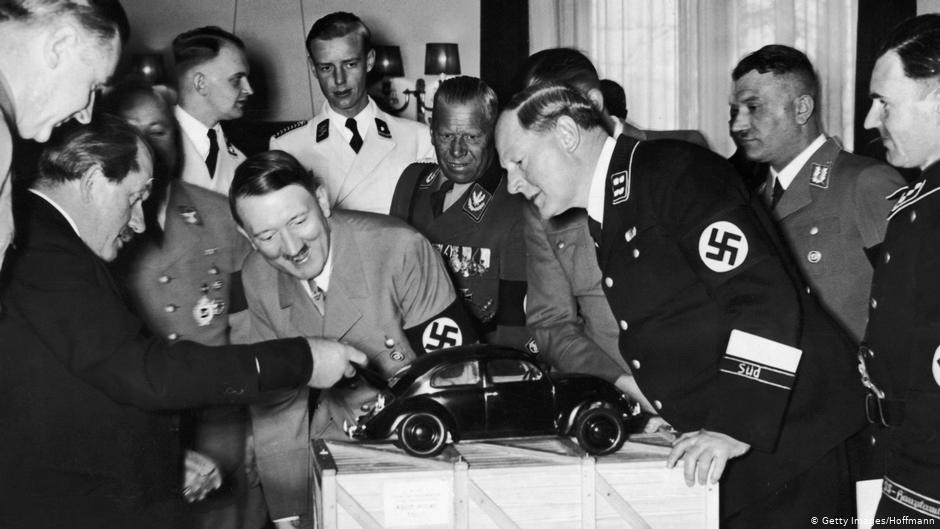
Ferdinand Porsche showing a model of the Volkswagen Beetle to Adolf Hitler in 1935.
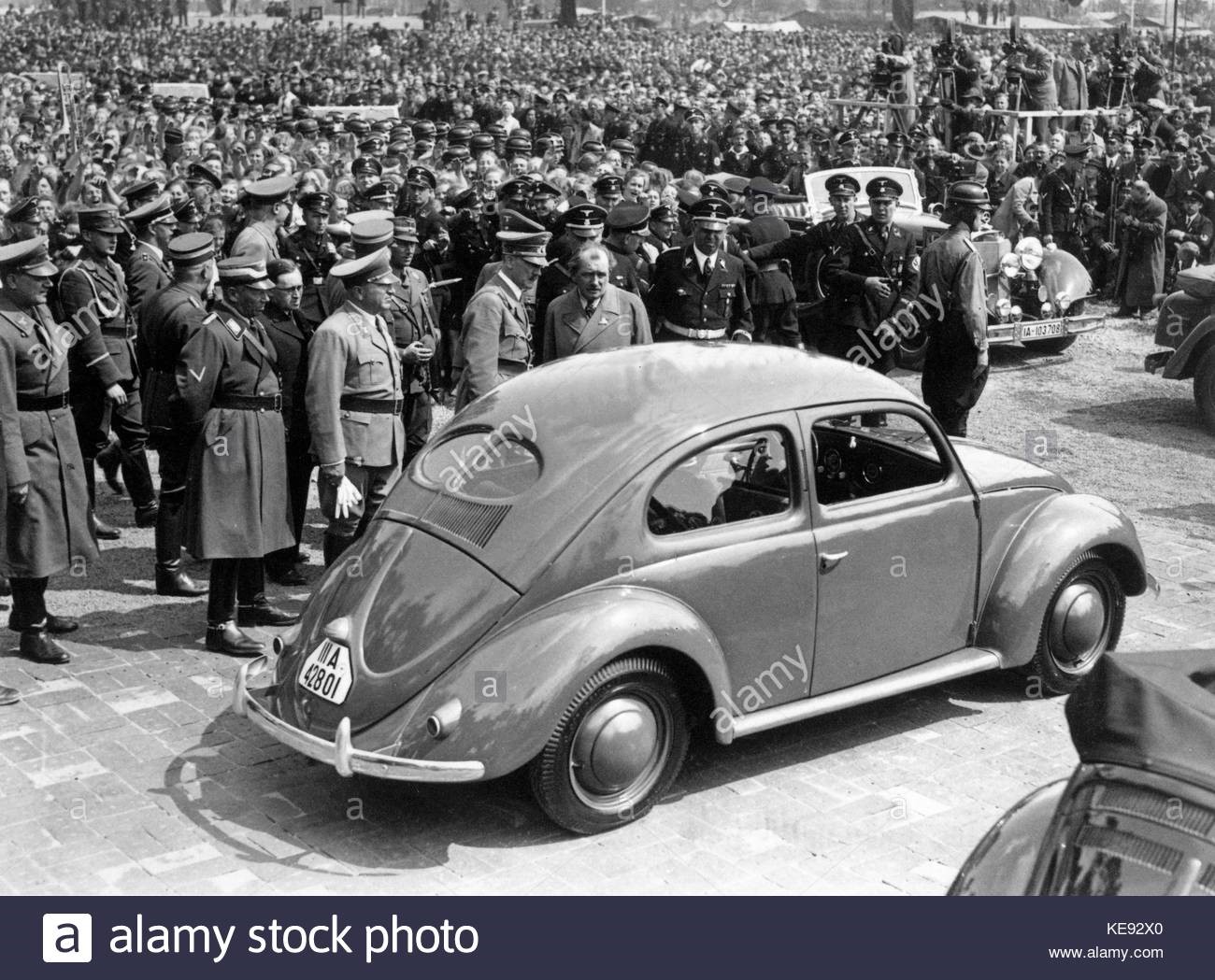
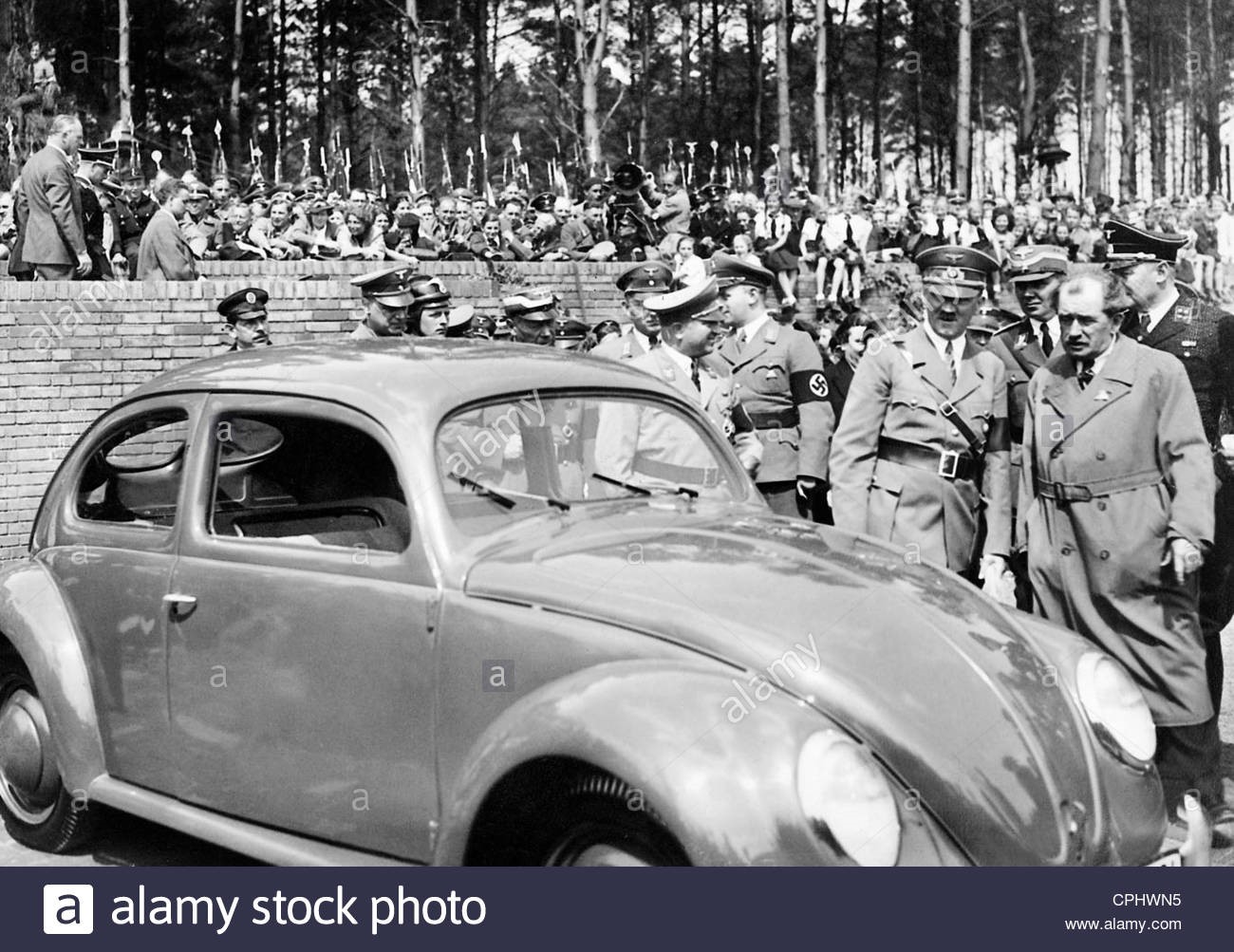
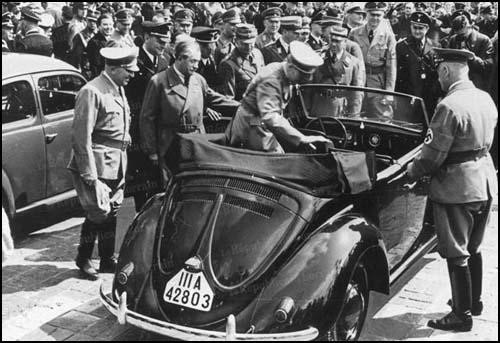
05-26-1938, Adolf Hitler and Ferdinand Porsche at the foundation of the Volkswagen factory in Wolfsburg.
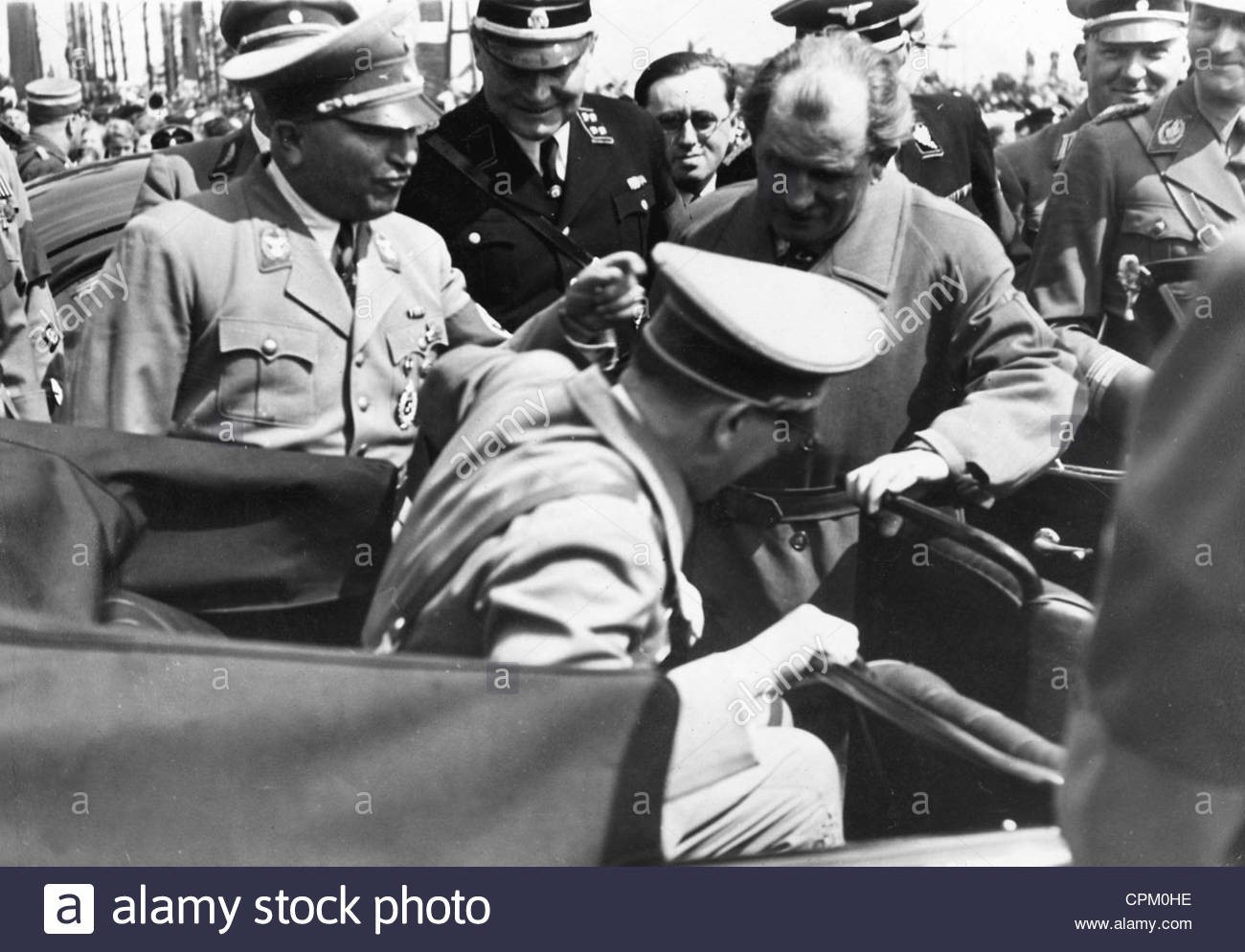
Adolf Hitler views the kdf-wagen with Ferdinand Porsche in 1939.
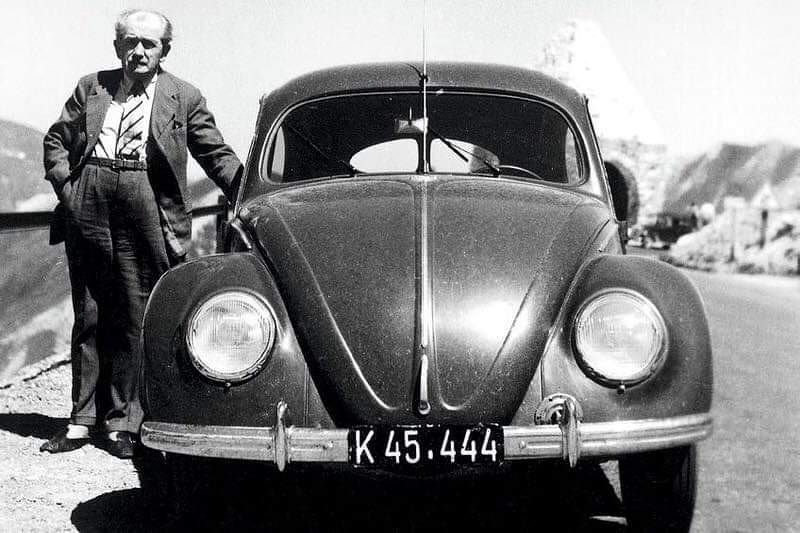
Ferdinand Porsche and his Beetle.

1946 VW Beetle Pickup.
And so the brilliant engineer helped create the first Volkswagen car and later founded the famed eponymous sports car maker.
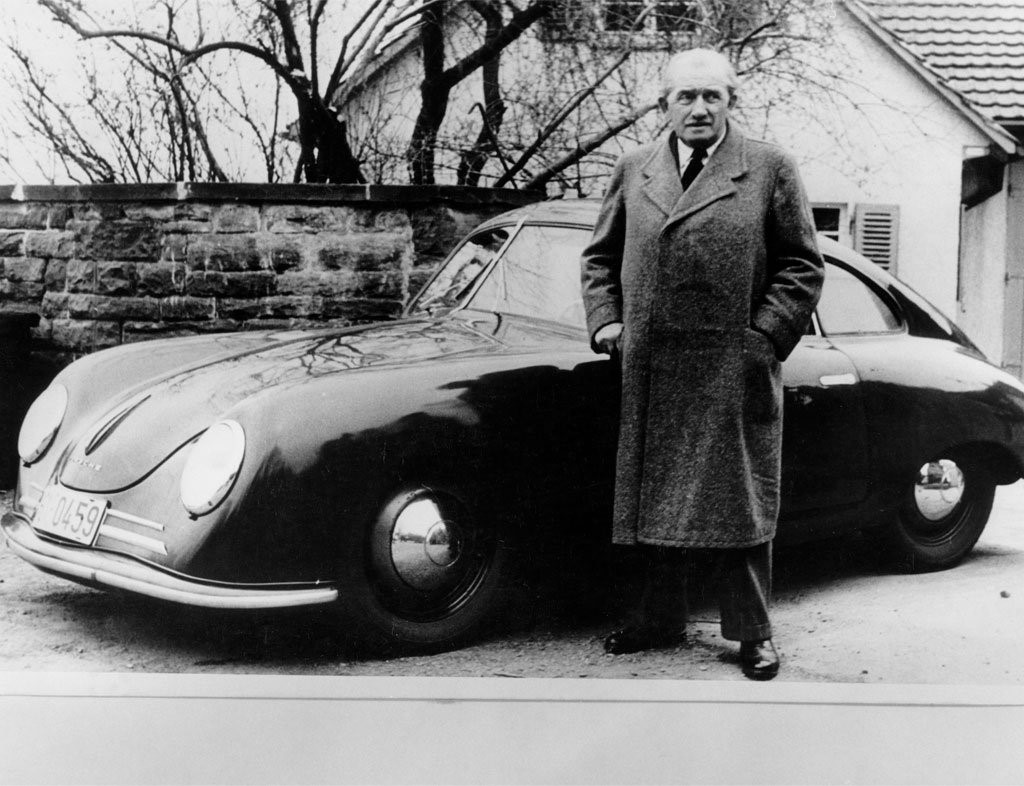
Ferdinand Porsche and a Porsche 356.
Unlike most automotive engineers, Porsche's career was amazingly diverse: cars, trucks, aircraft engines, tanks and other military vehicles, motorcycles and even windmills.
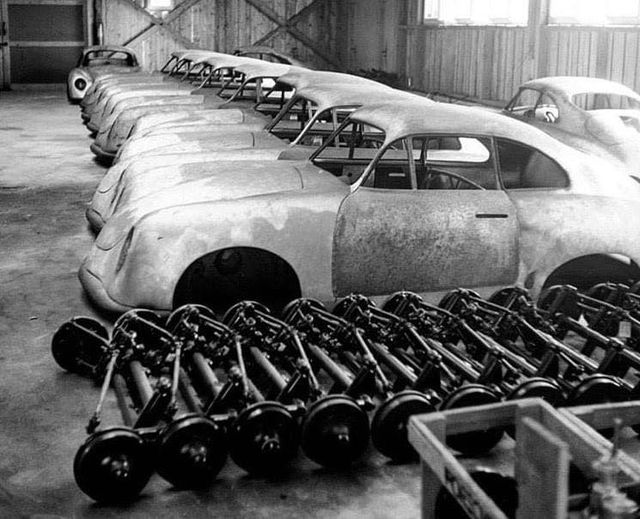
The beginning.
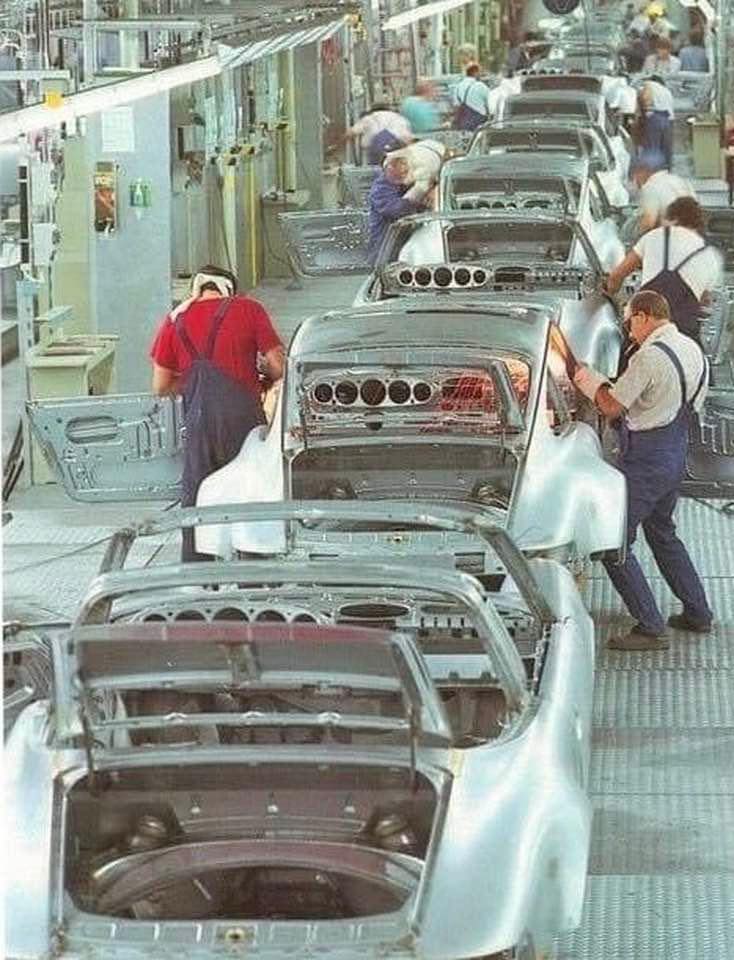
The Porsche 911 assembly line.
From design engineer to entrepreneur. The Porsche design company undertook development work for all kinds of technical appliances, from wind turbines and other types of turbines to engines and new vehicle concepts for Wanderer and Zündapp.
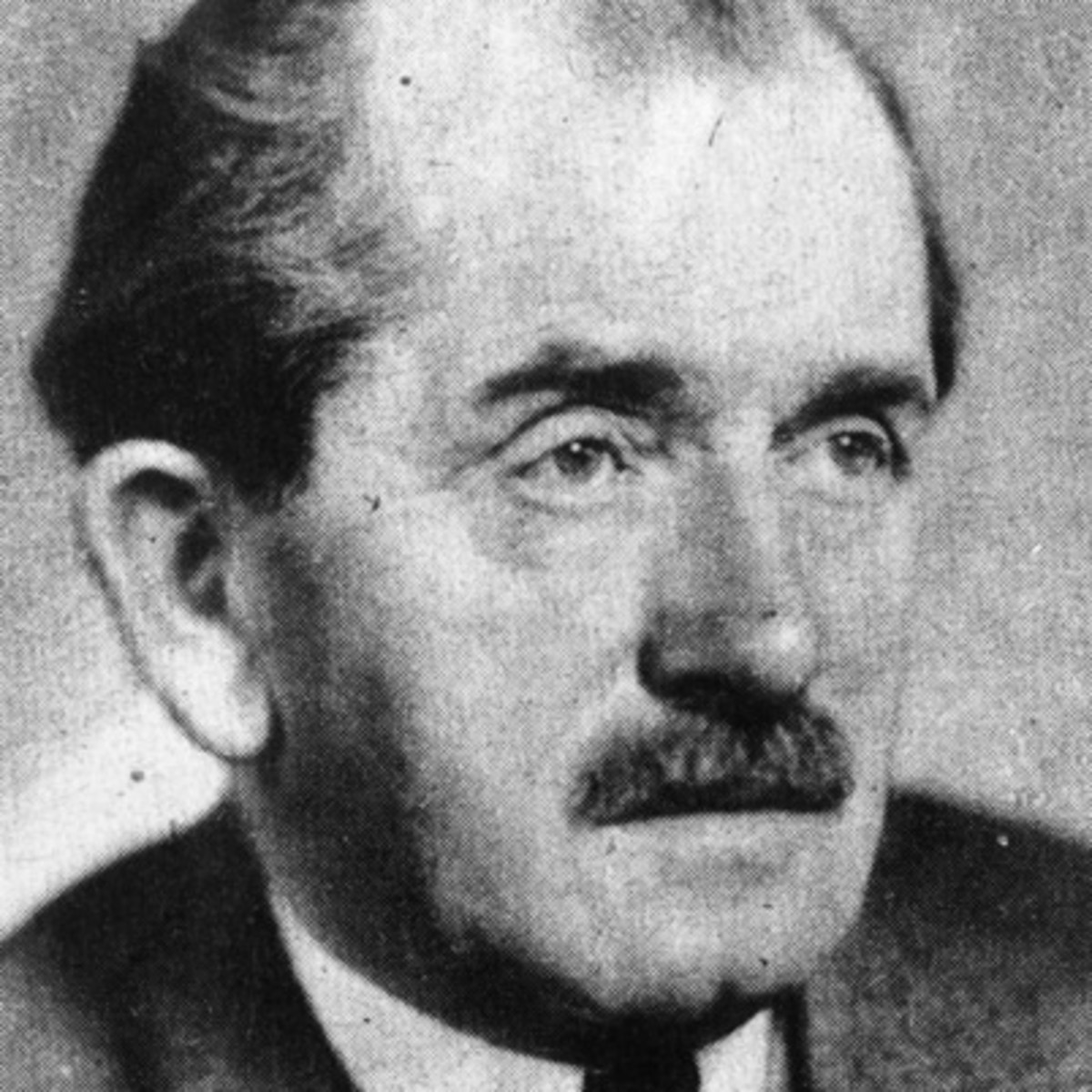
Ferdinand Porsche.
In 1933, Ferdinand Porsche designed the famous Auto Union 16-cylinder sports car. This car was a precursor to today's F1 design principles -- a racing car that became one of the most successful of its time in motorsport.
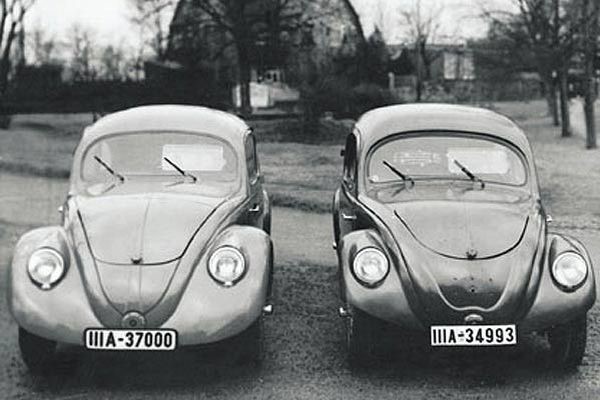
Off the drawing boards of the Porsche design office: the Volkswagen Beetle, the world's most-produced car.
His most famous design, however, was the one for the Volkswagen. On 22 June 1934, Ferdinand Porsche secured the contract from the "RDA - Reichsverband der Deutschen Automobilindustrie" (Automobile Industry Association of the Reich) to develop the Volkswagen which would shape future developments at Porsche for years to come.
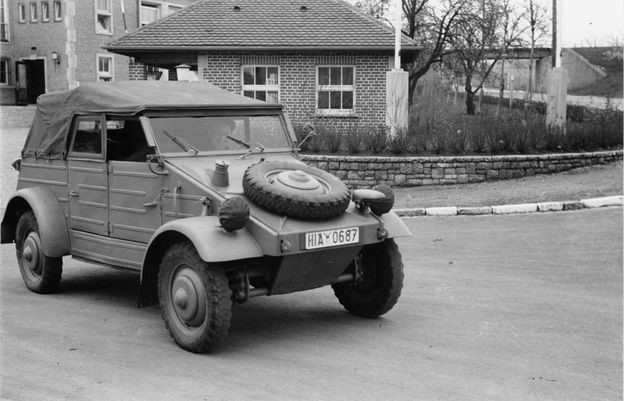
Based on the 'KdF' car, the Type 82 VW is a military vehicle produced at the Volkswagen factory from 1940-1945.
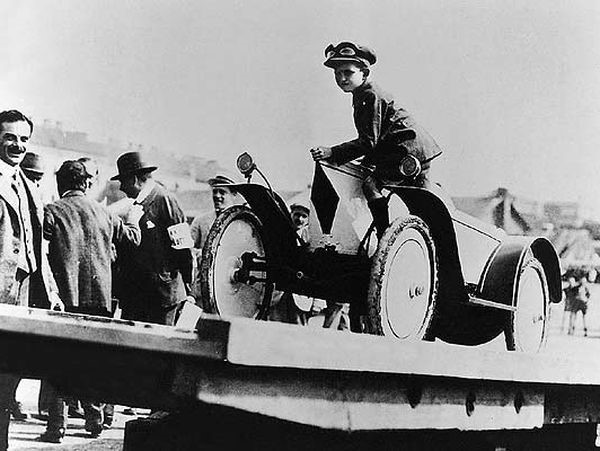
1920: son Ferry in his "small" Austro-Daimler equipped with a 3.5 HP petrol engine.
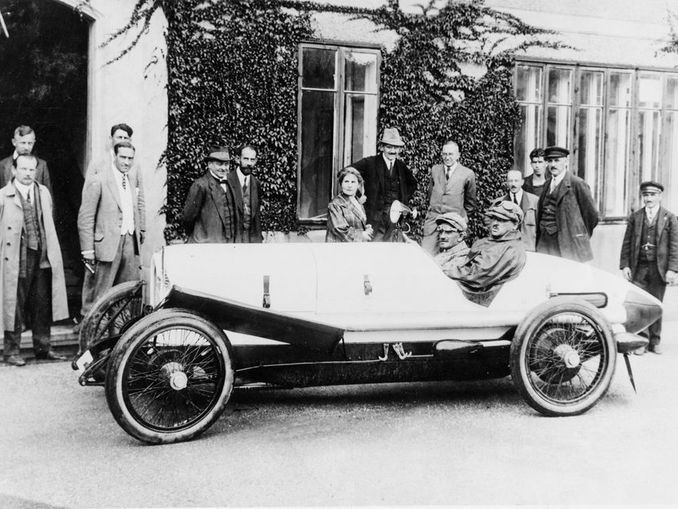
"Sascha", a two-seated sports car, successfully beat competitors in the famous 'Targa Florio'.
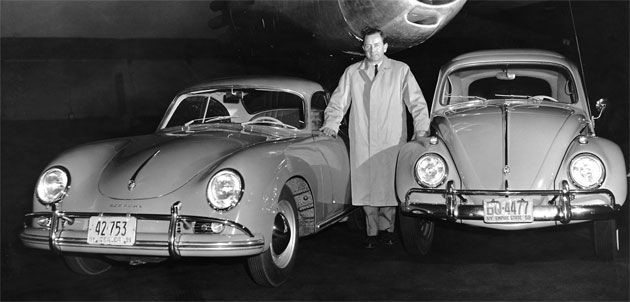
Ferry Porsche with his Porsche 356 and a Beetle.
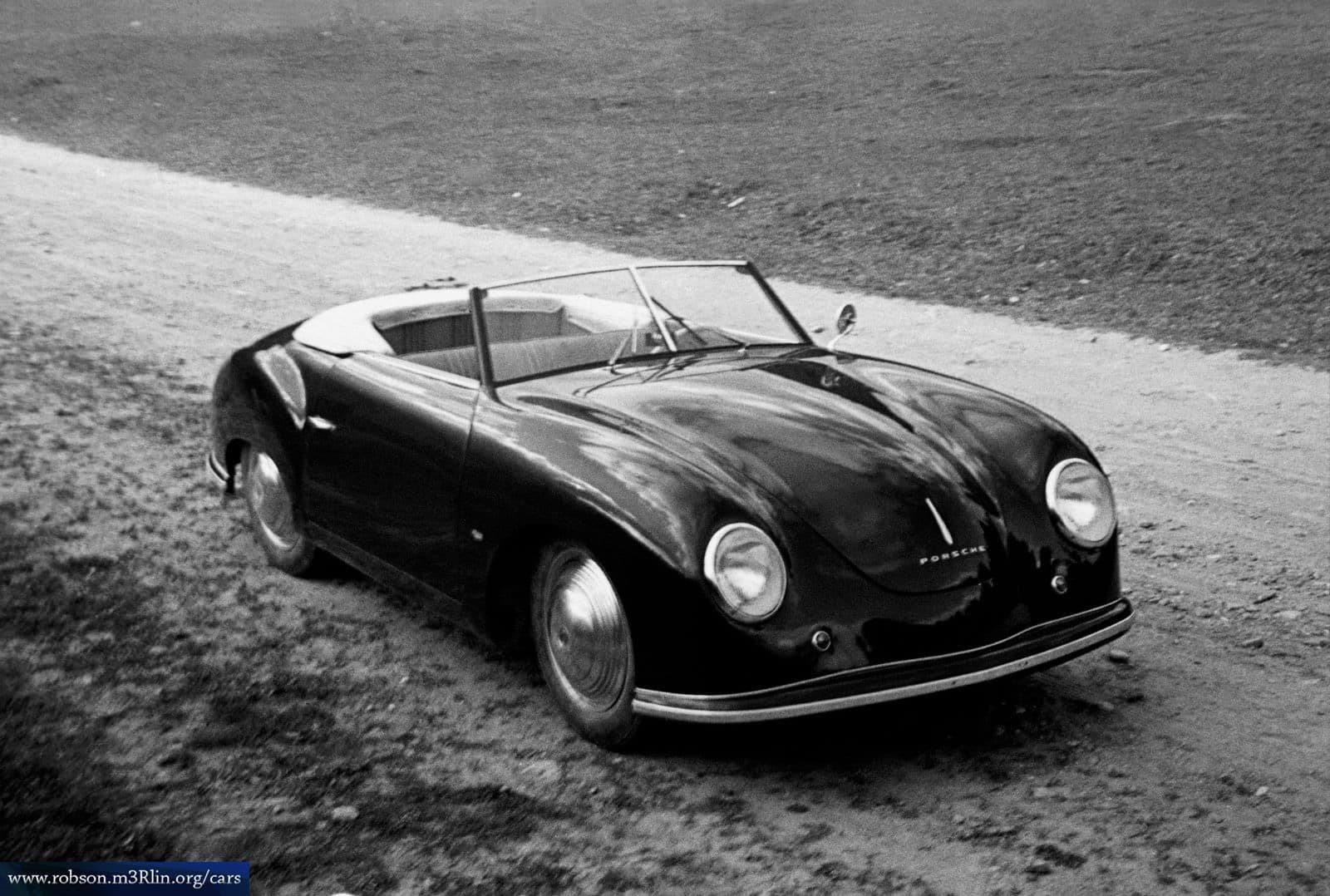
1948 Porsche 356.
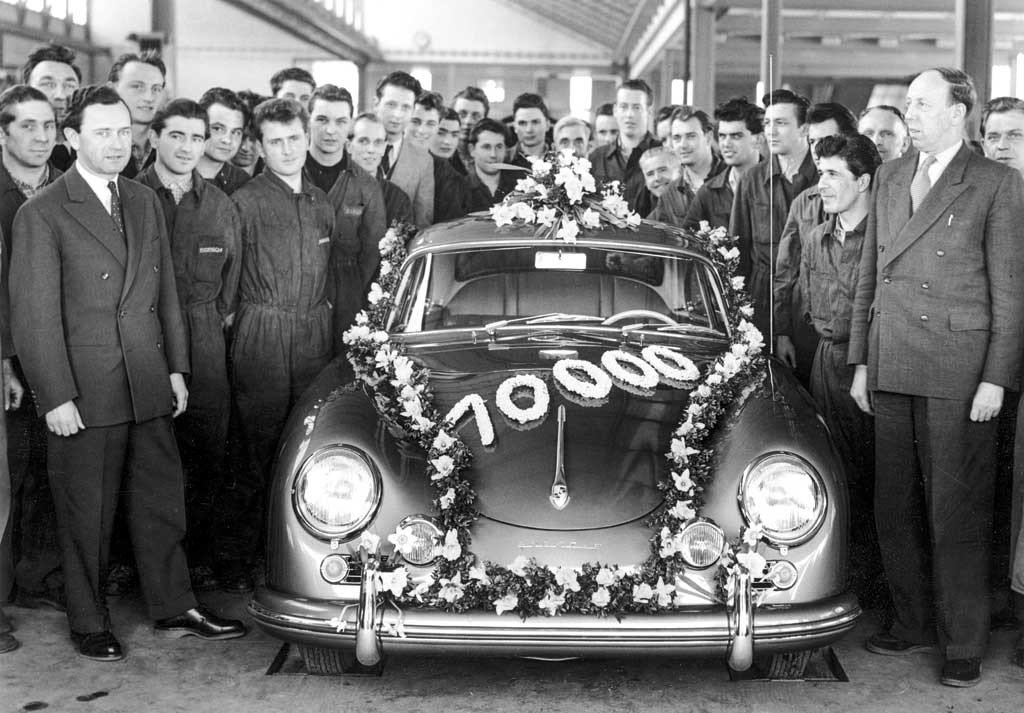
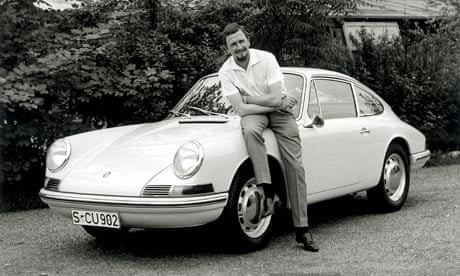
Ferdinand Alexander (Ferry) Porsche, designer or the 911 model, has died aged 76. He is pictured here leaning on a Type 901 Porsche (T8). Photograph Porsche/EPA.
Ferdinand Porsche was an Austrian-German automotive engineer and founder of the Porsche car company.
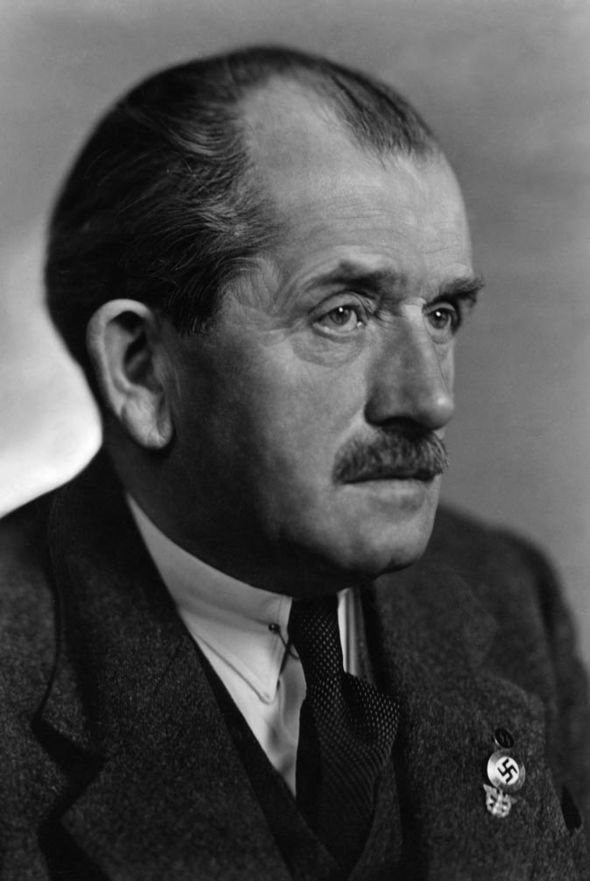
Porsche founder Ferdinand Porsche Hitler Nazi.
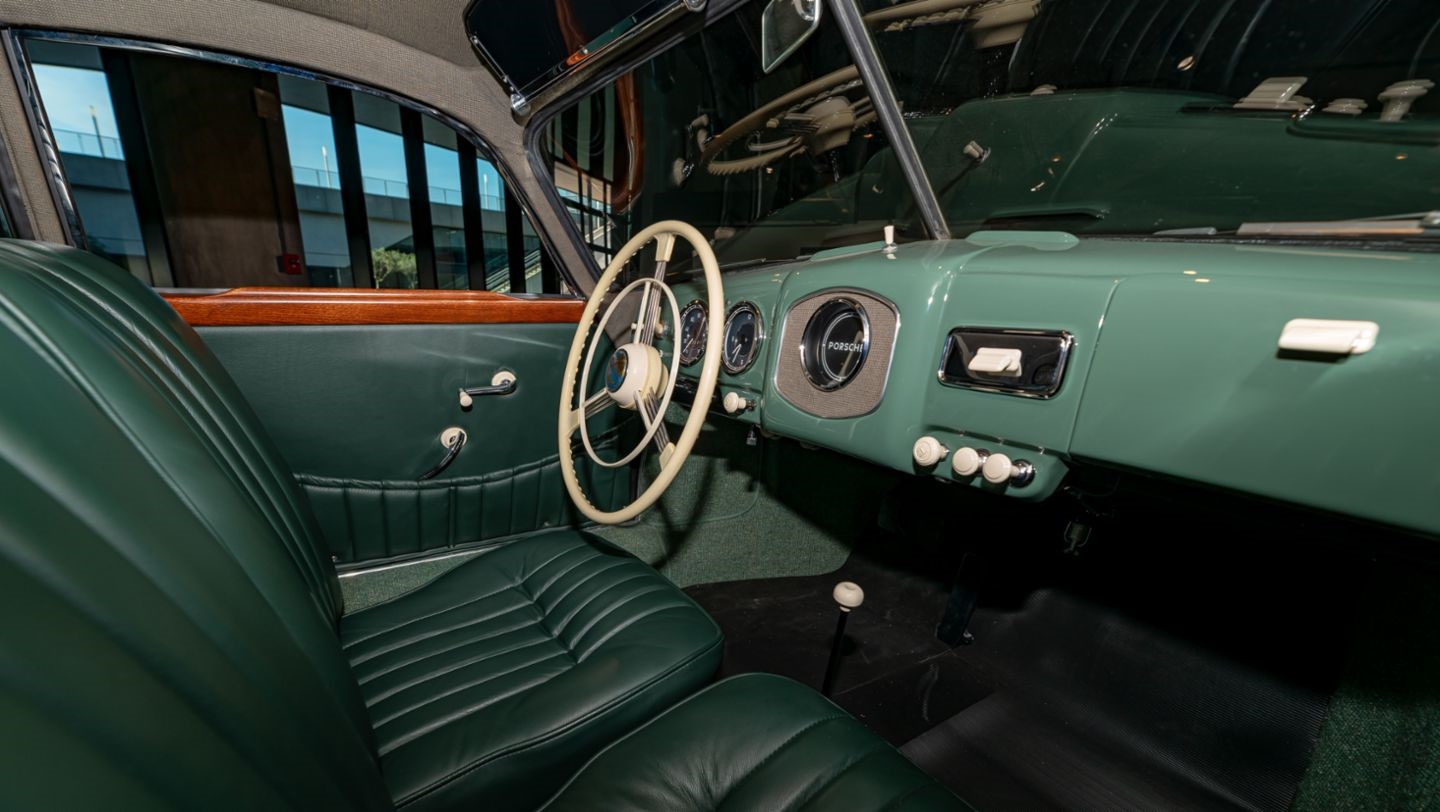

That 1950 meeting between Ferdinand Porsche and Max Hoffman.
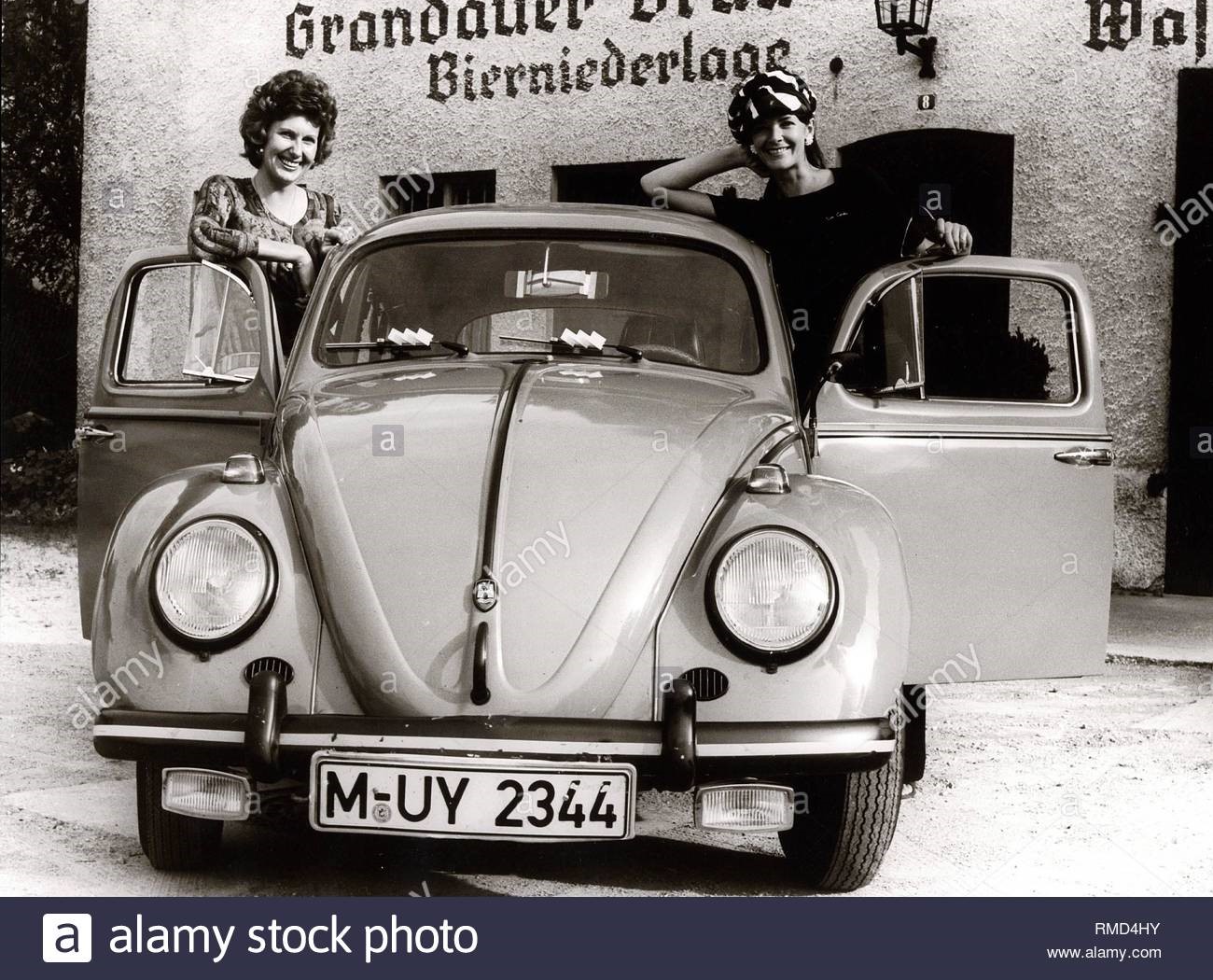
2 women standing near a Beetle built in 1960.
He is best known for creating the first gasoline-electric hybrid vehicle (Lohner-Porsche), the Volkswagen Beetle, the Auto Union racing car, the Mercedes-Benz SS/SSK, several other important developments and Porsche automobiles.
An important contributor to the German war effort during World War II, Porsche was involved in the production of advanced tanks such as the VK 4501 (P), the Elefant (initially called "Ferdinand") self-propelled gun and the Panzer VIII Maus super-heavy tank, as well as other weapon systems, including the V-1 flying bomb. Porsche was a member of the Nazi Party and was called the "Great German Engineer" by Nazi officials. He was a recipient of the German National Prize for Art and Science, the SS-Ehrenring and the War Merit Cross.
Porsche was inducted into the International Motorsports Hall of Fame in 1996 and won the Car Engineer of the Century award in 1999.
He showed a strong aptitude for mechanical work at a very early age. He attended classes at the Imperial Technical School in Reichenberg (Czech: Liberec) at night while helping his father in his mechanical shop by day. Thanks to a referral, Porsche landed a job with the Béla Egger Electrical company in Vienna when he turned 18. In Vienna, he would sneak into the local university whenever he could after work. Other than attending classes there, Porsche never received any higher engineering education.
After the breakup of the Austro-Hungarian Empire at the end of World War I, he chose Czechoslovak citizenship. In 1934, either Adolf Hitler or Joseph Goebbels made Porsche a naturalized German citizen.
A new city, "Stadt des KdF-Wagens" was founded near Fallersleben for the Volkswagen factory, but wartime production concentrated almost exclusively on the military Kübelwagen and Schwimmwagen variants.
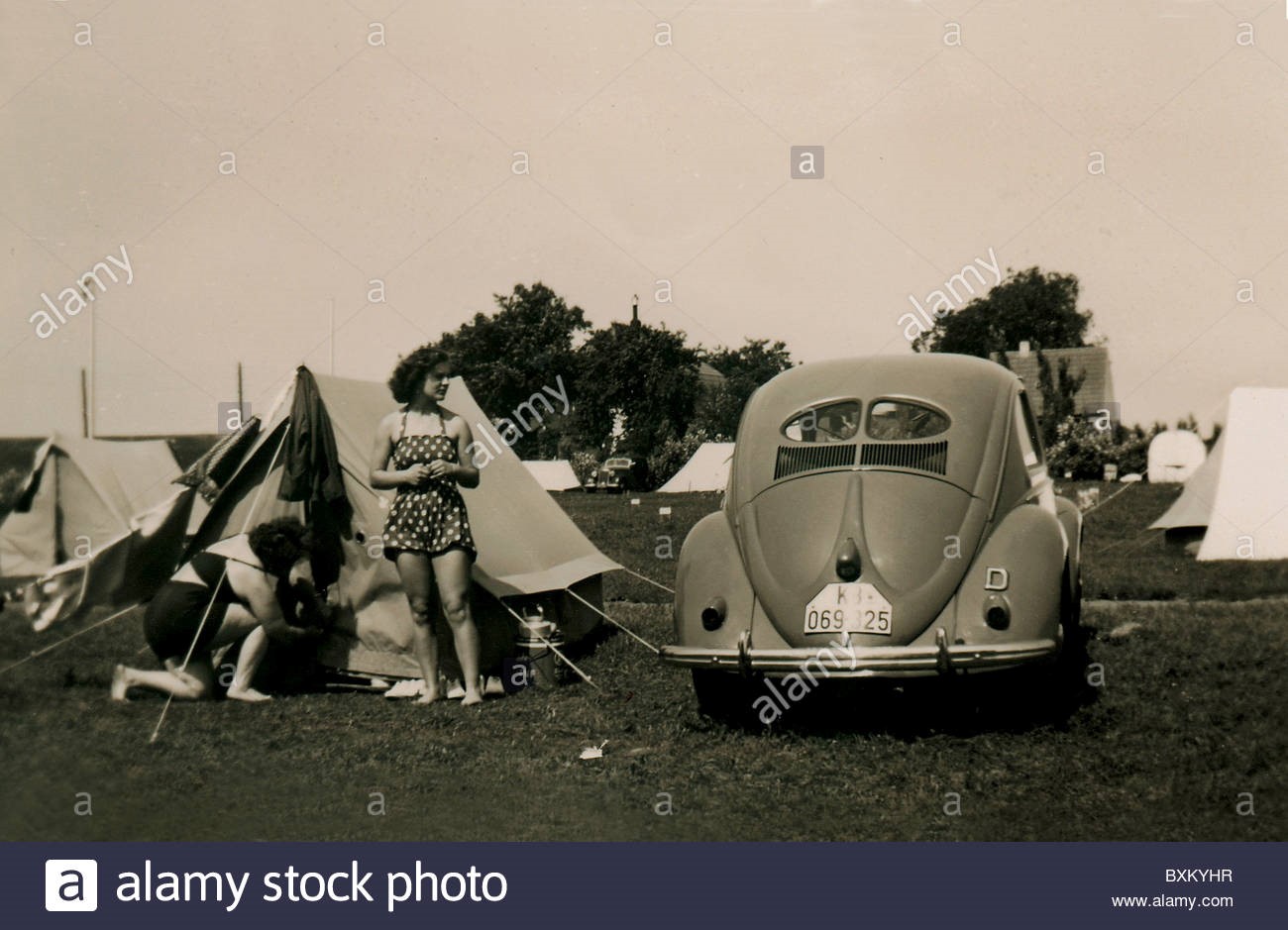
Tourism camping. Two women from Berlin on campsite in Buesum Germany.
Mass production of the car, which later became known as the Beetle, began after the end of the war. The city is named Wolfsburg today and is still the headquarters of the Volkswagen Group.
Porsche visited Henry Ford's operation in Detroit many times where he learned the importance of productivity. There he learned to monitor work. He was also surprised at how the workers and the managers treated each other as equals; even he, as a visiting dignitary, had to carry his own tray in the cafeteria and eat with the workers.
Ferdinand Porsche (1875-1951). Article © James Herne / Stuttcars.com.
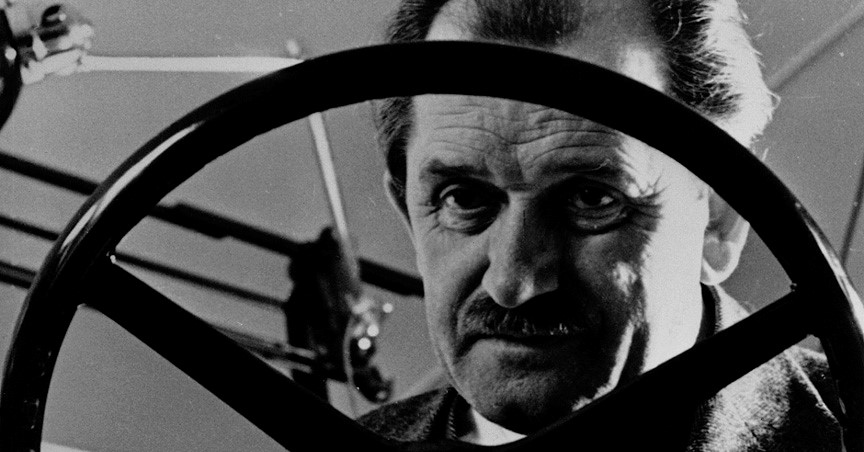
Probably the most famous photo of F. Porsche, taken in 1935. © Porsche.
1875 September 3, Ferdinand Porsche, third of five children of Anton Porsche, was born in Maffersdorf, Reichenberg, Austro-Hungarian Empire (now Vratislavice nad Nisou, Liberec, Czech Republic).
1889-1890. At the age of 14, Ferdinand was already performing experiments with electricity. For example, he fitted ice skates with battery-powered lights. However, his father tried to forbid his son from busying himself with “such nonsense”. Anton Porsche was the owner of a plumbing workshop and expected Ferdinand to take over the family business after Ferdinand's older brother Anton got killed in the workshop accident. But Ferdinand had other interests. Despite being fascinated by electricity, he completed both his plumber apprenticeship and the state trade school in Reichenberg.
Ferdinand’s acumen in electricity increased to such a degree that, by 1893, his family home became the first in Maffersdorf to have electric light.
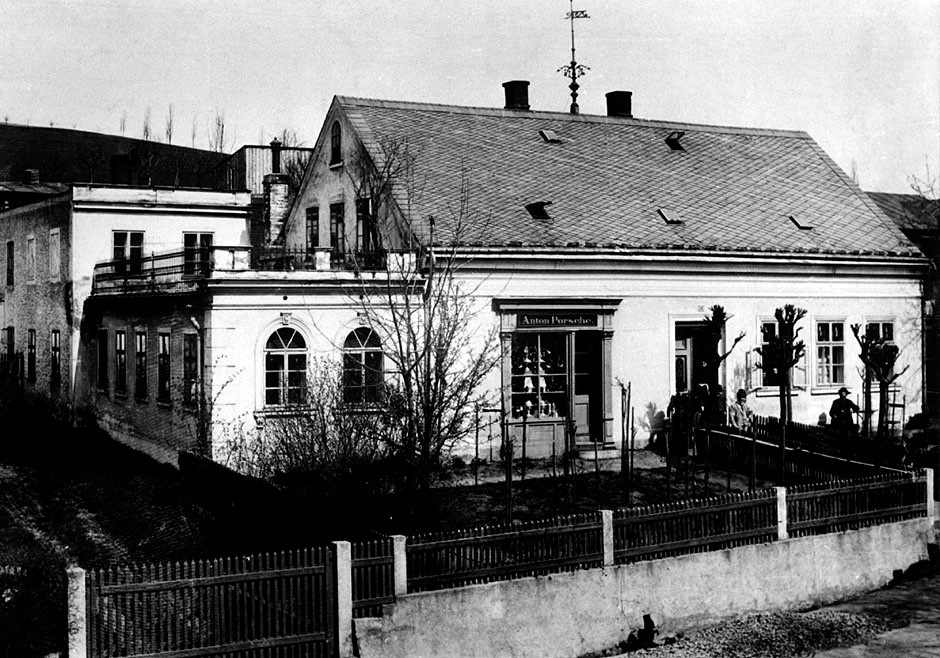
The house in Vratislavice nad Nisou (Maffersdorf at the time) near Liberec, where Ferdinand Porsche was born. Back in those it wore number 201 (now Tanvaldská 38). © Porsche.

Anton Porsche's house and business. © Porsche.
1893. Ferdinand began working at the electricity company Bela Egger & Co. (now Brown Boveri) in Vienna.
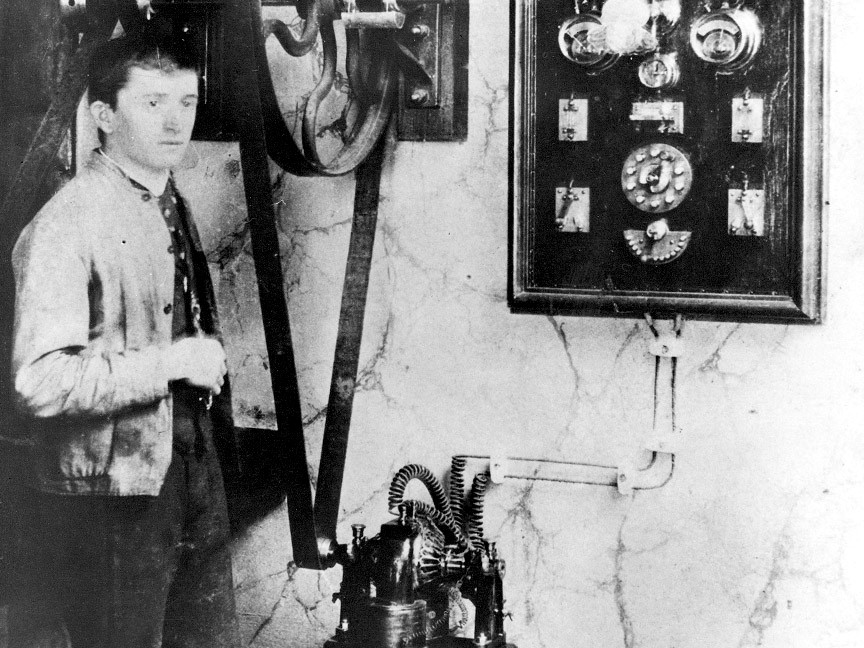
1894 April, Ferdinand at the age of 18. © Porsche.
With his bright talent, Ferdinand Porsche was promoted from a worker to the test centre manager within a few years.

© Porsche.
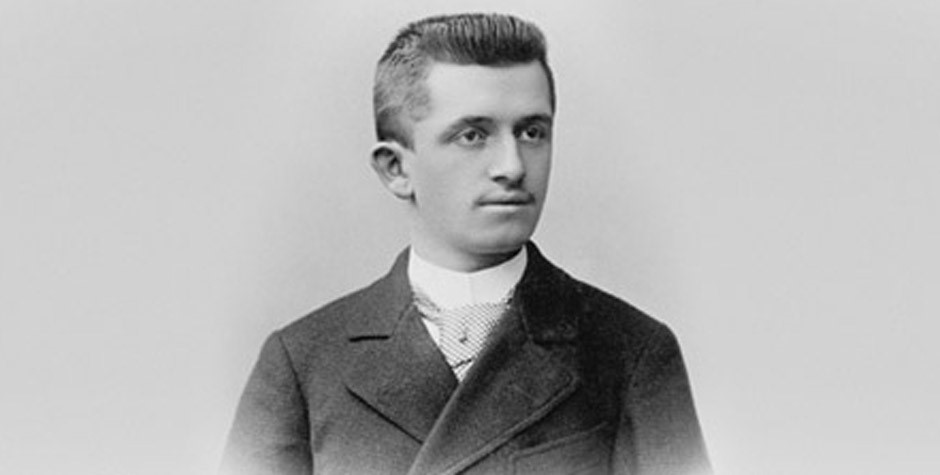
© Porsche.
1897. F. Porsche built an electric wheel-hub motor. In the same year he started working at Hofwagenfabrik Jacob Lohner & Co., Vienna, in the freshly established car department.
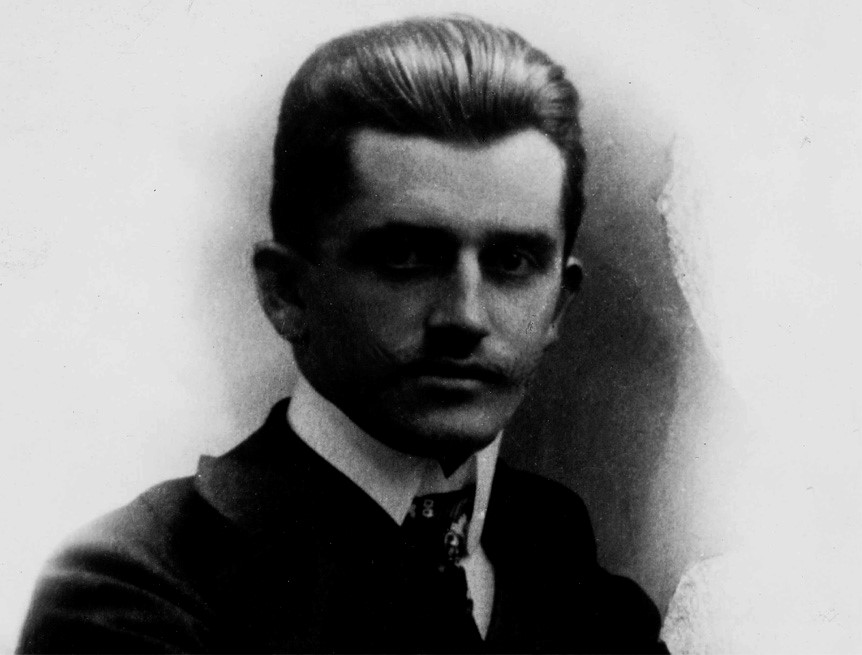
In his twenties. © Porsche.
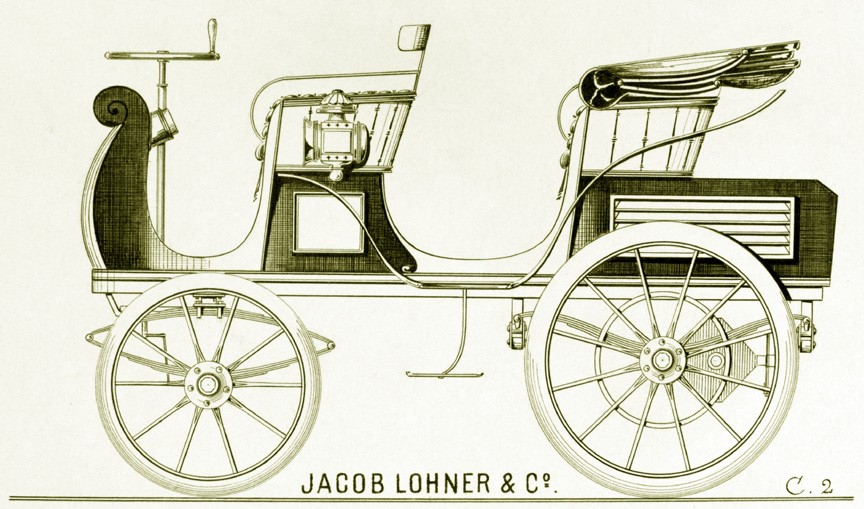
1898: Egger-Lohner C.2 Phaeton designed by F. Porsche and called the P1 as the first Porsche vehicle design. © Porsche.
The “P1” – designed and built by Ferdinand Porsche – was one of the first vehicles registered in Austria. It was taken to the streets of Vienna on June 26, 1898. The highly compact electric drive, weighing just 130 kg/290 lb, offered an output of 3 hp. For short periods, up to 5 hp could be achieved in overloading mode, allowing the P1 to reach up to 22 mph/35 km/h. The speed was regulated via a 12-speed controller. The first practical test awaited the P1 on September 28, 1899, at the international motor vehicle exhibition in Berlin - a race for electric vehicles over a distance of 40 km was announced! With three passengers on board, Ferdinand Porsche steered his P1 across the finish line as the winner.
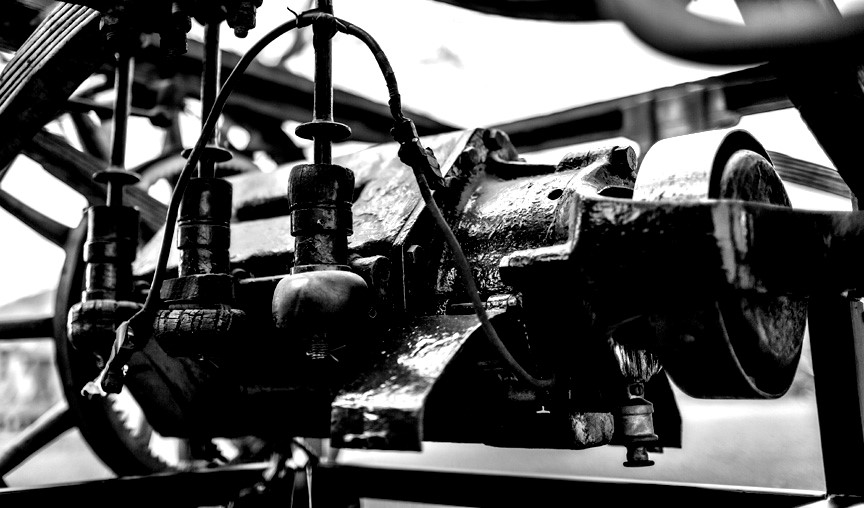
1899: the electric motor in the P1. © Porsche.
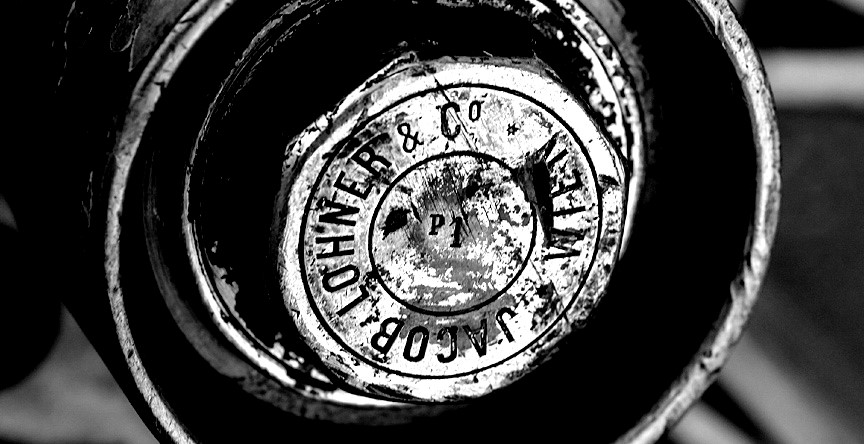
Porsche type 1: "P1" stamped on the wheel hub. © Porsche.
1900. The Lohner-Porsche - a vehicle powered by the Porsche electric wheel-hub motors - was celebrated as an epoch-making innovation at the world trade fair in Paris.
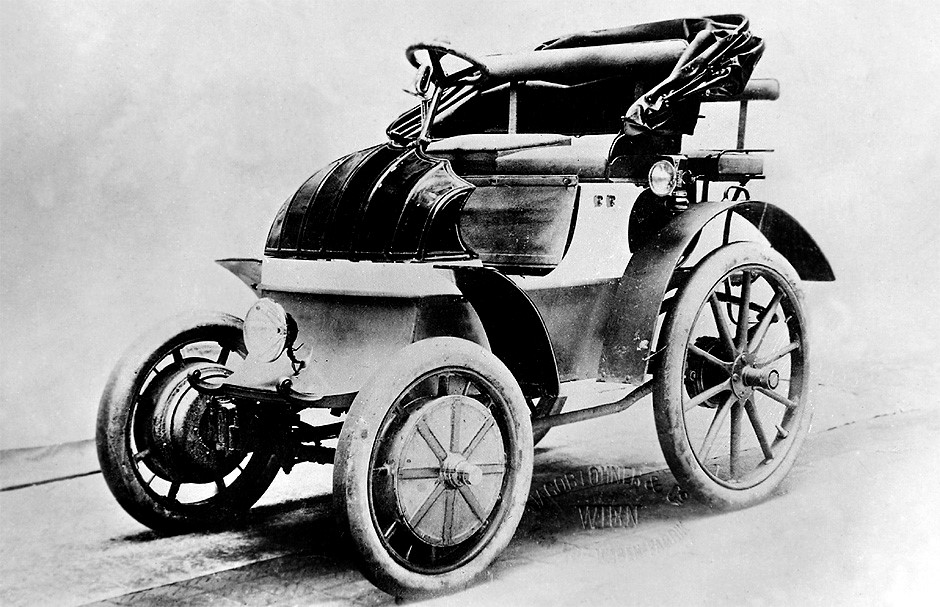
Lohner-Porsche was the first front-wheel-drive car. © Porsche.
The Lohner-Porsche electric car, a "Chaise" ("Chair") with the internal vehicle number 24000, was exhibited as the only Austrian car at the 1900 Paris World Fair. A news report at the time described the development of the first-ever transmissionless vehicle as a revolutionary innovation. The electric motors in the hubs of the front wheels had an output of 1.8 kW at 120 rpm. The 44-cell, 80-volt rechargeable battery with a capacity of 300 Ah gave the car a range of 30 miles/50 km between recharges. The maximum speed was 30 mph/50 km/h. The slow speed of the electric motor permitted direct drive and installation in the wheel. The motor operated without chains and thus without mechanical power loss. Consequently, the electric motor was extremely efficient and was almost silent during operation. The total weight of the vehicle was 1205 kg/2657 lbs. The car could be braked at all four wheels - by the motors at the front axle and with the aid of a mechanical strap brake at the rear axle. Ferdinand victoriously tested his designs in races - he won on the Semmering circuit near Vienna in 1900.
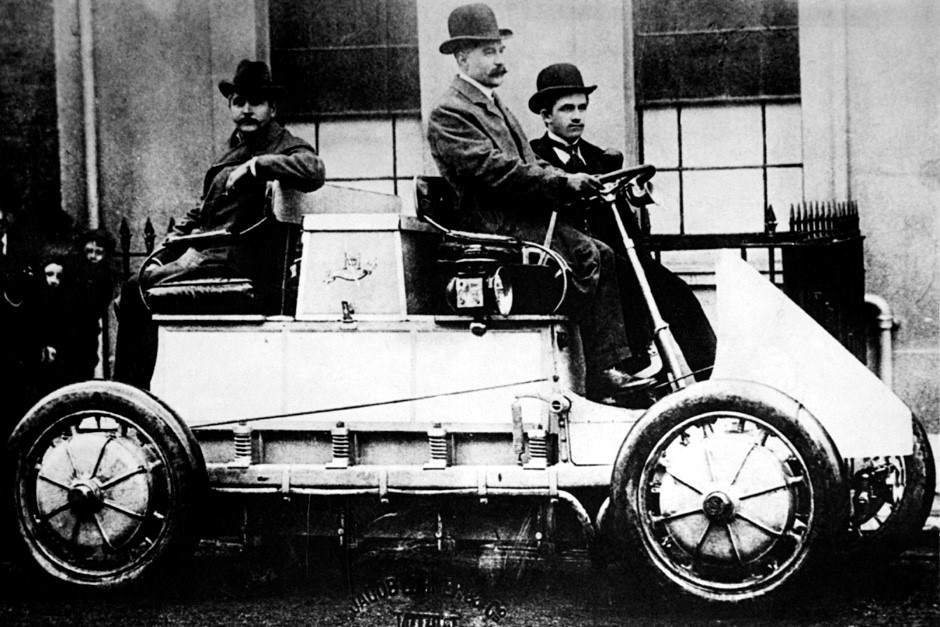
1900. First 4-wheel-drive car in the world. Ferdinand Porsche sitting next to the driver of a Lohner-Porsche Electromobile. It had four 1.8 kW motors. The vehicle was intended for competition use. Ferdinand himself delivered it to the purchaser, E.W. Hart in Luton, England. © Porsche.
1902. As a reserve soldier, Ferdinand Porsche was the driver for Archduke Franz Ferdinand (whose later assassination sparked World War I). Ferdinand drove one of his own designs.
1903. Ferdinand Porsche married Aloisia Johanna Kaes.
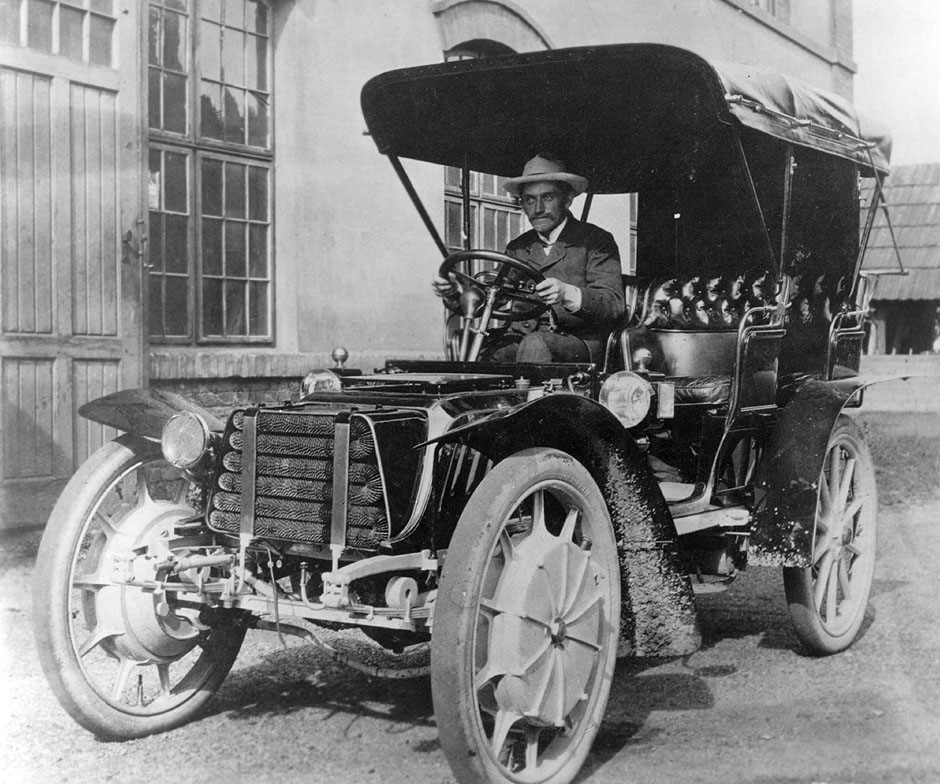
1903. Lohner-Porsche Mixte hybrid driven by F. Porsche. The car had a Daimler internal combustion engine charging the batteries that turned the electric motors in wheel hubs. © Porsche.
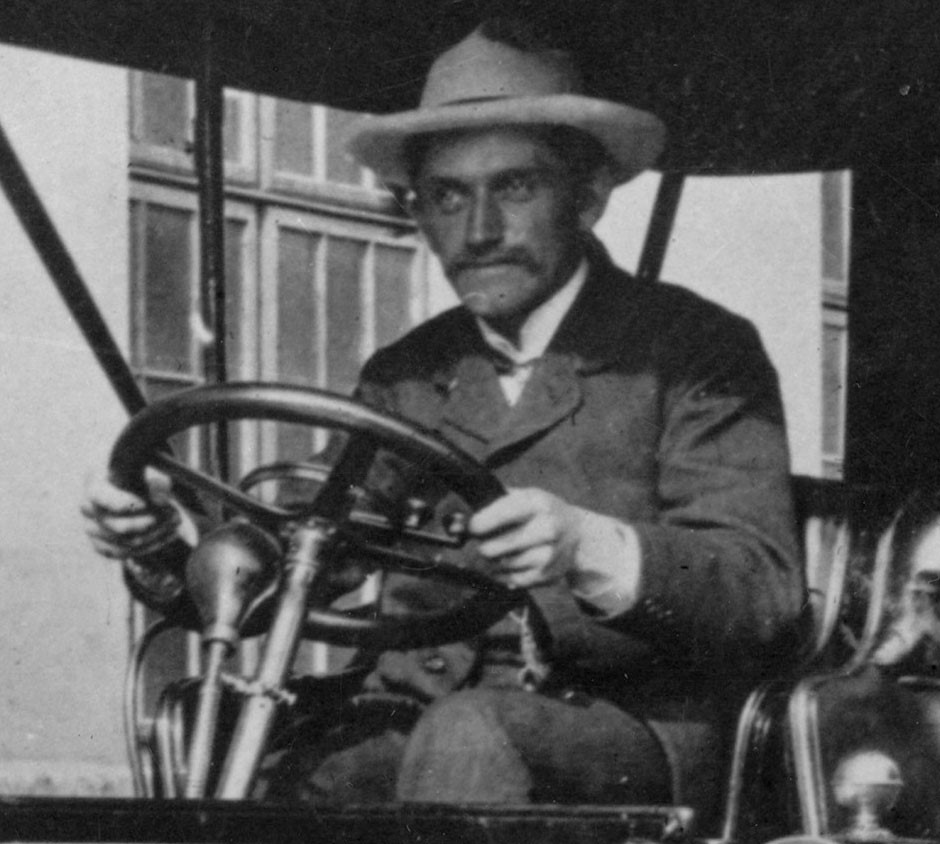
1903 Ferdinand Porsche. © Porsche.
1904. Daughter Louise Hedwig Anna Wilhelmine Maria Porsche (later Piëch) was born.
1906. In July, after 8 years at Lohner, F. Porsche took up the position of Technical Director at Austro-Daimler in Wiener Neustadt. At the age of only 31, he was responsible for the model range of one of Europe’s largest automotive companies.
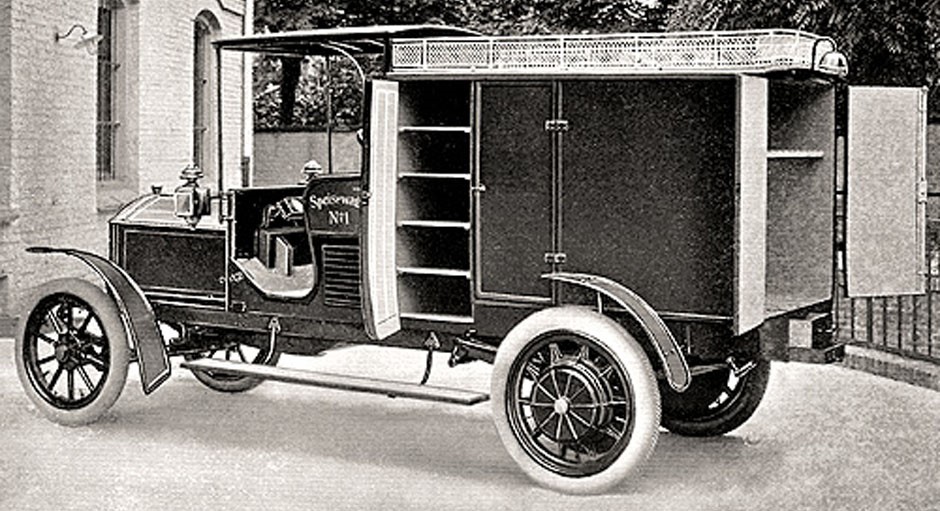
1908 Mercedes-Electrique food transport vehicle. The petrol/electric vehicles with electric wheel hub drive, sold from 1908, were especially popular with city dwellers. Daimler’s Marienfelde plant produced trucks, beer transporters, waste collection and other municipal vehicles, buses for city tours and, above all, fire engines. The battery-powered and later petrol/electric drive systems were developed by Ferdinand Porsche for the Lohner company who had sold the patent to Daimler. © Daimler AG.
1909. On September 19, son Ferdinand Anton Ernst (“Ferry”) was born. On the same day Ferdinand was busy racing at Semmering, 40 km from home, in an Austro-Daimler Maja engineered by himself. He got the news about the birth of his son by telegram.
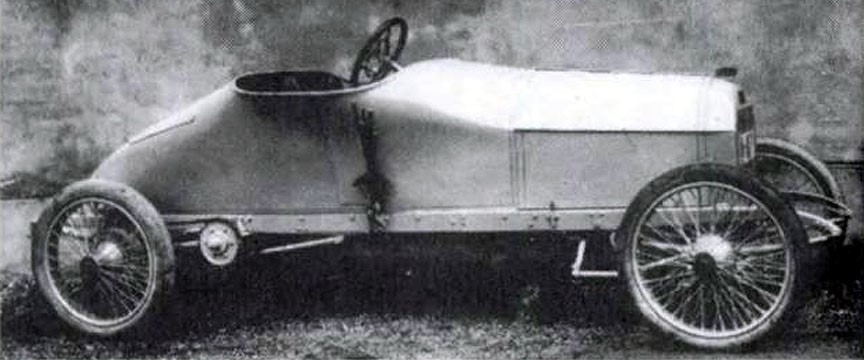
Austro-Daimler Maja. © Porsche.
1910. From June 2 to 8, at the wheel of an Austro-Daimler car that he designed himself, F. Porsche won the “Prinz-Heinrich-Fahrt”, which was popular at that time. It was a long-distance test for touring cars with annually varying routes. In 1910 the race was on the following course: Berlin-Magdeburg-Braunschweig-Kassel-Würzburg-Nürnberg-Stuttgart-Strasbourg-Metz-Bad Homburg. The race distance was 1945 km (1208 miles).
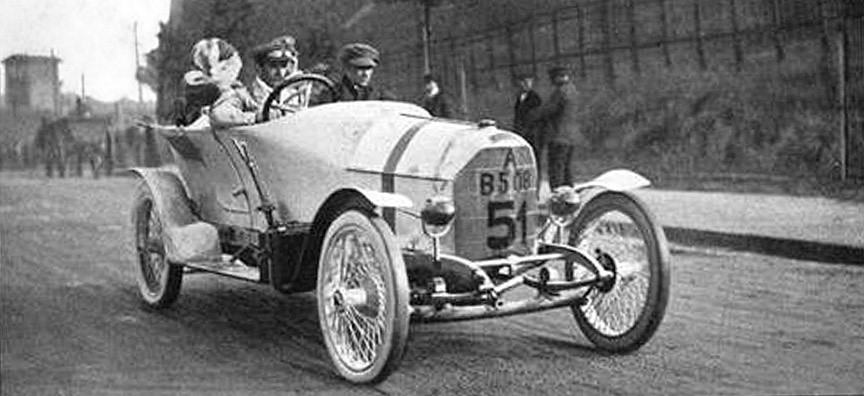
1910 Prince Heinrich race, F. Porsche. © unknown (please inform if you know).
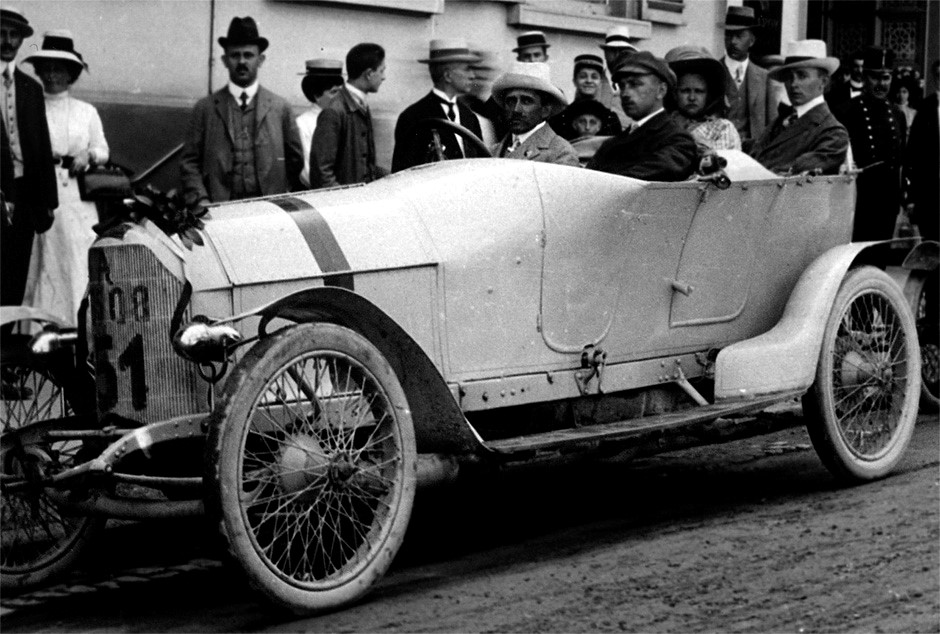
1910 Prince Heinrich race won by F. Porsche in Austro Daimler that he had designed and piloted by himself. © Porsche.

F. Porsche in 1910. © Porsche.
1912-1913. F. Porsche developed the "Austro-Hungarian Electric Train" based on an idea from the Austrian Colonel General Ottokar Landwehr von Pragenau. It was subsequently renamed the "Landwehr-Train". Its design was based on the hybrid petrol-electric drive system which Ferdinand Porsche had already developed. The type-M12 6-cylinder 70 kW engine drove the generator. Electricity produced by this generator was conducted to all the trailer cars throughout the train and powered the electric motors at every second axle. With the aid of the special steering system, each of the up to six trailers precisely followed the path of the motorcar. The Landwehr-Train was thus also suitable for narrow, winding roads through towns and for mountain roads. It was possible to operate the Train on railroad tracks by bolting steel discs onto the solid-rubber tyres. When used on railroad, up to ten trailers could be used.

1913. Austro-Daimler Landwehr-Train on a trial run on the Semmering road, south of Wiener Neustadt, Austria. © Porsche.
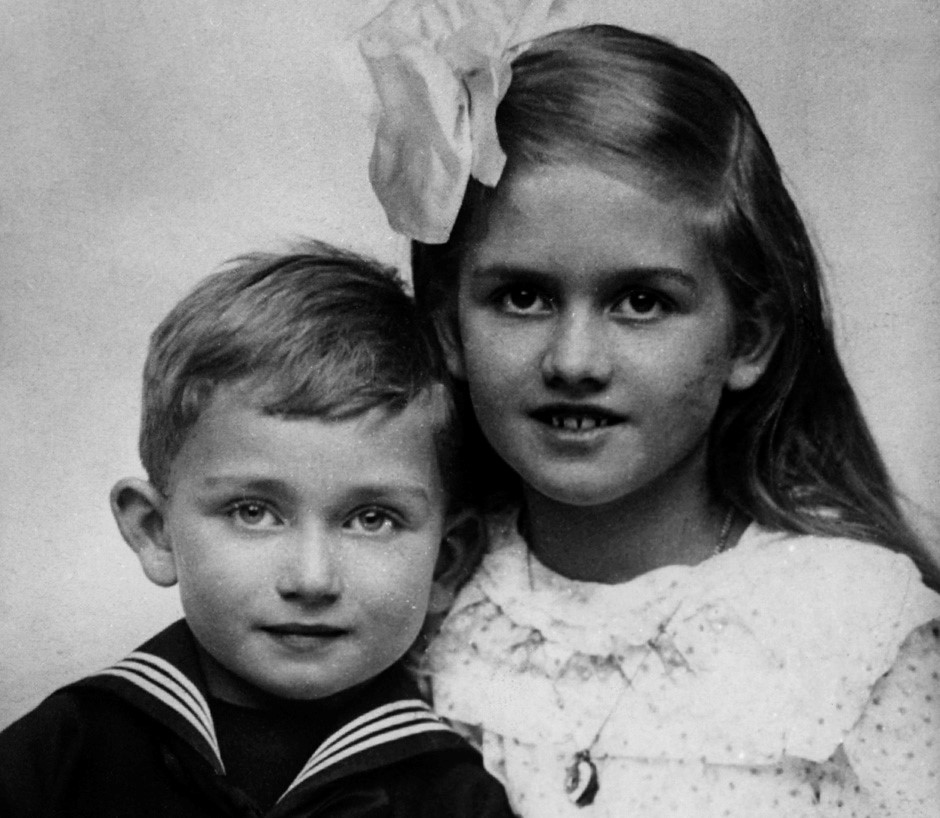
1915. Ferdinand Porsche's children, Ferry and Louise, aged 6 and 11. © Porsche.
1917. Ferdinand Porsche became the general manager of Austro-Daimler.
1922. F. Porsche presented the Austro-Daimler Sascha, a small 4-cylinder racing car with a displacement of 1.1 litres. The car was designed for a wealthy Austrian count and film maker Sascha Kolowrat. At first go in the same year, “Sascha” snapped up first and second places in its category in the Targa Florio race in Sicily, Italy. "Gazzetta dello Sport" commented on its success as follows: “up until very recently no one would have dreamed it possible to achieve such top speeds and durability with a 4-cylinder engine belonging to the category of smallest cars ever.”
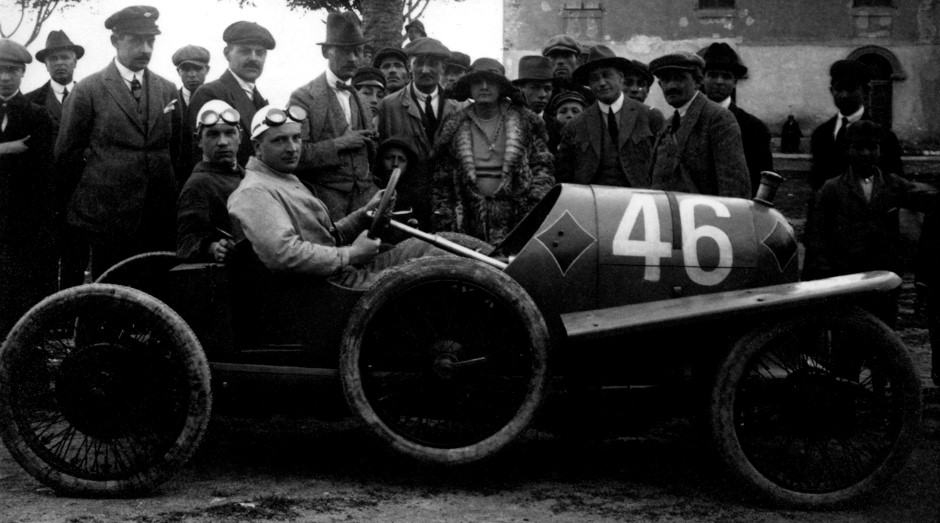
1922 Targa Florio. At the wheel of the Sascha is Alfred Neubauer, accompanied by his mechanic Georg Auer. Alfred Neubauer was entered for the higher-powered category with an uprated Sascha and completed the race at an average speed only 5 mph/8 km/h slower than on the cars, that had up to four times as much power available. © Porsche.
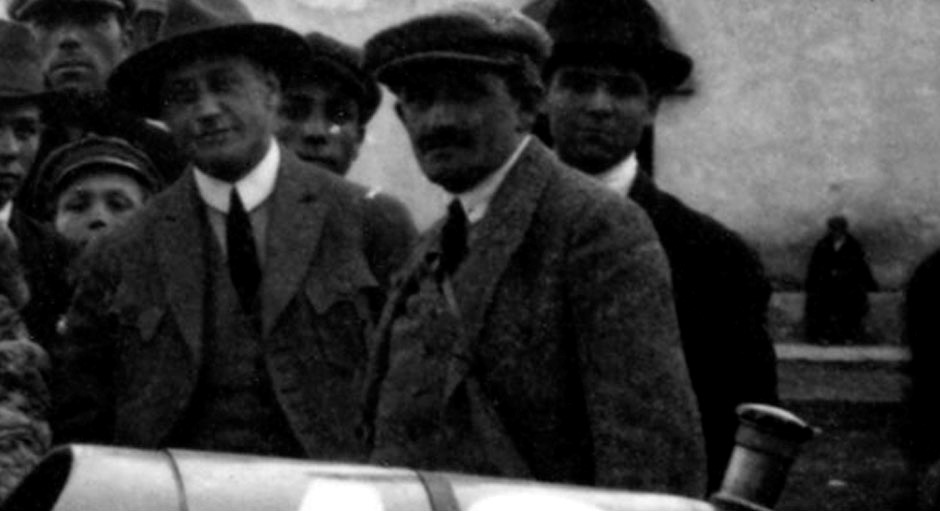
Ferdinand Porsche in 1922. © Porsche.

ca 1922 Ries race, Graz, Steiermark. © Porsche.
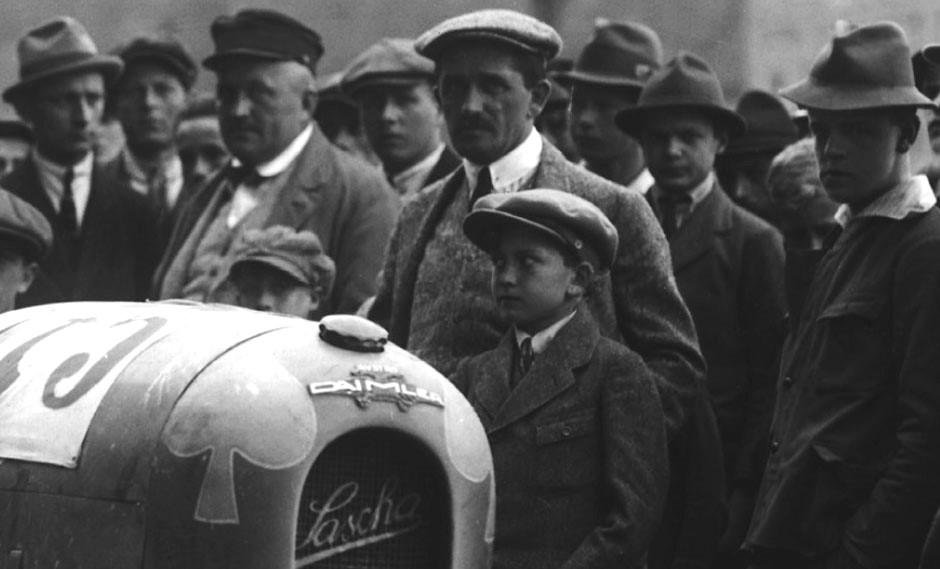
ca 1922 Ries race, Graz, Steiermark. Ferry Porsche in front of his father Ferdinand Porsche. © Porsche.

1923 Benz RH Tropfenwagen - first mid-engined racing car. It was co-engineered by F. Porsche. © unknown.
1923. On April 30, F. Porsche joined Daimler-Motoren-Gesellschaft in Stuttgart as a technical director and a board member. Daimler and Benz companies merged the next year (and from 1926 started producing their cars under one brand - "Mercedes-Benz").
1924 On April 27, the Targa Florio race was won with the Mercedes PP (supercharged 2.0 inline-4) engineered by Porsche. Two years after the sensational success of Porsche's Austro-Daimler Sascha, it was the turn of the Porsche's Mercedes racing car to take first place against larger-engined cars entered by Alfa Romeo, Hispano-Suiza and Peugeot. The PP specs were as follows: 126 hp with supercharger engaged (68 hp without it), max rpm 4500, 4-speed transmission, length 3.8 m, weight 921 kg, top speed 120 km/h (75 mph). Following the win of the 1924 Targa Florio, the Stuttgart Institute of Technology (Technische Hochschule) conferred the honorary title of "Dr. Ing." on Ferdinand Porsche.
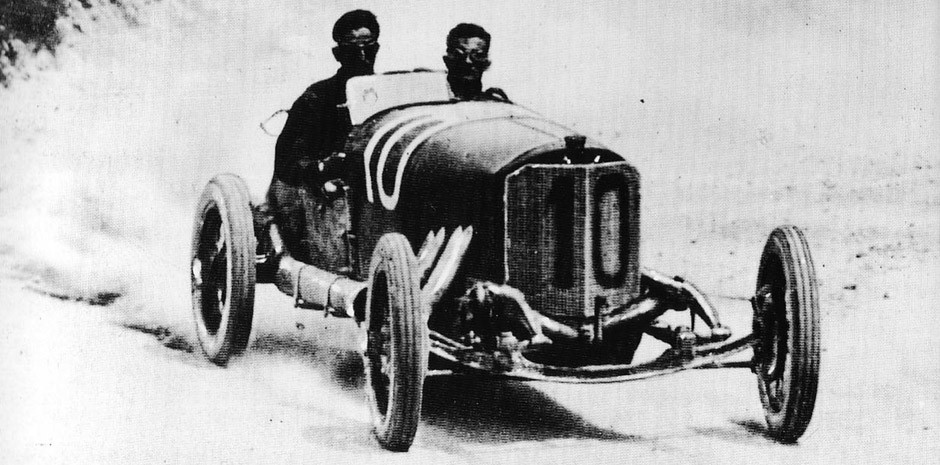
1924 Targa Florio winner Christian Werner in Mercedes PP no.10. The length of the race was 432 km (4 laps of 108 km). 37 cars started. Contrary to the regulations on the colouring of racing cars according to their nationality, this car was painted red instead of white - reportedly this was meant to stop spectators from recognizing the car as a competitor's car and throwing stones at it, a common practice at the time. © unknown.
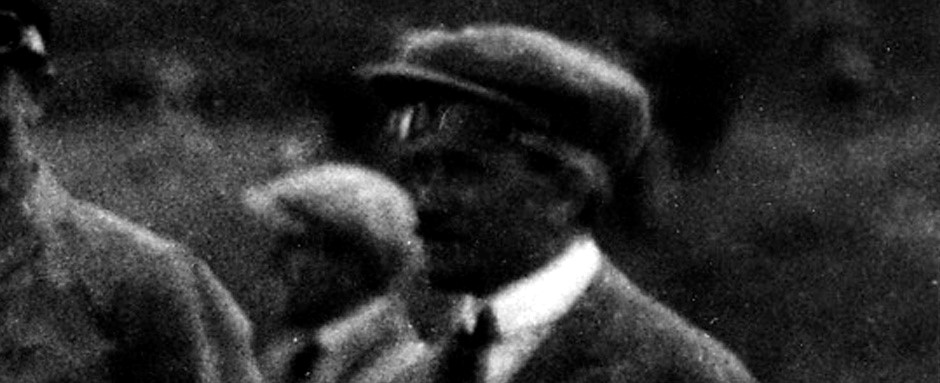
Ferdinand Porsche in 1924. © Porsche.
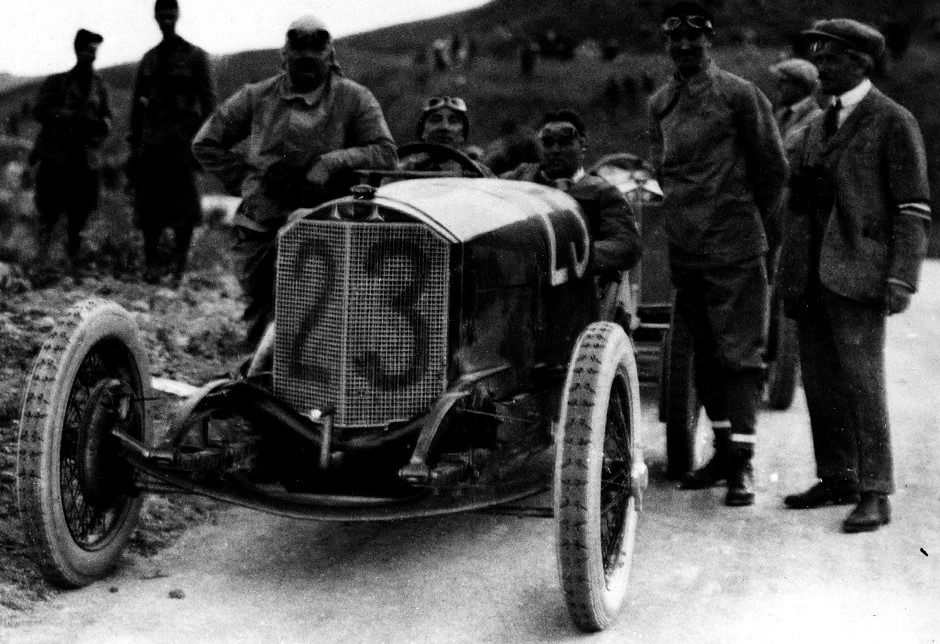
1924 Targa Florio. Mercedes PP's also came 10th driven by Christian Lautenschlager and 15th driven by Alfred Neubauer. In this photo Alfred Neubauer is at the wheel. He moved from Austro-Daimler to Daimler-Motoren-Gesellschaft in Stuttgart-Untertürkheim two months after Ferdinand Porsche and in the 1930s and 1950s he was Daimler-Benz's racing manager. © Porsche.
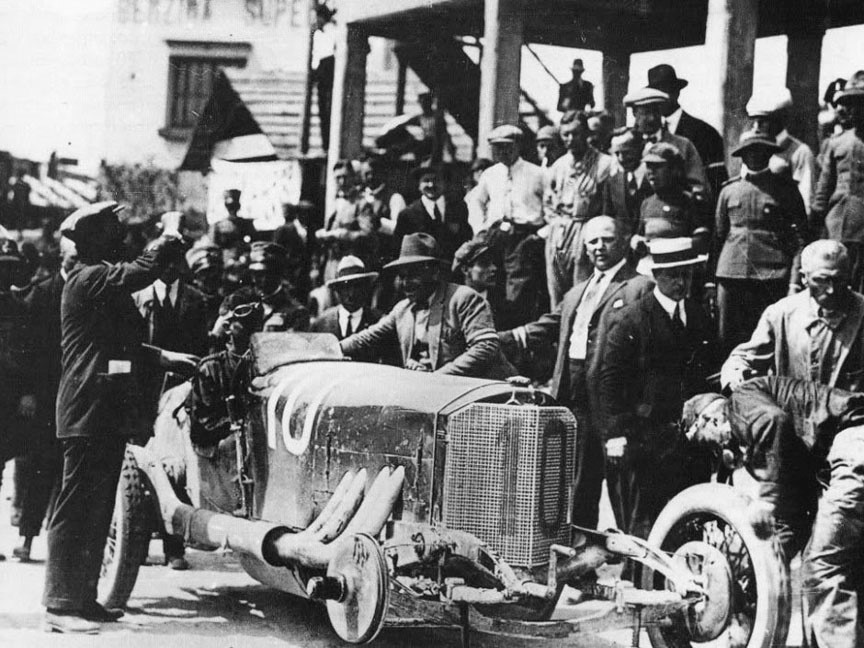
1924 Targa Florio winner Christian Werner's Mercedes PP. © unknown.
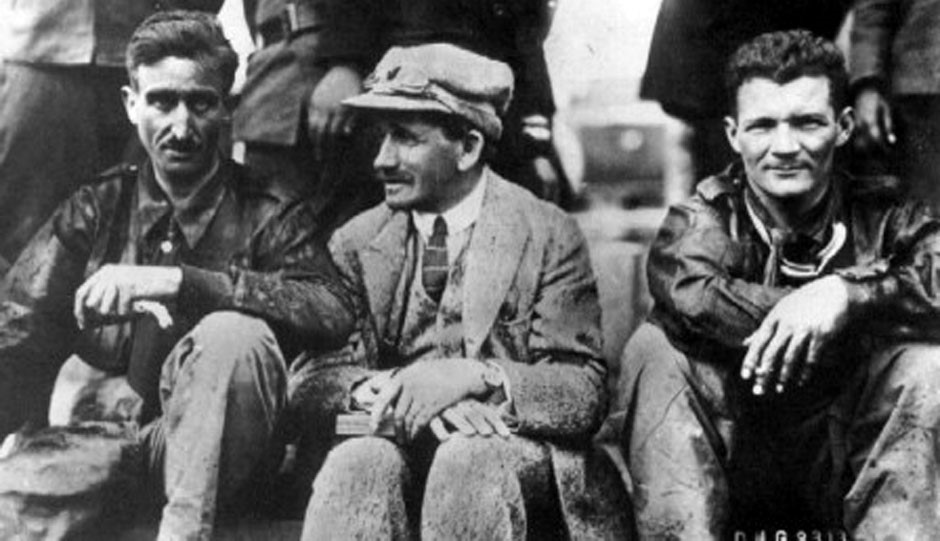
1924 Targa Florio. © unknown.
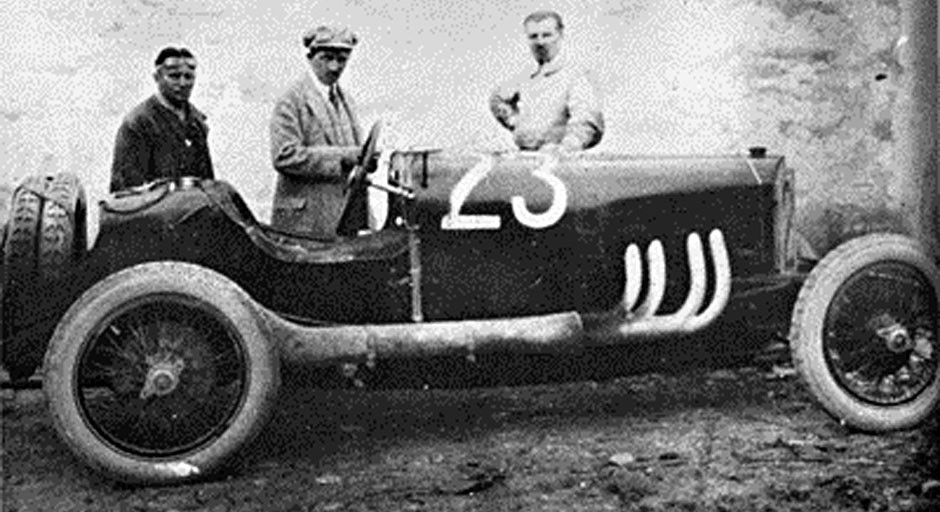
1924 Targa Florio. © unknown.

1924 Targa Florio. © unknown.
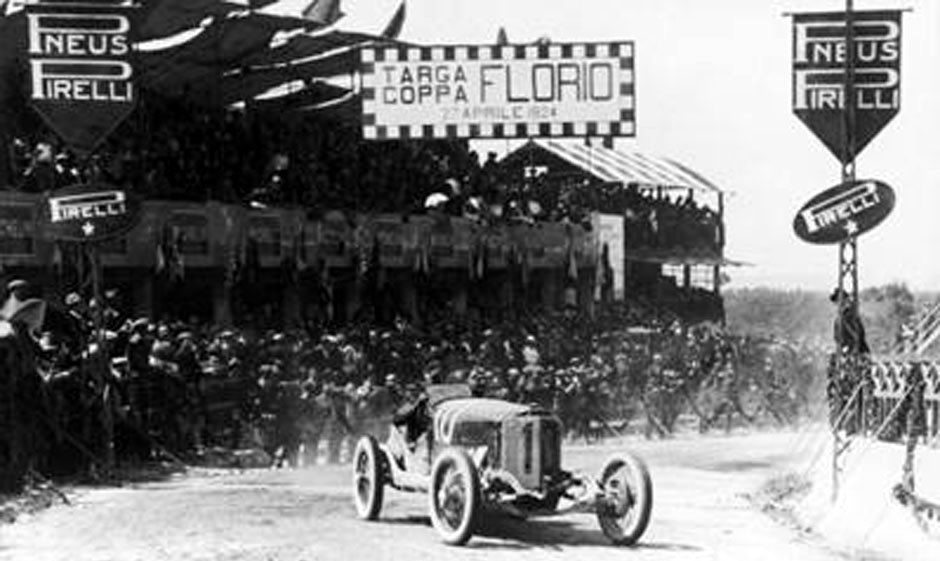
1924 Targa Florio winner Mercedes PP n.10. © unknown.
The same year, 1924, saw the introduction of the new racing car designed by Porsche, the Mercedes Monza. It was the first 8-cylinder Mercedes racer and had the following specifications: supercharged 2-litre inline-8, 170 hp @ 7000 rpm, 3-speed transmission, 94 litre fuel tank, 780 kg/1720 lbs, 180 km/h (112 mph).

Mercedes Monza wasn't successful at the 1924 Monza race, but in 1926 it won the German GP. © Daimler.
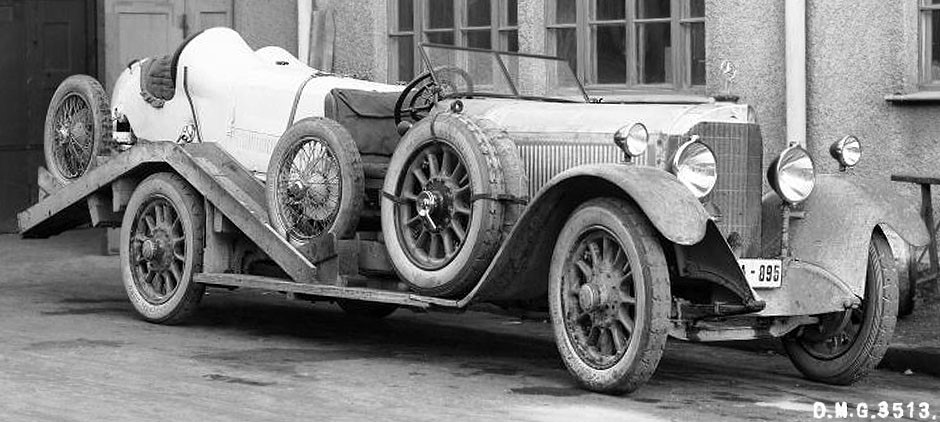
Mercedes Monza on the 1924 Mercedes race car transporter. It had been Alfred Neubauer's and Christian Werner's idea not to use racing cars for the journey to the races. So, with the 1924 Monza race, it was the first time the racing cars were carried to the race and not driven there. © Daimler
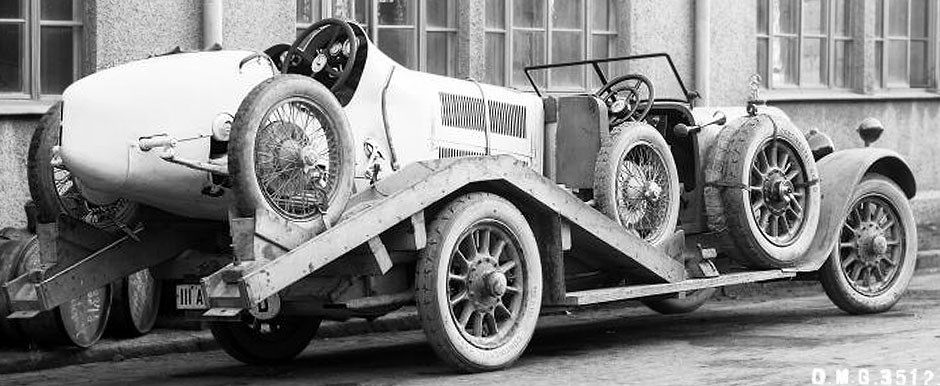
© Daimler.
1925 Mercedes 24/100/140 K, a heavy touring car was developed for racing purposes. Specs: supercharged 6.2-litre inline-6, 118 kW, 4-speed transmission, 110 litre fuel tank, 155 km/h (96 mph).
1926. On June 28, Daimler-Motoren-Gesellschaft and Benz & Cie. merged to form Daimler-Benz AG.
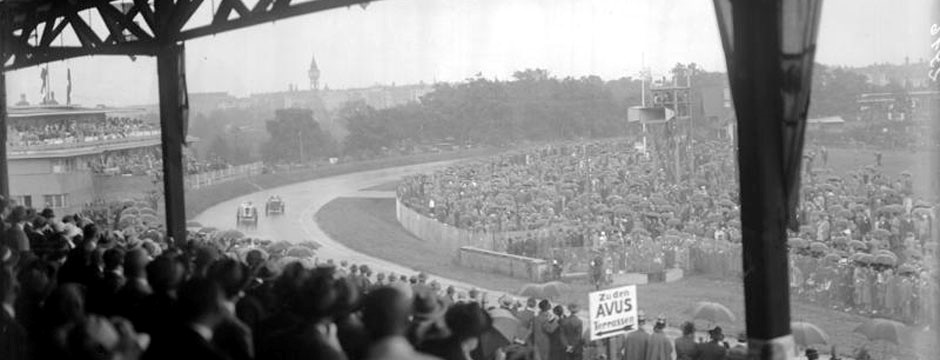
1926 July 11, German GP at Avus. © Bundesarchiv.
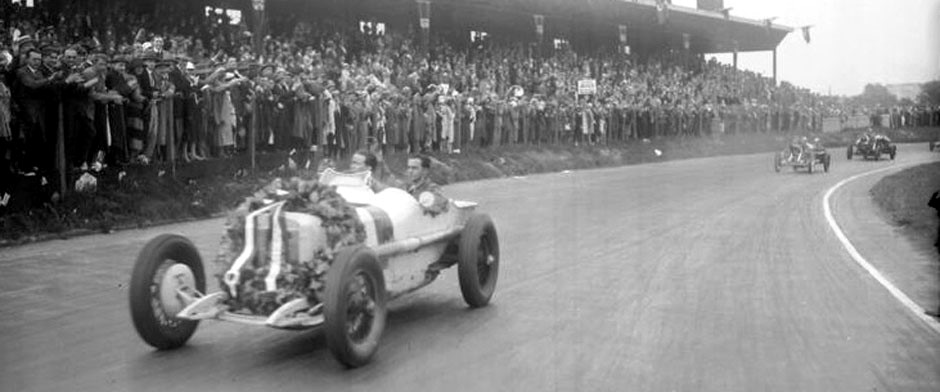
1926 German GP at Avus, Rudolf Caracciola wins with Porsche designed Mercedes Monza with average speed of 135 km/h (84 mph) over the 392 km (244 mile) total distance of 20 laps. The other Mercedes, driven by Adolf Rosenberger, crashed into the timekeepers' box killing 3 persons. Five years later Rosenberger would become the founding member of the Porsche company. © Bundesarchiv.
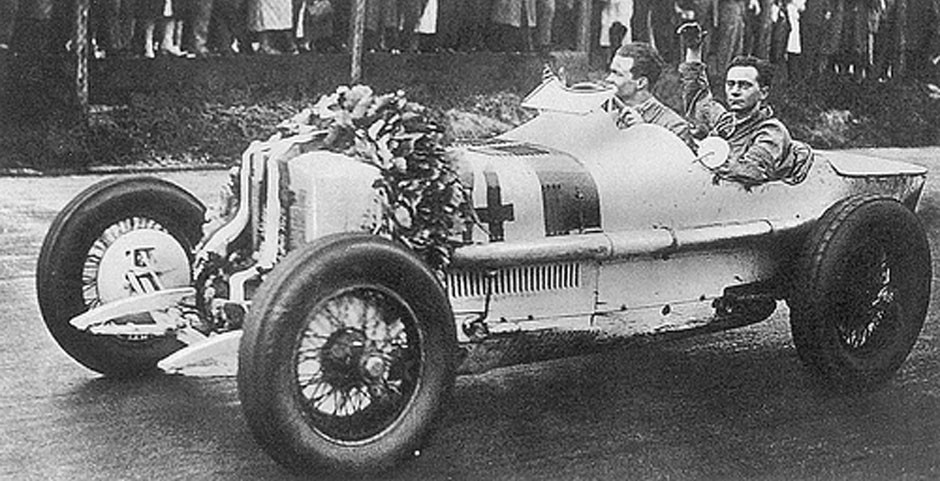
1926 German GP, Avus, Rudolf Caracciola at the wheel of the Mercedes Monza. © unknown.
1927. On June 19, Mercedes-Benz 26/120/180 S-model cars entered the German Grand Prix - the first race on the new Nürburgring - and finished 1st, 2nd and 3rd. Caracciola took the victory.

1927 June 19, start of German GP at Nürburgring. © unknown.
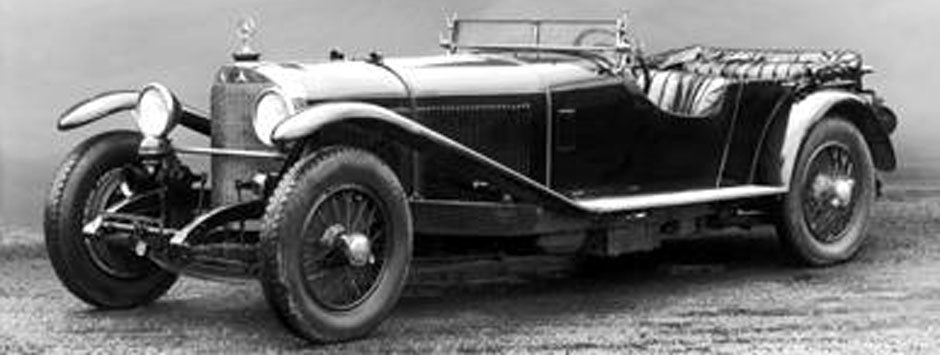
This is Mercedes-Benz S-model that is based on the K-model. The "S" had a 6.8-litre engine producing 132 kW and a top speed of 160 km/h (100 mph). © unknown.
1928. On July 15, the German GP at the Nürburgring saw Mercedes-Benz 1-2-3 victory again. Rudolf Caracciola / Christian Werner took the win in a Mercedes-Benz 27/140/200 "SS". This was a more powerful version of the "S". It had a 7.1-litre engine producing 147 kW and a top speed of 170 km/h (106 mph). "SS" standed for "SuperSports". In 1928, also the SSK ("SuperSports Kurz"), the short version of the SS was introduced with an output of 184 kW from the same 7.1-litre engine and with a top speed of 192 km/h (119 mph). On October 4, the Mercedes-Benz "Nürburg" 460 (18/80 hp), the first Mercedes-Benz production car with an 8-cylinder inline engine, was launched at the Paris Motor Show. Dr. Porsche left Daimler-Benz at the end of the year.
1929. Dr. Porsche took up the position of Technical Manager at Steyr-Werke AG in Austria. Grandson Ernst Piėch was born.
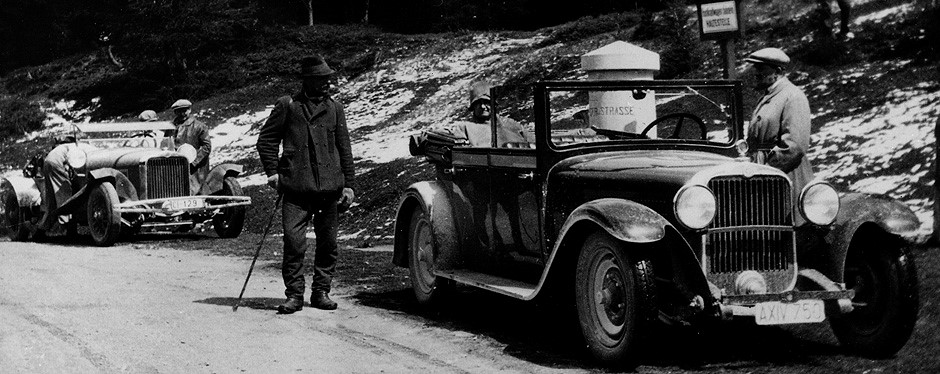
1929. Experimental run up the Katschberg Pass, Carinthia, Austria, in a Porsche's Steyr Type 30. The car had an 8/40-hp side-valve six-cylinder engine. © Porsche.
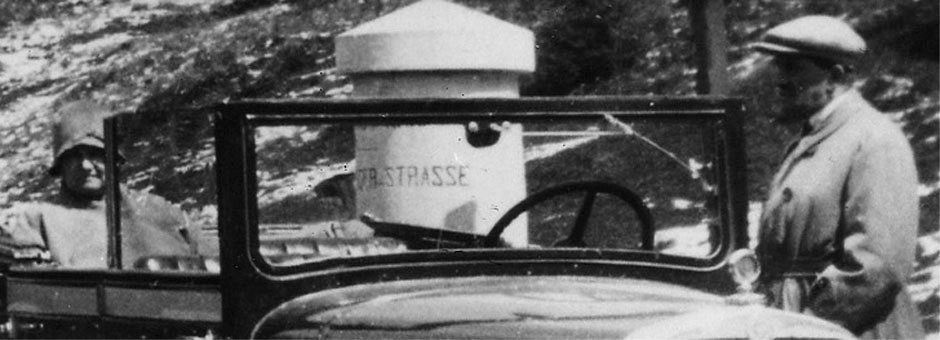
1929. Aloisia and Ferdinand Porsche. © Porsche.
1931. On January 1, rental agreement started for Porsche's own design office at Kronenstrasse 24, in the center of Stuttgart (Ferdinand Porsche had actually moved in already in December 1930). The company was officially registered a few months later.
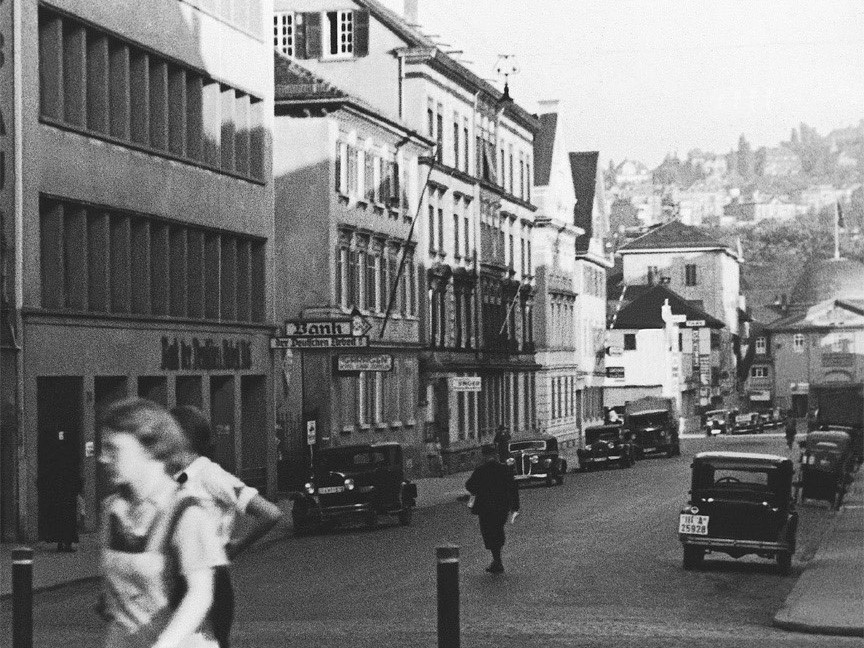
Kronenstrasse in the center of Stuttgart. The building on the left bears the number "24". © Porsche.
On April 25, 1931, at the age of 55, Ferdinand Porsche finally registered his own company. It was recorded in the Commercial Register as “Dr. Ing. h. c. F. Porsche GmbH, Konstruktionen und Beratung für Motoren- und Fahrzeugbau” (Dr. Ing. h.c. F. Porsche LLC, Design and Consultancy Company for Engine and Vehicle Production). The company was co-founded by Dr. Anton Piëch (10%) and racing driver Adolf Rosenberger (10%).
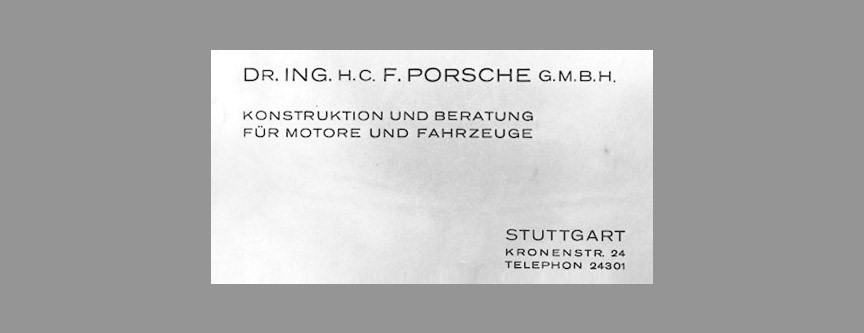
© Porsche.
Following the establishment of the company, on August 10, 1931, the torsion bar suspension was registered for a patent. It is said that this alone would have sufficed to commemorate the Porsche name in the automobile world.
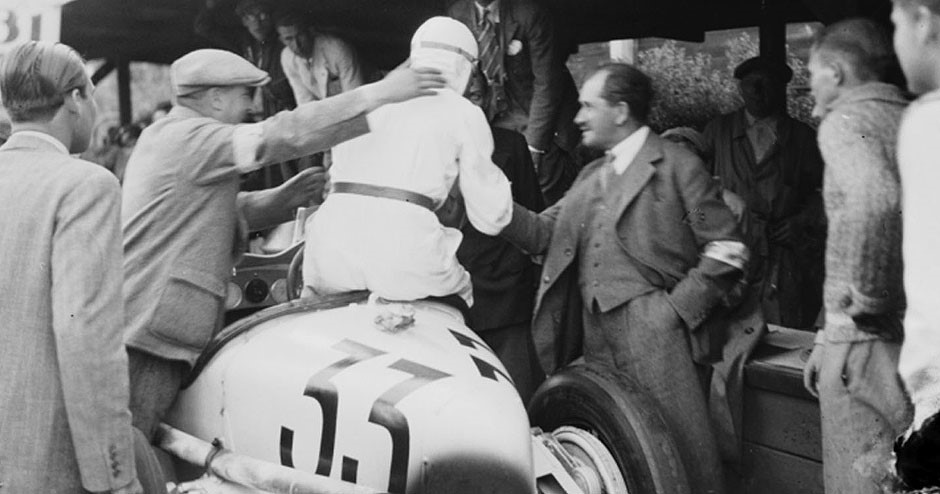
1932 May 22, AVUS race track. Ferdinand Porsche congratulating ex-Mercedes driver Rudolf Caracciola on the second position achieved with the Alfa Romeo 8C Monza. © Zoltan Glass, nationalmediamuseum.org.uk.
1932. Granddaughter Louise Piėch (Daxer) was born. Porsche was contracted by Wanderer to design a supercharged 16-cylinder Grand Prix racing car for the new 750 kg-formula. The same year Wanderer, DKW, Audi and Horch all had financial difficulties and the biggest amounts they owed to Bank of Saxony, which then merged all the brands into one company called the Auto Union. The new company got a logo with four rings (and although only one of these rings symbolized Audi, by the end of 1960's the 4 ring logo became an Audi logo). On November 8, 1932, Porsche founded a special company called the Hochleistungs-Fahrzeug-Bau G.m.b.H. (High Performance Vehicle Manufacturing Ltd.) with its location also at Kronenstrasse 24. The company was founded solely for the purpose of designing the Porsche Type 22 Auto-Union GP race car. The Auto Union P-wagen (P-car, Porsche-car) later won 32 races out of 64 and drivers such as Hans Stuck and Bernd Rosemeyer set many world records in them.
In 1932 Porsche also visited the Soviet Union at the request of Josef Stalin, who offered him a post as chief construction director, complete with generous compensation, a villa and the transfer of his entire Stuttgart staff. He was also promised unlimited development funds to build a small car. Porsche, who still loved to race his own cars on the race tracks, declined the offer since the European Grand Prix did not extend to Soviet Union.
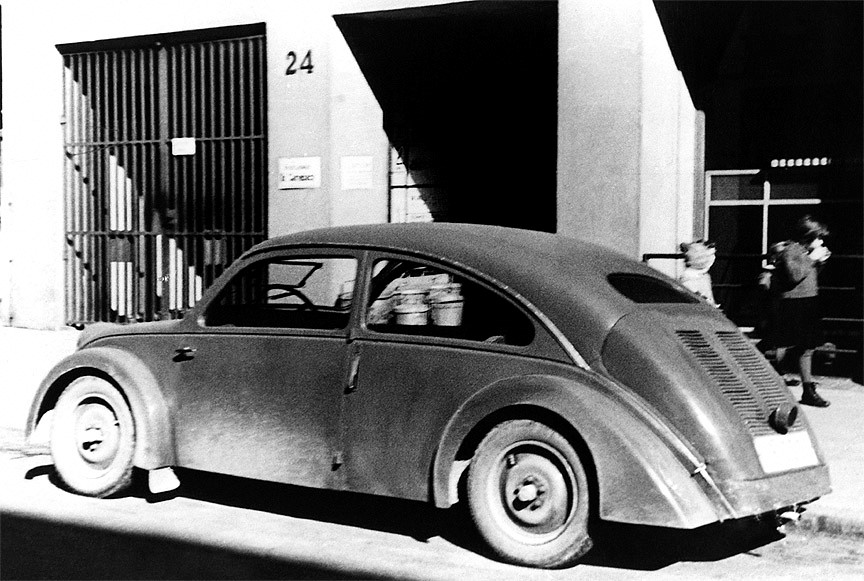
1933 Porsche type 32 NSU in front of the Porsche Engineering Office at Kronenstrasse 24, Stuttgart. © Porsche.
1934. A contract was concluded between the Porsche design office and the Reichsverband der Automobilindustrie - the idea of Volkswagen was born. In the following period, Ferdinand Porsche was one of the general managers of Volkswagen GmbH.
In 1934, the supercharged 16-cylinder Auto Union racing car (Porsche Type 22) was born. The "750-kilogram formula" imposed no restrictions on the car's design apart from a maximum weight limit of 750 kg. Despite Porsche company founder Adolf Rosenberger's contribution to the development of German automobiles and German auto racing when Hitler came to power, Rosenberger, a Jew, was arrested and forced to leave Germany. He emigrated and represented Porsche GmbH in France and later in Great Britain.
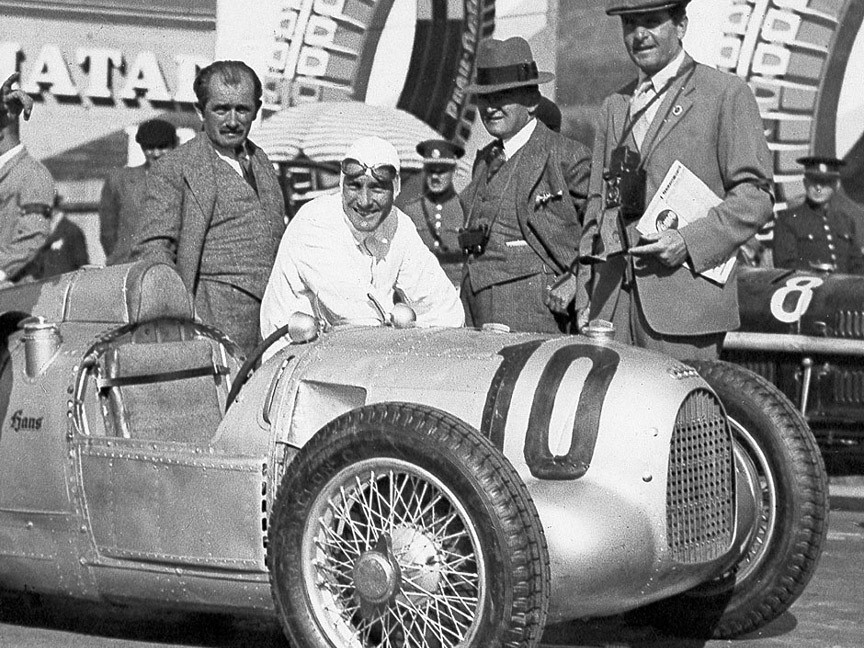
1934 Brno GP at Masaryk-Ring, F. Porsche with Hans Stuck and Auto-Union. © Porsche.

1935 Nürburgring, Karusell-curve, Auto Union driven by Hans Stuck. © f1-grandprixhistory.net.
1935. On December 11, grandson Ferdinand Alexander Porsche was born.
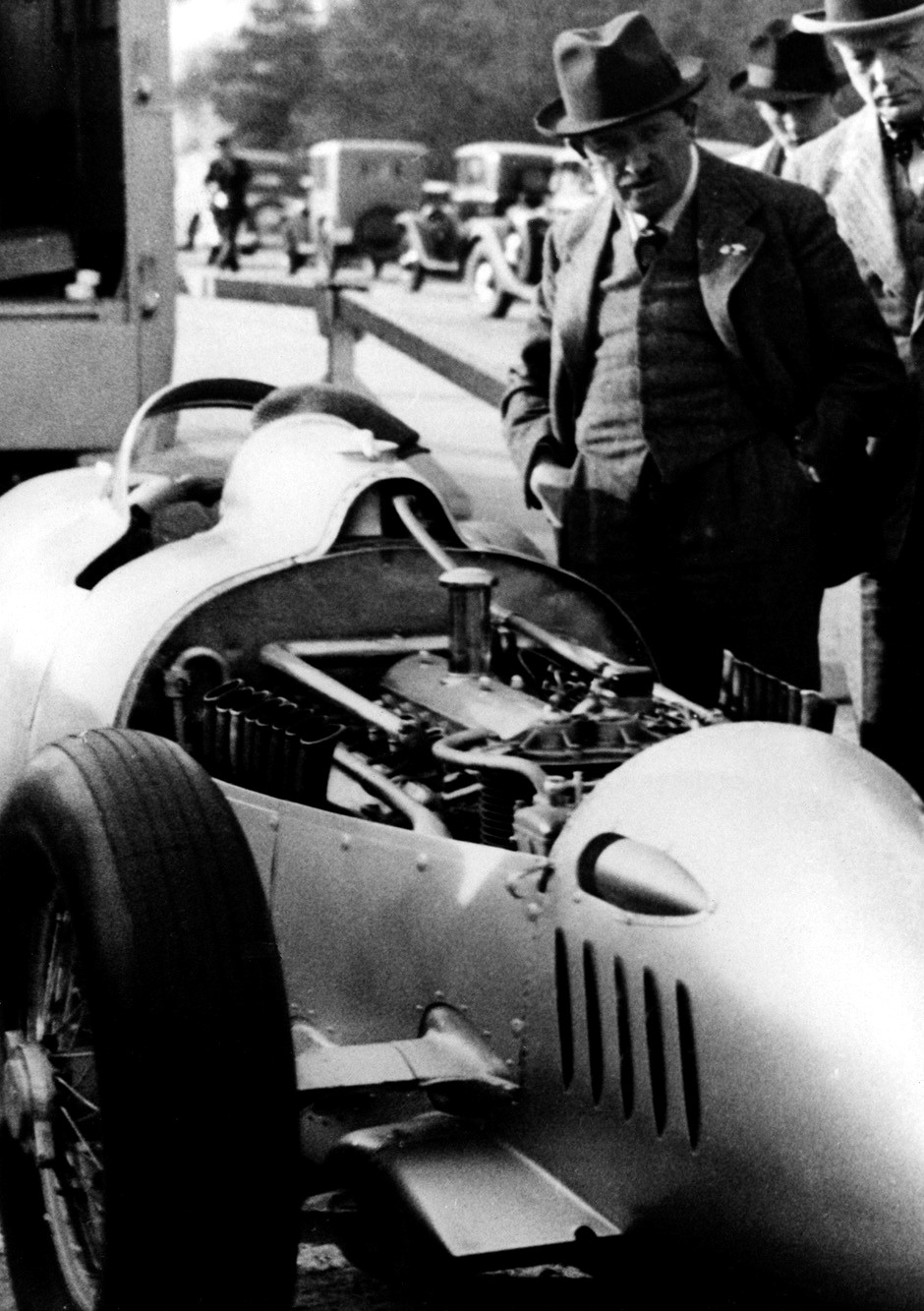
1936. Ferdinand Porsche with Porsche Type 22 (Auto Union P-Wagen). © Porsche.

Ferry Porsche in 1936 at the wheel of the Volkswagen prototype v2 in Tubingen.
1936. F. Porsche received the Wilhelm Exner Medal for excellence in research and science. On October 3, F. Porsche together with his nephew and private secretary Ghislaine Kaes started their voyage to USA onboard of the SS Bremen. Porsche wanted to study American automobile manufacturing in order to gather information for the Volkswagen plant.
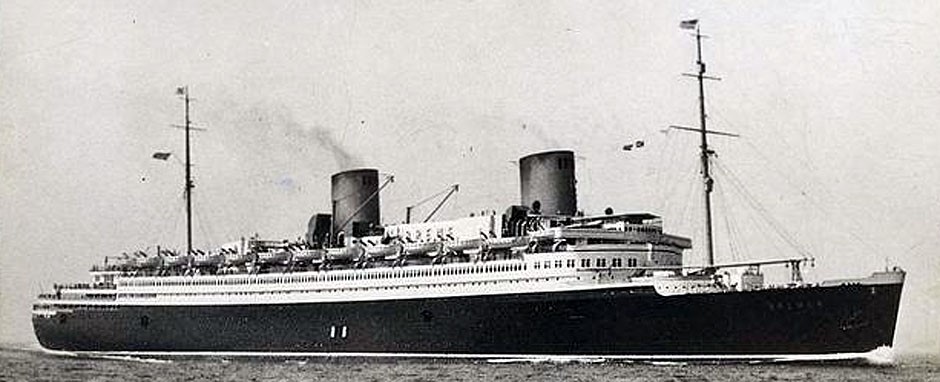
SS Bremen started its voyage on October 2, 1936, from Bremen. Its first stop was in Southampton, England. Before heading to the Atlantic Ocean, the ship stopped in Cherbourg, France. F. Porsche and G. Kaes stepped on board there on October 3. © unknown.
The passenger list from October 3, 1936, tells us that Ferdinand Porsche lived at Feuerbacherweg 48, Stuttgart, was 5'8" (172-173 cm) tall, had gray hair and blue eyes. Below is a concentrated information from that list:

While for the whole world Porsche was a constructor, for the SS Bremen he had become a "conductor".

© Ancestry.com.
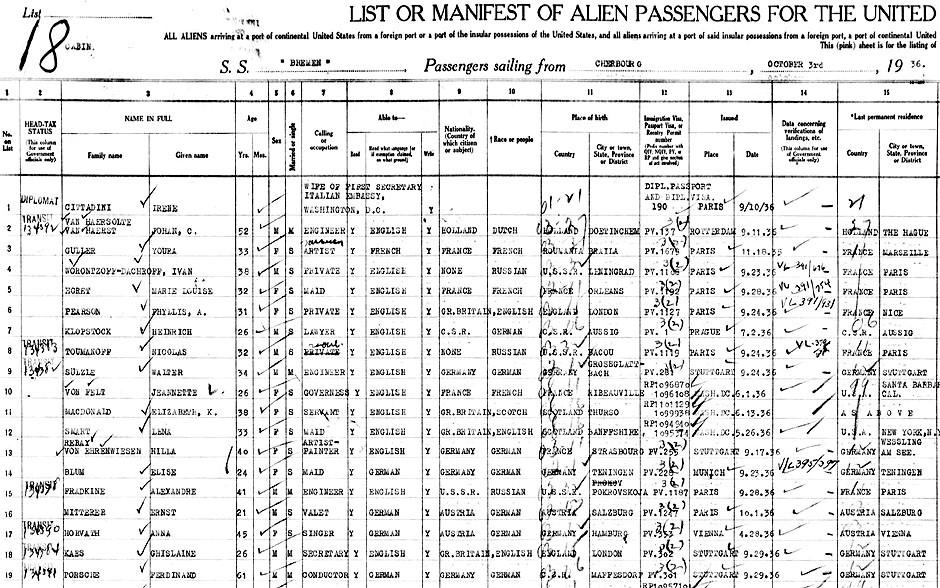
SS Bremen passenger list from October 3, 1936, showing Kaes Ghislaine and Porsche Ferdinand. Other prominent persons on board of SS Bremen between October 2-8, 1936, included electrical engineer Max Knoll, aeronautical engineer Frank Caldwell, aviator William Douglas Stock Sanday, racing driver and one of the founders of Squire car company Gerard Francis Anthony "Jock" Manby-Colegrave, engineer Ernst Grob, son of bakelite inventor George Baekeland, astronomer Joseph Helffrich, architect John Russell Pope, Telefunken director Hermann Behner, industrialist Richard Merton, Prince of Sayn-Wittgenstein-Berleburg, Swedish prince Sigvard Bernadotte, novelist Johanna van Ammers-Küller, violin virtuoso and composer Fritz Kreisler, conductor, pianist and composer Wilfrid Pelletier, physicist August Karolus, industrialist Frank Vlchek, banker Rudopl Hermann Kissel, American tobacco heiress Mary French Stephenson (wife of spy William Stephenson, a role model for James Bond), screenwriter Edwin Blum ("The New Adventures of Tarzan", 1935), writer and musician Albert Morris Babgy, first American business woman and Coca-Cola board member Letitia Pate Whitehead Evans, writer Ernest Pascal, pianist Youra Guller, painter and Guggenheim Museum co-founder Hilla Rebay von Ehrenwiesen, world's biggest media magnate's wife Millicent Hearst, Broadway producer Gertrude Macy, Titanic survivor and White House music teacher Marie Grice Young. © Ancestry.com.
With about 2000 souls onboard, the ship docked in New York on October 8. Porsche visited various car factories in USA and familiarised himself with the latest production methods. He returned to Europe in November (?) on Queen Mary.
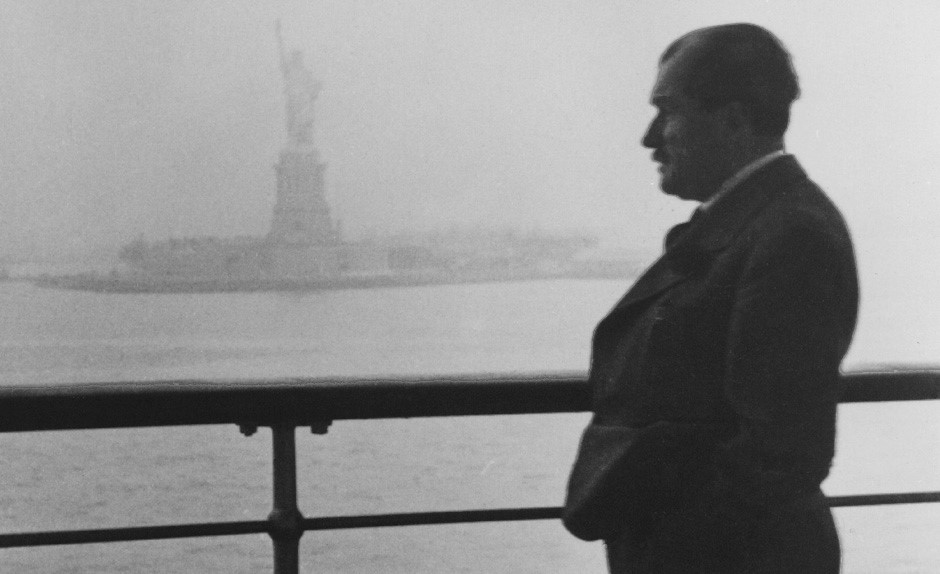
1936 New York. F. Porsche returning home aboard Queen Mary which had made her maiden voyage the same summer. © Porsche.
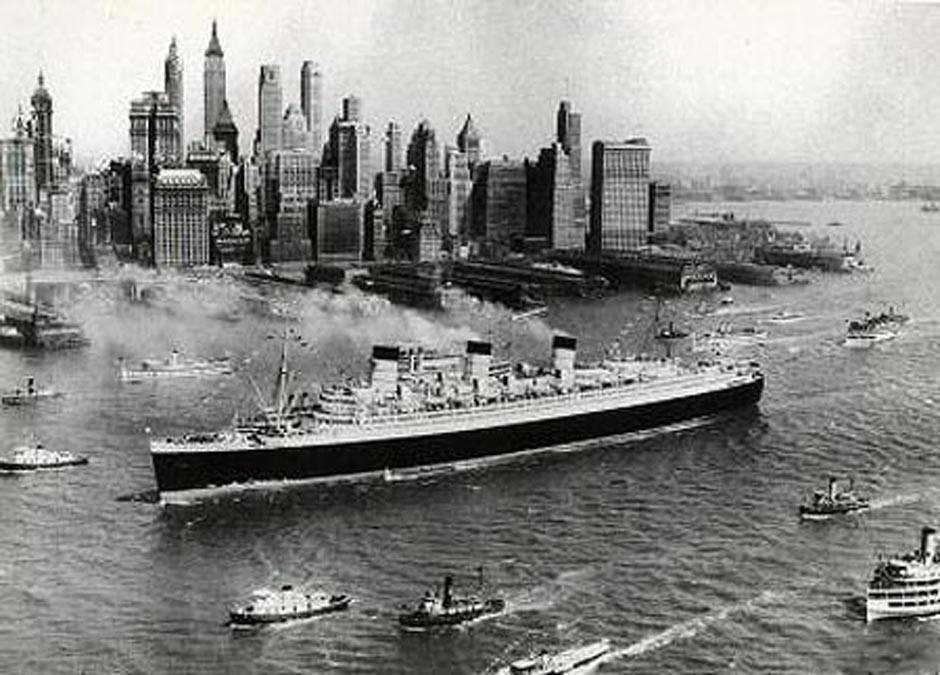
1936 was the year of the maiden transatlantic voyage for Queen Mary and in August she made a new world record by arriving in NYC in under 4 days. © unknown.
1937. On April 17, grandson Ferdinand Karl Piėch was born. In June, F. Porsche made his second US visit together with his son Ferry and secretary G. Kaes. Estonian car magazine "Auto" 3/4-1937 wrote: "people's car (Volkswagen) is a headache! Dr. Porsche, the constructor of the Auto-Union racing cars, said that it is easier to build 10 racing cars than 1 people's car."
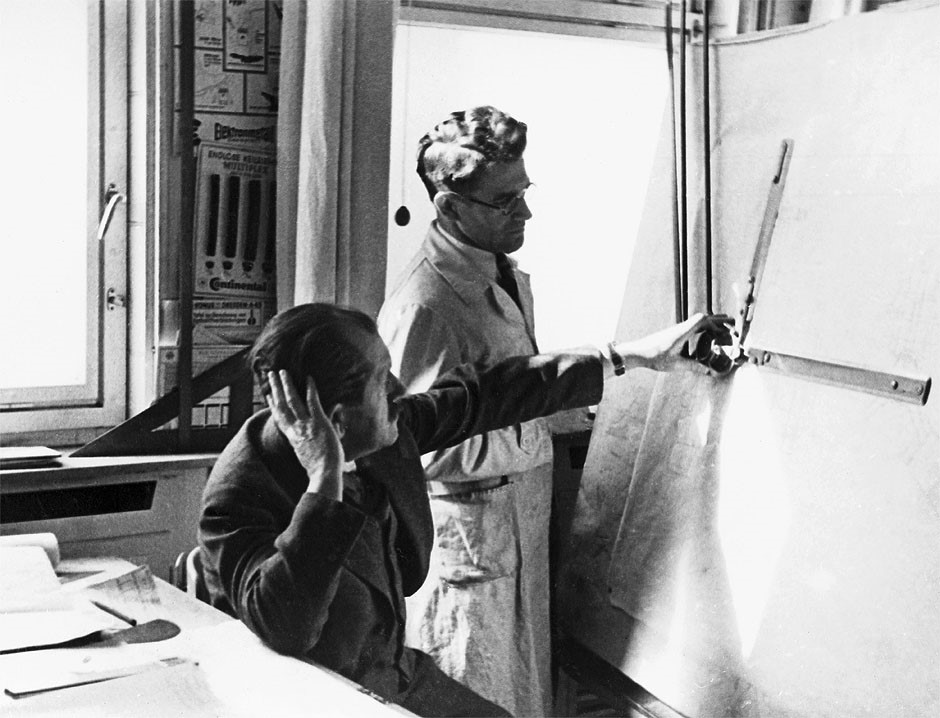
1937. F. Porsche and engine specialist Josef Kales in the Porsche engineering office at Kronenstrasse 24 in Stuttgart. © Porsche.
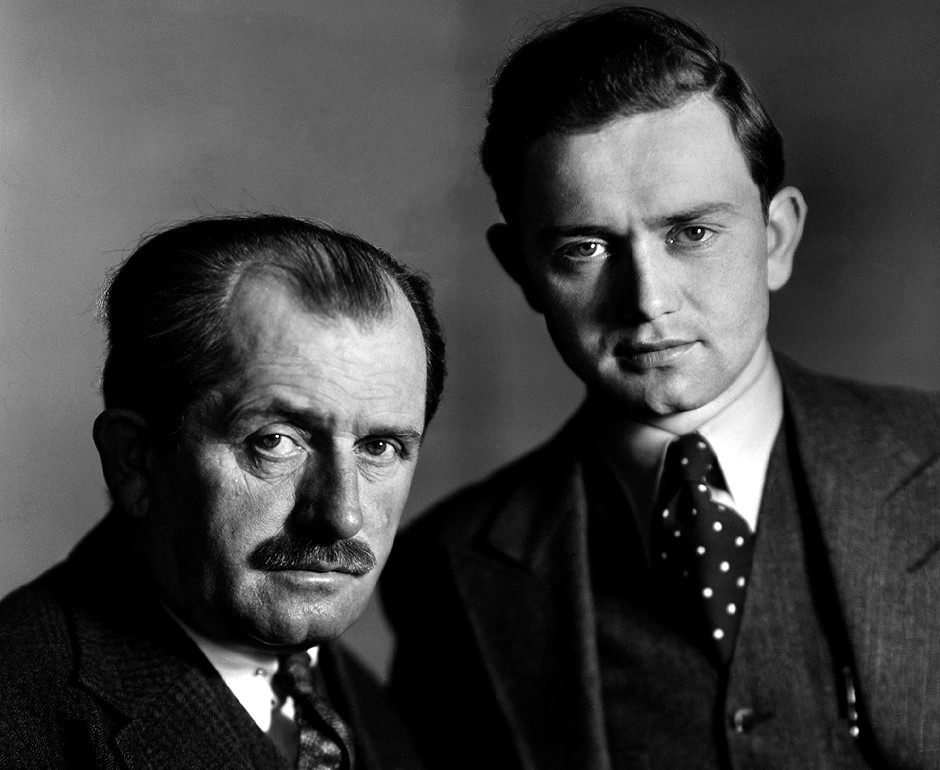
1937. Ferdinand Porsche with his son Ferdinand Anton Ernst "Ferry" Porsche. © Porsche.
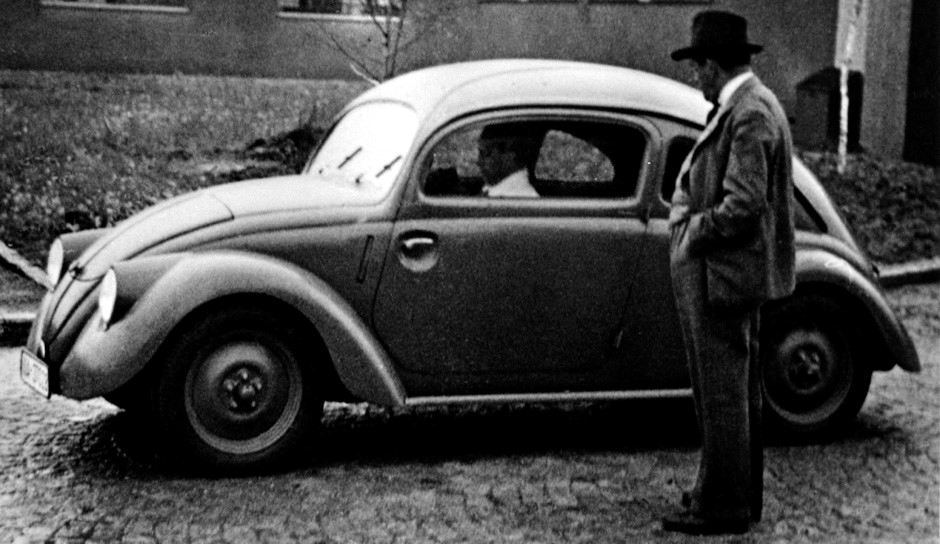
1937. Ferdinand Porsche seen with a car from the W30 series of Volkswagen prototypes. This car already had an all-steel body, steel running-gear components and the flat-four four-stroke engine. The first of this series of cars, like all the previous prototypes, was built in the double garage of Porsche's villa in Stuttgart. The remaining 29 cars were built by Daimler-Benz in Stuttgart-Untertürkheim. © Porsche.
In 1937, the German Armaments Ministry issued a specification for a heavy tank to Daimler-Benz, Henschel, MAN and Porsche. The same year also the Mercedes-Benz T80 (Porsche Type 80) land speed record car project was started backed by the funds from the state, Dr. Porsche's ingenious ideas, aerodynamics specialist Josef Mikcl and driver Hans Stuck. Porsche first targeted a speed of 550 km/h (342 mph), but later the target was rised.
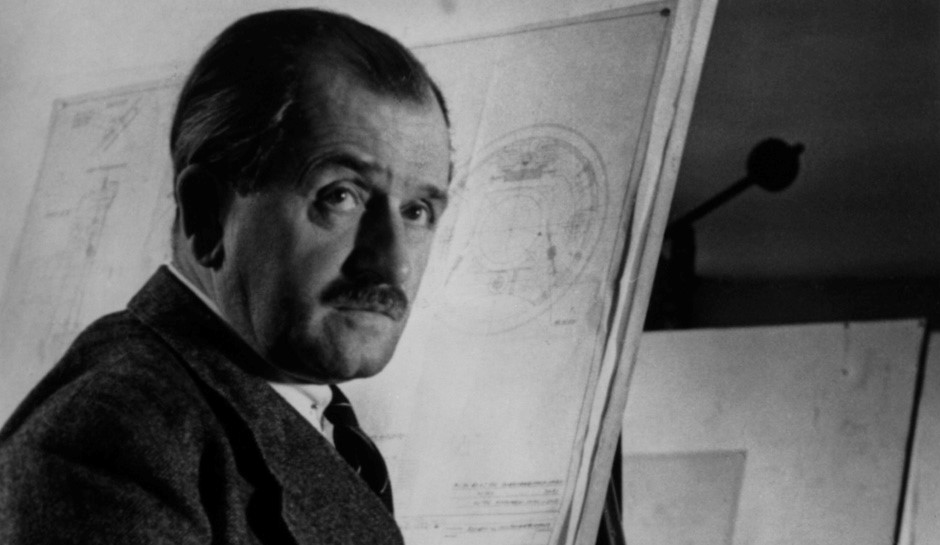
1937-1938 Ferdinand Porsche at the age of 62 in his design office located at Kronenstraße 24, Stuttgart. © Porsche.
1938. Although Adolf Hitler discussed the possibility of military application of the Volkswagen with Ferdinand Porsche as early as April 1934, it wasn't until January 1938 that high-ranking Third Reich army officials formally approached Porsche with this plan. They wanted Porsche to design an inexpensive, light-weight military transport vehicle that could be operated reliably both on- and off-road in even the most extreme conditions, suggesting that the Beetle could provide the basis for such a vehicle. In May 1938, the construction of the Volkswagen Kübelwagen prototype (Porsche Type 82) started and 16 months later, pre-production models were field-tested in the invasion of Poland in September 1939.
Estonian "Auto" magazine 5/1938 wrote that the KdF-wagen (Volkswagen) factory construction started in May 1938 and after it will be finished, 50.000 workers will be hired. The article wrote that no other car in the world had passed so many and so long tests as Dr. Porsche's people's car. Initial information said, the car will weigh only 650 kg, will consume 6-7 litres of fuel on 100 km and standard color will be dark blue. Acceleration 0-70 km/h was promised in 14 seconds which was comparable to the cars with larger engines.
F. Porsche's grandson Gerhard Anton Porsche was born on June 5, 1938. While at the end of 1931 Porsche engineering company had around 20 employees, the number had rosen to around 200 by 1938. At the end of June, Porsche company moved to a new purpose-built building in Zuffenhausen, just 7 kilometres away. At that time the address was Spitalwaldstraße 2. Later the building became known as Porsche Werk 1.
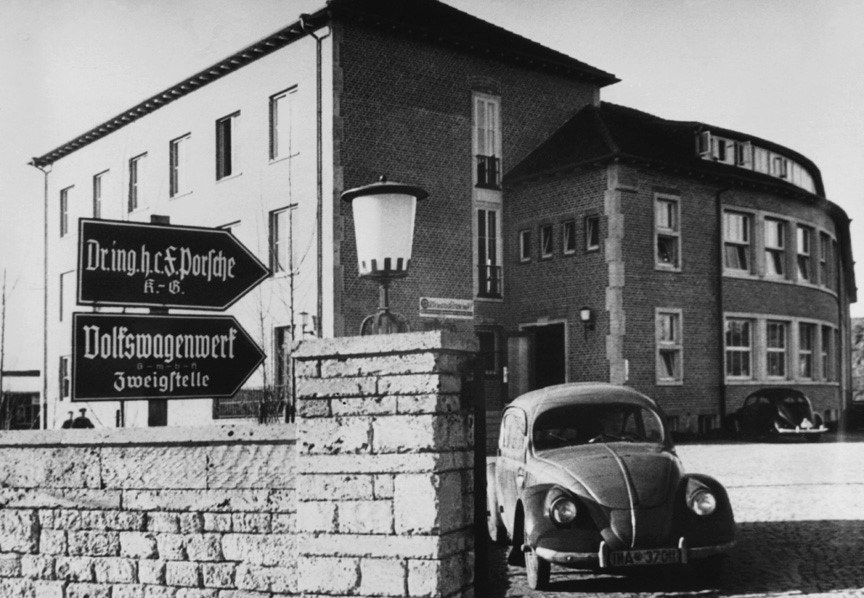
1938. The purpose-built headquarters for Porsche company in Zuffenhausen, later known as Porsche Werk 1. As can be seen from the upper sign the company was changed from GmbH (Gesellschaft mit beschränkter Haftung, limited liability company) to KG (Kommanditgesellschaft, limited partnership business) and as can be seen from the lower sign, space was rented also for Volkswagenwerk Zweigstelle (a branch office of Volkswagen). © Porsche.
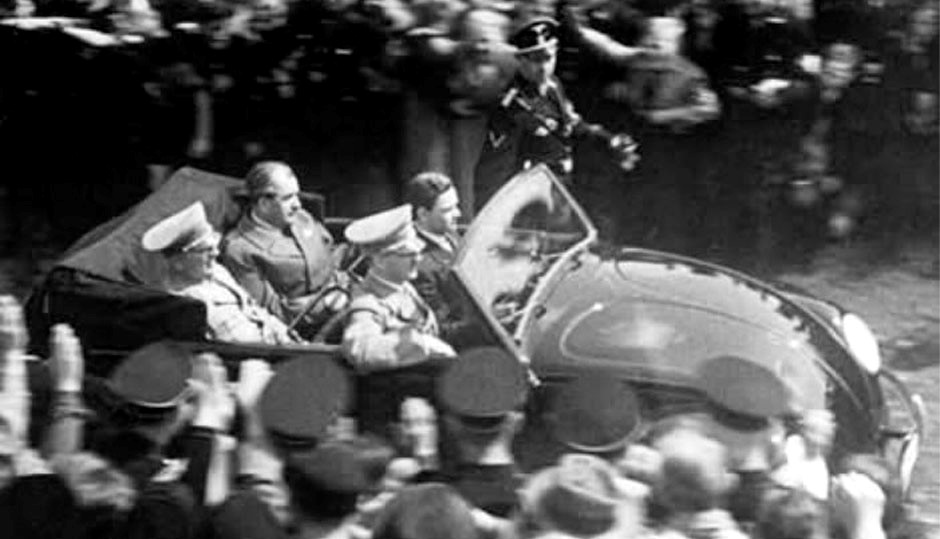
Robert Ley (head of KdF), Ferdinand Porsche and Adolf Hitler driven by Ferry Porsche. The persons sitting on the right seem happy and the persons sitting on the left - not. Porsche got money from Hitler to build the racing cars and the Beetle, but now he "had to" design also the military equipment. © unknown.
1939. A Berlin-Rome road race was scheduled for September, but it didn't happen due to the outbreak of WWII. Porsche had already engineered and built a KdF racing car (Porsche type 64).
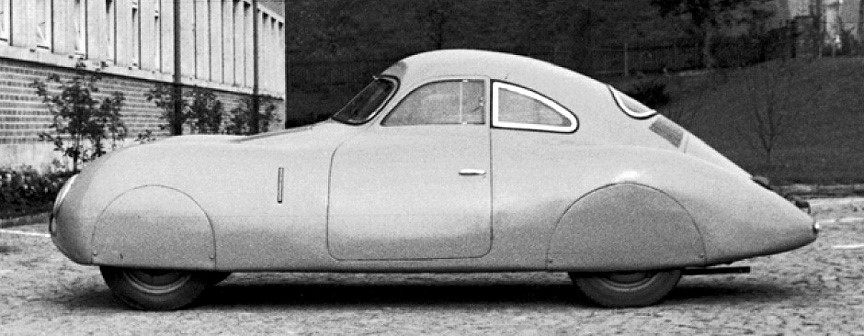
The first type 64 in front of the Porsche villa in Stuttgart. The type 64 was the grandfather of all Porsche sports cars to come. © Porsche.
By late 1939, the Mercedes/Porsche land speed record car T80 was also finished - now with the targeted top speed of 750 km/h (466 mph) - but the record attempt was cancelled due to the outbreak of the war. If the scheduled record attempt would have actually happened, Hans Stuck would have most probably died in January 1940 (and not in February 1978). A part of Berlin-Dessau autobahn was planned to use and it was only 25-27 m (83-90 feet) wide - imagine that at the projected top speed! In winter.
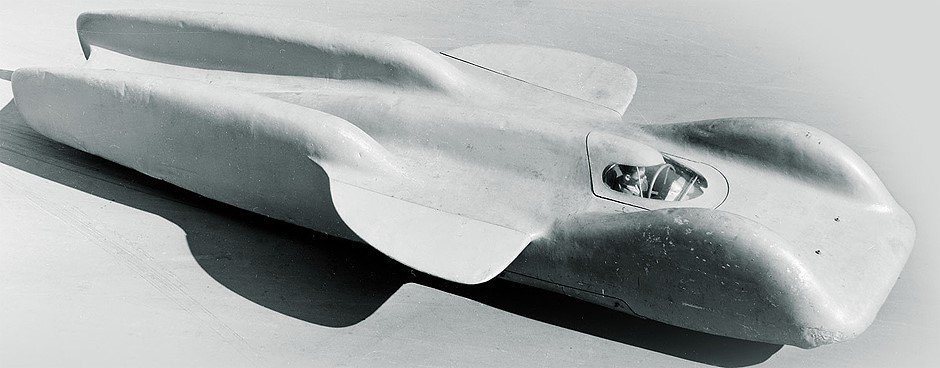
T80 had a tuned Daimler-Benz aircraft engine. The inverted V12 (crank up, cylinders down) with 44 litres displacement developed 3000 hp. The engine ran on a mixture of 7 different chemicals. The streamlined body achieved a drag coefficient of an astonishing 0.18. Kurb weight: 2900 kg (6393 lbs). © unknown.

In 1939, the wished-for top speed was risen to 750 km/h! How would you feel if you were the guy in the cockpit? No car in the world with piston engine and wheel drive has ever reached 750 km/h. © unknown.
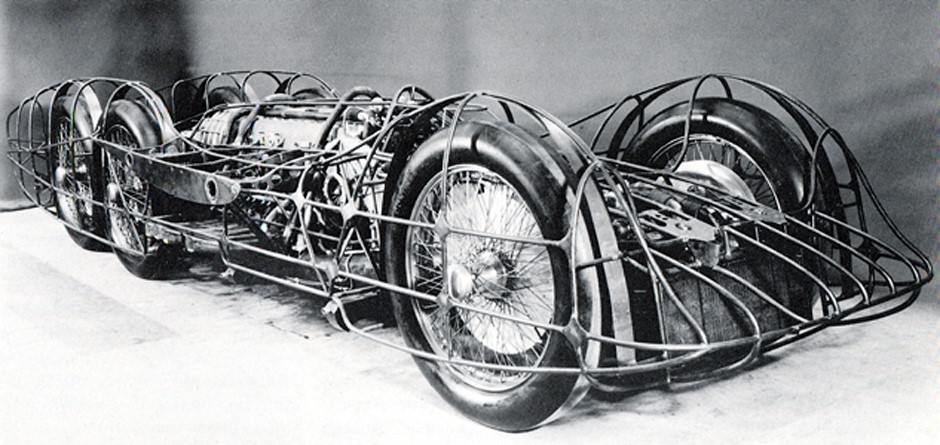
The DB-603 aircraft engine was removed during the war while the vehicle was moved to safe storage in Kärnten, Austria (where Porsche had moved its company because of the war). The T80 survived the war and is now displayed in Mercedes-Benz Museum in Stuttgart. © unknown.
1940. On October 29 grandson Hans-Peter Porsche was born. On the same year, Ferdinand Porsche was conferred the honorary title of professor.
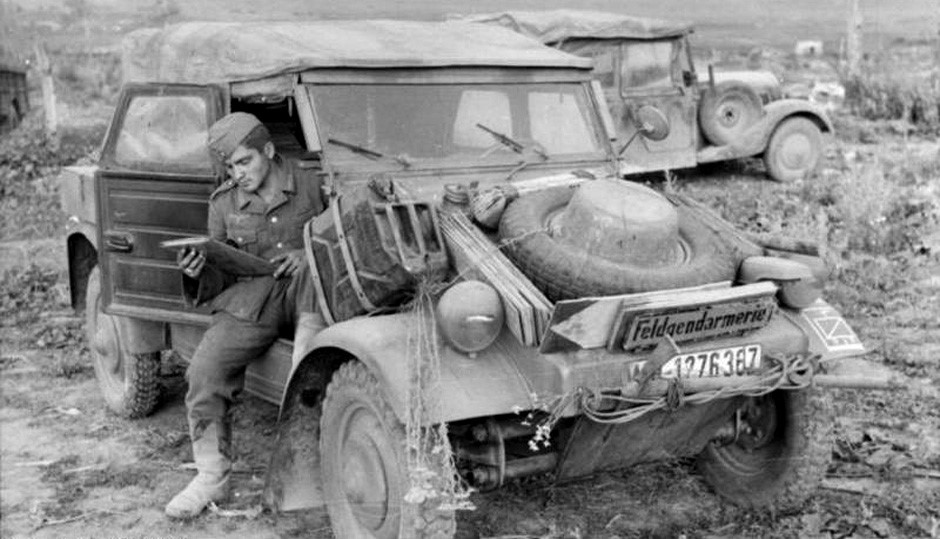
1940-1945 a total 50.435 Porsche designed VW Kübelwagens were made. Photo taken in 1943 in Russia. © Bundesarchiv.
1941. On May 26, Hitler ordered both Porsche and Henschel to supply their designs for a heavy tank. The project was known as the "Tigerprogram".
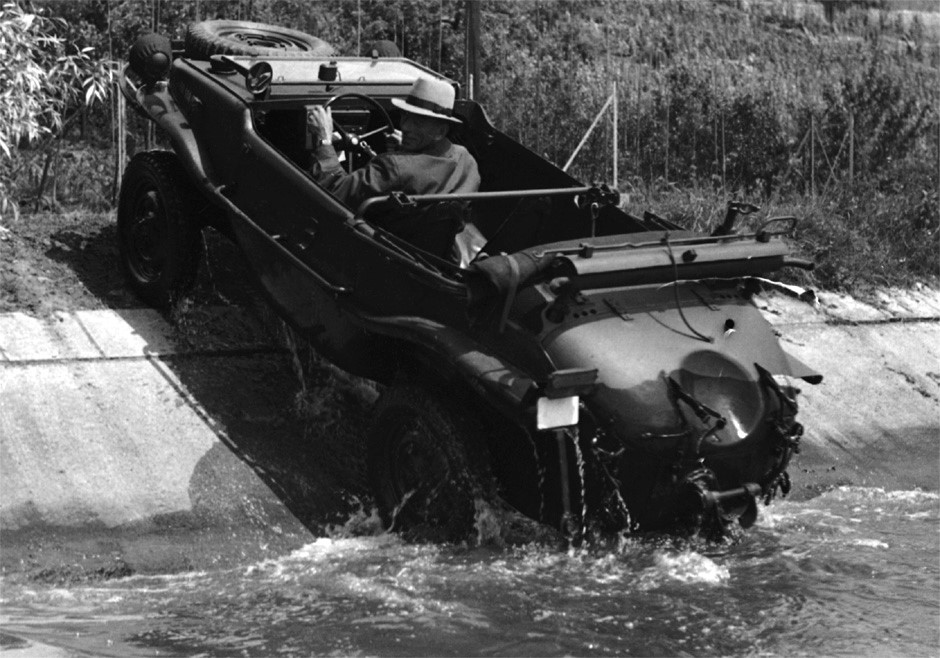
1941-1944 a total of 15.584 Type 166 Porsche designed VW Schwimmwagens were produced; 14.276 at the Volkswagen factory and 1308 by Porsche. © Porsche.
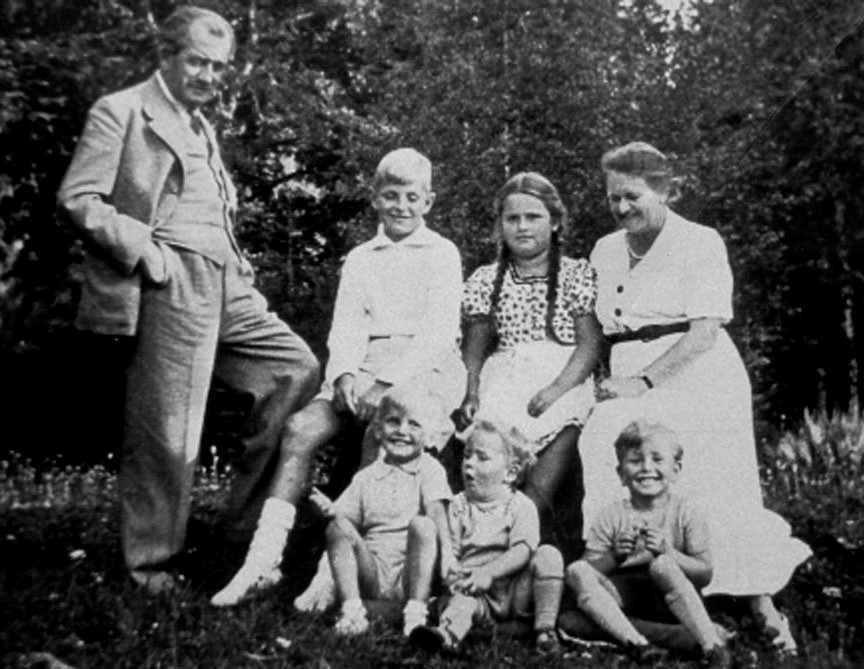
ca 1942. Ferdinand Porsche, grandson Ernst Piëch, granddaughter Louise Piëch, daughter Louise Piëch-Porsche. Sitting on the grass on the left is Ferdinand Piëch. © Porsche.
1942. On January 10, grandson Hans-Michel Piėch was born.
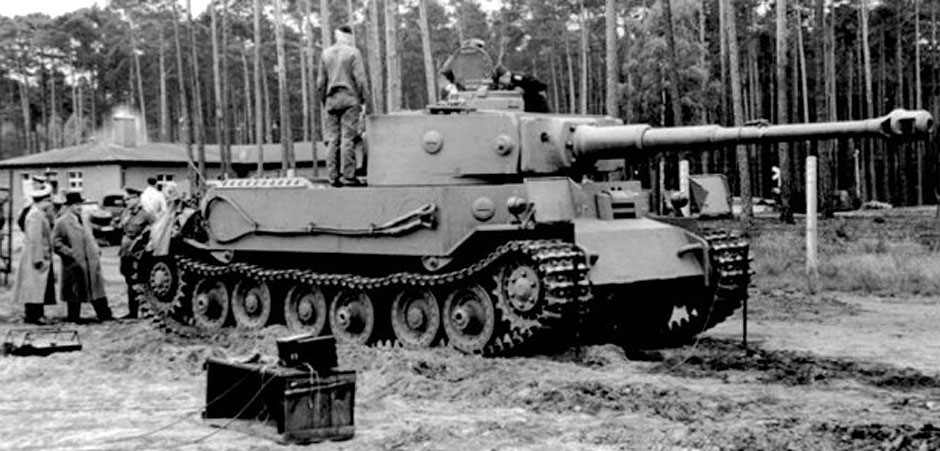
Dr. Porsche and Tiger (P) - "P" for Porsche. © unknown.
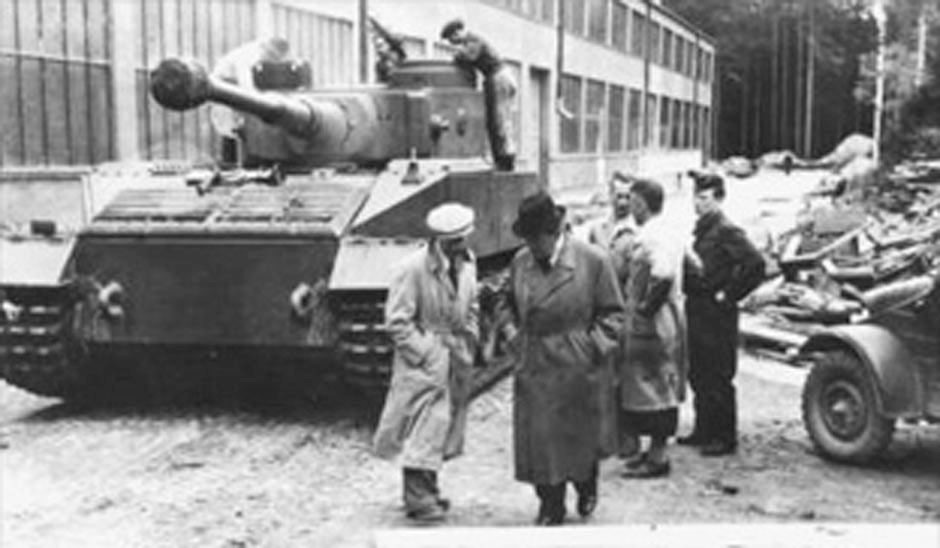
100 Tiger (P) tanks were ordered, but the order was cancelled in the beginning of the production and only a few were made. Only one Tiger P saw real war action in 1944. Over 1000 Tiger (H) - "H" for Henschel - were made between 1942-1944. F. Porsche can be seen on the photo. © unknown.
1943. On May 10, grandson Wolfgang Porsche was born. Around 90 hulls that were left unused after the Tiger P tank production was terminated, were now used for the tank destroyer Tiger P Ferdinand (from 1944 called "Elefant").
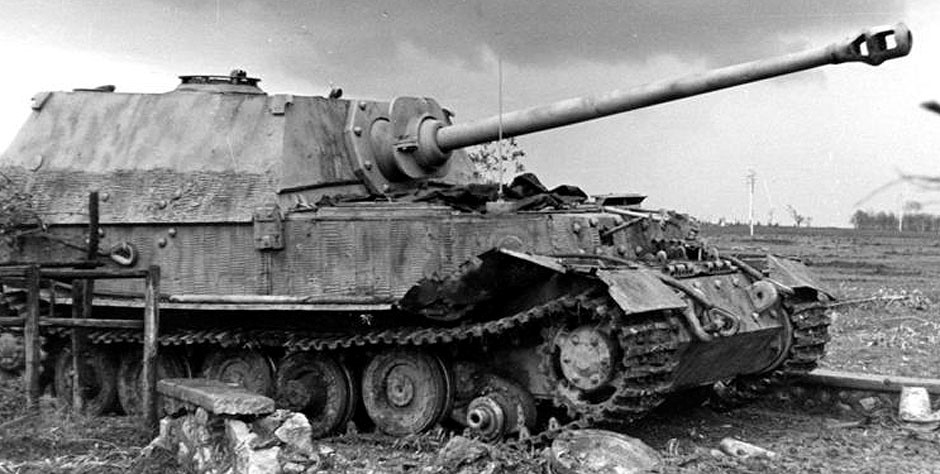
Destroyed Elefant. Photo taken in 1944 in Italy. © Bundesarchiv.
1944. In autumn, Porsche's design office was relocated 600 km from Stuttgart to Gmünd in Carinthia (Kärnten), Austria. Ferdinand Porsche lived in Gmünd and in Zell am See towards the end of the war.
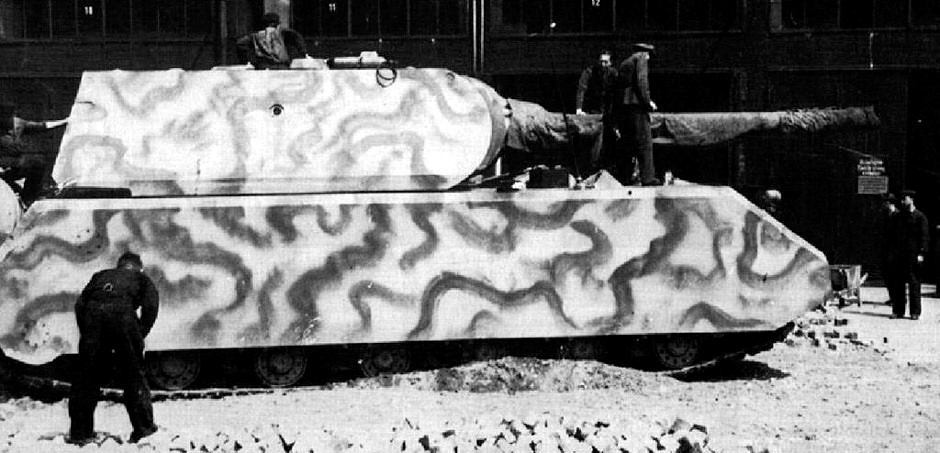
Porsche type 205 Panzerkampfwagen VIII "Maus" was a German WWII super-heavy tank completed in late 1944. With the weight of 188 tons, it is the heaviest fully enclosed armoured fighting vehicle ever built. Two prototypes were built, one of them functional. The latter got hit in the war. Later, Soviets merged the base from one tank and the top from the other and this new creation was taken to Russia where it is now in a tank museum. © unknown.
1945. On September 2, World War II ended. In November, Porsche was contacted by French Army regarding possible contract work. On December 15, Ferdinand Porsche, Ferry Porsche, Anton Piëch and engineer Herbert Kaes went to Wolfsburg to meet the French. They were arrested and taken to jail in Baden-Baden, Germany.
1946. On May 3, the imprisonment in Baden-Baden, ends to be continued in France. Ferdinand Porsche, Ferry Porsche and Anton Piëch were taken to Paris. In July, Ferry was released, but Dr. Porsche and Dr. Piëch were still needed to collaborate on designs for Renault 4CV rear-engined family car. The prisoners were relocated from Paris to a medieval jail in Dijon.
1947. On August 1, Ferdinand Porsche and Anton Piëch were liberated after Ferry Porsche had paid the ransom. Upon dr. Porsche's return, he examined the design of the Cisitalia racing car (Porsche type 360), which was constructed under the management of his son and which brought the money for the bail out. After close observation, he came to the conclusion: “I would have built it exactly the same way, right down to the last screw”. French court later found F. Porsche not guilty in the war crimes.
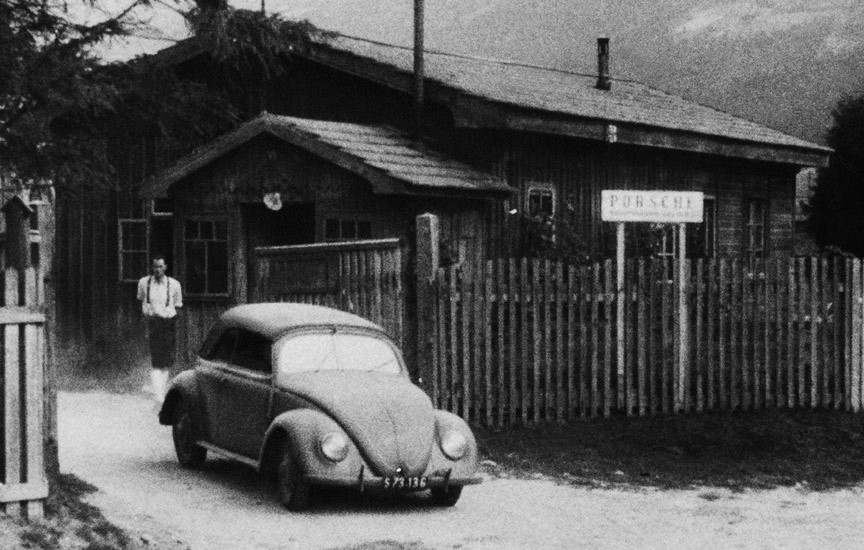
After the war, the "PORSCHE"-sign was put up in Gmünd (during the war a fake company name was used). © Porsche.
1948. On June 8, first Porsche 356 was road registered. The 356 n.1 was a mid-engined tubular steel frame roadster with aerodynamic aluminium body constructed under the management of dr. Porsche's son Ferry Porsche. Only one month later, the lightweight mid-engined roadster scored its first class victory at the Innsbruck Stadtrennen (city race).
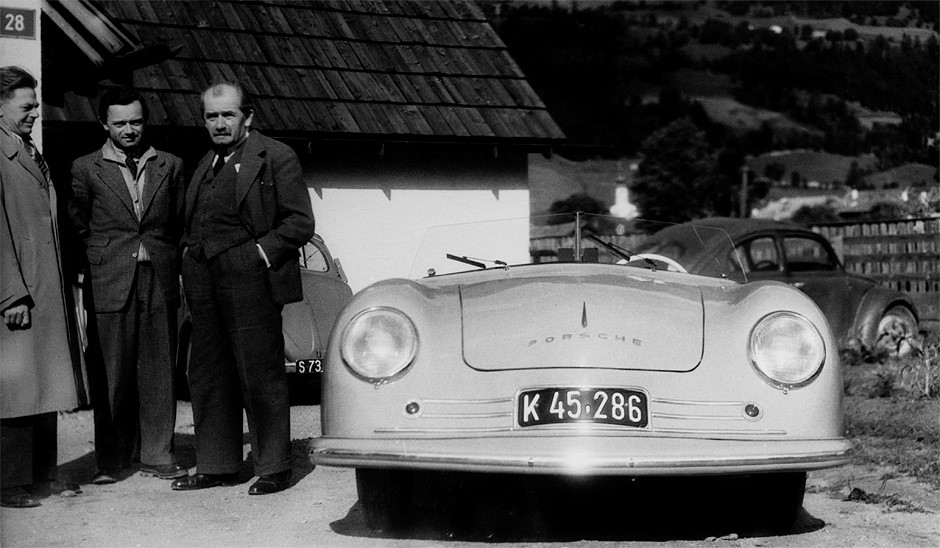
1948 Gmünd, Carinthia, Austria. Exterior designer Erwin Komenda, Ferry Porsche, Ferdinand Porsche, 356 n.1. © Porsche.
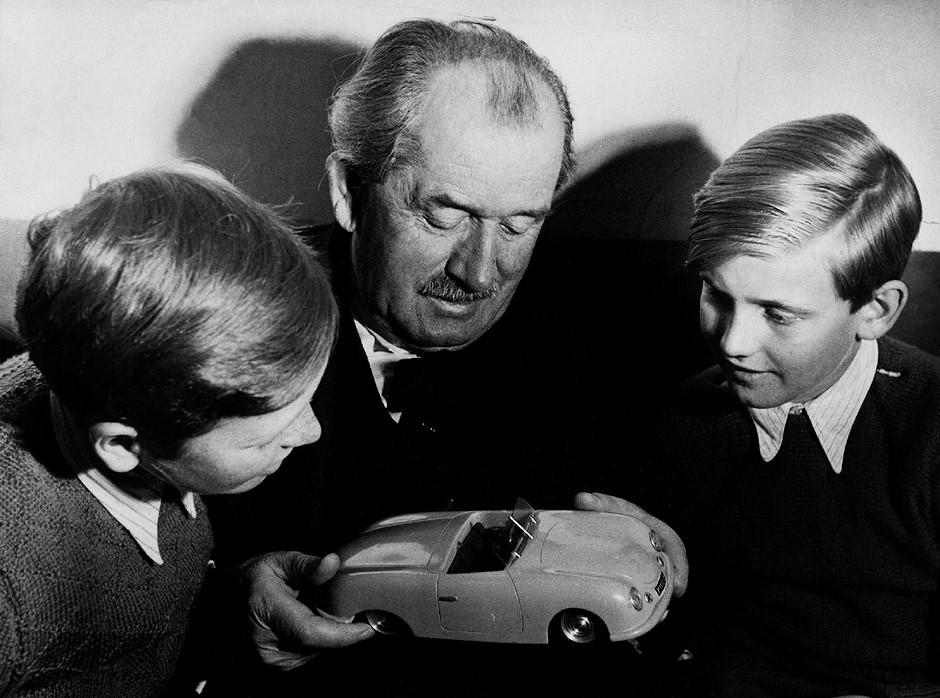
1949. F. Porsche with his grandchildren Ferdinand Alexander Porsche (left) and Ferdinand Karl Piėch (right). Both young boys were to become serious players in the future. © Porsche.
1950. On April 6, the first Porsche 356 was produced in the new factory in Stuttgart.
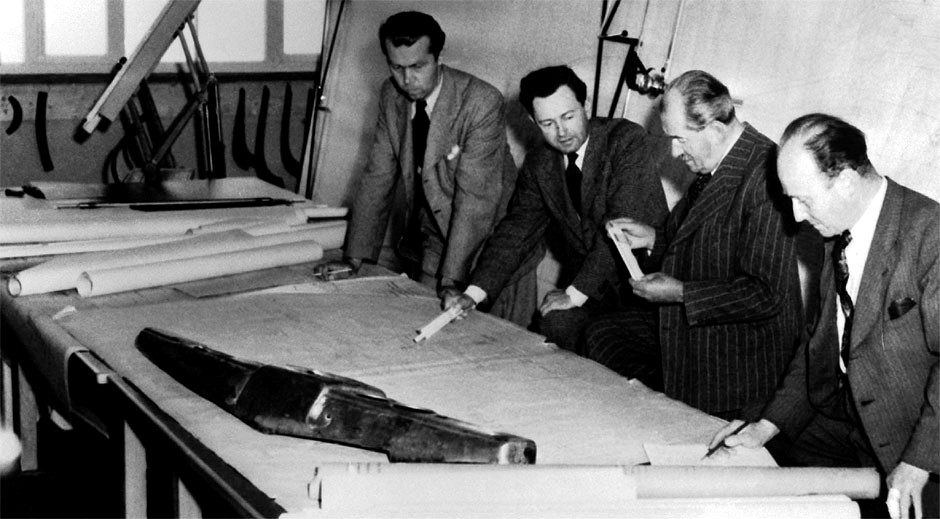
1950. Porsche office, Zuffenhausen, Stuttgart. From left: engine constructor Leopold Jäntschke, Ferry Porsche, Ferdinand Porsche, Emil Soukup. © Porsche.

1950. Porsche office, Zuffenhausen, Stuttgart. From left: engine constructor Leopold Jäntschke, Ferdinand Porsche, Ferry Porsche. © Porsche.
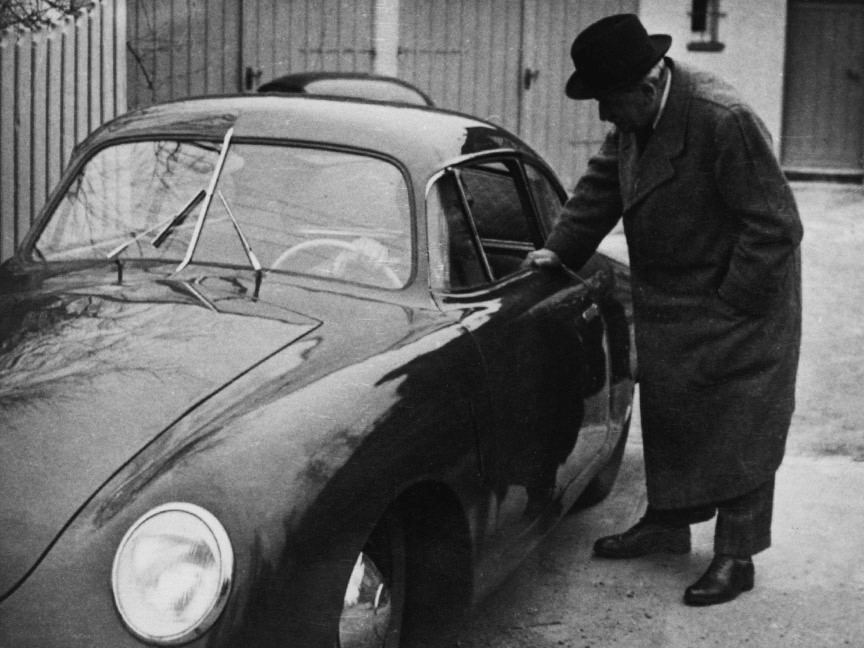
1950. Ferdinand Porsche standing next to the aluminium-bodied 356 built in Gmünd. Son Ferry Porsche at the wheel. Behind the car is the double garage of Porsche's villa in Stuttgart, in which the first Volkswagen prototypes were built. © Porsche.
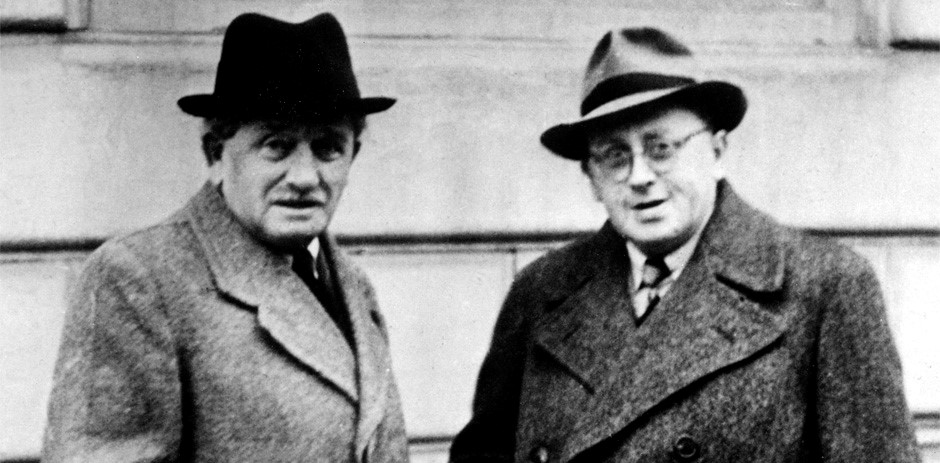
1950. Ferdinand Porsche with Karl Rabe, who was Porsche's chief designer from the establishment of the Porsche company in 1931 until his retirement at the end of 1965. Rabe worked for Austro-Daimler with Ferdinand Porsche from 1913 on, where he became design office manager in 1923 after Porsche's move to Daimler-Motoren-Gesellschaft. In 1929, when Ferdinand Porsche joined the Steyr-Werke, he encountered Karl Rabe, again, who had been deputy head of design there since 1927. From then on, the careers of Karl Rabe and Ferdinand Porsche remained closely linked. © Porsche.
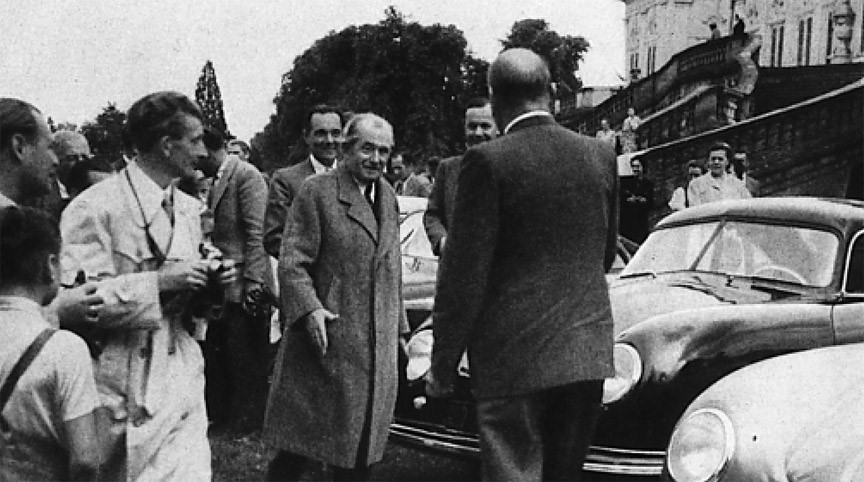
1950 September 3, thirty 356 owners gathered in Stuttgart to greet dr. Porsche on his 75th birthday. © Porsche.
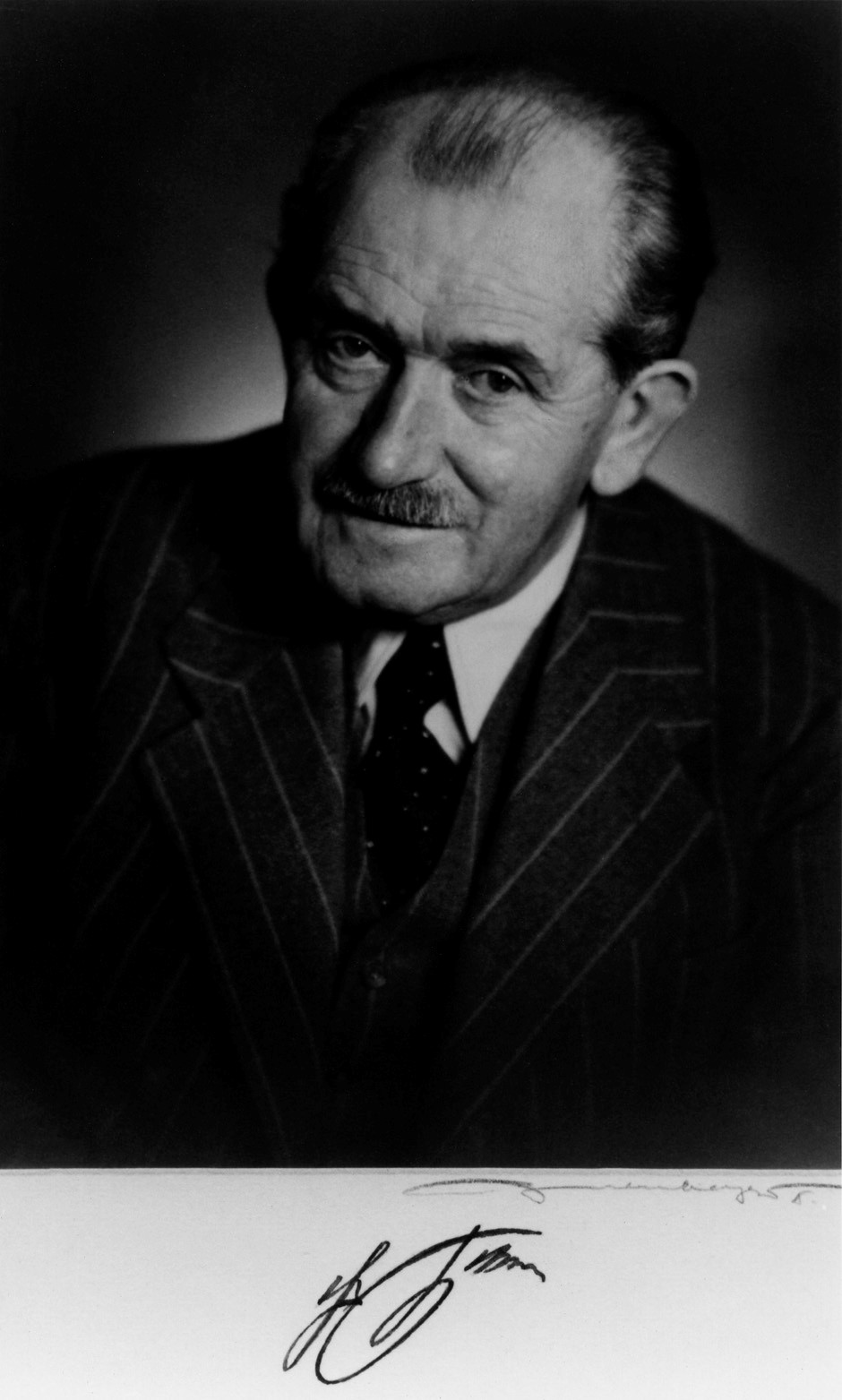
1950. Portrait of Ferdinand Porsche, taken to celebrate his 75th birthday, with his signature below. © Porsche.
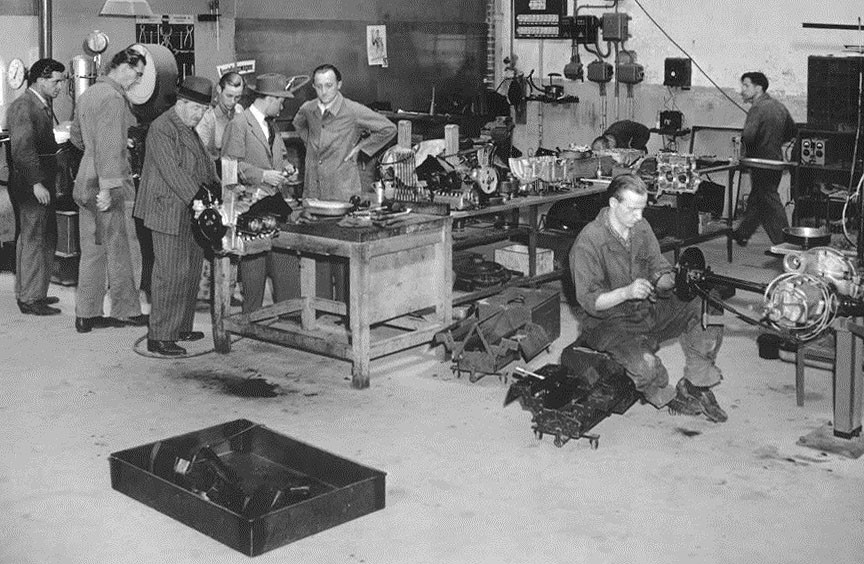
1950. Ferdinand Porsche's last visit to the factory. © Porsche.
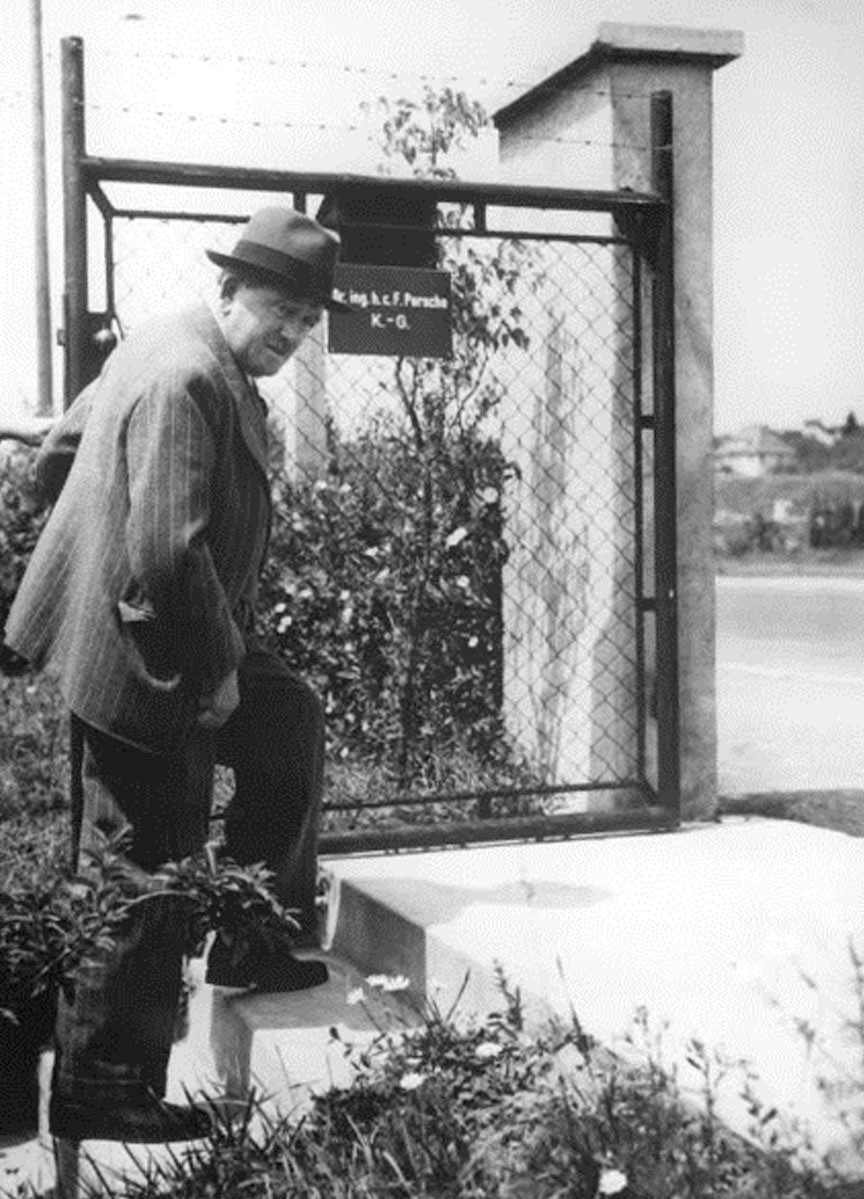
1950. Last photo of Ferdinand Porsche. © Porsche.
1951. On January 30, at the age of 75, Ferdinand Porsche died in Stuttgart. He didn't recover from the stroke he got in November 1950. He is laid to rest in chapel in the family estate "Schüttgut" in Zell am See in Austria.

1.50 schilling stamp issued in Austria on F. Porsche's 100th birthday anniversary in 1975. O. Stefferl/A.Fischer.
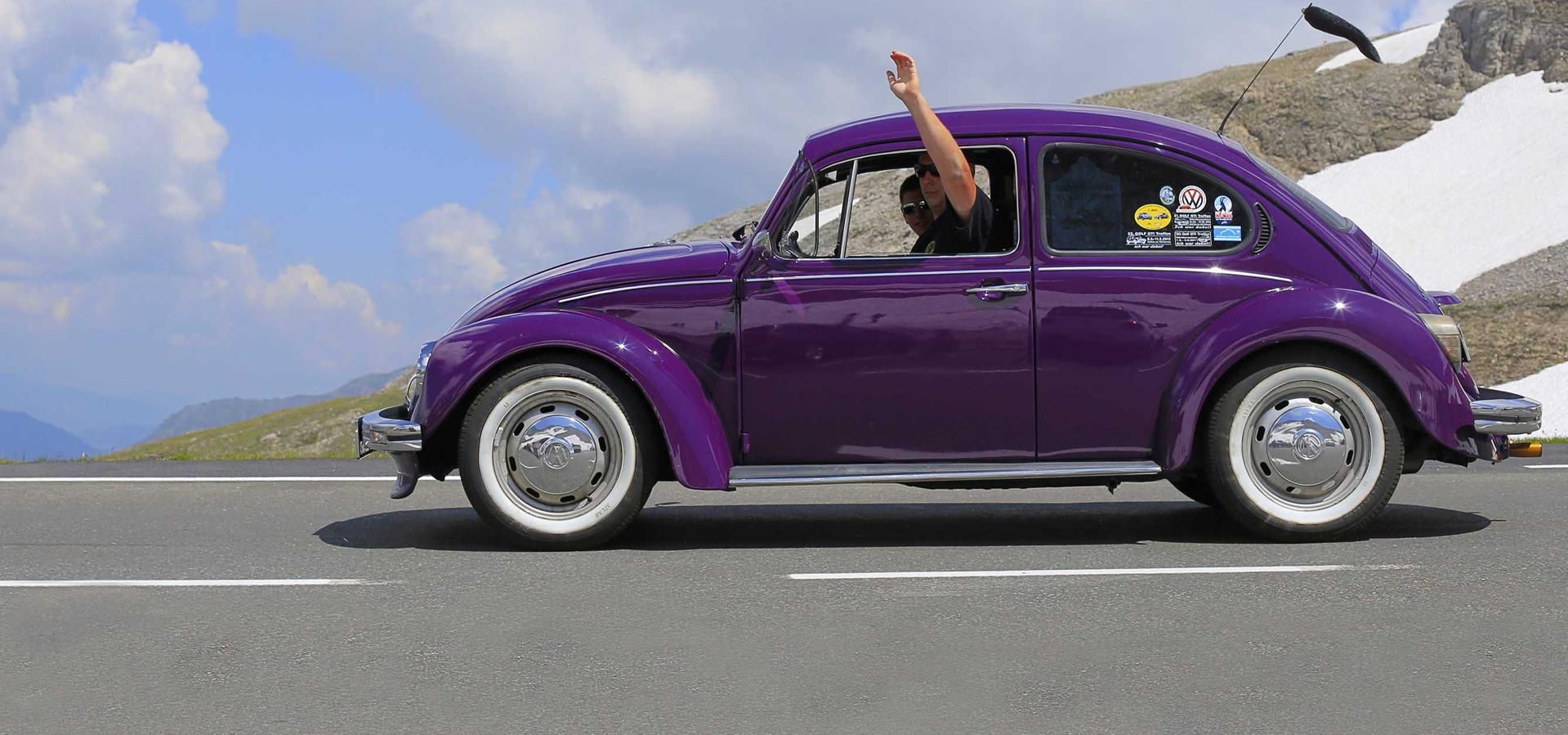
Luxury Lineage: a brief history of the Volkswagen Beetle. Michael Solomon Sep 14, 2018.
After 80 years, the long and winding road is coming to the end for the Beetle. Volkswagen announced this week that it will end production of the iconic car in 2019.
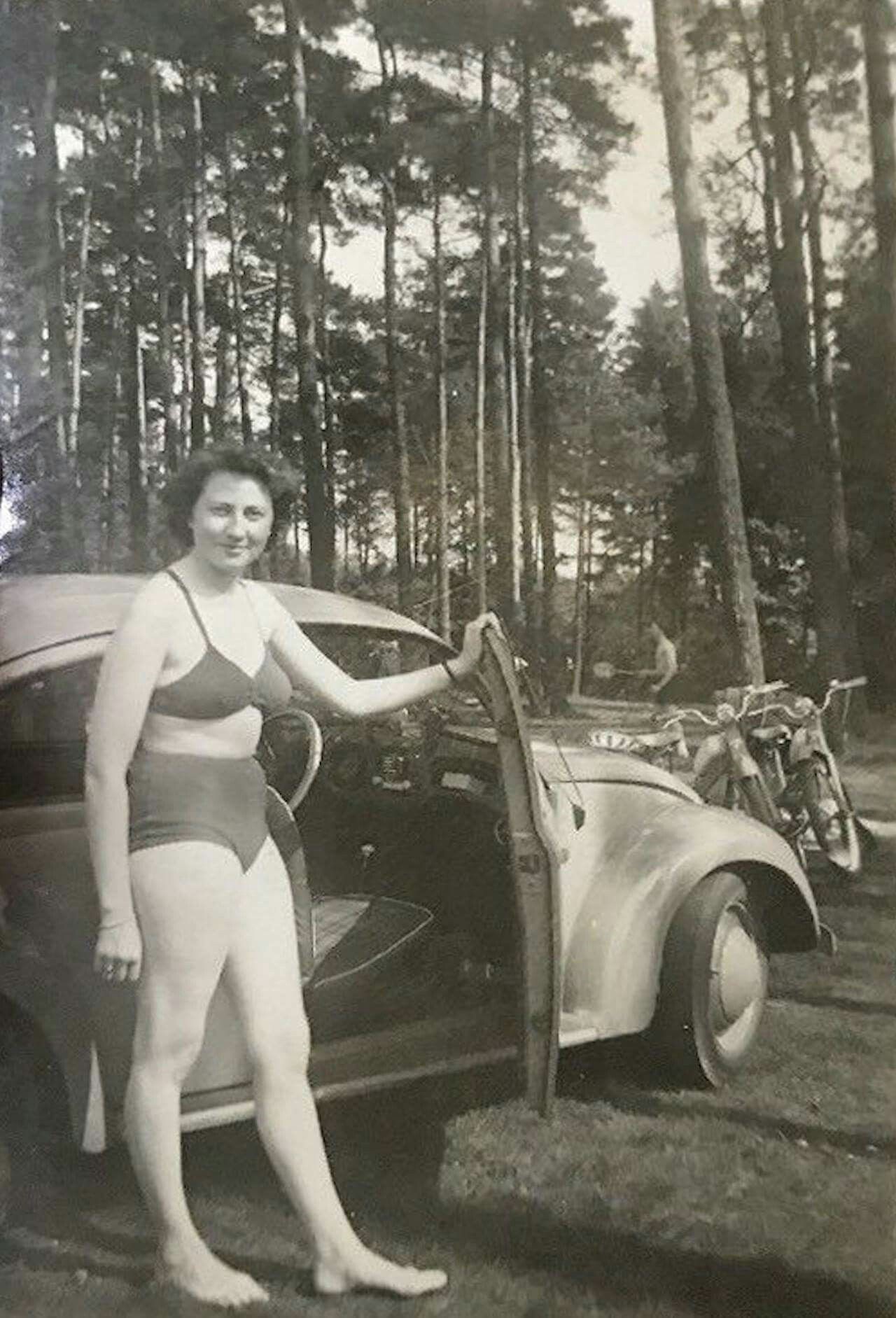
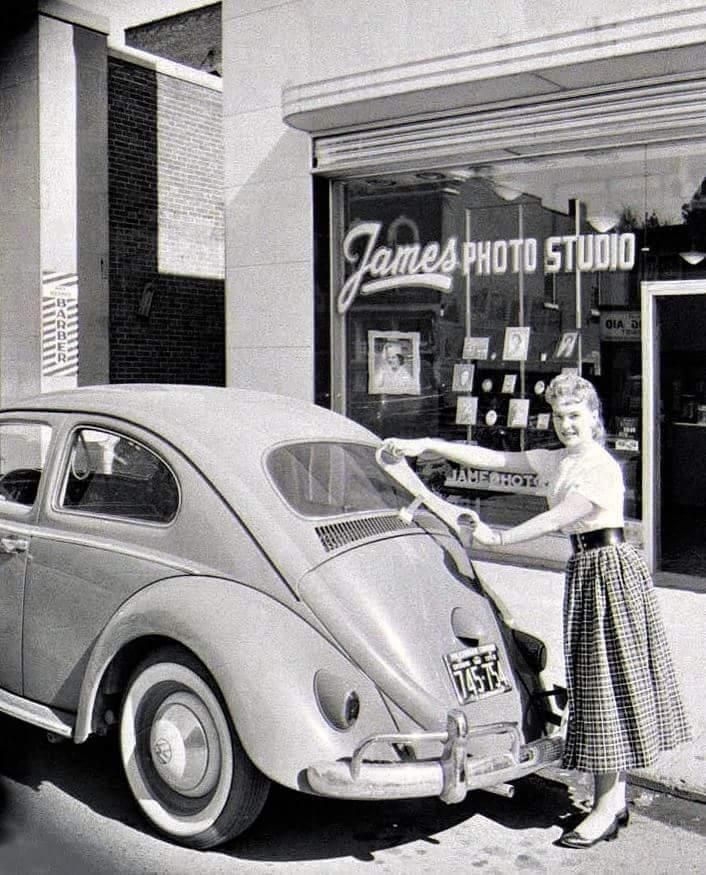
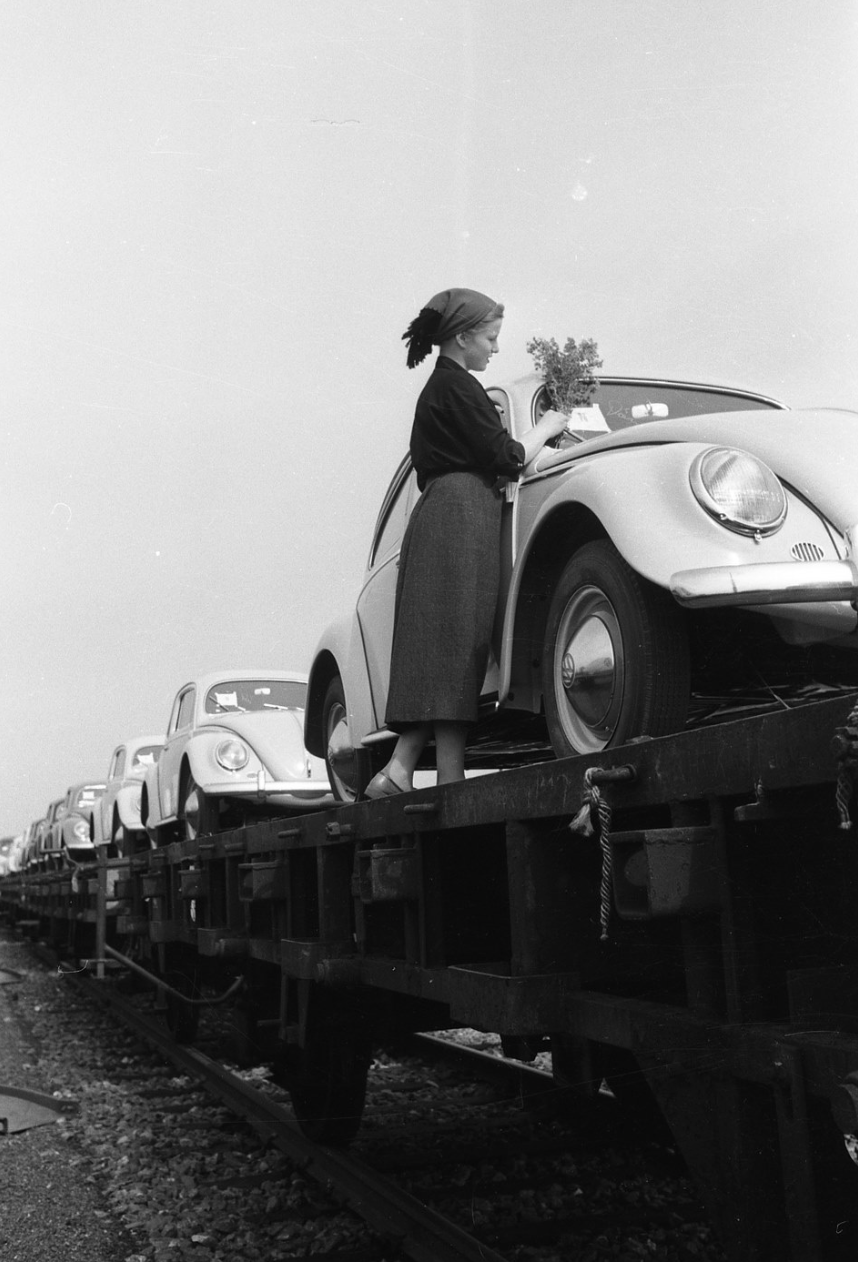
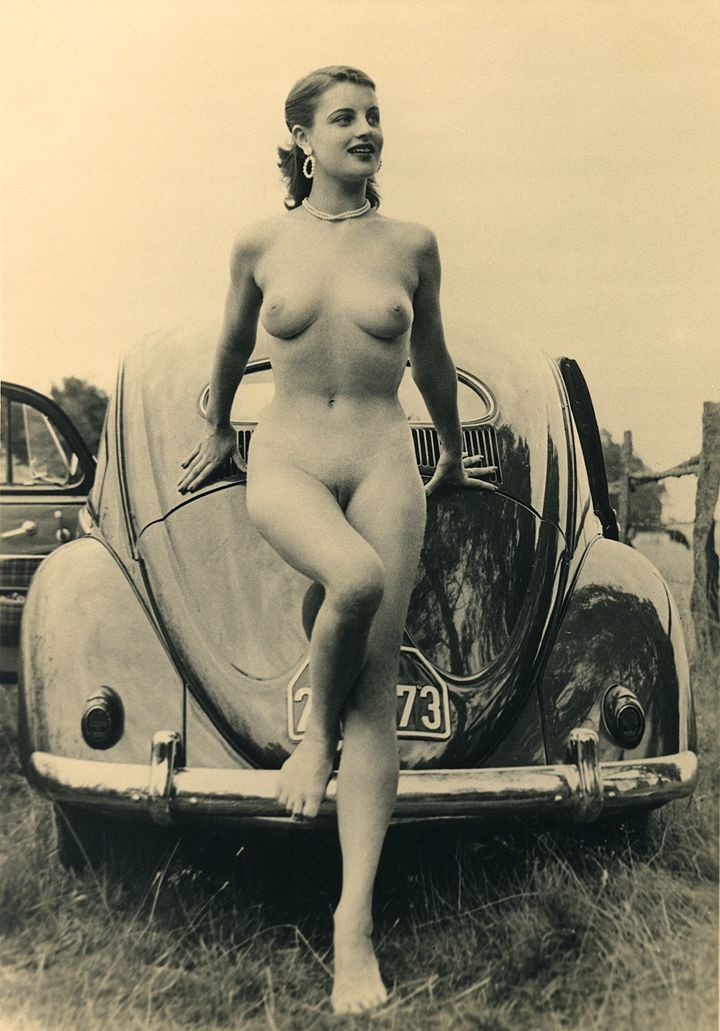
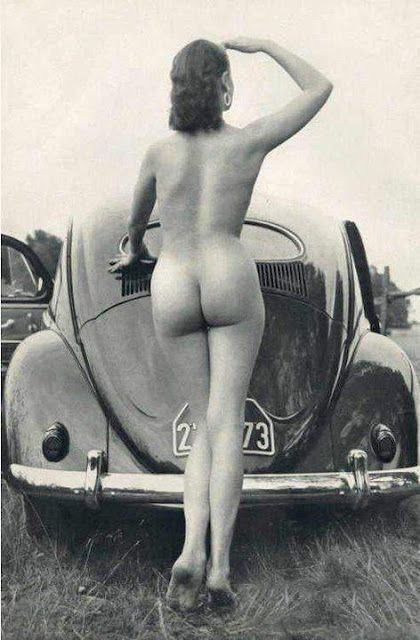

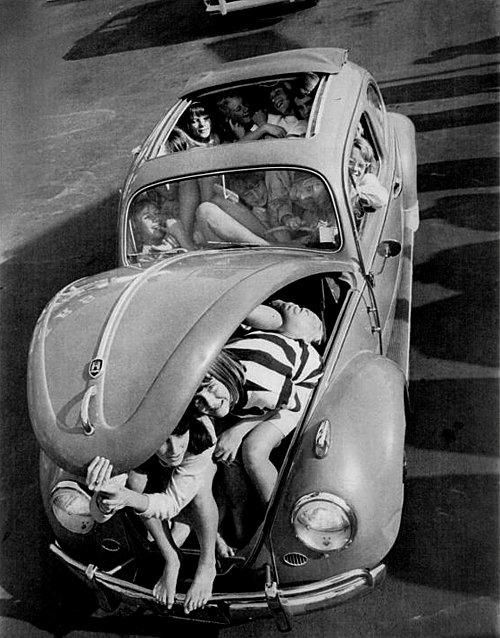
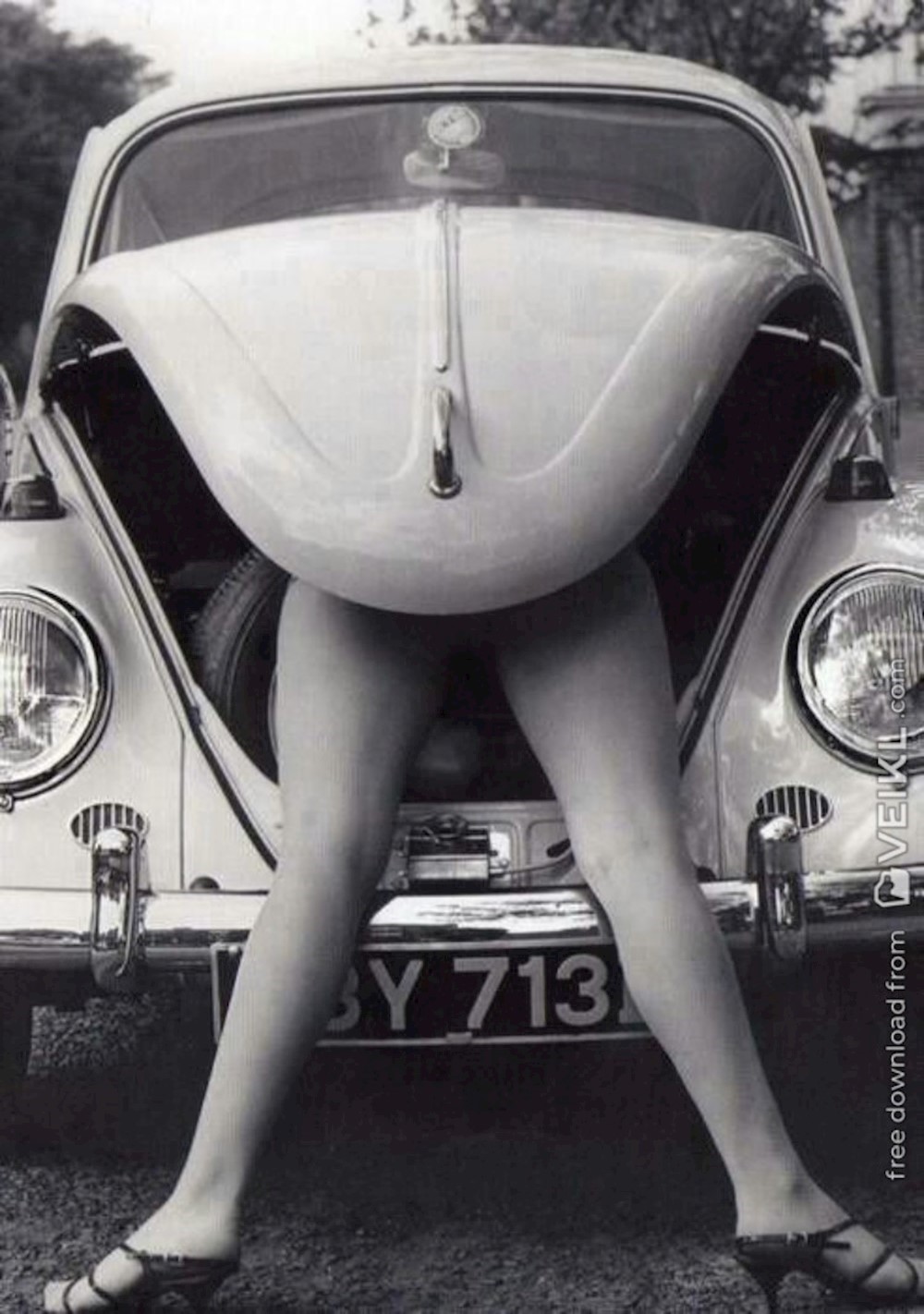
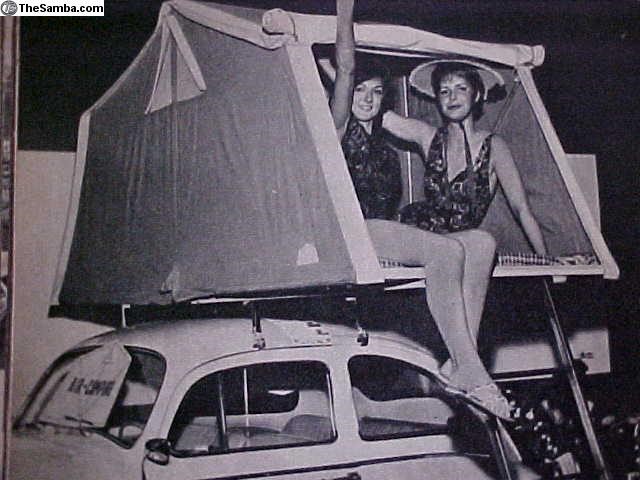
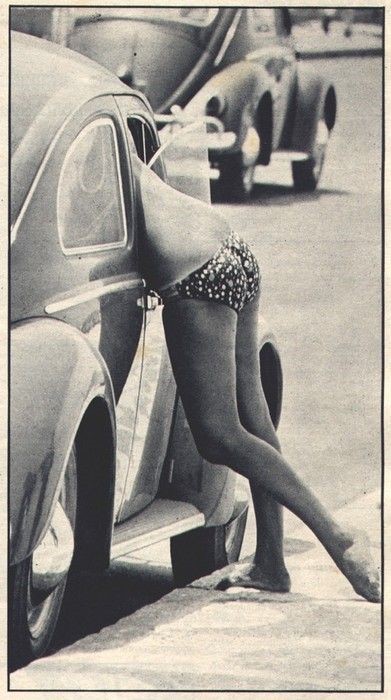
A woman in a bikini in a Beetle.
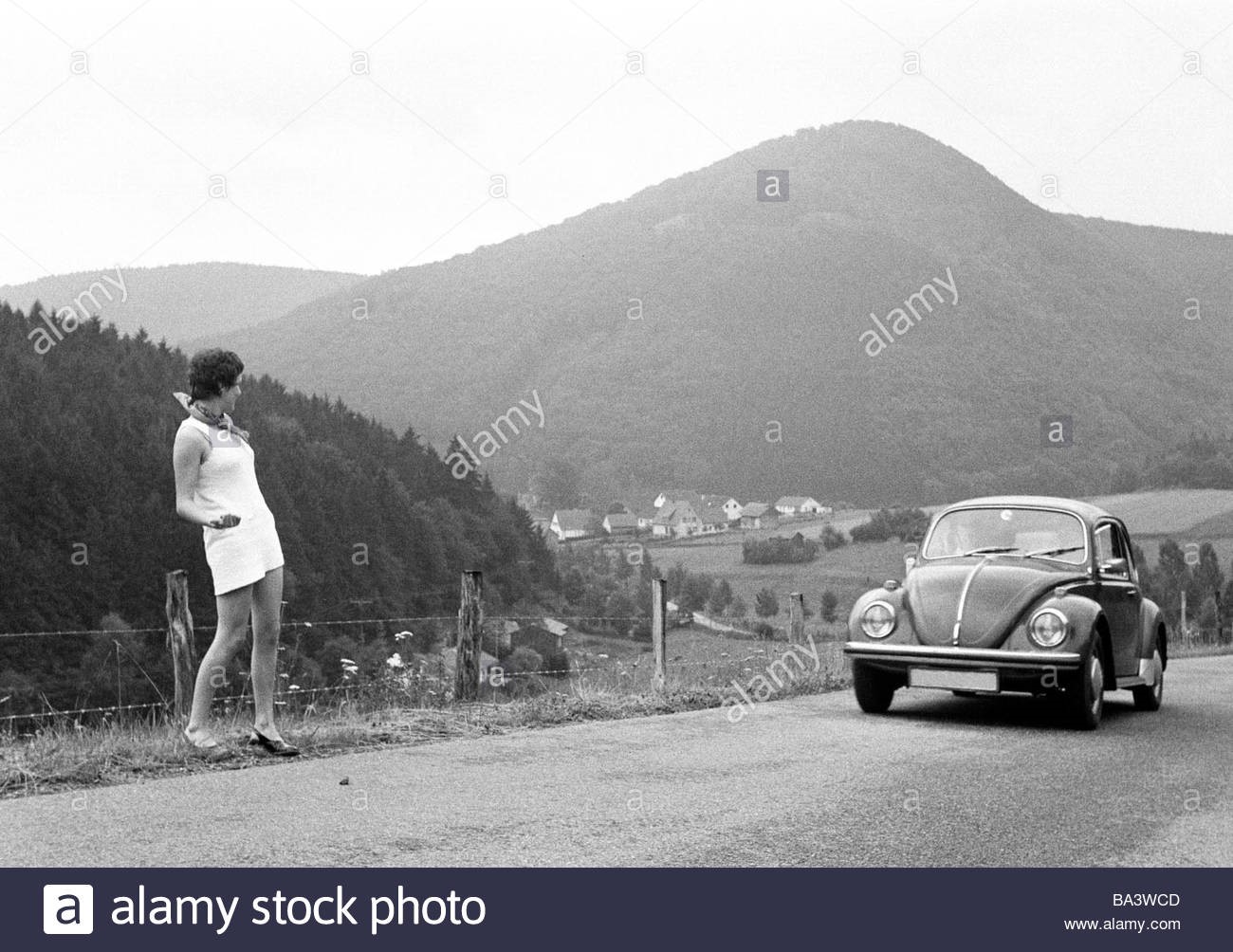
Seventies black and white photo holidays travel hitchhiker young girl.
Designed by Ferdinand Porsche, the curvy car was affordable, practical and reliable. Three decades later, the "Bug" (as it was affectionately known) became a symbol of the 1960s and the "small is beautiful" ethos.
Germany stopped producing Beetles in the late 1970s, but in 1998 Volkswagen rolled out the New Beetle, which was meant to be a visual flashback to the original Type 1 design but was essentially a VW Golf. Another variation was introduced in 2012, but sales have been steadily declining—down to around 15,000 last year from some 43,000 in 2013—so now the Bug will be squashed.
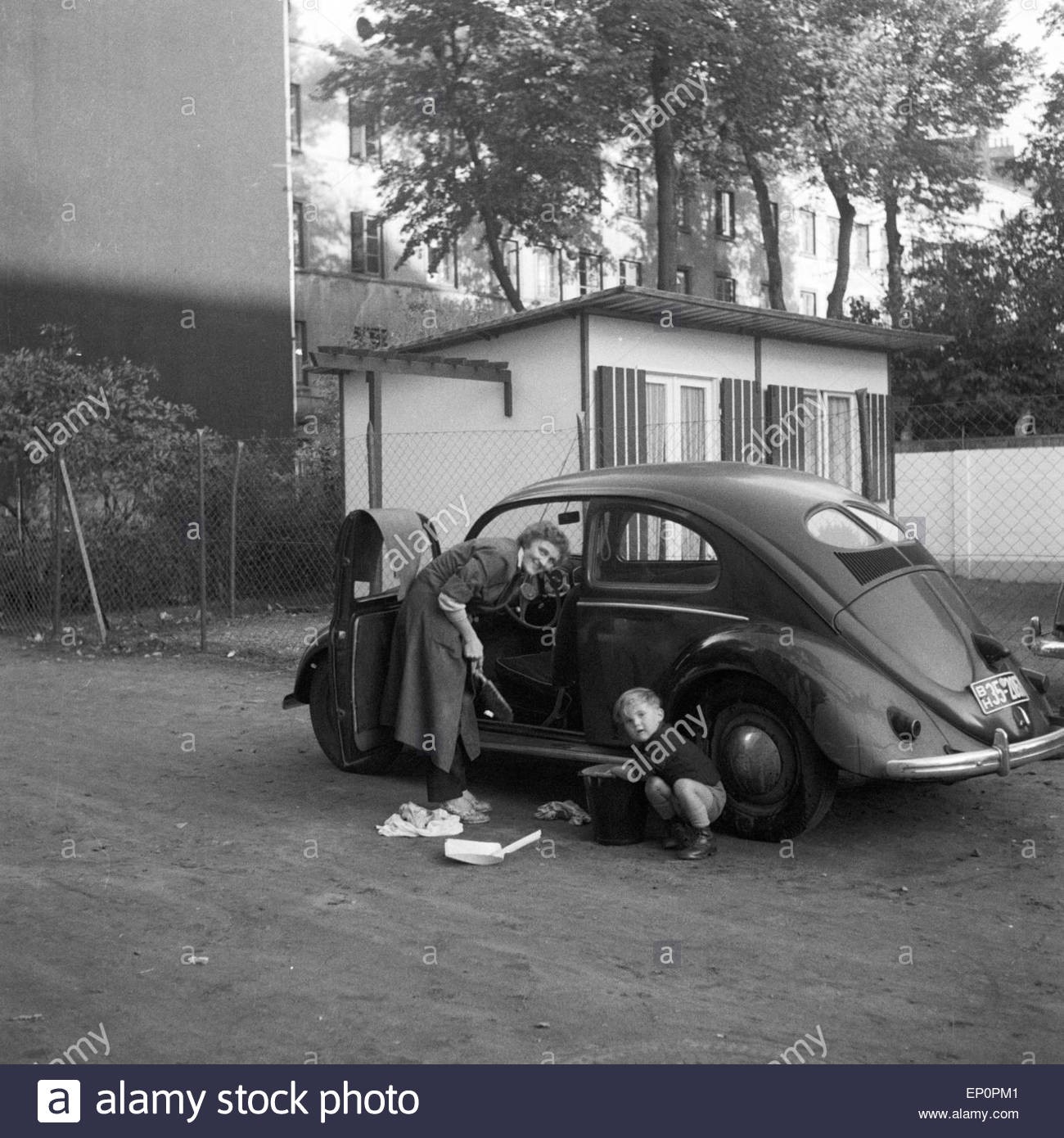
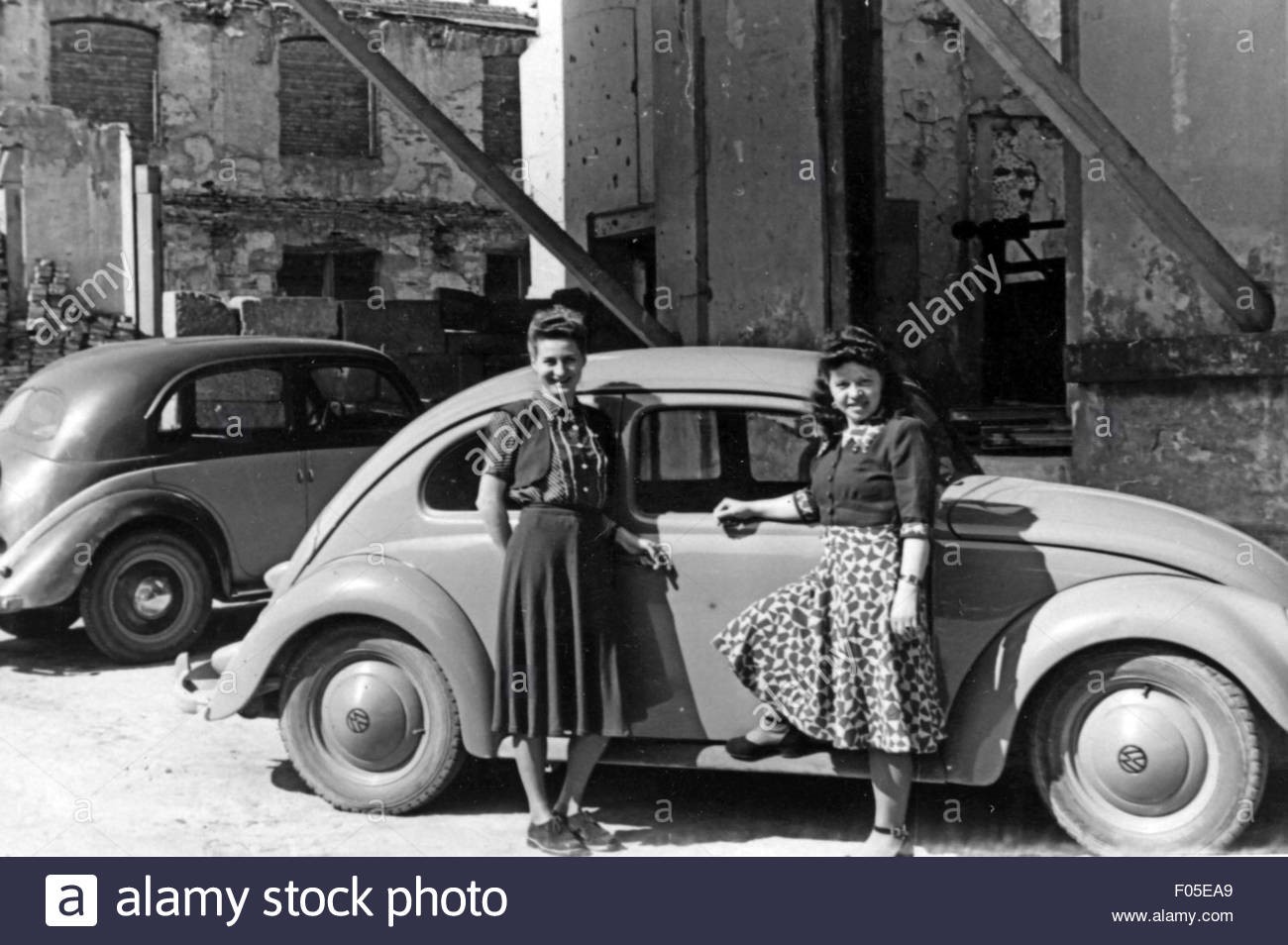
Leisure time excursion. Two women in front of VW Beetle having a break on a roadtrip in 1950s. Additional rights clearences not available.
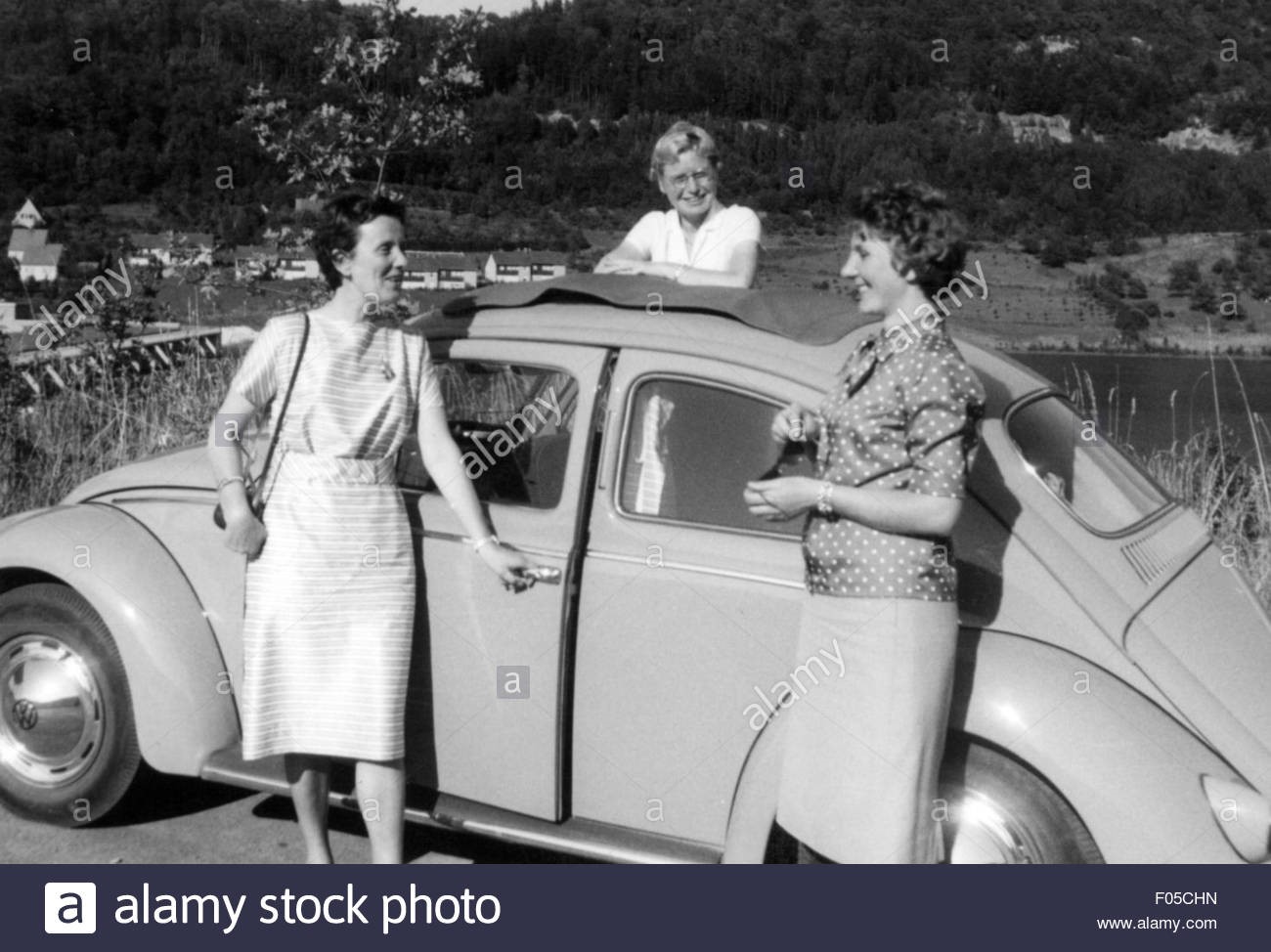
Leisure time excursion. Three women in front of VW Beetle having a break on a roadtrip in 1950s. Additional rights clearences not available.
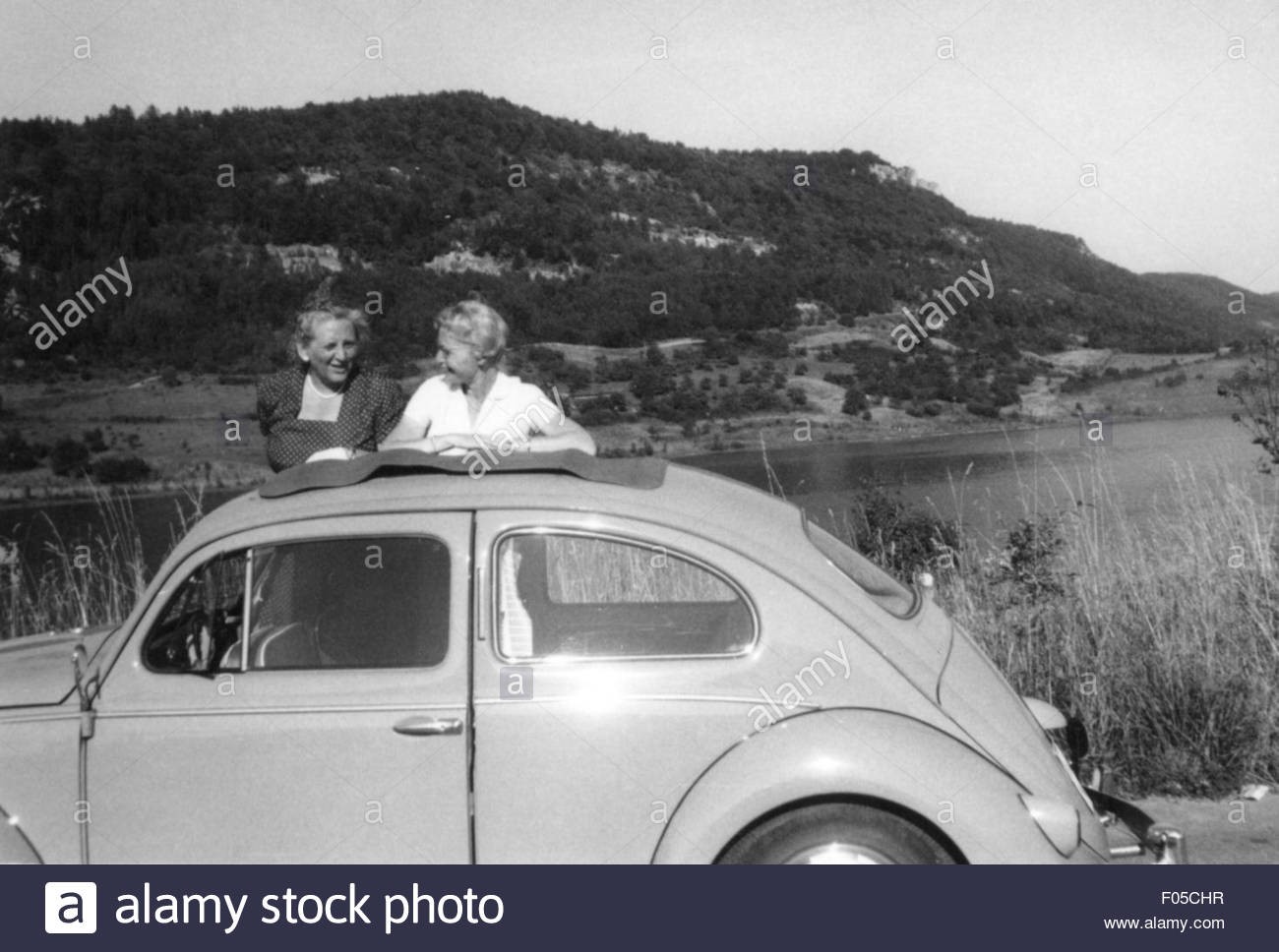
Leisure time excursion. Two women in front of VW Beetle having a break on a roadtrip in 1950s.Additional rights clearences not available.

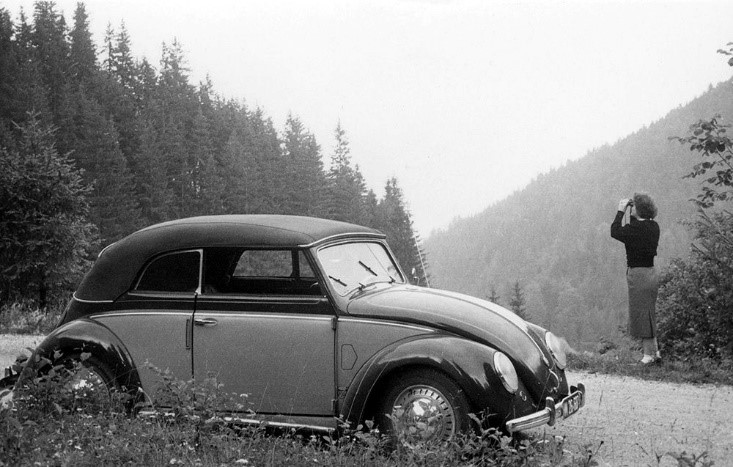
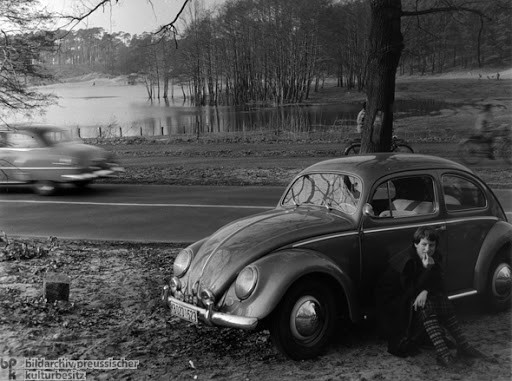
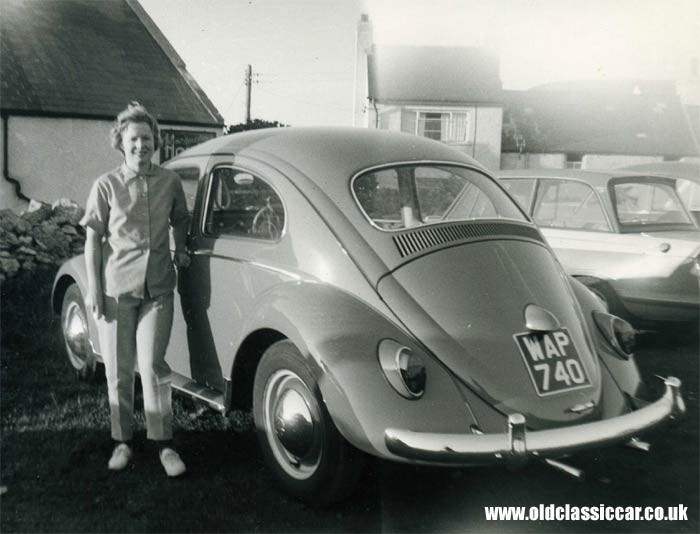
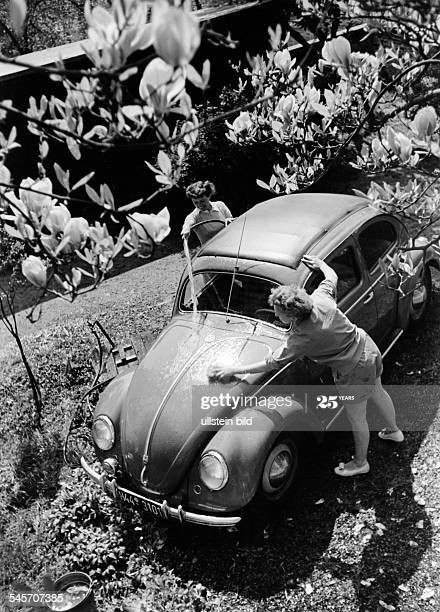
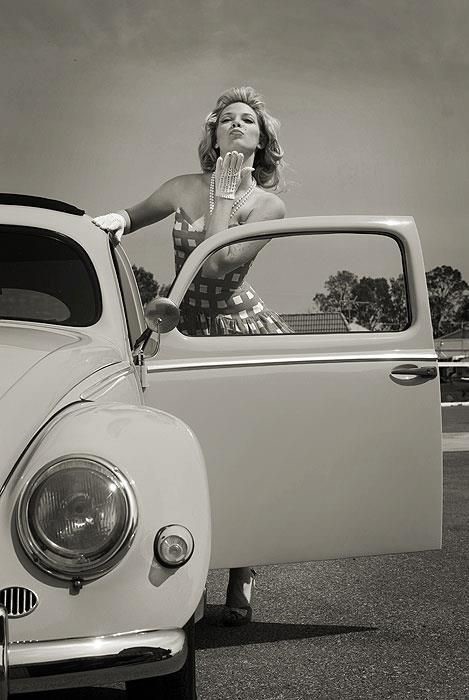
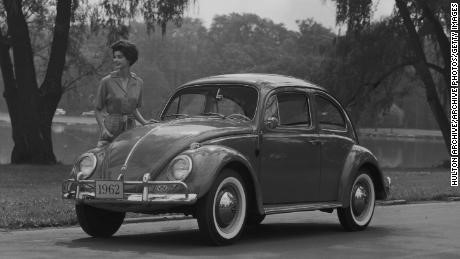
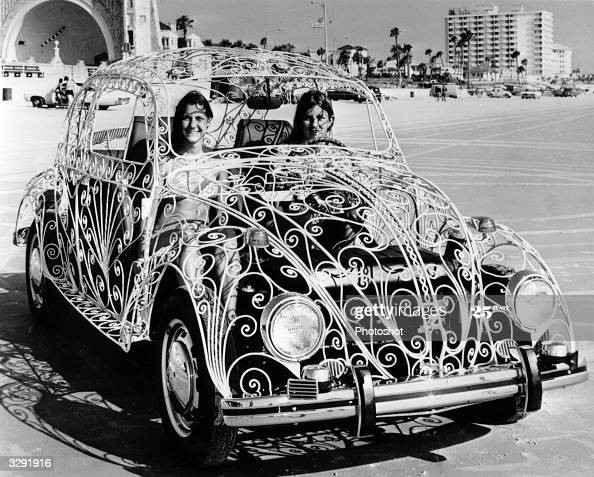
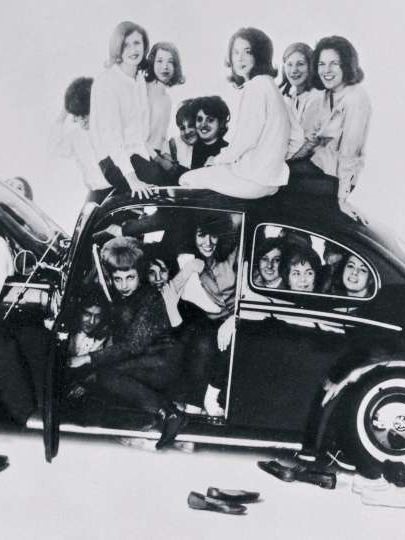
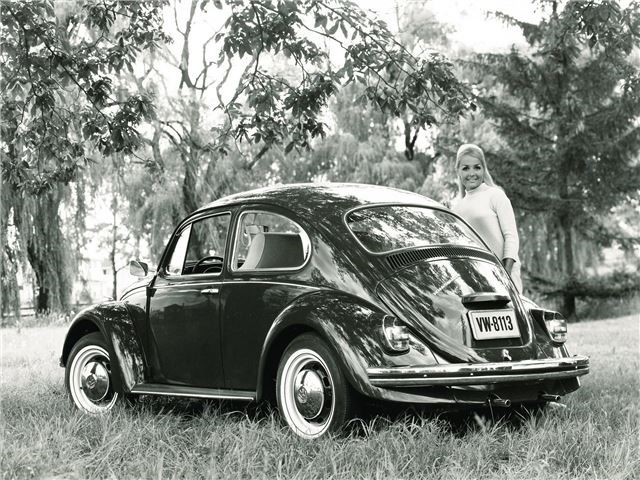
Volkswagen Beetle 1200.
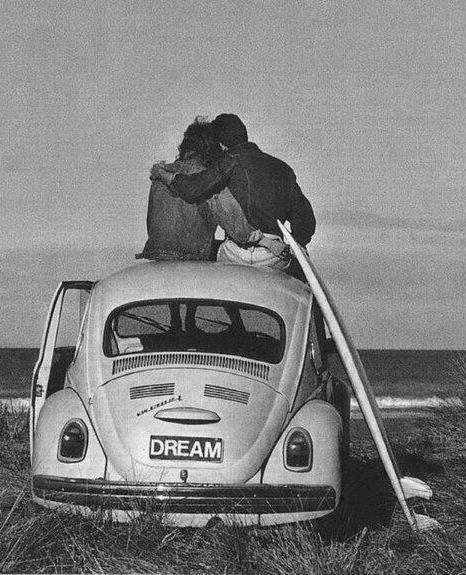
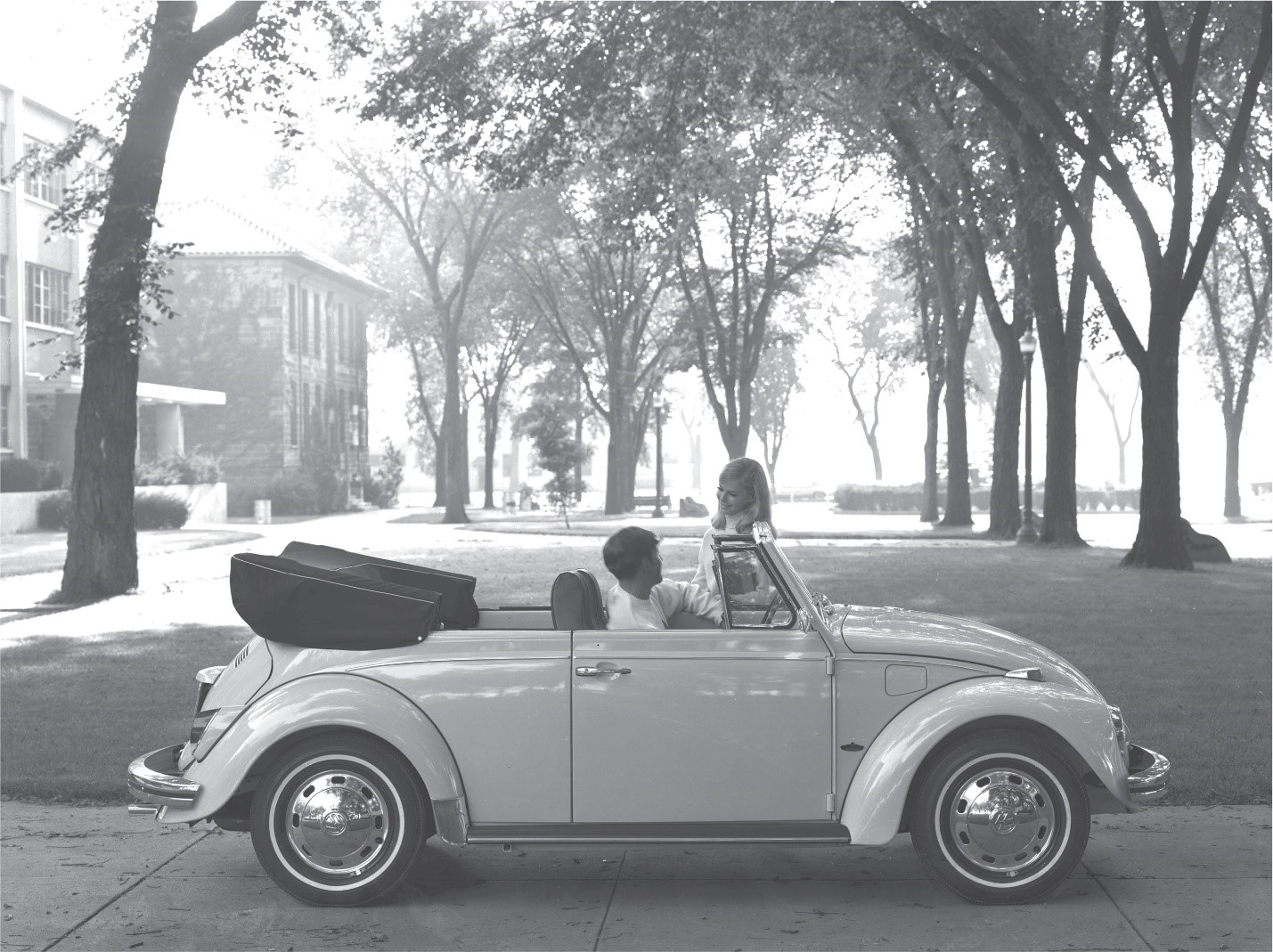
The Type 1 model got the moniker “Beetle” in 1969 and later that same year the VW would get another famous boost, thanks to its appearance as a vehicle that came to life in a famous movie. In fact, the 1963 white Type 1 with a racing-style 53 on the hood and doors became the most popular VW in film history, even starring decades later in a 2005 reboot. In 2018, one of the cars used in the movies sold at auction for $128,700.
Until then, here's a look back at Beetle-mania...

A 1939 Volkswagen Type 1 convertible, with Ferdinand Porsche in the back seat. Photo by Library of Congress/Corbis/VCG via Getty Images.
1938
In an effort to produce an affordable car for German workers, Adolf Hitler had commissioned engineer Ferdinand Porsche to design a simple, economical vehicle for the people. The Type 1 (as it was known) had a rear, air-cooled engine and borrowed design elements from an earlier Porsche car (the Type 12 he built for Zündapp) and several models from the Czechoslovakia automaker Tatra. In May, Hitler laid the cornerstone of the Volkswagen factory in Wolfsburg, Germany. Civilian production was almost immediately stopped because of World War II, but some cars were built for military officers. Hitler was given the first convertible.
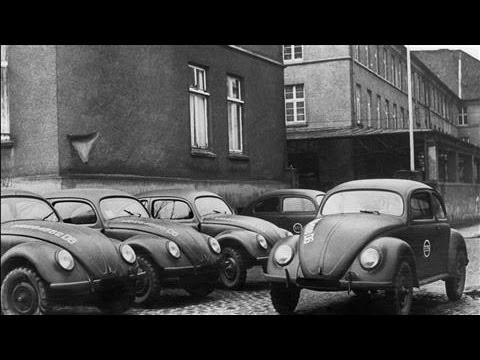
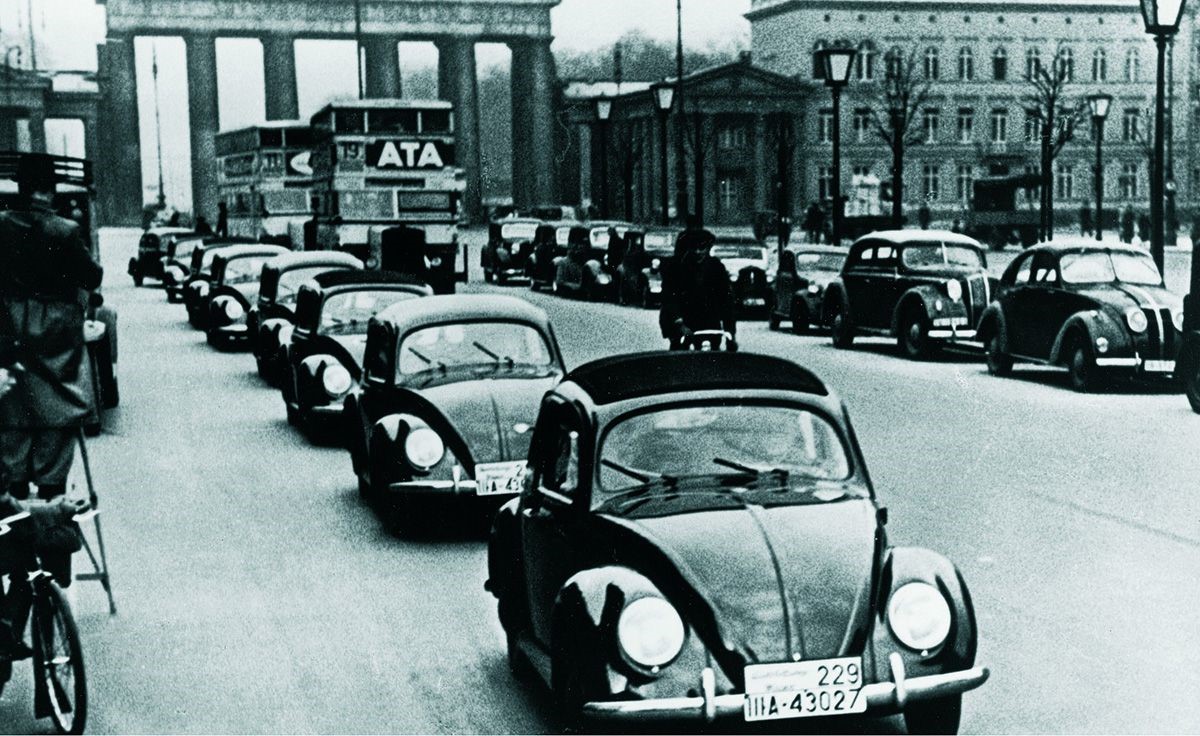

A Beetle on streets of Germany in the 1940s. Photo by Keystone-France/Gamma-Keystone via Getty Images.
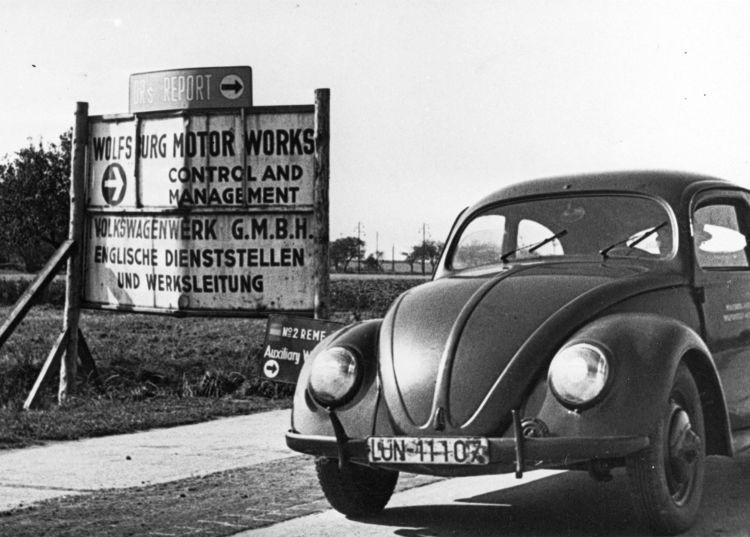
British took over Wolfsburg and the VW factory from April 1945.
1946
Following the end of the war, the factory was put under British control. By the end of 1946, more than 10,000 cars were manufactured. A decade later, one million had been sold.
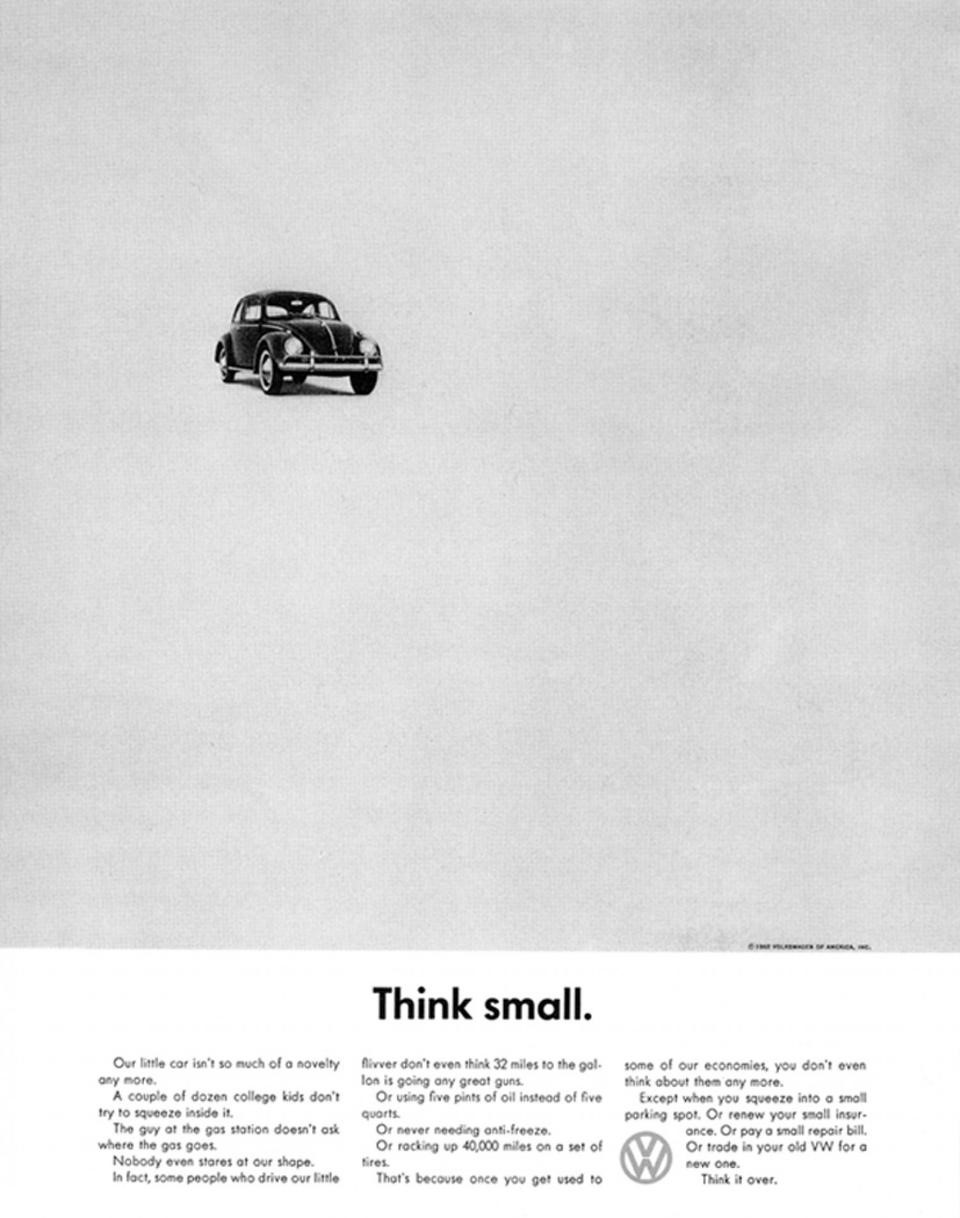
A 1960 version of DDB's "Think small" ad.
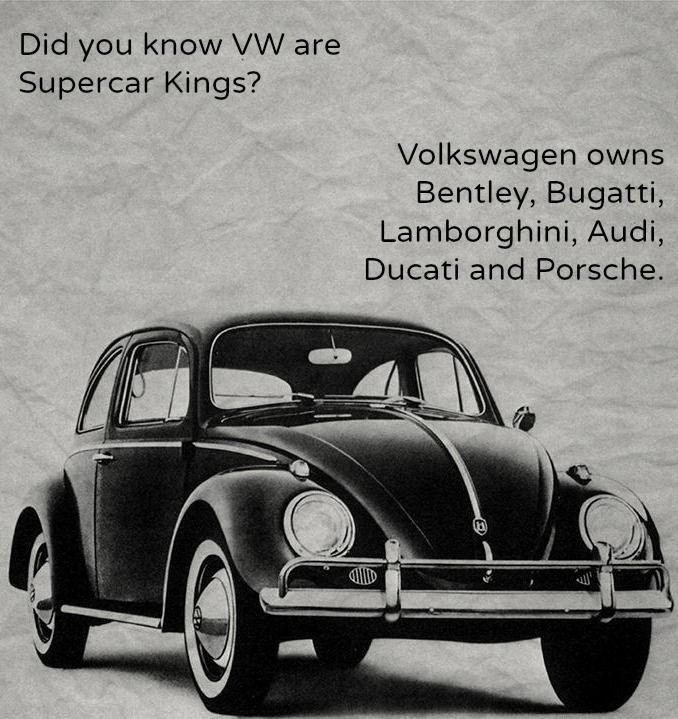
VW
1959
Under the supervision of William Bernbach of the New York advertising agency Doyle Dane Bernbach (DDB), copywriters Julian Koenig and Helmut Krone created the now legendary "Think small" ad for Volkswagen with a tiny Beetle in a plane of white space. "Maybe we got so big because we thought small," the ad touted. Forty years later, “Ad Age” named it the best advertising campaign of the 20th century.
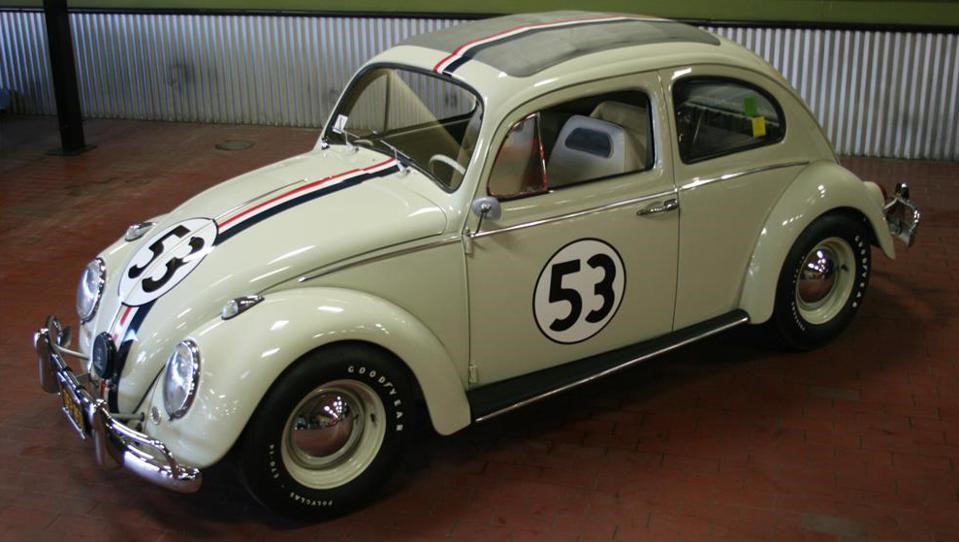
A 1963 Love Bug that starred in 'Herbie Goes to Monte Carlo.'
Barrett-Jackson.
1968
The Type 1 was officially given the name "Beetle" (from "der Käfer," German for beetle, which was used in brochures). That year, Disney released the first of six movies featuring “Herbie the Love Bug”, an anthropomorphic 1963 Beetle with a racing-style number 53 on the hood. In 2018, one of the cars used in the 1977 movie Herbie Goes to Monte Carlo and 1982's Herbie Goes Bananas set a record for a Beetle at auction, selling at Barrett-Jackson for $128,700.
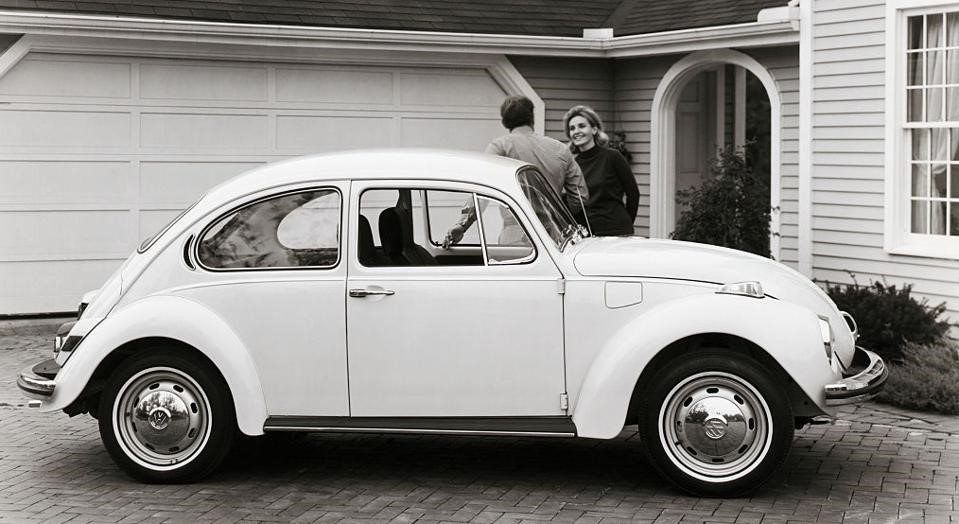
The 1972 Volkswagen Super Beetle.
Bettmann.
1971.
Volkswagen introduced a premium model known as the Super Beetle. The car had a new front suspension and more trunk space—under the hood. The next year, on February 17, 1972, Beetle N. 15,007,034 rolled off the assembly line, surpassing the record held by the Ford Model T for four decades as the best-selling car in the world.
Volkswagen.
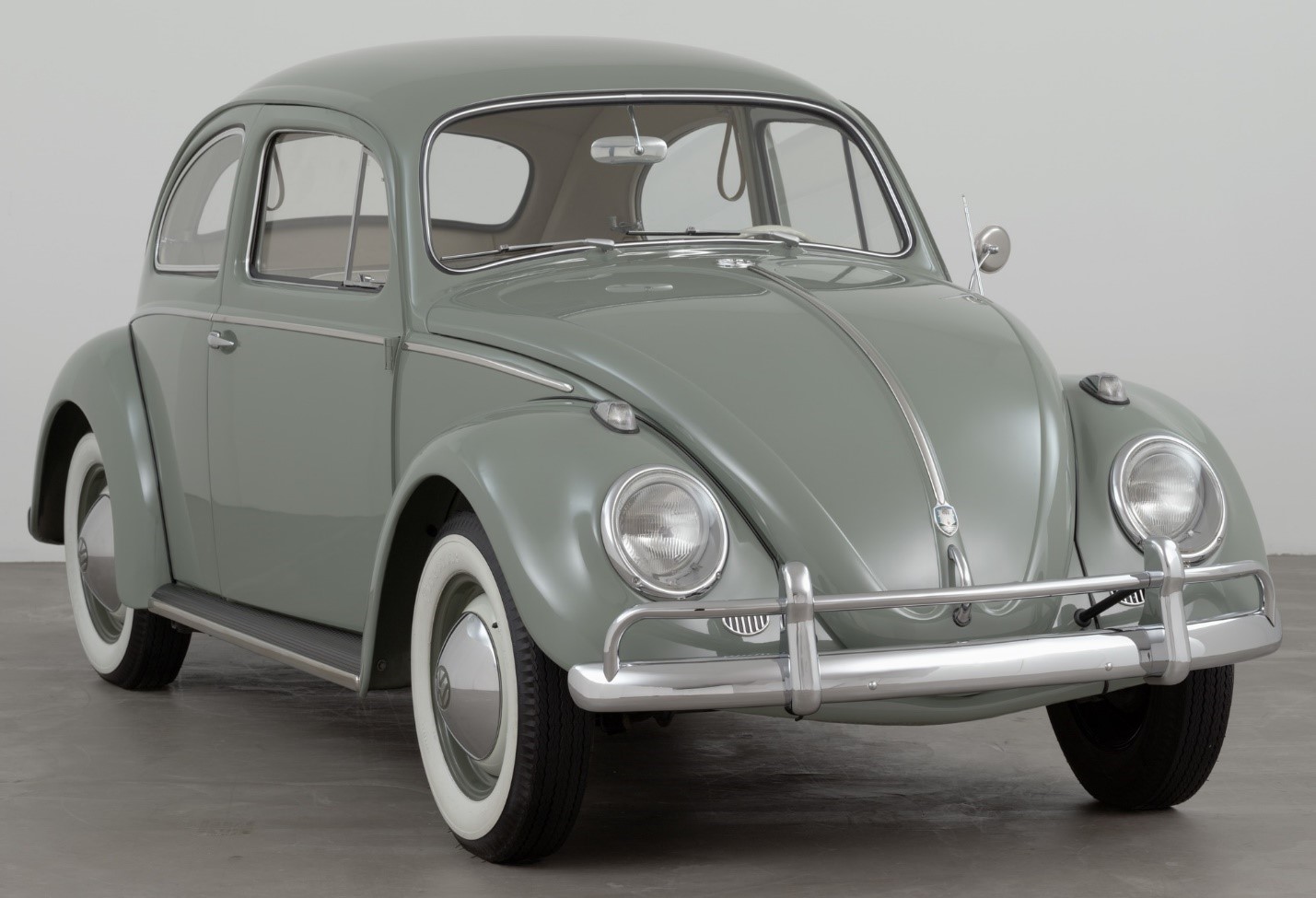
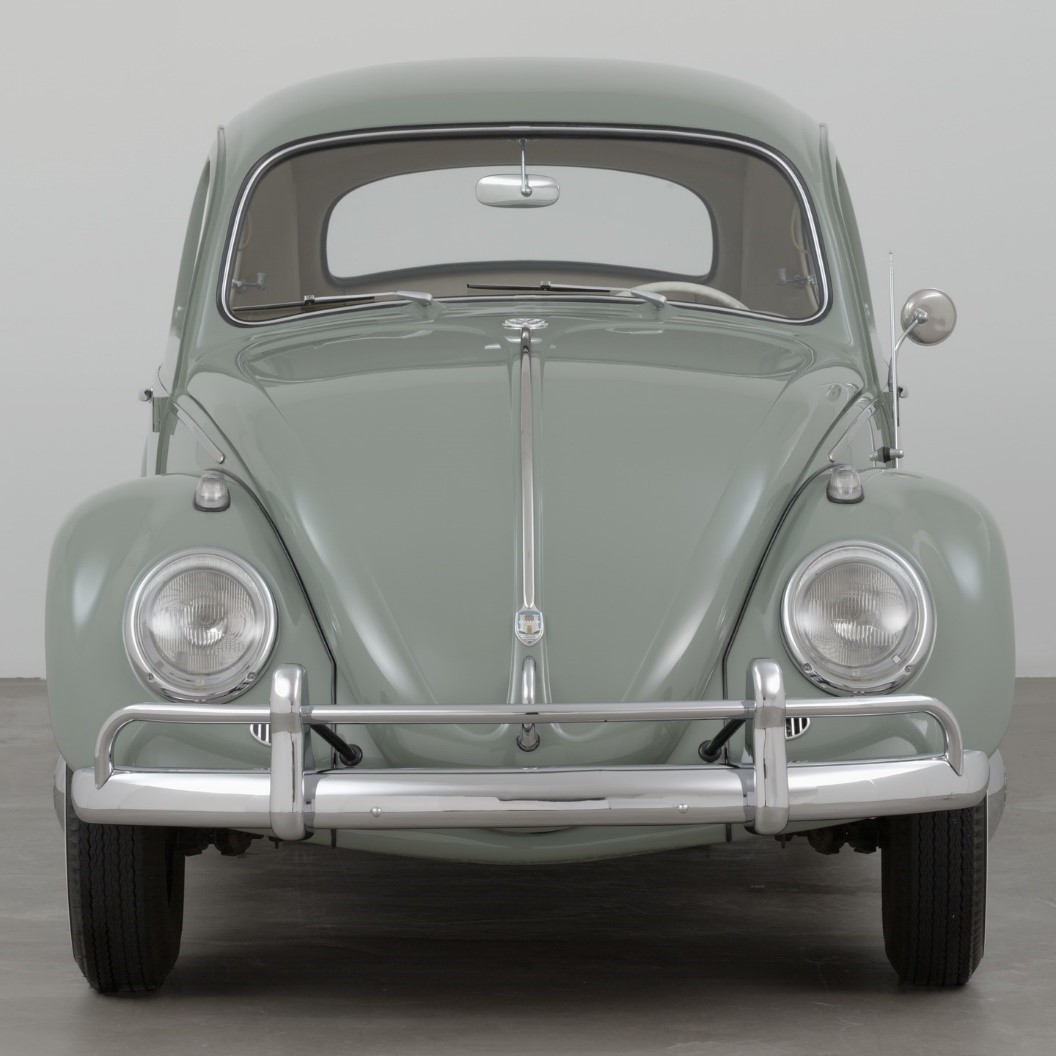
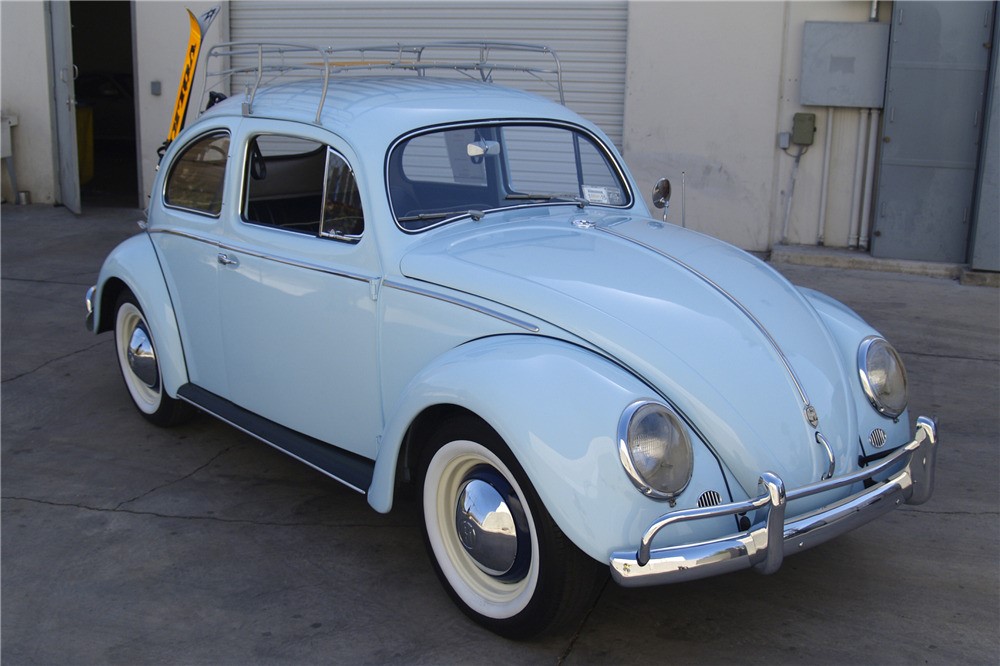
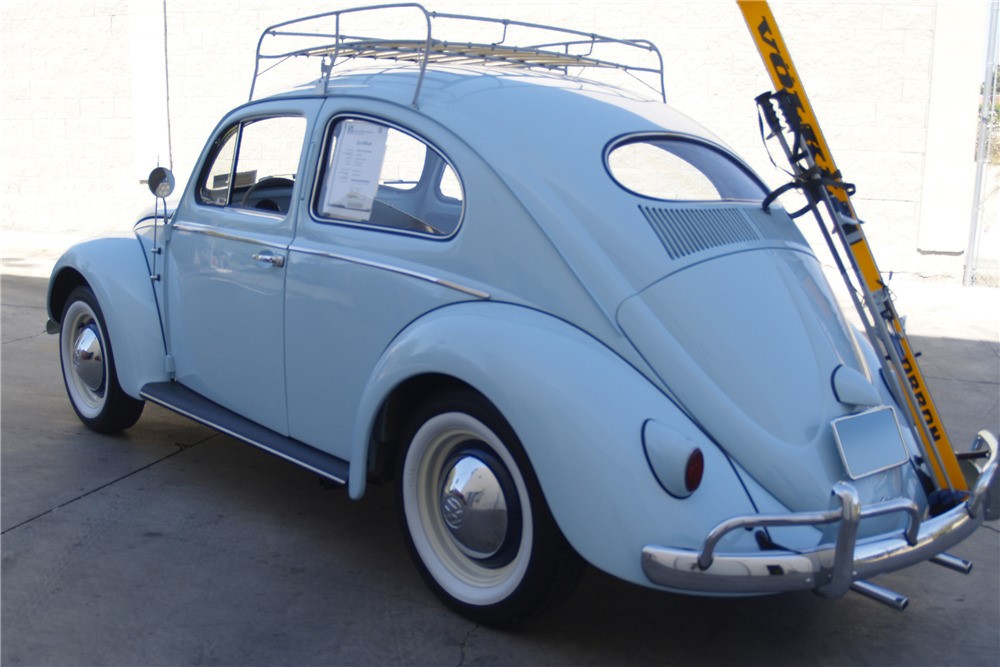
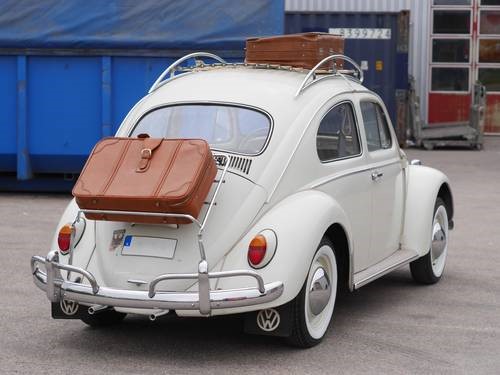
2018
With sales having declined since 2013, Volkswagen announced that the Beetle had reached the end of the line. There will be two last models, the Final Edition SE (which starts at $25,995) and the Final Edition SEL (beginning at $29,995) — and both are available as convertibles. So is it really the last ride for the beloved Bug? As Hinrich J. Woebcken, president and CEO of Volkswagen Group of America, said in his announcement, "Never say never."
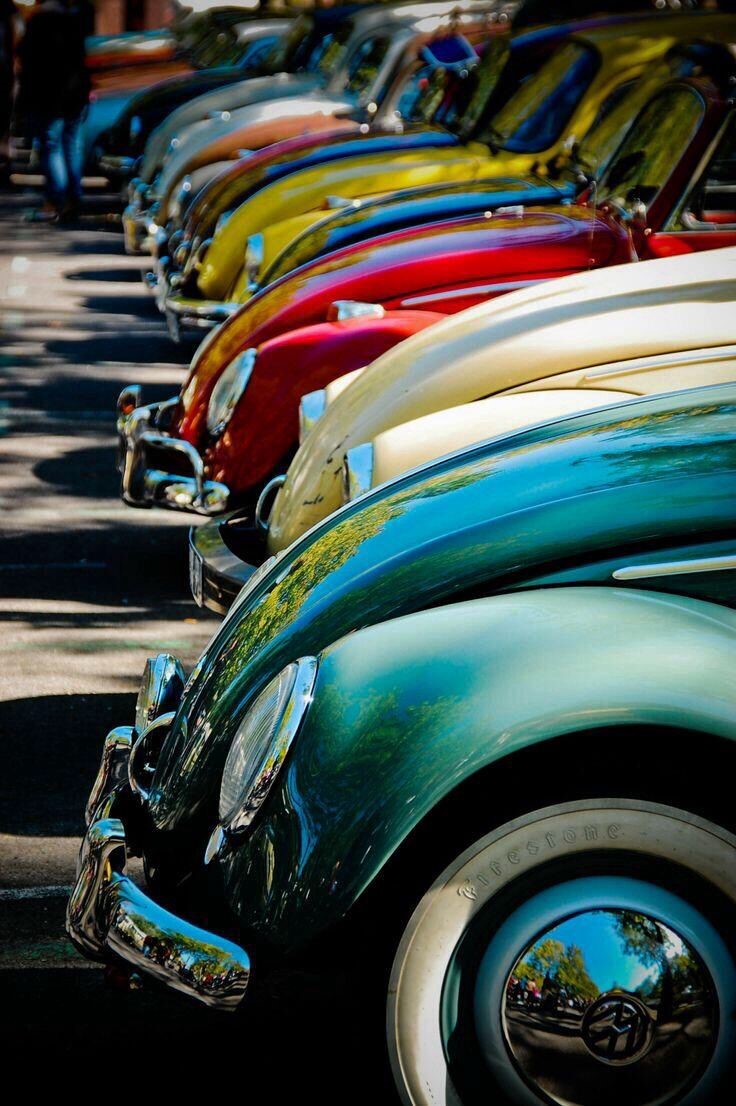
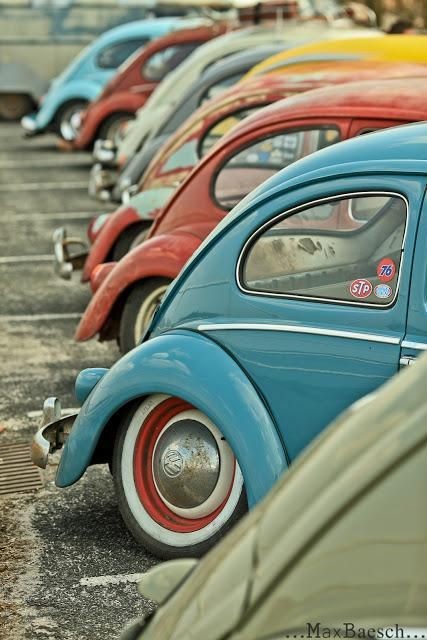
The Volkswagen Beetle—officially the Volkswagen Type 1, informally in German the Käfer (meaning "beetle"), in parts of the English-speaking world the Bug and known by many other nicknames in other languages — is a two-door, rear-engine economy car, intended for five occupants (later, Beetles were restricted to four people in some countries), that was manufactured and marketed by German automaker Volkswagen (VW) from 1938 until 2003.
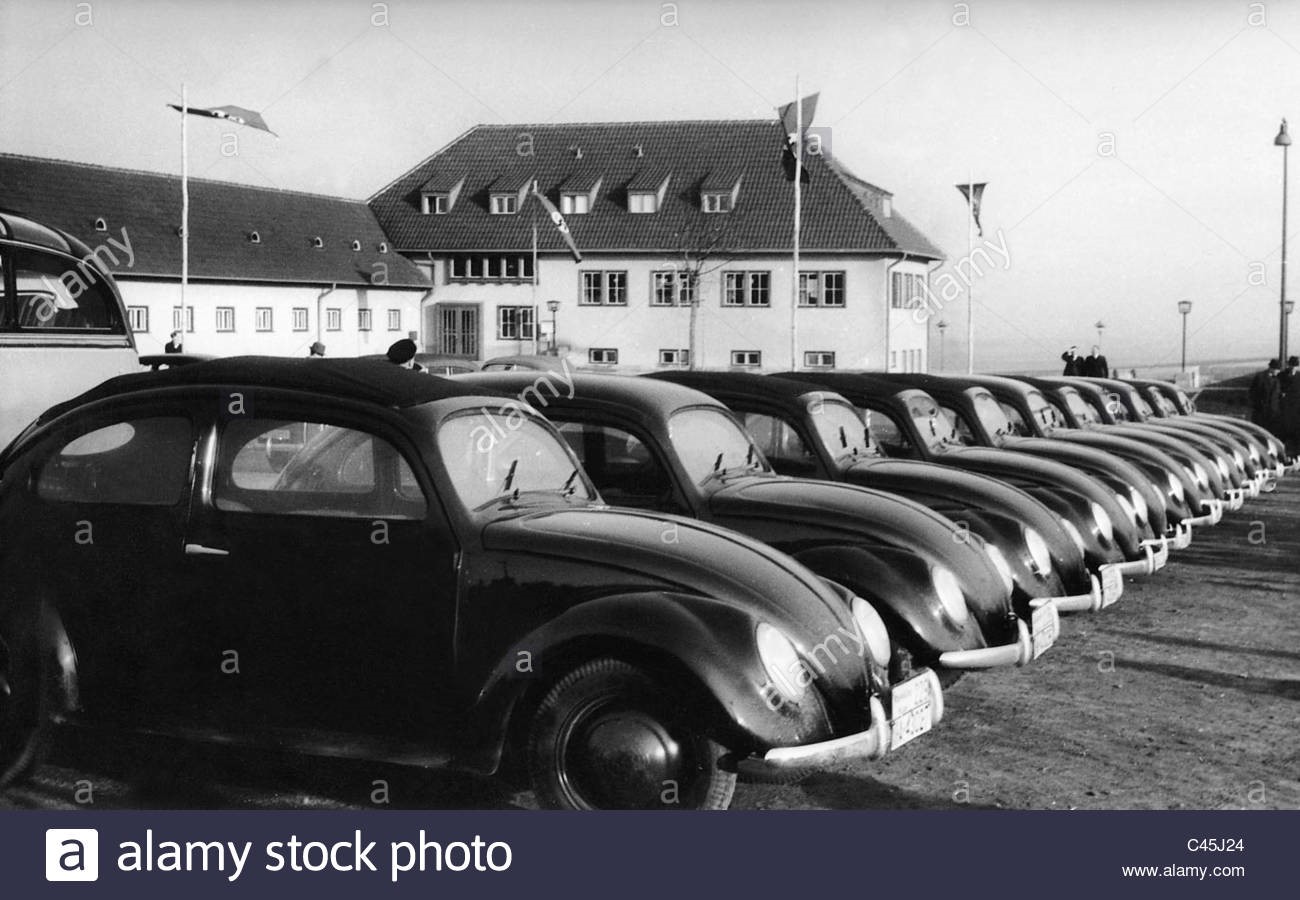
VW Beetle at the rest stop Magdeburg boerde 1939.
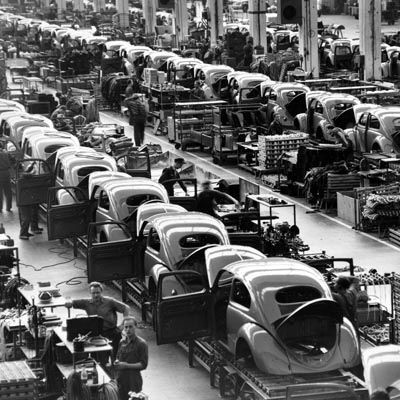
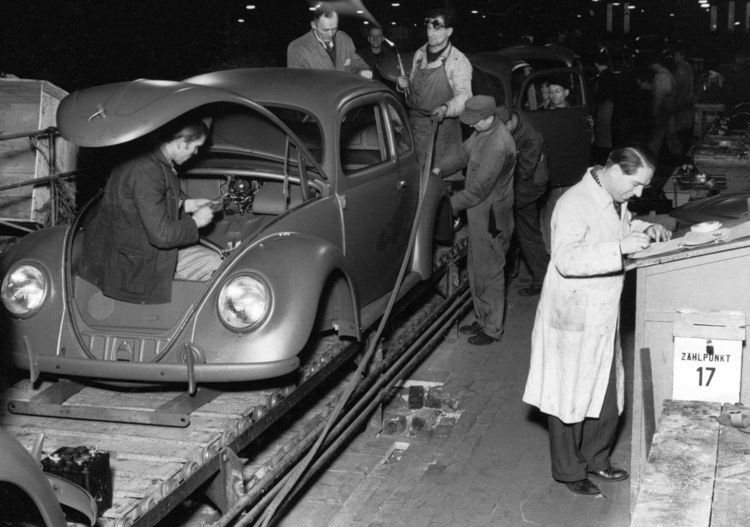
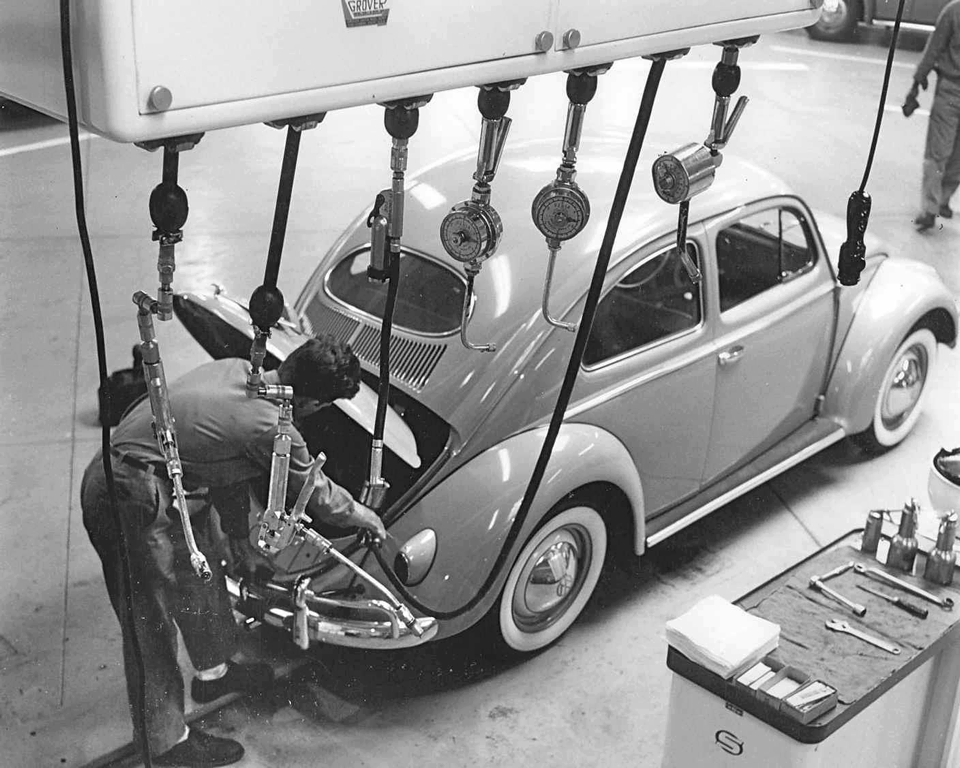
VW factory 60`s.
Wolfsburg, typ 113 1960.
Teaser 9 C70 1107 Kaefer produktion 1970.
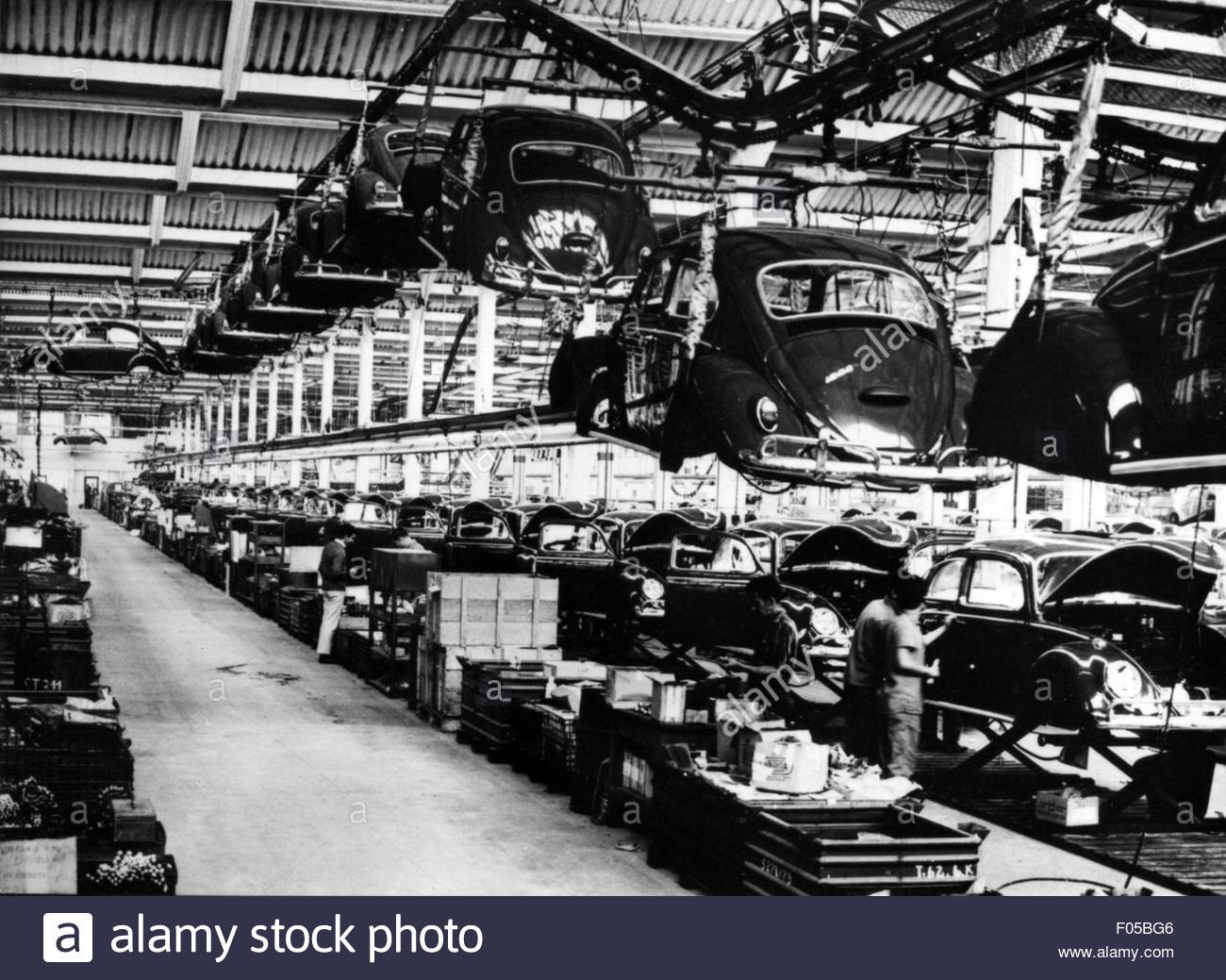
Industry production of the VW Beetle Sao Bernardo do Campo in 1970.
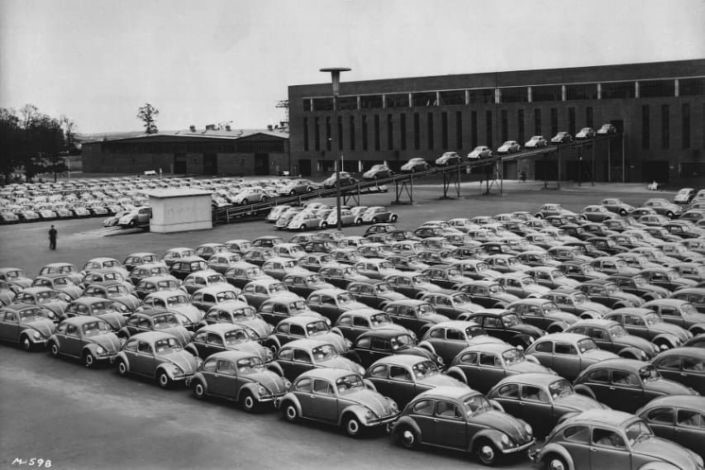
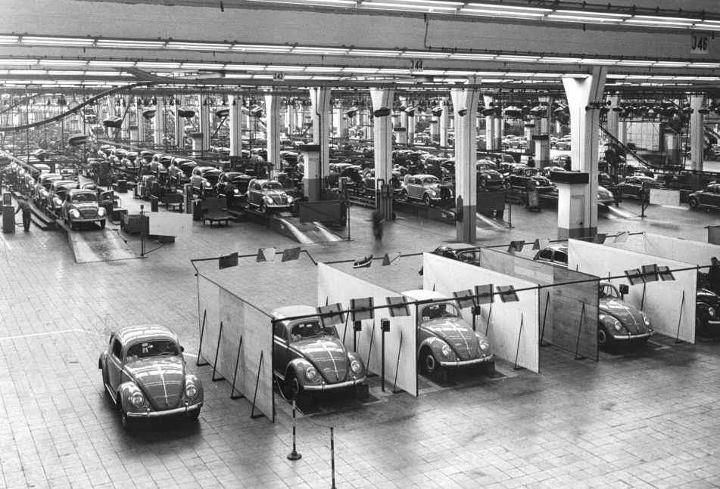

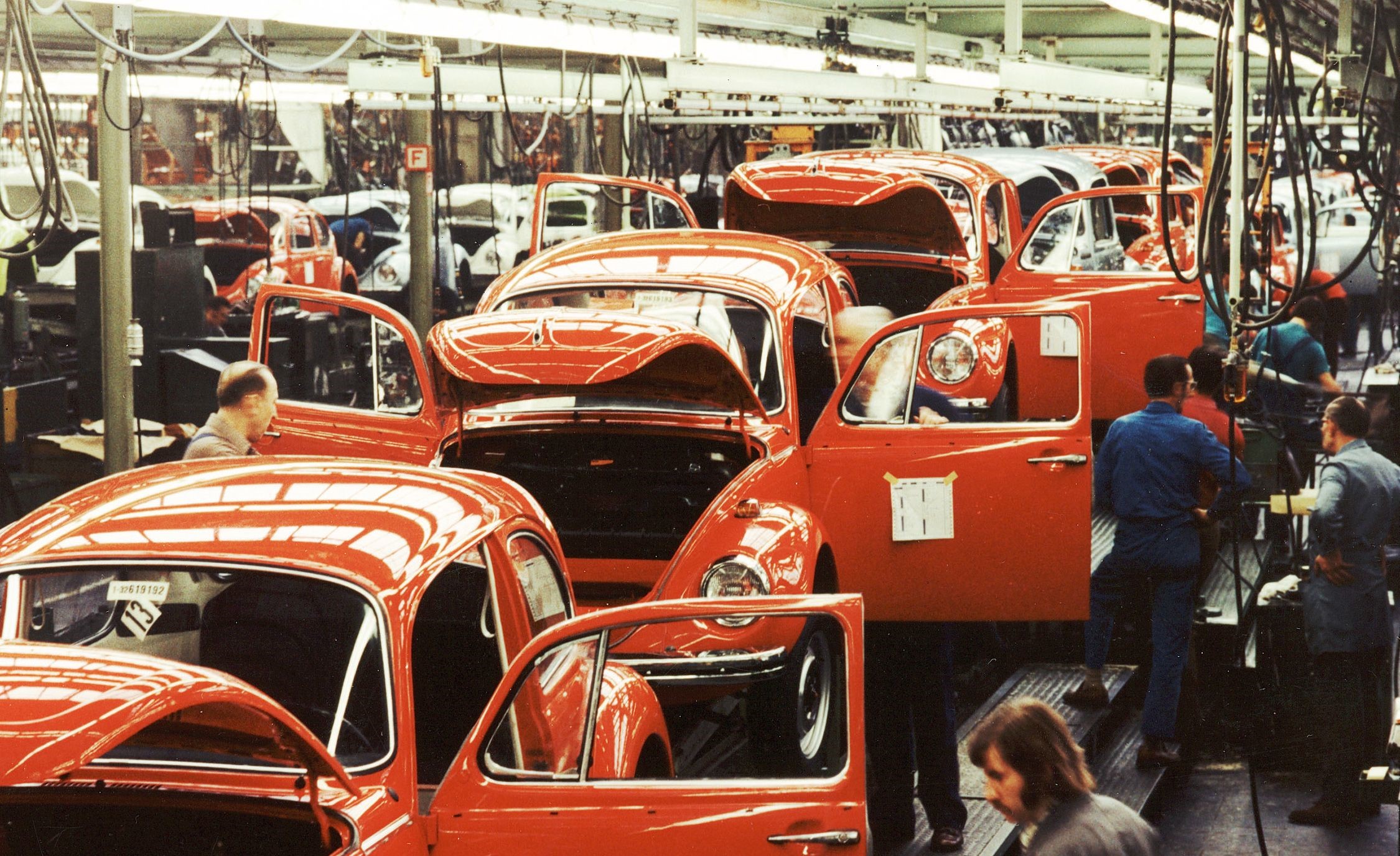
1973 VW Beetles assembly.

1974 VW Beetle final Wolfsburg.
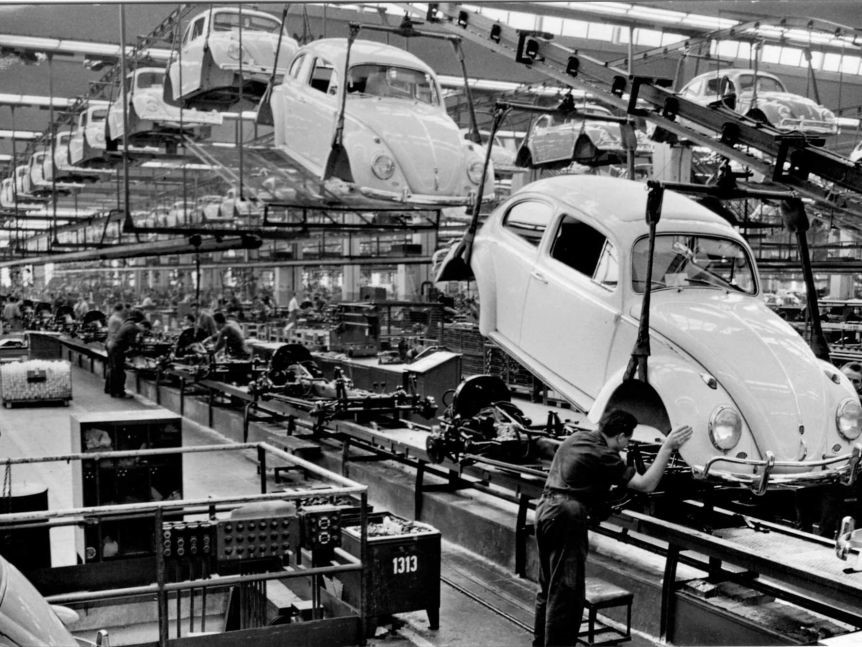
In total, over 21 million original Volkswagen Beetles were produced in its lifetime. (Flickr Alden Jewell).
The need for a people's car (Volkswagen in German and in the English-speaking world in the early 20th century as "folks' wagon"), its concept and its functional objectives were formulated by the leader of Nazi Germany, Adolf Hitler, who wanted a cheap, simple car to be mass-produced for his country's new road network (Reichsautobahn). Members of the National Socialist party, with an additional dues surcharge, were promised the first production, but civil war in Spain shifted most production resources to military vehicles instead to support Francisco Franco. Lead engineer Ferdinand Porsche and his team took until 1938 to finalise the design. Béla Barényi is credited with first conceiving the original design for this car in 1925, notably by Mercedes-Benz, on their website, including his original technical drawing, five years before Porsche claimed to have done his initial version. The influence on Porsche's design of other contemporary cars, such as the Tatra V570 and the work of Josef Ganz remains a subject of dispute. The result was the first Volkswagen, and one of the first rear-engined cars since the Brass Era. With 21,529,464 produced, the Beetle is the longest-running and most-manufactured car of a single platform ever made.
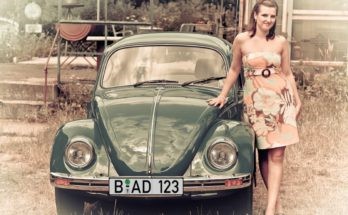
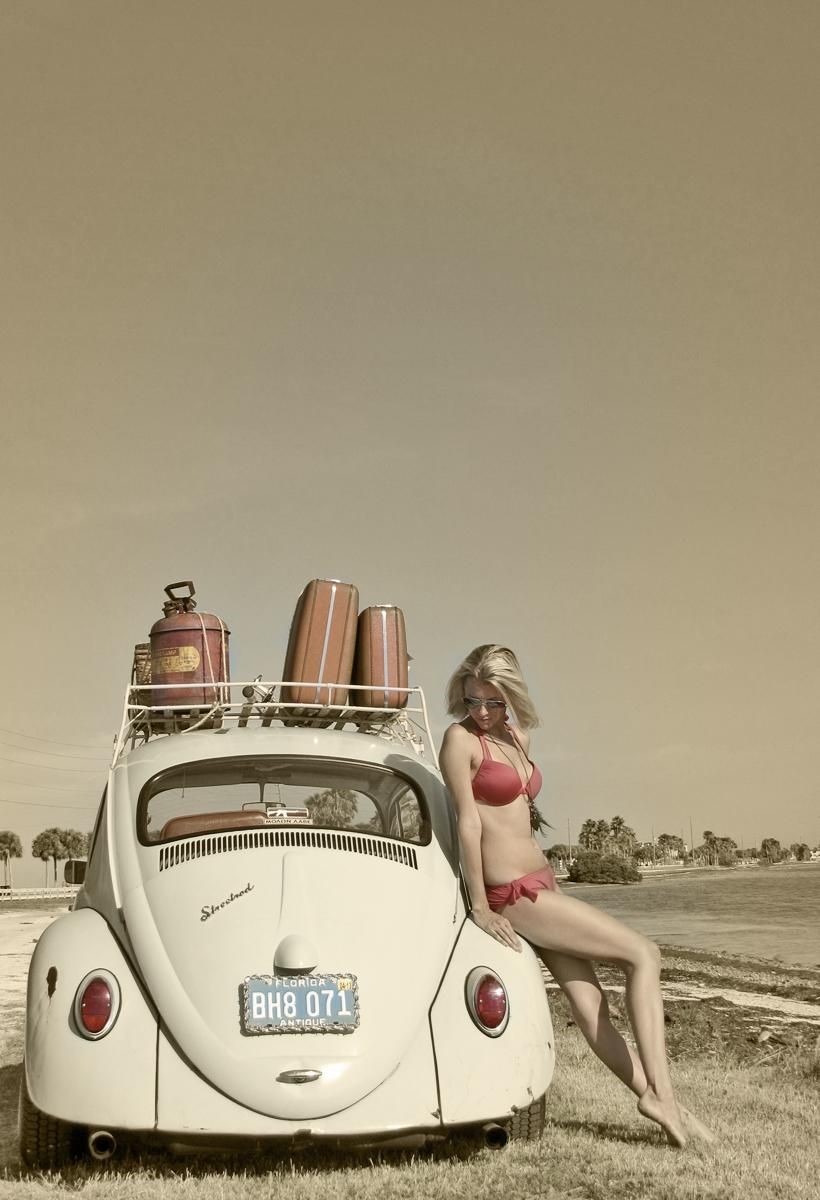
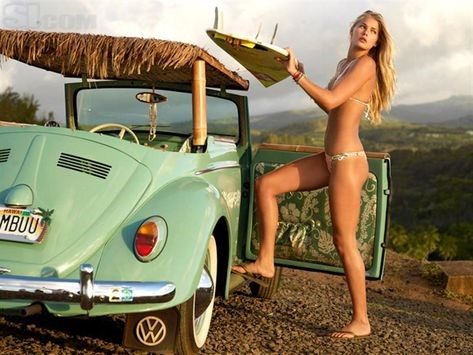
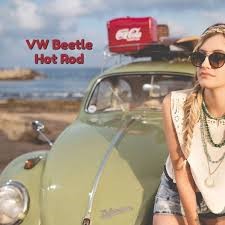
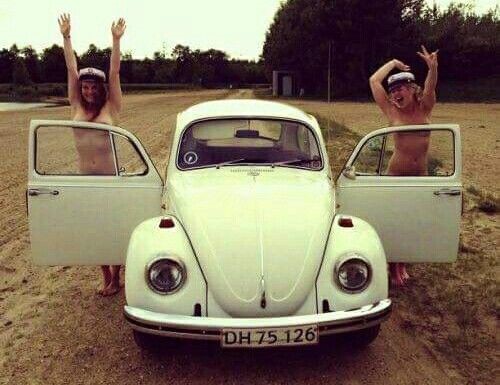
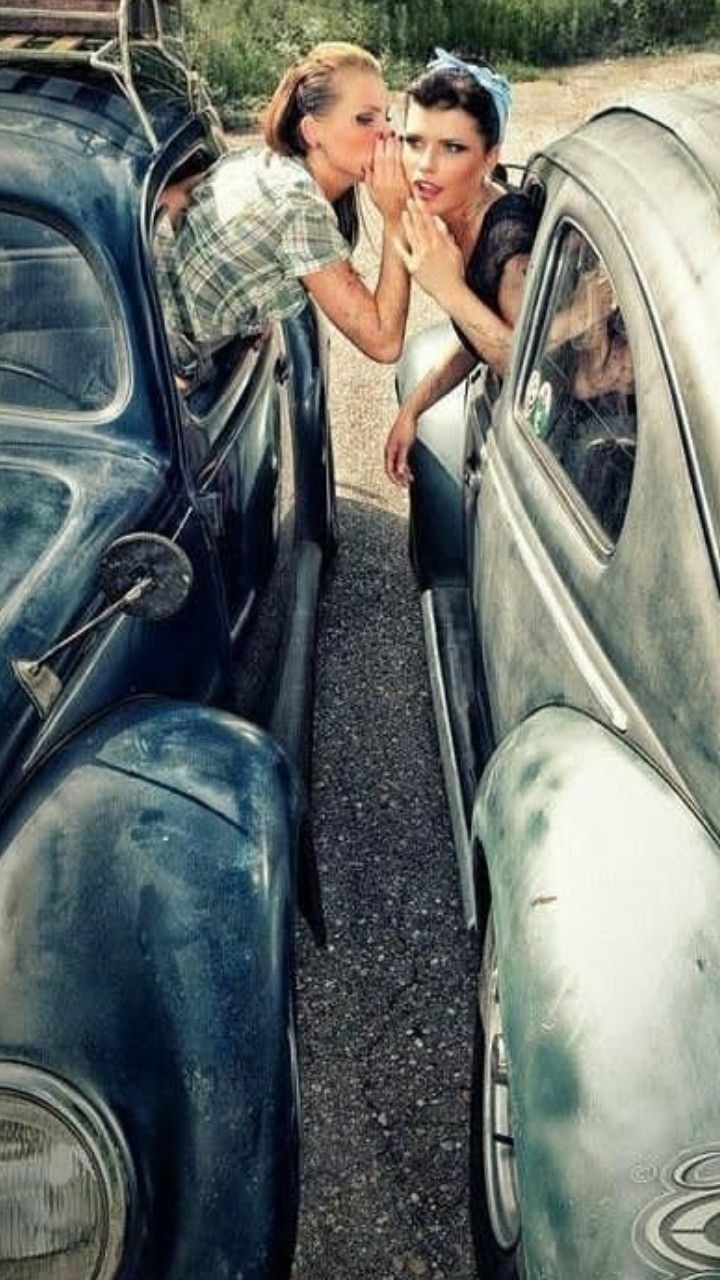
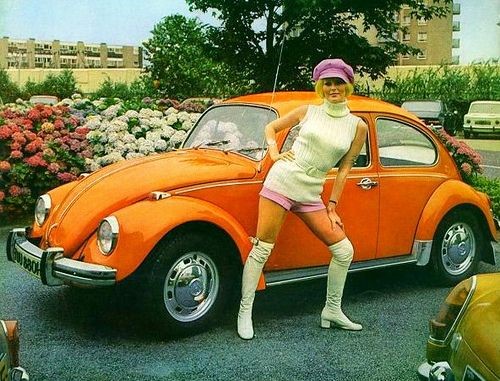
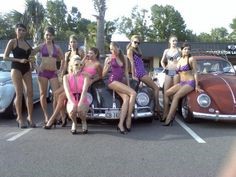
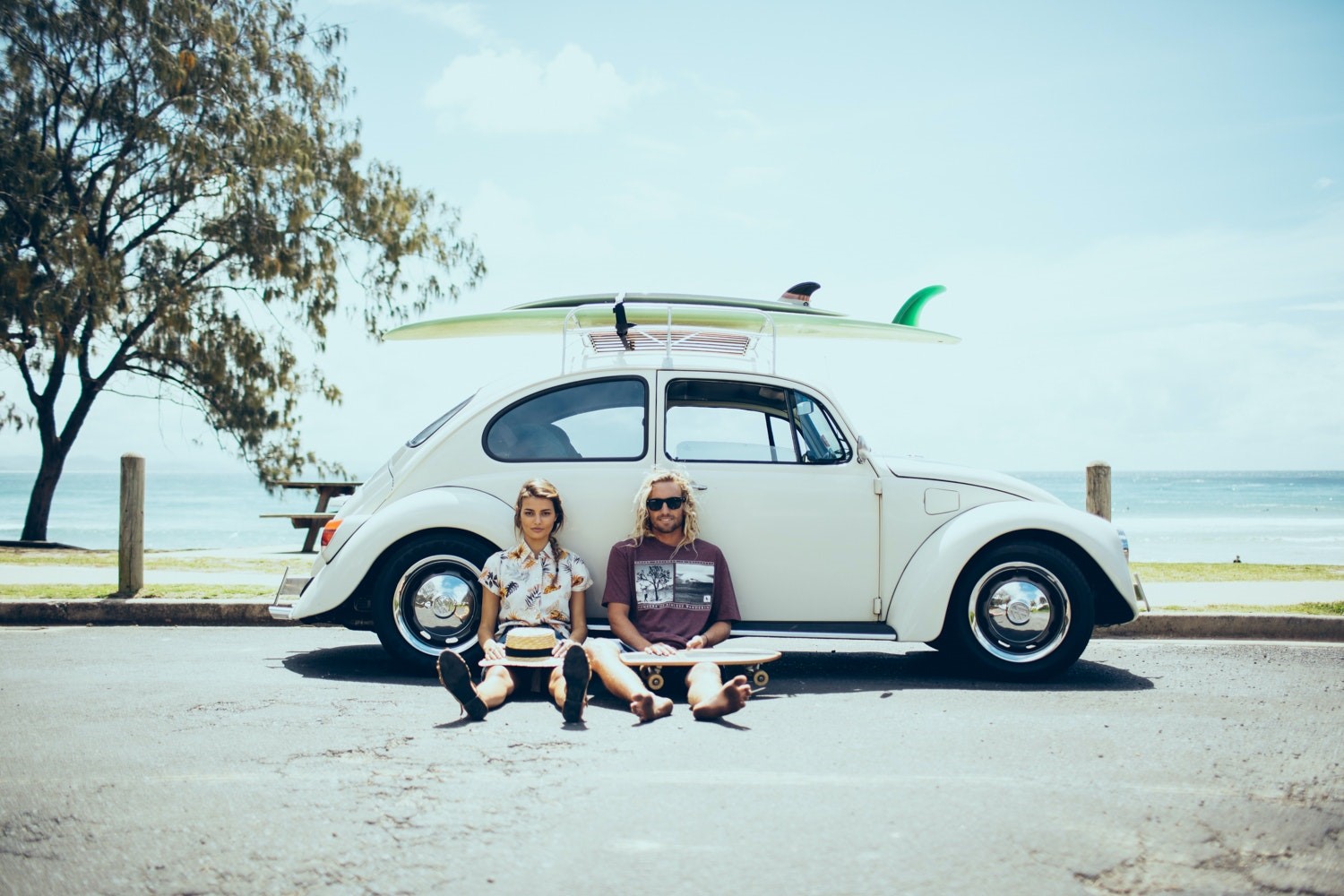
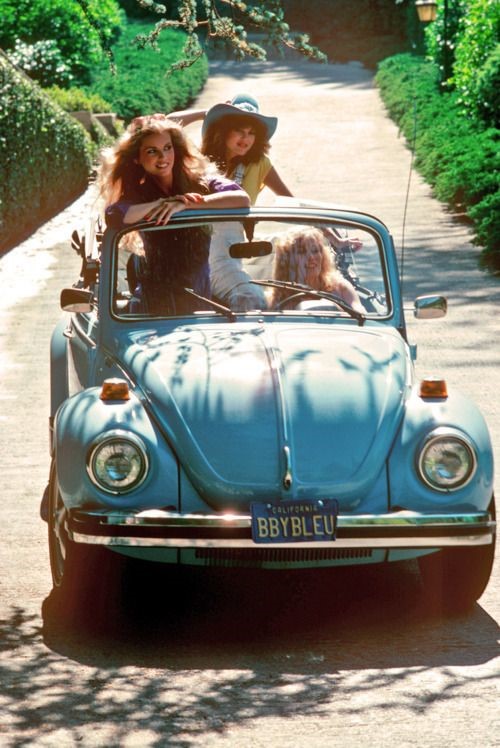
Although designed in the 1930s, due to World War II, civilian Beetles only began to be produced in significant numbers by the end of the 1940s. The car was then internally designated the Volkswagen Type 1 and marketed simply as the Volkswagen.
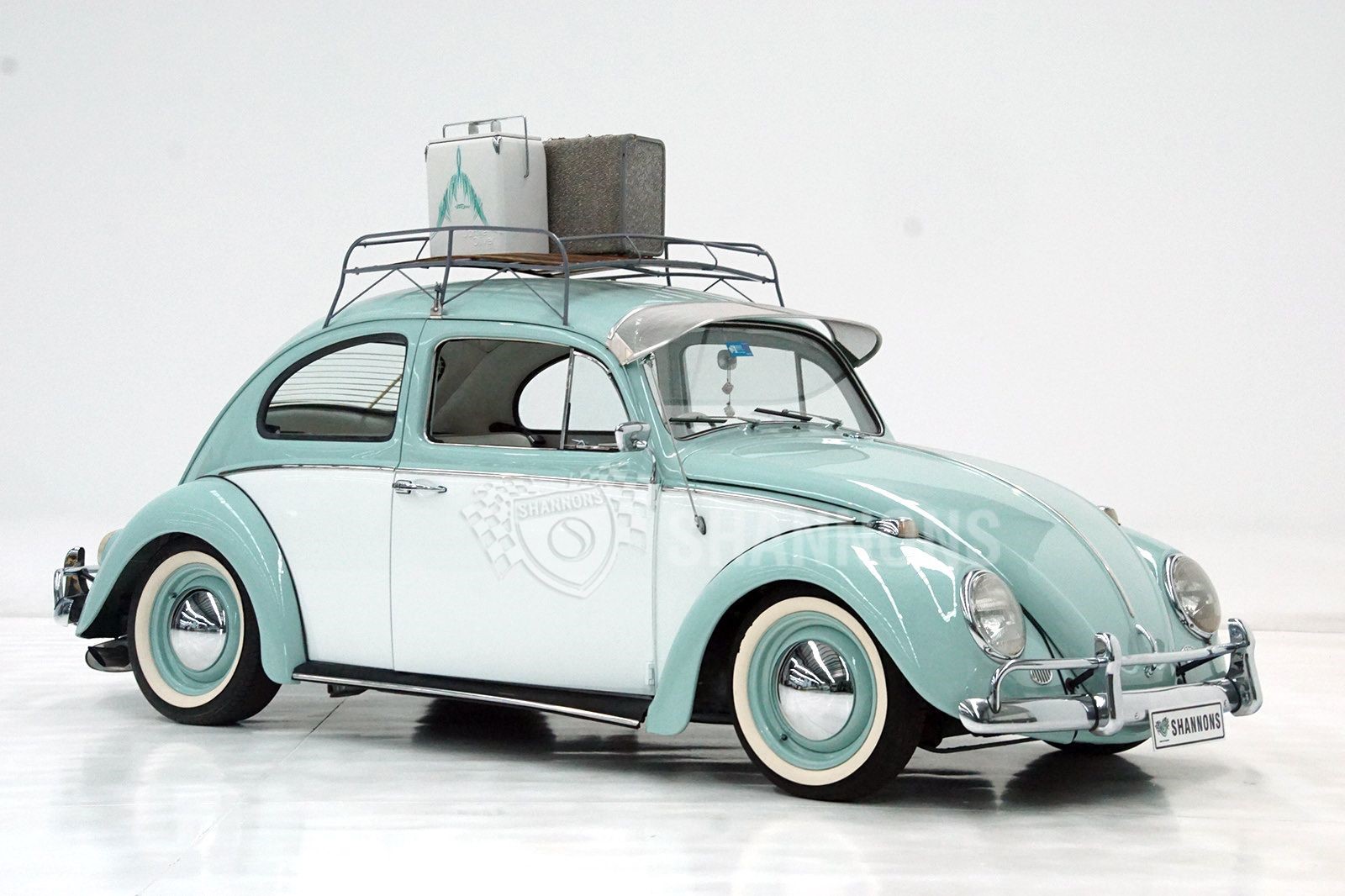
1964 Volkswagen Beetle 1200 twin port sedan.
Later models were designated Volkswagen 1200, 1300, 1500, 1302, or 1303, the former three indicating engine displacement, the latter two derived from the model number. The car became widely known in its home country as the Käfer (German for "beetle", cognate with English chafer) and was later marketed under that name in Germany and as the Volkswagen in other countries. For example, in France it was known as the Coccinelle (French for ladybug). In 1943, Roy Fedden applied for a patent, GB570814, 'Improvements relating to road vehicles', a car identical to VW Käfer.
The original 25 hp Beetle was designed for a top speed around 100 km/h (62 mph), which would be a viable cruising speed on the Reichsautobahn system. As Autobahn speeds increased in the postwar years, its output was boosted to 36, then 40 hp, the configuration that lasted through 1966 and became the "classic" Volkswagen motor. The Beetle gave rise to multiple variants: mainly the 1950 Type 2 'Bus', the 1955 Karmann Ghia, as well as the 1961 Type 3 'Ponton' and the 1968 Type 4 (411/412) family cars, ultimately forming the basis of an entirely rear-engined VW product range. The Beetle thus marked a significant trend, led by Volkswagen and then by Fiat and Renault, whereby the rear-engine, rear-wheel-drive layout increased from 2.6 percent of continental Western Europe's car production in 1946 to 26.6 percent in 1956. In 1959 even General Motors launched an air-cooled, rear-engined car, the Chevrolet Corvair — which even shared the Beetle's flat engine and swing axle architecture.
In the 1999 Car of the Century competition, to determine the world's most influential car in the 20th century, the Type 1 came fourth, after the Ford Model T, the Mini and the Citroën DS.
"The People's Car"
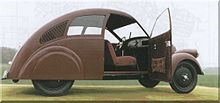
Model of the 1932 Porsche Type 12, Nuremberg Museum of Industrial Culture.
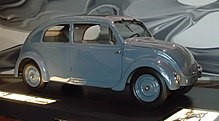
Type 32 prototype, developed for NSU (Autostadt ZeitHaus, Wolfsburg).

Scale model of the W30 prototype.
Contrary to the situation in the United States, where the Ford Model T had become the first car to motorize the masses, contributing to household car ownership of about 33% in 1920 and some 46% in 1930, in the early 1930s, the German auto industry was still mostly limited to luxury models and few Germans could afford anything more than a motorcycle: one German out of 50 owned a car.
The epithet Volks- literally, "people's-" had been applied to other Nazi-sponsored consumer goods as well, such as the Volksempfänger ("people's radio").
In May 1934, at a meeting at Berlin's Kaiserhof Hotel, Hitler insisted on a basic vehicle that could transport two adults and three children at 100 km/h (62 mph) while not using more than 7 litres of fuel per 100 km (32 mpg US/39 mpg UK). The engine had to be powerful enough for sustained cruising on Germany's Autobahnen. Everything had to be designed to ensure parts could be quickly and inexpensively exchanged. The engine had to be air-cooled because, as Hitler explained, not every country doctor had his own garage. (Ethylene glycol antifreeze was only just beginning to be used in high-performance liquid-cooled aircraft engines. In general, water in radiators would freeze unless the vehicle was kept in a heated building overnight or drained and refilled each morning).
The "People's Car" would be available to citizens of Germany through a savings scheme, or Sparkarte (savings booklet), at 990 Reichsmark, about the price of a small motorcycle. (The average weekly income was then around 32RM).
Development
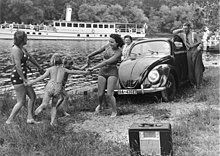
KdF Propaganda: "a family playing by a river with a KdF-Wagen and radio receiver."
Ferdinand Porsche developed the Type 12, or "Auto für Jedermann" (car for everybody) for Zündapp in 1931. Porsche already preferred the flat-four engine and selected a swing axle rear suspension (invented by Edmund Rumpler), while Zündapp insisted on a water-cooled five-cylinder radial engine. In 1932 three prototypes were running; all were lost during World War II, the last in a bombing raid in Stuttgart in 1945.
The Zündapp prototypes were followed by the Porsche Type 32, designed in 1933 for NSU Motorenwerke AG, another motorcycle company. The Type 32 was similar in design to the Type 12, but it had a flat-four engine. NSU discontinued car manufacturing and the Type 32 was abandoned at the prototype stage.
Initially designated Type 60 by Porsche, the design team included Erwin Komenda and Karl Rabe. In October 1935, the first two Type-60 prototypes, known as cars V1, a sedan and V2, a convertible (V for Versuchswagen, or "test car"), were ready. In 1936 testing began of three further V3 prototypes, built in Porsche's Stuttgart shop. A batch of thirty W30 development models, produced for Porsche by Daimler-Benz, underwent 1,800,000 mi (2,900,000 km) of further testing in 1937. All cars had the distinctive round shape and the air-cooled, rear-mounted engine. Included in this batch was a rollback soft top called the Cabrio Limousine. A further batch of 44 VW38 pre-production cars produced in 1938 introduced split rear windows; both the split window and the dash were retained on production Type 1s until 1953. The VW38 cars were followed by another batch of 50 VW39 cars, completed in July 1939.
The car was designed to be as simple as possible mechanically. The air-cooled 25 hp (19 kW) 995 cc (60.7 cu in) motor's built-in oil cooler, and the flat-four engine configuration's superior performance was also effective for the German Afrika Korps in Africa's desert heat. The suspension design used compact torsion bars instead of coil or leaf springs. The Beetle is nearly airtight and will briefly float.
Factory
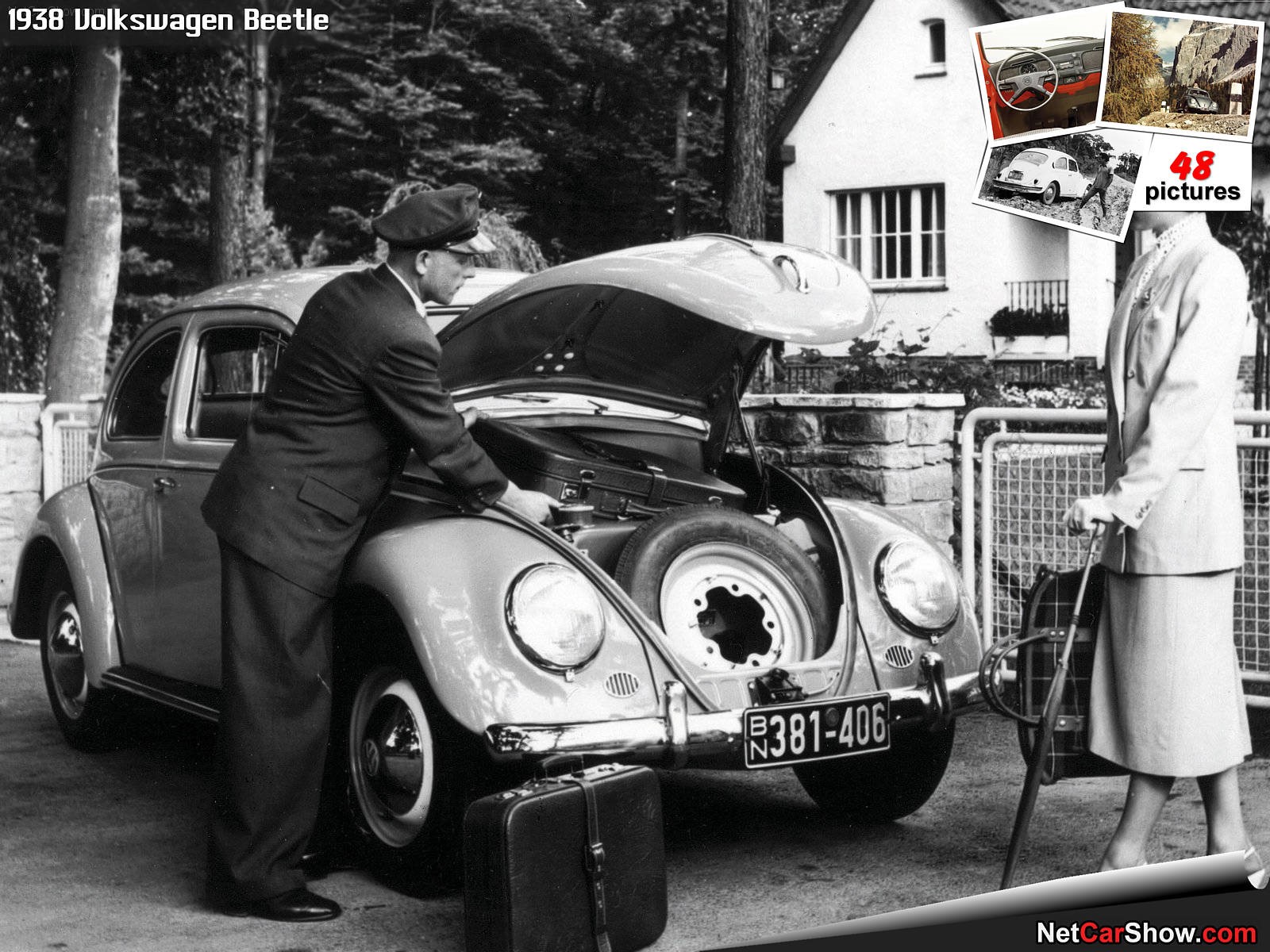
Volkswagen Beetle 1600 in 1938.
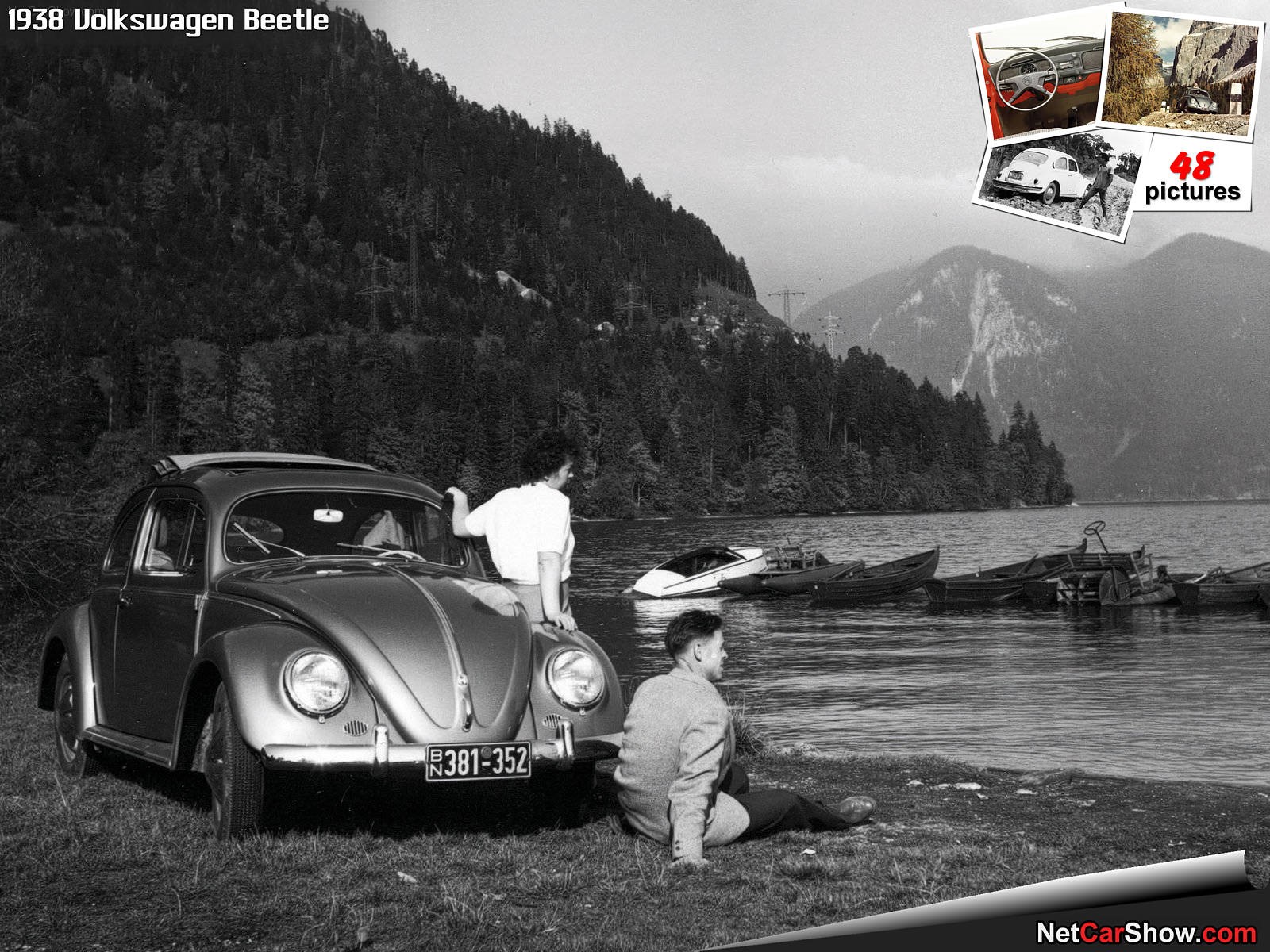
Volkswagen Beetle 1600 in 1938.
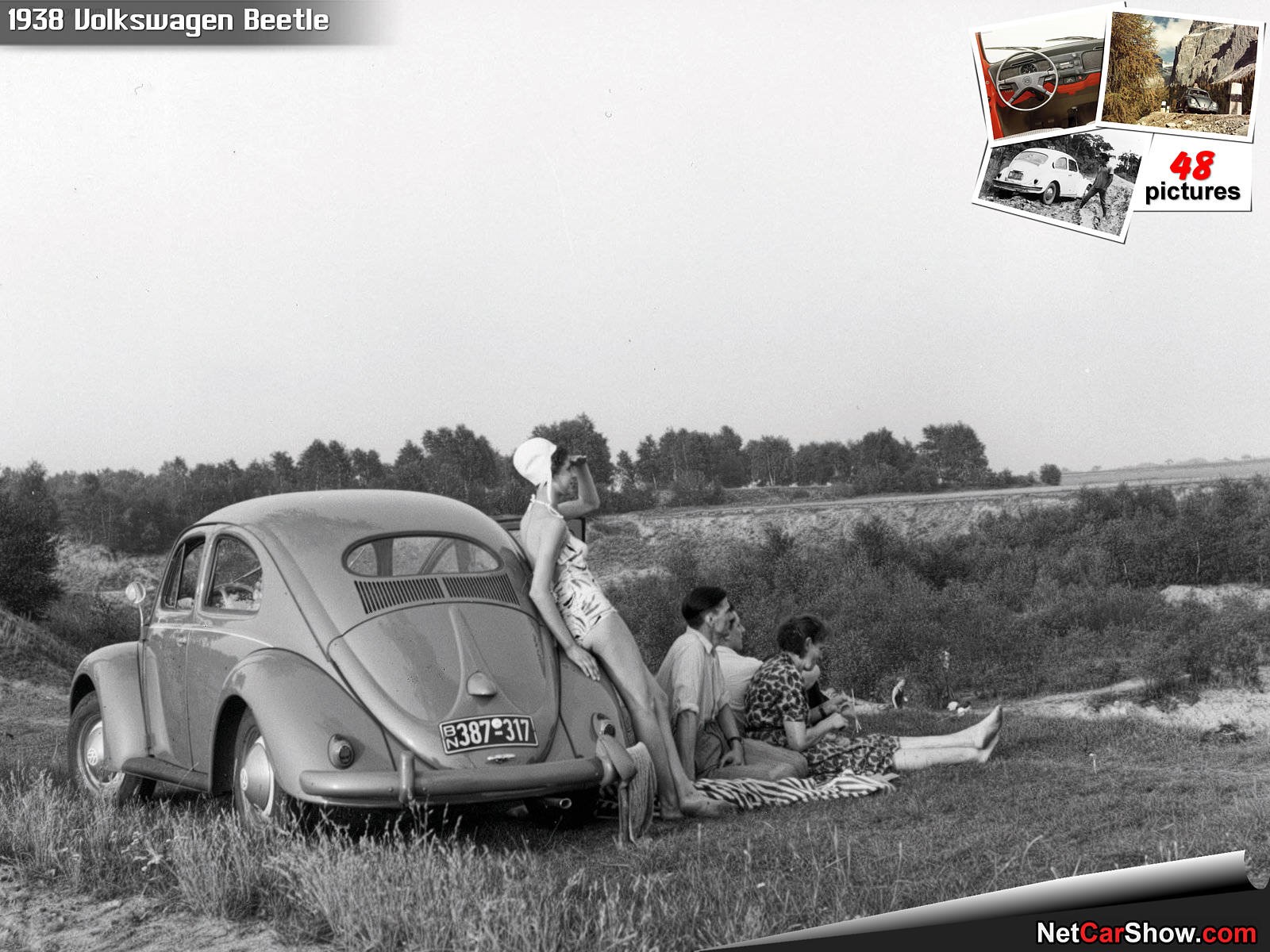
Volkswagen Beetle 1600 in 1938.
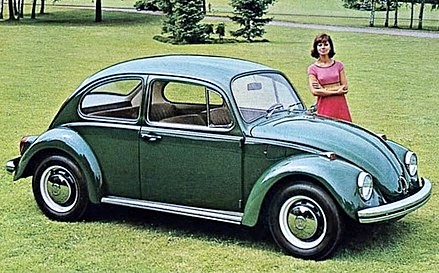
Volkswagen type 1 1938-2003.
On 26 May 1938, Hitler laid the cornerstone for the Volkswagen factory in Fallersleben. He gave a speech, in which he named the car Kraft-durch-Freude-Wagen ("Strength Through Joy Car", usually abbreviated to KdF-Wagen). The name refers to Kraft durch Freude ('Strength Through Joy'), the official leisure organization of Nazi Germany. The model village of Stadt des KdF-Wagens was created near Fallersleben in Lower Saxony in 1938 for the benefit of the workers at the newly built factory.
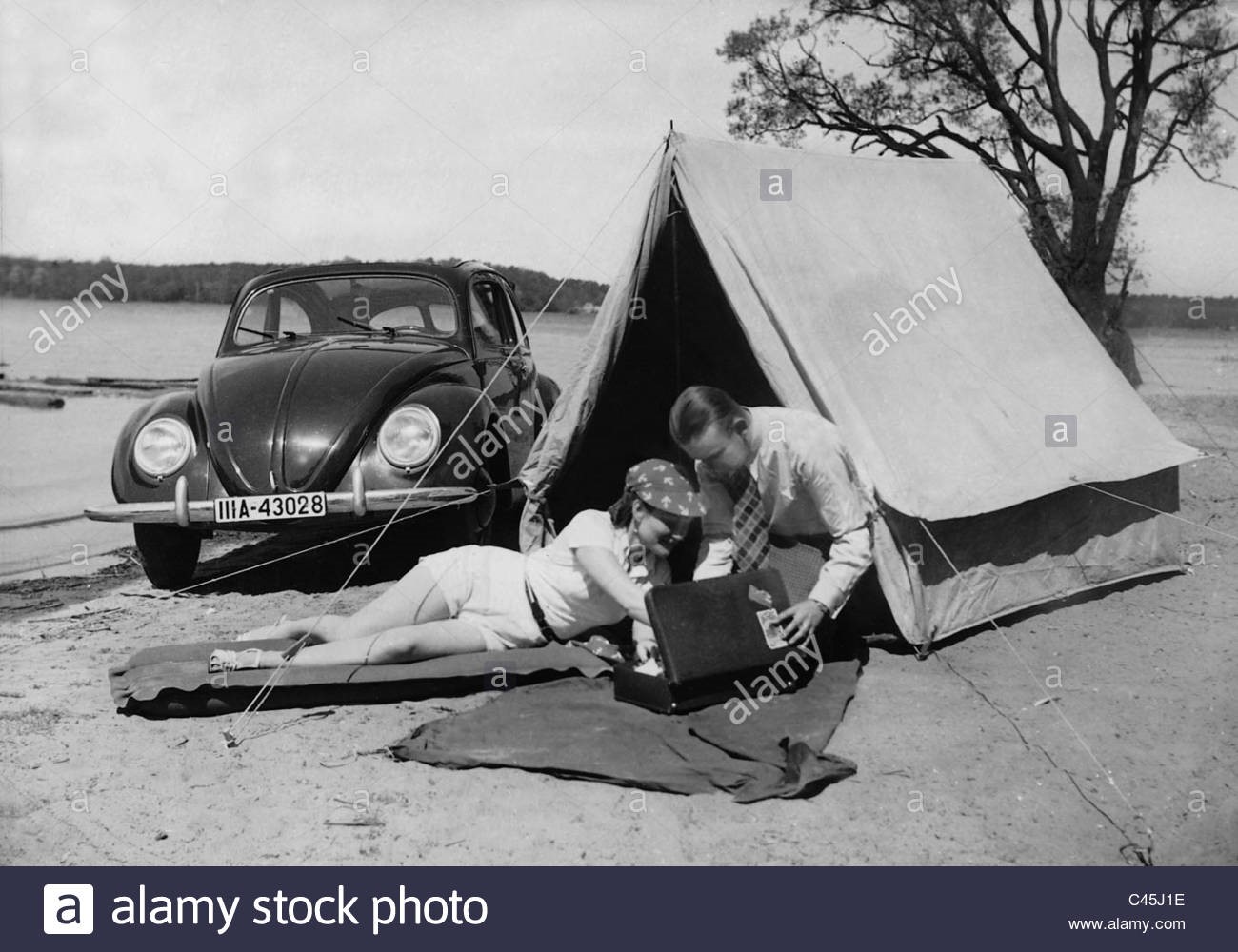
Weekend getaway with a VW Beetle in 1939.
Volkswagen had only just started small scale production, building about 210 Beetles, when civilian production was halted at the start of the war. Except for two military prototype units, these KdF sedans were allocated to military officers as personal cars. Both 704cc and 984cc air-cooled engines were fitted in these early units.
The first volume-produced versions of the car's running-gear and chassis were military vehicles, the Type 82 Kübelwagen (approximately 52,000 built) and the amphibious Type 128 and 166 Schwimmwagen (about 14,000 built).
Wartime production.

Front view of a Wehrmacht Typ 82E in dunkelgelb.
A handful of KdF-Wagen were produced, primarily for the Nazi elite, from 1941 to 1944, as the Typ 60. During World War II, the factory primarily built the Kübelwagen (Typ 82), the Schwimmwagen (Typ 166) and a handful of other light wheeled vehicles, all mechanically derived from the Typ 1, for the Wehrmacht. These included several hundred Kommandeurswagen (Typ 87), with a Typ 1 Beetle body mounted on the rugged chassis of the four-wheel drive Typ 86 Kübelwagen prototype and fitted with portal axle and a Schwimmwagen drive train, with wider fenders., to accommodate oversize Kronprinz all-terrain tires (reminiscent of the later Baja Bugs). Kommandeurswagen were produced up to 1944, when all production was halted because of heavy damage to the factory from Allied air raids. Much of the essential equipment had already been moved to underground bunkers for protection, which let production resume quickly after hostilities ended. Due to gasoline shortages late in the war, a few "Holzbrenner" Beetles were built, which were fueled with logs of wood. The logs were converted into combustible gases using pyrolysis gas producers located under the front hood, so the car could retain its carbureted Otto engine.
Post-war production and boom.
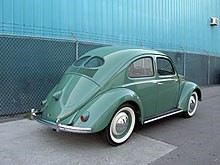
1949 split-window (known as a "pretzel","split", or "splitty" among enthusiasts) was commonly used to describe transporters of the era.
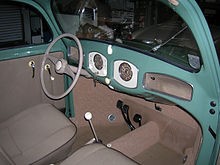
1949 interior.

1957 interior.
In occupied Germany, the Allies followed the Morgenthau plan to remove all German war potential by complete or partial pastoralization. As part of this, in the Industrial plans for Germany, the rules for which industry Germany was to be allowed to retain were set out. German car production was set at a maximum of 10 percent of the 1936 car production numbers.
The Volkswagen factory was handed over by the Americans to British control in 1945; it was to be dismantled and shipped to Britain. However, no British car manufacturer was interested in the factory; an official report included the phrases "the vehicle does not meet the fundamental technical requirement of a motor-car… it is quite unattractive to the average buyer… To build the car commercially would be a completely uneconomic enterprise." The factory survived by producing cars for the British Army instead. Allied dismantling policy changed in late 1946 to mid-1947, although heavy industry continued to be dismantled until 1951. In March 1947, Herbert Hoover helped change policy by stating: “there is the illusion that the New Germany left after the annexations can be reduced to a "pastoral state". It cannot be done unless we exterminate or move 25,000,000 people out of it.”
The re-opening of the factory is largely accredited to British Army officer Major Ivan Hirst. Hirst was ordered to take control of the heavily bombed factory, which the Americans had captured. His first task was to remove an unexploded bomb that had fallen through the roof and lodged itself between some pieces of irreplaceable production equipment; if the bomb had exploded, the Beetle's fate would have been sealed. Knowing Germany needed jobs and the British Army needed vehicles, Hirst persuaded the British military to order 20,000 cars and by March 1946 the factory was producing 1,000 cars a month (in Army khaki, under the name Volkswagen Type 1), which Hirst said "was the limit set by the availability of materials". During this period, the car reverted to its original name of Volkswagen and the town was renamed Wolfsburg. The first 1,785 Type 1s were made in 1945.
After initially building mostly Beetles for the British military, in 1947 production transitioned to purely civilian Beetles, for the first time featuring chromed bumpers, hubcaps and body and running board trim. Aside from some remaining military production, civilian output reached almost 9,000 units in 1947 and for 1948 total production increased to 19,244 cars. The late 1940s Beetles still had an understressed 1131 cc engine with just 25 horsepower, but it could effortlessly maintain cruising at the car's 60-mile-per-hour (97 km/h) top speed.
Following the British Army-led restart of production and Hirst's establishment of sales network and exports to Netherlands, former Opel manager (and formerly a detractor of the Volkswagen) Heinz Nordhoff was appointed director of the Volkswagen factory in 1949. Under Nordhoff, production increased dramatically over the following decade, with the one-millionth car coming off the assembly line by 1955. During this post-war period, the Beetle had superior performance in its category with a top speed of 115 km/h (71 mph) and 0–100 kilometres per hour (0–62 mph) in 27.5 seconds with fuel consumption of 6.7 litres per 100 kilometres (42 mpg-imp; 35 mpg-US) for the standard 25 kW (34 hp) engine. This was far superior to the Citroën 2CV, which was aimed at a low speed/poor road rural peasant market and Morris Minor, designed for a market with no motorways or freeways; it was even competitive with more advanced small city cars like the Austin Mini.
In “Small Wonder”, Walter Henry Nelson wrote: “the engine fires up immediately without a choke. It has tolerable road-handling and is economical to maintain. Although a small car, the engine has great elasticity and gave the feeling of better output than its small nominal size”.
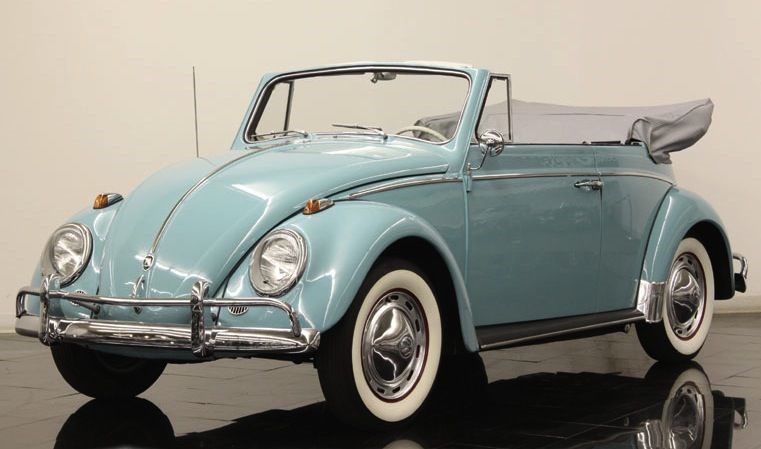
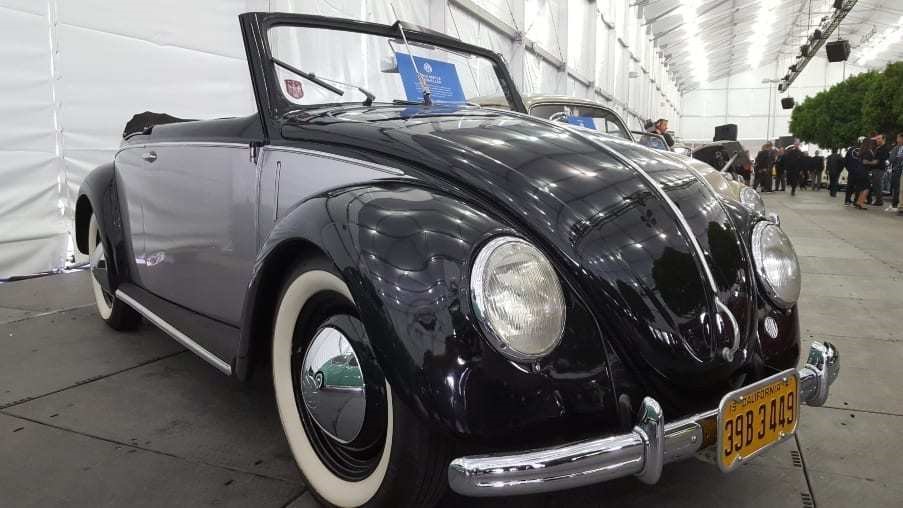
1950 VW Beetle Hebmuller.
There were other, less-numerous models, as well. The Hebmüller cabriolet (officially Type 14A), a sporty two-seater, was built between 1949 and 1953; it numbered 696. The Type 18A, a fixed-top cabriolet, was produced by Austro-Tatra as a police and fire unit; 203 were assembled between January 1950 and March 1953.
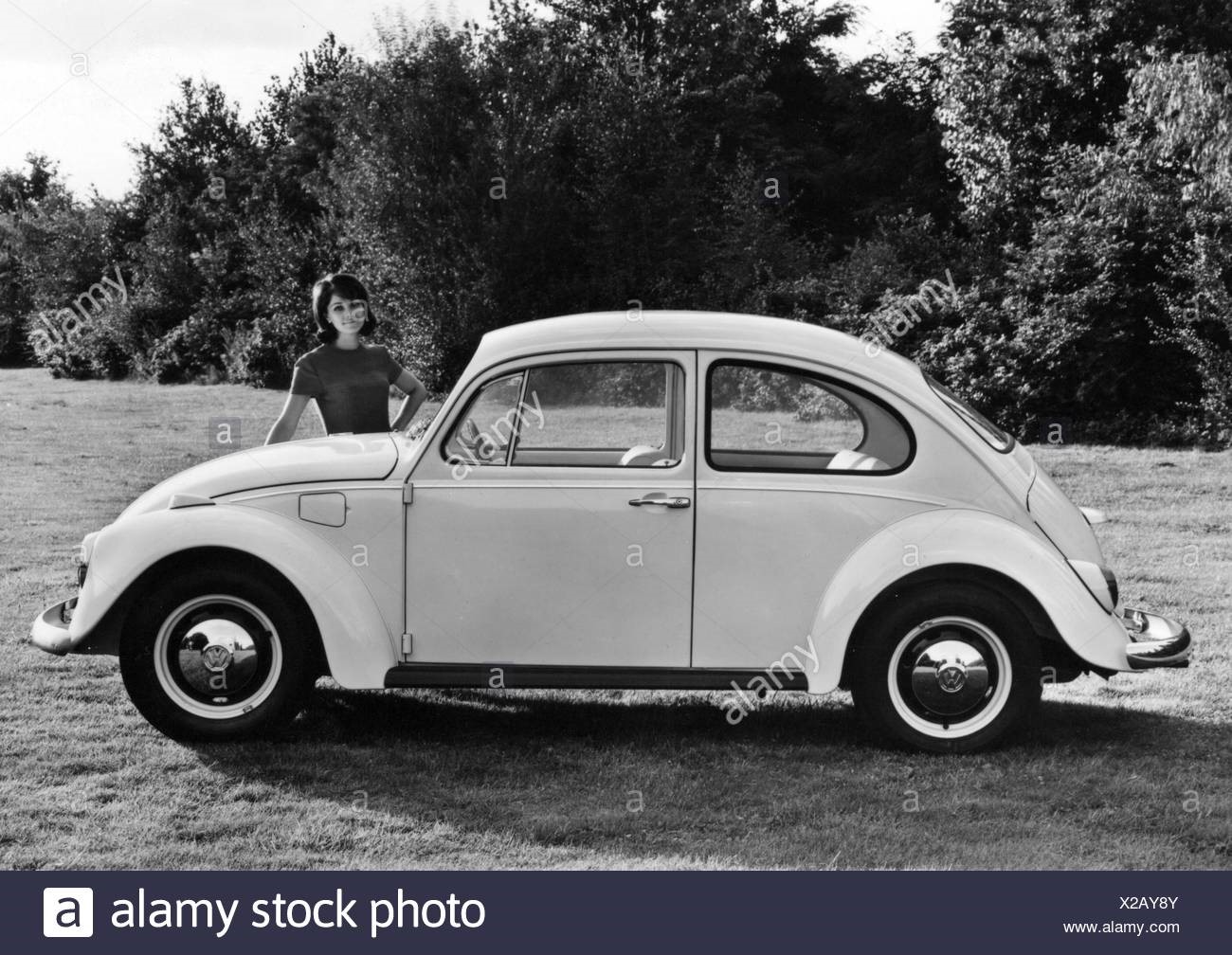
Volkswagen VW 1200 Beetle side view 1968.

VW Beetle convertible 1968.
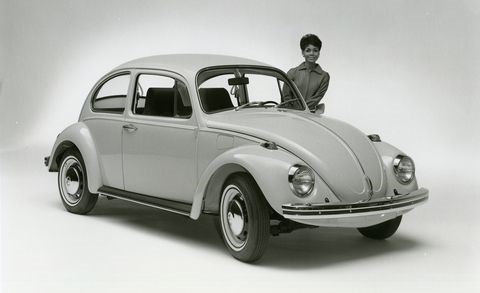
1969 VW Beetle.
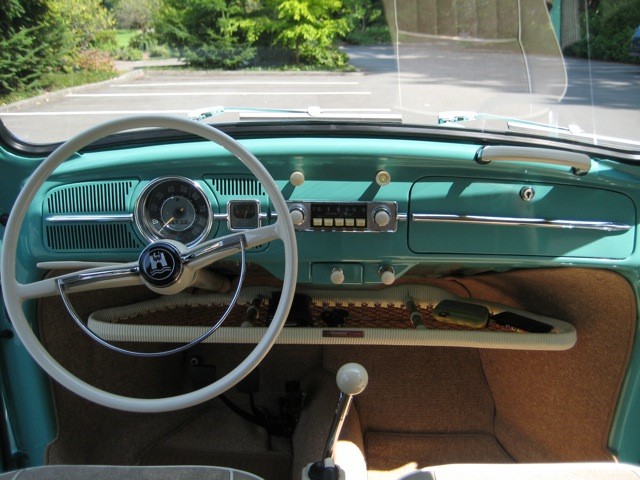
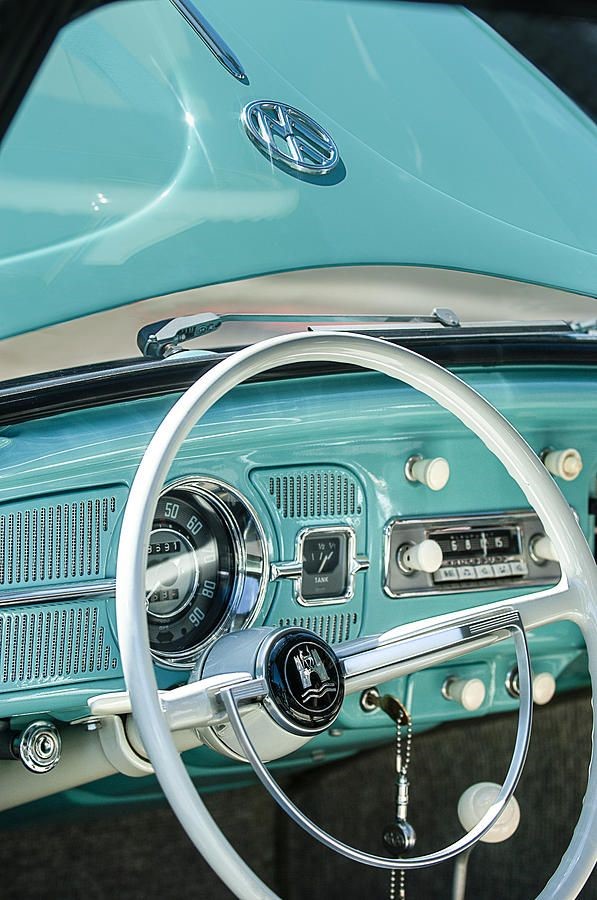
1969 Volkswagen Beetle dashboard.
The chassis became a technological and parts donor to Volkswagen Type 2 (also known as Bulli) and external coachbuilders such as Rometsch, Dannenhauer & Stauss, Wilhelm Karmann, Enzmann, Beutler, Ghia-Aigle, Hebmüller & Söhne, Drews, Wendler.
On 17 February 1972 Beetle N. 15,007,034 was produced, surpassing total production of the previous record holder, the Ford Model T. By 1973, total production was over 16 million and by 23 June 1992, over 21 million had been produced.
Decline
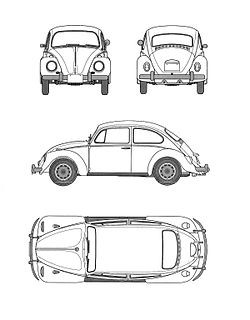
Four views.
Though extremely successful in the 1960s, experiencing its greatest sales growth in North America between 1960 and 1965, the Beetle was increasingly faced with stiff competition from more modern designs globally.
As the 1960s came to a close, Volkswagen faced increasingly stiff competition from European cars as well. Volkswagen's attempts to boost the power of their air-cooled motor to meet the demands of higher highway speeds in the late 1960s, then comply with new pollution control regulations, caused problems for reliability and fuel efficiency that impaired the reputation of the aging design. Safety issues with the Beetle came under increasing scrutiny, culminating in the 1972 release of a rather scathing report. During the early 1970s, sales of the Beetle in Europe and North America plummeted.
The over-reliance on a single model, now in decline, meant that Volkswagen was in financial crisis by 1974. It needed German government funding to produce the Beetle's replacement.
Production of the Beetle continued in smaller numbers at other German factories until 19 January 1978, when mainstream production shifted to Brazil and Mexico: markets where low operating cost was an important factor. After this shift in production, sales in Europe did not stop, but became very low. Beetle sedans were produced for U.S. markets until July 1977 and for European markets until 1985, with other companies continuing to import cars produced in Mexico after 1985. The Beetle convertible/Cabriolet ended production (as 1979 models) on 31 January 1980.
Production in Brazil ended in 1986, then started again in 1993 and continued until 1996.
The Beetle outlasted most other cars which had adopted the rear-engine, air-cooled layout such as those by Subaru, Fiat and General Motors. Porsche's 356 series which originally used some Volkswagen-sourced parts, continued to use the classic rear-engine layout (which later became water cooled) in the Porsche 911 996 series, which remains competitive in the third decade of the 21st century.
Worldwide end of production.
The final original Type 1 VW Beetle (n. 21,529,464) rolled off the production line at Puebla, Mexico, on 30 July 2003, 65 years after its original launch. This last Beetle, nicknamed El Rey (Spanish for "The King" after a legendary Mexican song by José Alfredo Jiménez) was delivered to the company's museum in Wolfsburg, Germany.
To celebrate the occasion, Volkswagen marketed a final, special series of 3,000 Beetles marketed as "Última Edición" (Final Edition) in light blue (Aquarius Blue) or beige (Harvest Moon Beige). Each car included the 1.6 engine, whitewall tires, a CD player with four speakers, chrome bumpers, trim, hub caps and exterior mirrors, a Wolfsburg emblem above the front trunk's handle, an all-cloth interior, chrome glove box badge, body coloured wheels, tinted glass, a rear parcel shelf and VW Última Edición plaque.
A mariachi band serenaded production of the last car. In Mexico, there was an advertising campaign as a goodbye for the Beetle. In one of the ads was a very small parking space on the street and many big cars tried to use it, but could not. After a while, a sign appears in that parking space saying: "es increíble que un auto tan pequeño deje un vacío tan grande" (It is incredible that a car so small can leave such a large void). Another depicted the rear end of a 1954 Beetle (the year Volkswagen was established in Mexico) in the left side of the ad, reading "Erase una vez..." (Once upon a time...) and the last 2003 Beetle in the right side, reading "Fin" (The end). Other ads also had the same nostalgic tone.
In 1951, Volkswagen prototyped a 1.3 L diesel engine. Volkswagen made only two of these naturally aspirated, air-cooled boxer diesel engines and installed one engine in a Type 1 and another in a Type 2. The diesel Beetle was time tested on the Nürburgring and achieved 0–100 km/h (0–62 mph) in 60 seconds.
Design
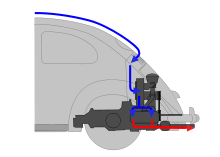
Illustration of the Beetle's engine air cooling and exhaust systems.
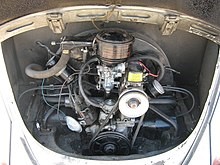
1962 Volkswagen Beetle Engine.
The Beetle featured a rear-located, rear-wheel drive, air-cooled four-cylinder, boxer engine in a two-door bodywork featuring a flat front windscreen, accommodating four passengers and providing luggage storage under the front bonnet and behind the rear seat — and offering a coefficient of drag of 0.48; to this relatively good Cd, the also streamlined rear of car was of help. The bodywork attached with eighteen bolts to its nearly flat platform chassis which featured a central structural tunnel. Front and rear suspension featured torsion bars along with front stabilizer bar — providing independent suspension at all wheels. Certain initial features were subsequently revised, including mechanical drum brakes, split-window rear windows, mechanical direction-indicators and the non-synchronized gearbox. Other features, including its distinctive overall shape, endured. In fact, the Beetle was prized for its seemingly unchanged appearance and marketed to American consumers as the anti-GM and Ford: 'we do not believe in planned obsolescence. We don't change a car for the sake of change.'"
Its engine, transmission and cylinder heads were constructed of light alloy. An engine oil cooler (located in the engine fan's shroud) ensured optimal engine operating temperature and long engine life, optimized by a thermostat that bypassed the oil cooler when the engine was cold. Later models featured an automatic choke. Engine intake air passed through a metallic filter, while heavier particles were captured by an oil bath. After 1960, steering featured a hydraulic damper that absorbed steering irregularities.
Indicative of the car's utilitarian design, the interior featured painted metal surfaces, a metal dash consolidating instruments in a single, circular binnacle, adjustable front seats, a fold-down rear seat, optional swing-out rear windows, front windows with pivoting vent windows, heating via air-to-air exchange manifolds operating off the engine's heat and a windshield washer system that eschewed the complexity and cost of an additional electric pump and instead received its pressurization from the car's spare tire (located in the front luggage compartment) which was accordingly overinflated to accommodate the washer function.
Throughout its production, VW marketed the Beetle with a four-speed manual transmission. From 1961 (and almost exclusively in Europe), VW offered an optional version of the Saxomat semi-automatic transmission: a regular 4-speed manual transaxle coupled to an electromagnetic clutch with a centrifugal clutch used for idle. Subsequently, (beginning in 1967 in Europe and 1968 in the United States), VW offered an optional semi-automatic transmission (marketed as Automatic Stick Shift and also called AutoStick), which was a 3-speed manual coupled to an electro-pneumatic clutch and torque converter.
While the overall appearance of the Beetle changed little over its life span, it received over 78,000 incremental changes during its production.
Evolution and design changes.
Beetle cabriolet
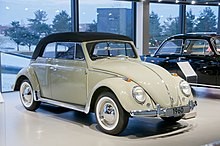
1960 VW 1200 Cabriolet.
It was in 1948 that Wilhelm Karmann first bought a VW Beetle sedan and converted it into a four-seated convertible. After successfully presenting it at VW in Wolfsburg the Beetle Cabriolet began production in 1949 by Karmann in Osnabrück.
The convertible was more than a Beetle with a folding top. To compensate for the strength lost in removing the roof, the sills were reinforced with welded U-channel rails, a transverse beam was fitted below the front edge of the rear seat cushion and the side cowl-panels below the instrument panel were double-wall. In addition, the lower corners of the door apertures had welded-in curved gussets and the doors had secondary alignment wedges at the B-pillar.
The top was cabriolet-style with a full inner headliner hiding the folding mechanism and crossbars. In between the two top layers was 1 in (25 mm) of insulation. The rear window was tempered safety glass and, after 1968, heated. Due to the thickness of the top, it remained quite tall when folded. To enable the driver to see over the lowered top, the inside rearview was mounted on an offset pivot. By twisting the mirror 180 degrees on a longitudinal axis, the mirror glass would raise approximately 2 in (5.1 cm).
The convertible was generally more lavishly equipped than the sedan with dual rear ashtrays, twin map pockets, a visor vanity mirror on the passenger side, rear stone shields,and, through 1969, wheel trim rings. Many of these items did not become available on other Beetles until the advent of the optional "L" (Luxus) Package of 1970.
After a number of stylistic and technical alterations made to the Karmann cabriolet, (corresponding to the many changes VW made to the Beetle throughout its history), the last of 331,847 cabriolets came off the production line on 10 January 1980.
1950–1959 models.
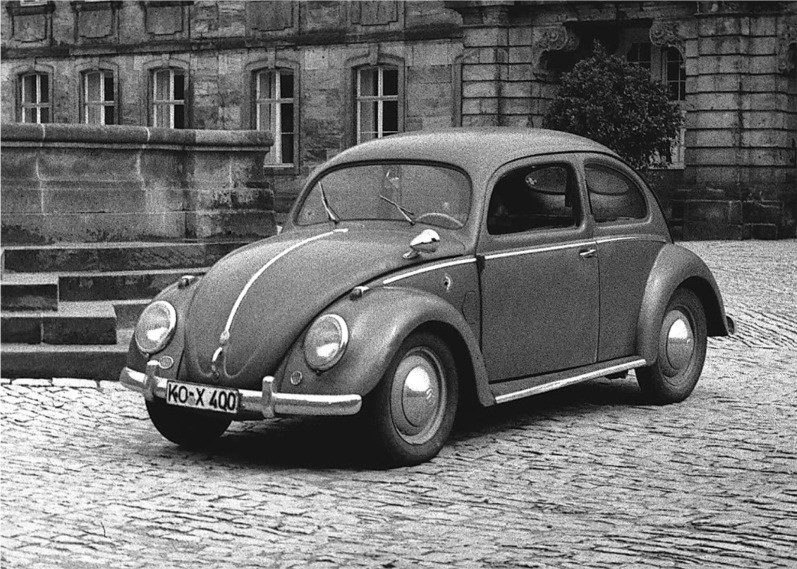
VW Export, Bj. 1951 in Bayreuth.
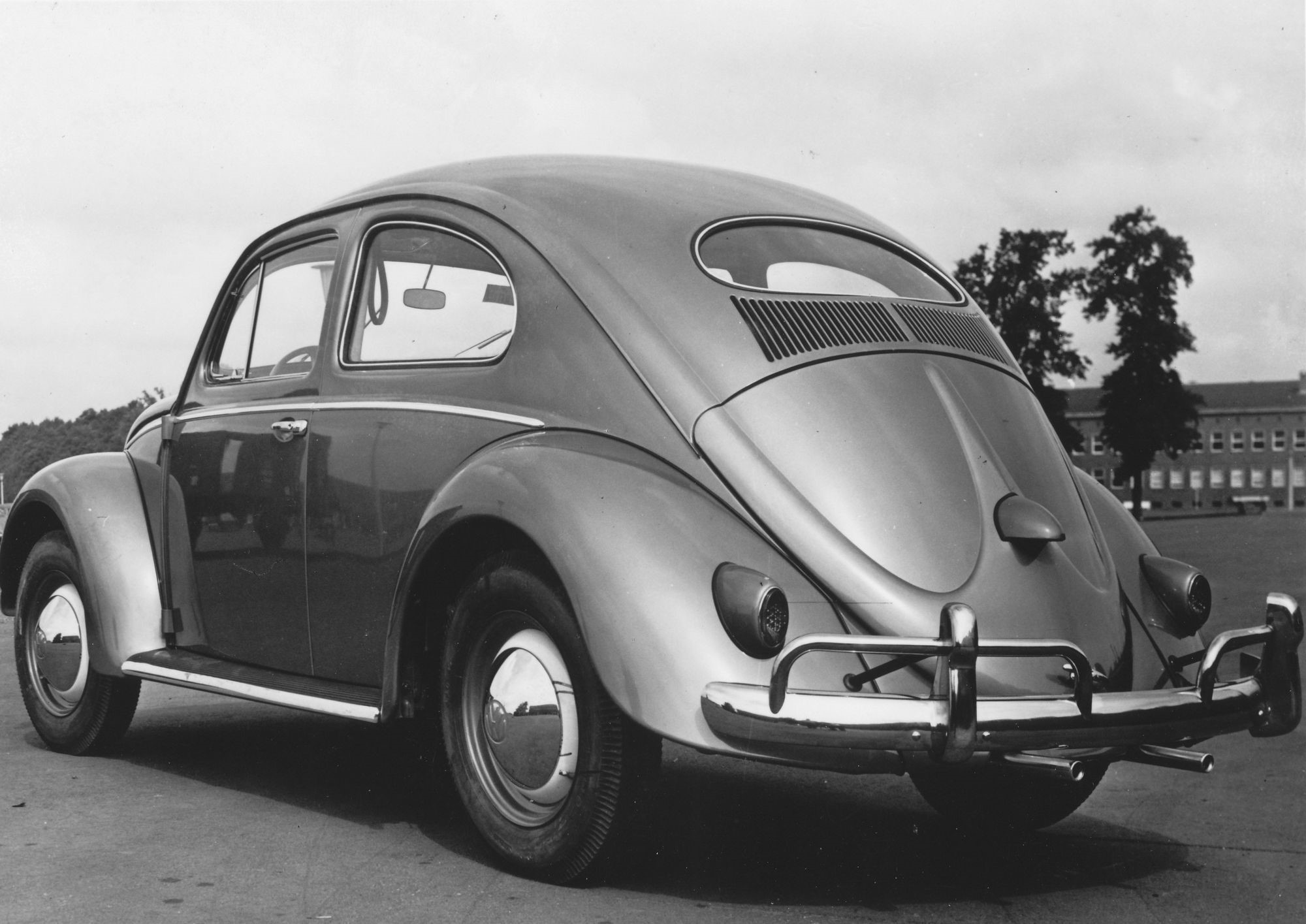
VW 1955.
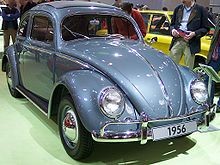
1956 Volkswagen Beetle.
During this period, myriad changes were made throughout the vehicle beginning with the availability of hydraulic brakes and a folding fabric sunroof in 1950. The rear window of the VW Beetle evolved from a divided or "split" oval, to a singular oval. The change occurred between October 1952 and March 1953. Beetles built during this time were known as a "Zwitter", or "hybrid", as they used the split-window bodyshell with oval-model chrome trim, vent windows and dashboard.
1953 models received a redesigned instrument panel. The one-piece "Pope's Nose" combination license plate/brake light was replaced by a smaller flat-bottomed license plate light. The brake light function was transferred to new heart-shaped lamps located in the top of the taillight housings.
In 1954, Volkswagen added 2 mm (0.079 in) to the cylinder bore, increasing the displacement from 1,131 (1100) cc to 1,192 (1200) cc. This coincided with upgrades to various key components including a redesign of the crankshaft. This increased power from 30 hp (22 kW; 30 PS) to 36 hp (27 kW; 36 PS) and improved the engine's free revving abilities without compromising torque at lower engine speeds. At the same time, compression ratios were progressively raised as, little by little, the octane ratings of available fuel was raised in major markets during the 1950s and 1960s.
In 1955, the separate brake lights were discontinued and were combined into a new larger taillight housing. The traditional VW semaphore turn signals were replaced by conventional flashing directional indicator lamps for North America.
For 1956, the Beetle received what would become one of its more distinctive features, a set of twin chrome tailpipes. Models for North America gained taller bumper guards and tubular overrider bars.
For 1958, the Beetle received a revised instrument panel and a larger rectangular rear window replaced the previous oval design.
1960–1969 models.
1960 models received a front anti roll bar along with hydraulic steering damper.
For 1961, significant technical advances occurred in the form of a new engine and transmission. The engine remained at 1,192 cc (1.2 L; 72.7 cu in) but the power increased to 40 bhp (41 PS; 30 kW) at 3900 rpm and 88 N⋅m (65 lb⋅ft) at 2400 rpm of torque primarily due to an increase in compression ratio to 7.1:1. The single-barrel Solex carburetor received an electric automatic choke and the transmission was now synchronized on all forward gears. The traditional semaphore turn signals were replaced by conventional flashing directional indicators worldwide. The standard model called the TYPE 111–112, continued to use the 36 hp 1200 engine of the old architecture that dates back to Franz Reimspiess original design of 1937 all the way until the end of the 1965 model year. 1965 standard model in 1965 is called the "A" sedan.
For 1962, the Beetle received a mechanical fuel level gauge in place of the former fuel tap. The Standard model continued without a gas gauge until the end of the 1965 model year. At the rear, larger tail lights were introduced incorporating a separate amber turn signal section to meet new European standards (these turn signals remained red in the US market until 1973). The former hand-pump style windscreen washer was replaced by a new design using compressed air. A Schrader valve located on the washer fluid tank allowed the system to be charged at a filling station to the recommended 35 psi (2.4 bar).
1964 models could be identified by a widened light housing on the engine lid over the rear license plate, however the standard model continued to use the old teardrop style to the end of the 1965 model run.
The largest change to date for the Beetle was in 1965: the majority of the body stampings were revised, which allowed for significantly larger windows. The windshield increased in area by 11% and was now slightly curved, rather than flat. Door windows increased accordingly by 6% (and door vent window edges were canted slightly back), rear side windows 17.5% and the rear window 19.5%. The result was a more open, airy, modern look.
For 1966, the big news was an optional new 1300cc 50 hp (37 kW; 51 PS) engine in lieu of the previous 1200cc engine that had been the sole engine since 1954. Models so equipped carried a "1300" badge on the engine lid. The 1300cc engine was standard for North America.
For 1967, a yet-again larger-displacement engine was made available: 1500cc, 53 hp (40 kW; 54 PS) at 4,200 rpm. 1200 and 1300 engines continued to be available, as many markets based their taxation on engine size. 1500cc Beetles were equipped with front disc brakes and were identified with a "VW 1500" badge on the engine lid. North America received the 1500 engine as standard equipment, but did not receive front disc brakes. These models were identified by a "Volkswagen" badge on the engine lid.
The rear suspension was significantly revised and included a widened track, softer torsion bars and the addition of a unique Z-configuration equalizing torsion spring. On US, UK and Ireland models, the generator output was increased from 180 to 360 watts and the entire electrical system was upgraded from 6 to 12 volts. The clutch disc also increased in size and changes were made to the flywheel. New equipment included a driver's armrest on the door and locking buttons on both doors. Safety improvements included two-speed windscreen wipers, reversing lights (in some markets) and a driver's side mirror. In accord with the newly enacted US Federal Motor Vehicle Safety Standard 108, North American models received a dual-circuit brake system, the clear glass headlamp covers were deleted; the headlamps were brought forward to the leading edge of the front fenders and the sealed-beam units were exposed and surrounded by chrome bezels. In the rest of the world markets the 1967 model retained the older headlights. Another oddity of the 1967 North American market Beetle is the rear bumper overriders (towel rails) – the overriders have a different shape than the older models besides the one-year only engine decklid. The Brazilian market model (Volkswagen Fusca) retained the pre-1967 headlamps until 1972.
1968 was a year of major change. The most noticeable of which were the new larger, higher mounted C-section bumpers. At the rear, new larger taillamps were adopted and were able to accommodate reversing lamps, which were previously separate bumper-mounted units. Beetles worldwide received the '67 North American style vertical headlamp placement, but with replaceable-bulb headlamps compliant with ECE regulations rather than the US sealed beams. Other improvements were a new outside gas filler with spring-loaded flap, eliminating the need to open the trunk to refuel. The fuel gauge was integrated with the speedometer and was now electrically actuated rather than cable-operated. The windscreen washer was now pressured by the spare tire, which was to be maintained at a pressure of 42 psi (2.9 bar). A pressure valve in the connecting hose closed airflow to the fluid reservoir if spare tire pressure fell below 30 psi (2.1 bar), which was above the recommended pressures for the road tires. A ventilation system was introduced, which drew fresh air into the cabin from louvres on the front decklid. For improved shifting, the shift lever was shortened, stiffened and moved rearward by 78 mm (3.1 in).
A new 3-speed semi-automatic transmission with torque converter and vacuum-operated clutch became available mid-production year. The semi-automatic models received a vastly improved semi-trailing-arm rear suspension (also known as "independent rear suspension" although the earlier swing axle Beetles were also independent) and eliminated the need for the equalizing torsion spring. This new rear suspension layout would eventually become an option on later models. Beetles equipped with the automatic were identified with a "VW Automatic" badge on the engine lid and a matching decal in the rear window. In North America, the badging and decal were later revised to read, "Automatic Stick Shift".
For 1969, the only exterior change was the fuel filler flap no longer had a finger indentation due to a new interior-mounted fuel door release. For North America, the Beetle received a heated rear window, day/night mirror and the semi-trailing, independent suspension with double jointed swing axles as standard equipment. In other markets, manual transmission models retained a swing axle independent suspension which would continue until the end of German Beetle production.
1970–1979 models.
In 1970, a new "L" (Luxus) Package was introduced including, among other items, twin map pockets, dual rear ashtrays, full carpeting, a passenger-side visor vanity mirror and rubber bumper moldings. The optional 1500 cc engine now came with an engine lid having two rows of cooling louvers, while the convertible's engine lid gained two additional sets for a total of four. For North America, the 1500 cc engine was enlarged to 1600 cc engine and produced 57 hp (43 kW; 58 PS).
There were two Beetles for the first time in 1971, the familiar standard Beetle and a new, larger version, different from the windscreen forward. All Beetles received an engine upgrade: the optional 1500 cc engine was replaced by a 1600 cc with twin-port cylinder heads and a larger, relocated oil cooler. The new engine produced 60 hp (45 kW; 61 PS). The ventilation system was improved with the original dash-top vents augmented by a second pair aimed directly at the driver and passenger. For the first time the system was a flow-through design with crescent-shaped air exits fitted behind the rear quarter windows. Airflow could be increased via an optional 2-speed fan. The standard Beetle was now badged as the VW 1300; when equipped with the 1600 engine, it was badged 1300 S, to avoided confusion with the Type 3, which wore VW 1600 badges.
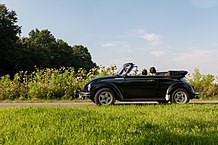
Beetle 1303 Cabriolet (aftermarket wheels).
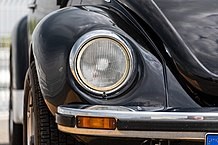
Detail.
The new, larger Beetle was sold as the 1302/1302 S, offering nearly 43% more luggage capacity, up from 140 liters in front to 260 (remaining at 140 in back). A new MacPherson strut front suspension was incorporated, similar to what was used in the Type 4 and the front track was widened. The new suspension layout allowed the spare tire to be positioned flat under the trunk floor. Although the car had to be lengthened slightly to accomplish this, it allowed a reduction in turning radius. To gain additional trunk volume, the under-dash panel was lowered, allowing the fuel tank to be shifted rearward. From the windscreen back the big Beetle was identical to its smaller progenitor, except for having the also new semi-trailing arm rear suspension as standard equipment. Overall, the bigger Beetle was 50 mm (2.0 in) longer, 35 mm (1.4 in) wider and rode on a 20 mm (0.79 in)-longer wheelbase. Both Beetles were available with or without the L Package. The convertible was now based on the 1302 body. In North America, the 1302 was marketed as the Super Beetle and came only with the L Package and 1600 cc engine. While it lacked the front disc brakes that normally accompanied the larger motor, it was fitted with brake drums that were slightly larger than the standard Beetle. With the Super Beetle being sold as the premium model in North America, the standard Beetle, while retaining the same 1600 cc engine, was stripped of many of its earlier features in order to reduce the selling price. Bright window and running board moldings disappeared, along with the day/night mirror, horn ring, map pocket, locking glove box and miscellaneous other items.
1972 models had an 11% larger rear window (40 mm [1.6 in] taller) and the convertible engine lid with four rows of louvres was now used on all Beetles. Inside the vehicle, a four-spoke energy-absorbing steering wheel was introduced, the windshield wiper/washer knob was replaced in favor of a steering column stalk and intermittent wipers were a new option available in selected markets. An engine compartment socket for the proprietary VW Diagnosis system was also introduced. The rear luggage area was fitted with a folding parcel shelf.
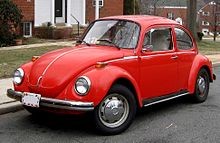
1973 1303 / Super Beetle.
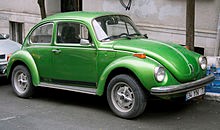
1973–74 1303/Super Beetle "Big".
1973 models featured significantly enlarged "elephant foot" taillamps mounted in reshaped rear fenders. In the engine bay, the oil-bath air cleaner gave way to a dry element filter and the generator was replaced with an alternator. The 1302/Super became the 1303 with a new taller wrap-around windscreen. The changes to the cowl and windshield resulted in slight redesign of the front hood. The instrument panel, formerly shared with the standard Beetle, was all-new and incorporated a raised speedometer pod, rocker-style switches and side-window defrosters. The limited-edition GSR (Gelb-Schwarzer Renner; German for "Yellow-Black Racer") was a 1303 S available only in Saturn Yellow paint equipped with special 5.5 in (140 mm) wide sport wheels fitted with 175/70-15 Pirelli Cinturato CN36 high-performance radial tires. Front and rear deck lids were finished in matte black, as was all exterior trim with the exception of the chrome headlamp bezels. Inside were corduroy and leatherette high-bolstered sport seats and a small diameter three-spoke steering wheel with padded leather rim and a small red VW logo on the bottom spoke.
For 1974, North American models received newly required 5 mph (8.0 km/h) impact bumpers mounted on self-restoring energy absorbers, which added approximately 25 mm (0.98 in) to the car's overall length. On the Super Beetle, the steering knuckle and consequently the lower attachment point of the strut, was redesigned to improve handling and stability in the event of a tire blowout. A limited-edition Big Beetle was introduced based on the 1303 LS. Available in unique metallic paint colors, the car featured styled-steel 5.5 in (140 mm) wide sport wheels wrapped in 175/70-15 Pirelli Cinturato CN36 tires, corduroy seat inserts, upgraded loop-pile carpet, wood-look instrument panel trim and a padded steering wheel with bright accents. In the North American market, a limited-edition Sun Bug was introduced as a standard Beetle or Super Beetle. Both were finished in metallic gold and featured styled-steel 4.5 in (110 mm)-wide sport wheels. Inside were brown corduroy and leatherette seats, loop-pile carpet and padded four-spoke deluxe steering wheel. The Super Beetle Sun Bug included a sliding-steel sunroof. Mid-year, the Love Bug was introduced for North America: based on the standard Beetle, it was available only in Phoenix Red or Ravenna Green (both colors shared with the VW-Porsche 914) with all exterior trim finished in matte black. A price leader, the Love Bug retailed for less than a standard Beetle.
In 1975, front turn indicators were moved from the top of the front fenders down into the bumper. At the rear, the license plate light housing was now molded of plastic with a ribbed top surface. To comply with tightening emission standards, the 1600 cc engine in Japanese and North American markets received Bosch L-Jetronic fuel injection, rather than the D-Jetronic system formerly used in the VW Type 3 and Type 4. The injected engine received a new muffler and in California a catalytic converter. This necessitated a bulge in the rear apron under the rear bumper and replaced the distinctive twin "pea shooter" tailpipes with a single offset pipe, making injected models identifiable at a glance. 5 mph (8.0 km/h) bumper-equipped North American models retained fender-top front indicators. The 1303 received rack and pinion steering.
In 1976, the 1303/La Grande Bug was discontinued, with the larger body continuing only in convertible form. To make up for the loss in North American markets, the standard Beetle was upgraded, regaining some of the features that were removed in 1971. In addition, the 2-speed ventilation fan was included, previously available in North America only on the larger Beetle. The automatic stickshift option was discontinued as well.
1977 models received new front seats with separate head restraints. This was the final model year for the Beetle sedan in North America. The convertible was offered in a "triple white" Champagne Edition in Alpine White with white top and interior with the padded deluxe steering wheel, tiger maple wood-grain dash trim and 4.5 in (110 mm) wide sport wheels. Approximately 1,000 Champagne Editions were produced.
For 1978, a new Champagne 2nd Edition convertible was launched, available in blue or red metallic paint with white leatherette interior. Features included the 4.5 in (110 mm) wide styled steel sport wheels, AM/FM radio, analog quartz clock, padded deluxe steering wheel and rosewood-grain instrument panel trim. Approximately 1,100 were produced.
In 1979, VW offered an Epilogue Edition of the convertible in triple black with features similar to the 1978 Champagne Edition. This would be the last year of convertible production worldwide as well as the final year for the Beetle in the US and Canada.
International production.
German production of the Beetle took place initially at the parent Wolfsburg plant until the Golf's introduction in 1974, later expanding to the newer Emden and Hanover plants. Volkswagen's takeover of Auto Union in 1964 saw 60,000 cars per year being produced on the Audi assembly lines in Ingolstadt until 1971. The last German made cars were assembled at Emden in 1978, after which the Puebla, Mexico plant became the principal source of Beetle production. Other countries produced Beetles from CKD (complete knockdown kits): Ireland, Thailand, Indonesia, South Africa, Australia, Yugoslavia (city of Sarajevo) and Nigeria have assembled Beetles under license from VW.
Beetles produced in Mexico and Brazil had several differences:
Brazil
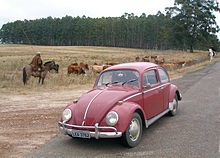
1969 Brazilian 1300 Sedan (Fusca).
Brazilian assembly of the Beetle, where it is called "Fusca", started in 1953, with parts imported from Germany. By January 1959 the cars were built in the new São Bernardo do Campo plant, although they originally had 60% German parts content. By the mid-sixties, the cars had 99.93% Brazilian parts content, with four German parts of a combined value of about one US dollar still being imported. Production continued until 1986. In 1993 production resumed and continued to 1996. The Brazilian version retained the 1958–64 body style (Europe and U.S. version) with the thick door pillars and smaller side windows. This body style was also produced in Mexico until 1971. Around 1973, all Brazilian Beetles (1300 and 1500 series) were updated with the 1968-up sheet metal, bumpers and four-lug rims; although the five-stud rims and "bugeye" headlights were produced as late as 1972 (the base VW 1200 and 1300 manufactured in Brazil was similar to the 1964 European/U.S. 1200 until the 1970 model year but came with vented wheels since the mid-1960s). The 1971 and 1972 1300s had the 1964-era taillights and headlights, fuel tank, but fitted with the 1968-up raised bumpers. Brazilian CKD kits were shipped to Nigeria between 1975 and 1987 where Beetles were locally assembled. The Brazilian-produced versions have been sold in neighboring South American nations bordering Brazil, including Argentina, Uruguay and Peru.
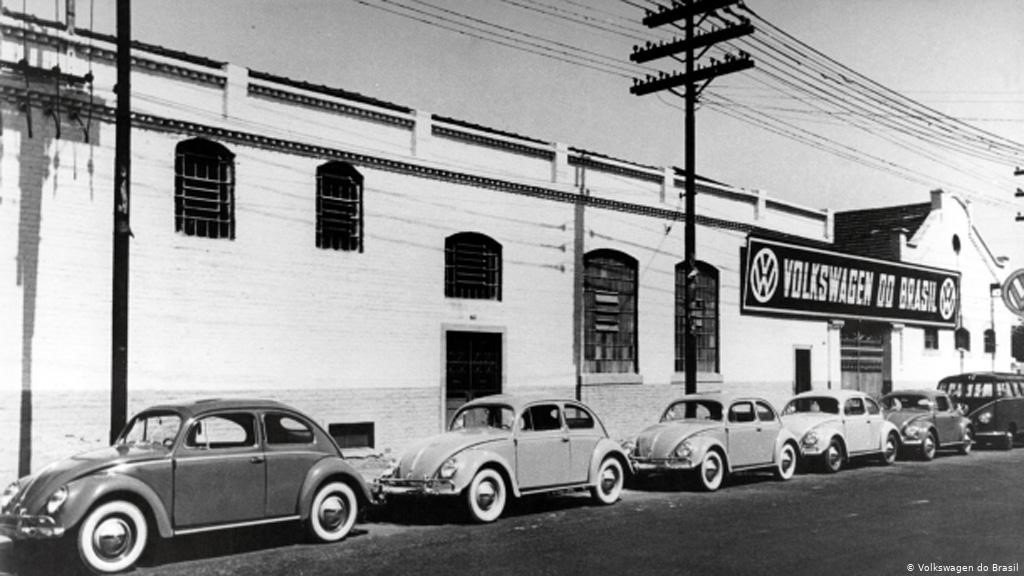
The Brazilian Type 1s have four different engines: 1,200 cc, 1,300 cc, 1,500 cc and 1,600 cc. In the 1970s, Volkswagen made the SP-2 (derived from the Type 1 pan and the Type 3 powertrain) with a 1,700 cc engine (a bored-out 1,600 cc). In Brazil, the Type 1 never received electronic fuel injection, instead retaining carburetors (one or two one-barrels) throughout its entire life, although the carburetion differs from engines of different years and specification.
The production of the air-cooled engine finally ended in 2006, after more than 60 years.
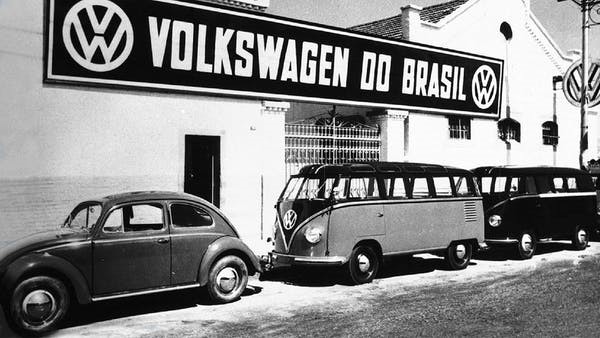
It was last used in the Brazilian version of the VW Bus, called the "Kombi" and was replaced by a 1.4 L water-cooled engine with a front-mounted cooling system. Volkswagen do Brasil engaged in some string pulling in the early sixties when a law requiring taxis to have four doors and five seats was being considered. After proving that the average taxi fare only carried 1.8 passengers and an overall saving of twenty percent for a smaller two-door car, the Brazilian government relented and the law never entered the books. The Fusca proceeded to have a long career as a taxi in urban Brazil.
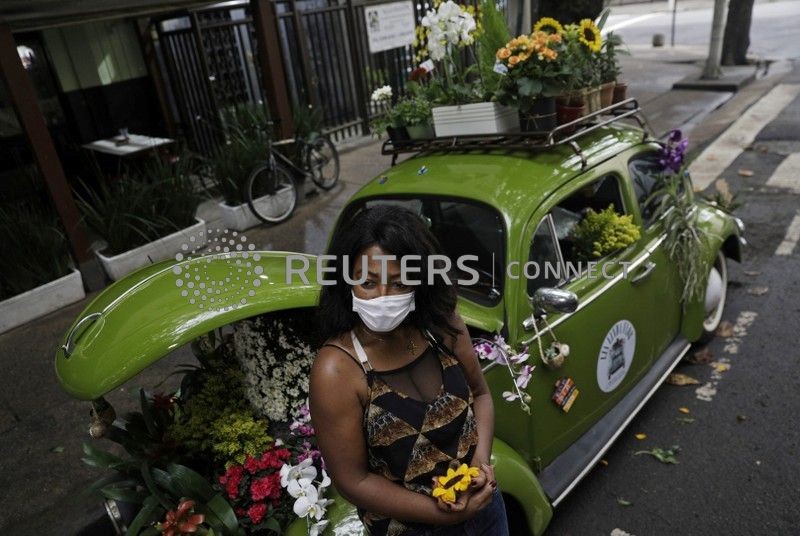
Valcineia Machado, also known as Roberta, poses by her car which she transformed to a mobile flower shop after losing her business amid the coronavirus disease (COVID-19) outbreak, in Rio de Janeiro, Brazil, October 8, 2020. Picture taken on October 8, 2020. REUTERS/Ricardo Moraes.
Mexico
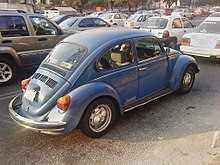
1995 Mexican Volkswagen Beetle, the last model with chrome moldings. In the picture, the 1995 Jeans Limited Edition.
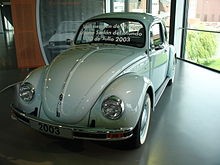
The last Volkswagen Beetle (in Aquarius Blue) produced, manufactured in Puebla, Mexico, 30 July 2003.
Volkswagen Beetle in Mexico.
Mexican production began in 1955 because of agreements with companies such as Chrysler in Mexico and the Studebaker-Packard Corporation which assembled cars imported in CKD form. In 1964, they began to be locally produced. These models have the larger windshield, rear window, door and quarter glass starting in 1972; and the rear window from 1965 to 1971 German built models was used on the Mexican models from 1972 to 1985, when it was replaced with the larger rear window used on 1972 and later German built Beetles. This version, after the mid-1970s, saw little change with the incorporation of electronic ignition in 1988, an anti-theft alarm system in 1990, a catalytic converter in 1991 (as required by law), as well as electronic Digifant fuel injection, hydraulic valve lifters and a spin-on oil filter in 1993. The front turn signals were located in the bumper instead of the Beetle's traditional placement on top of the front fenders from the 1977 model year on, as they had been on German Beetles sold in Europe from 1975 onwards. Starting in 1995, the Mexican Beetle included front disc brakes, an alternator instead of a generator and front automatic seat belts. During the 1995 model year, the chrome moldings disappeared leaving body colored bumpers and black moldings instead on some models. By the start of the 1996 model year, exterior chrome or matt moldings were dropped altogether and Volkswagen de Mexico (VWdM) dropped the Sedan's flow-through ventilation system with all its fittings, notably the exterior crescent-shaped vents behind the rear side windows the same year.
In mid-1996, front drum brakes and fixed front seat belts were re-launched in a new budget version called the "Volkswagen Sedán City", which was sold alongside the upscale version "Volkswagen Sedán Clásico" which had front disc brakes, automatic seat belts, right side mirror, velour upholstery, optional metallic colors and wheel covers in matte finish (also found on some 1980s Beetles and Buses). These two versions were sold until mid 1998. From mid 1998–2003, the Sedán Clásico was discontinued and the Sedán City lost its prefix and gained disc brakes, automatic seat belts and optional metallic colors. This last version was named the "Volkswagen Sedán Unificado" or simply the "Volkswagen Sedán".
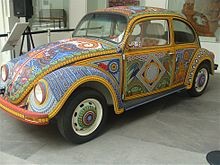
A Beetle decorated in the Huichol style of beading now on display at the Museo de Arte Popular in Mexico City.
Independent importers continued to supply several major countries, including Germany, France, and the UK until the end of production in 2003. Devoted fans of the car even discovered a way to circumvent US safety regulations by placing more recently manufactured Mexican Beetles on the floorpans of earlier, US-registered cars. The Mexican Beetle (along with its Brazilian counterpart) was on the US DOT's (Department of Transportation) hot list of grey market imports after 1978 as the vehicle did not meet safety regulations.
The end of production in Mexico can be attributed primarily to Mexican political measures: the Beetles no longer met emission standards for Mexico City, in which the ubiquitous Beetles were used as taxicabs; and the government outlawed their use as taxicabs because of rising crime rates, requiring only four-door vehicles be used. The last Vocho taxis in Mexico City were retired at the end of 2012.
However, demand for the Beetle was relatively high, especially in the 1990s, with the workforce increasing at the start of the decade. The price of the base model (without even a radio) was pegged with the official minimum wage, by an agreement between the company and the government. In 1990 it cost US$5,300.
Australia
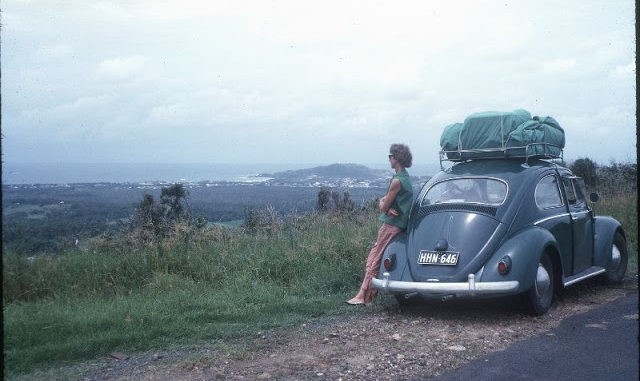
Travel around Australia. Blogspot.com.
Official importation of the Volkswagen Beetle into Australia began in 1953, with local assembly operations commencing the following year. Volkswagen Australia was formed in 1957 and by 1960 locally produced body panels were being used for the first time. When the European Type One body received the larger windows for the 1965 model year, Volkswagen Australia decided not to update, but continued to produce the smaller-windowed bodies, with unique features to the Australian versions. This was due to the limited size of the market and the costs involved in retooling. Australian content had reached almost 95% by this time. The Australian subsidiary continued to produce the earlier body style until 1967, when declining sales forced a switch to CKD assembly using imported components the following year. In 1968, Volkswagen Australia released its own locally designed utilitarian version of the Type 1, the Volkswagen Country Buggy or Type 197.
The last Australian-assembled Beetle was produced in July 1976 with assembly of other models ending in February 1977. All Volkswagens for the Australian market have been fully imported since then.
South Africa
The Beetle was also produced in South Africa at the Uitenhage plant from 31 August 1951 to 1979. Several features from the Super Beetle were grafted onto the South African Beetle 1600S, such as curved windshield, new dashboard and larger taillights, while retaining the Beetle chassis and mechanicals. The 1600 model was introduced to South Africa in 1972; it was marketed as the cheapest 1.6-liter car available there. In late 1976, the sporty SP 1600 Beetle arrived – this version received bright red, yellow, or silver paint with black stripes, a front spoiler, wide tyres and a more powerful engine with twin carburetors and a freer flowing exhaust. The interior was also sporty, with red tartan upholstery, a small steering wheel and much matte black. Power crept up to 43 kW (58 PS; 58 hp), from 50 PS. Also new for 1977 were rubber bumper strips for all 1600s and the same taillights with backup lights were now fitted across the range.
The bigger-engined model was then phased out around August 1978, leaving only the 1300 model in production.
Influence claims.
Various cars and designs have each claimed to have been the original "influencers" of Porsche's Volkswagen concept.
Béla Barényi
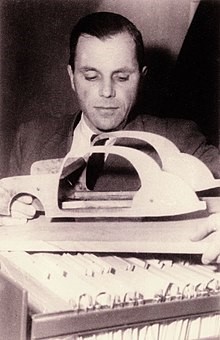
Béla Barényi
The Austro-Hungarian automotive engineer Béla Barényi is credited with designing a similarly shaped car in 1925, as early as five years before Porsche's People's car concept was unveiled.
Standard Superior
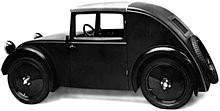
First model of the Standard Superior, as introduced at the IAMA in Berlin in 1933.
German engineer Josef Ganz designed a car, the "May Bug", that is very similar to the Volkswagen Beetle. Hitler saw the car in 1933 at an auto show. There is a strong resemblance to the Standard Superior, an automobile produced from 1933 to 1935 by Standard Fahrzeugfabrik of Ludwigsburg, Germany, founded by motorcycle maker Wilhelm Gutbrod and unrelated to the Standard Motor Company of England. These small cars were designed according to the patents by Josef Ganz and featured transverse, two-stroke, two-cylinder engines mounted in front of the rear axle. However, Porsche, two years prior to the Standard Superior's introduction, had developed the Type 12 for Zündapp, already featuring many design similarities with the Volkswagen Beetle.
Tatra.
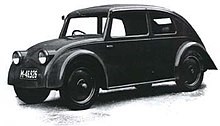
Tatra V570 prototype (1933).
The Austrian car designer Hans Ledwinka was a contemporary of Porsche working at the Czechoslovakian company Tatra. In 1931, Tatra built the V570 prototype, which had an air-cooled flat-twin engine mounted at the rear. This was followed in 1933 by a second V570 prototype with a streamlined body similar to that of the Porsche Type 32. The rear-engine, rear-wheel drive layout was a challenge for effective air cooling and during development of the much larger V8 engined Tatra 77 in 1933 Tatra registered numerous patents related to air flow into the rear engine compartment. The use of Tatra's patented air cooling designs later became one of ten issues for which Tatra filed suit against VW.
Both Hitler and Porsche were influenced by the Tatras. Hitler was a keen automotive enthusiast, and had ridden in Tatras during political tours of Czechoslovakia. He had also dined numerous times with Ledwinka. After one of these dinners Hitler remarked to Porsche, "this is the car for my roads". From 1933 onwards, Ledwinka and Porsche met regularly to discuss their designs and Porsche admitted "well, sometimes I looked over his shoulder and sometimes he looked over mine" while designing the Volkswagen. The Tatra 97 of 1936 had a 1,749 cc, rear-located, rear-wheel drive, air-cooled four-cylinder boxer engine. It cost 5,600 RM and accommodated five passengers in its extensively streamlined four-door body, which provided luggage storage under the front bonnet and behind the rear seats. It also featured a similar central structural tunnel found in the Beetle.
Just before the start of the Second World War, Tatra had ten legal claims filed against VW for infringement of patents. Although Ferdinand Porsche was about to pay a settlement to Tatra, he was stopped by Hitler who said he would "solve his problem".Tatra launched a lawsuit, but this was stopped when Germany invaded Czechoslovakia in 1938, resulting in the Tatra factory coming under Nazi administration in October 1938. The T97, along with the T57, were ordered by Hitler to be removed from the Tatra display at the 1939 Berlin Autosalon and Tatra was later directed to concentrate on heavy trucks and diesel engines, with all car models, except for the V8-engined Tatra 87, being discontinued. The matter was re-opened after World War II and in 1965 Volkswagen paid Ringhoffer-Tatra 1,000,000 Deutsche Marks in an out of court settlement.
Fedden.
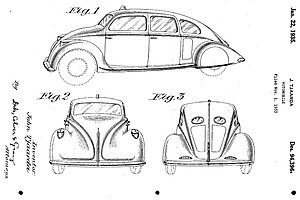
John Tjaarda's rear engine Briggs show car from 1933, patent drawings.
On Sept 28, 1943, Roy Fedden, most known by his participation in the Bristol Single Sleeve valve engine research, headed by Harry Ricardo, applied for a British patent 'Improvements related to road vehicles', granted GB570814, 24 July 1945, describing a 2-door, rear-engined car, identical in arrangement and look to VW 'Käfer'. Espacenet - Original document.
Tjaarda's 'Briggs Dream Car.'
It has also been pointed out that the VW Beetle bears a striking resemblance to John Tjaarda's 1933 design for a streamlined, rear-engined car, that he created working for Briggs Manufacturing Company. At Briggs, a Detroit-based manufacturer of automobile bodies for Ford Motor Company, Chrysler Corporation and other U.S. and European automobile manufacturers, Tjaarda was developing a radical car for Ford to use as a new Lincoln. Ford displayed the show car at the 1933–34 Century of Progress Exhibition in Chicago as the "Briggs Dream Car". One of the later designs looked almost exactly like the Beetle, if you shortened the wheelbase and took out two side windows. It is even claimed that Porsche had visited Briggs automobiles one summer, when Tjaarda was head of R&D there and several auto historians claim Porsche's People's Car was influenced by Tjaarda's designs, including the "Sterkenburg series" of the late twenties.
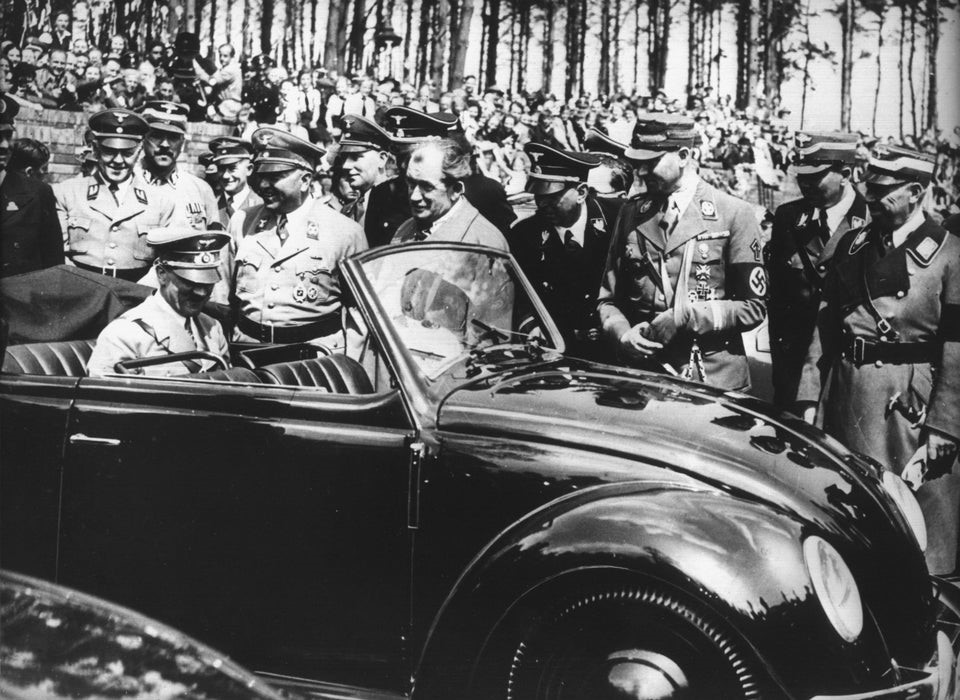
Adolf Hitler in a prototype Volkswagen Beetle, 1938.
The interesting thing about this car was it was a massive con job. Germans were told that if they saved up stamps/coupons in a book, eventually they would get this great car.
The thing was though, if you missed even a single payment, you forfeited the deal (and lost all the money you'd previously paid in), so you can imagine that people found the money, even in extreme circumstances.
Why so strict on the rules? Well the money was actually being used to fund the development of the military and there was never any intention to make the car. By the time the truth came out, the war was over and people had other things on their minds.
The car was however put into production by a British officer called Ivan Hirst, who tasked with helping rebuild the German economy, found one of the prototypes in a ruined building and used that to kick start factory production in the post-war country.
The program was called Kraft durch Freude or Strength Through Joy and the first cars were called KDF-wagons. Hitler actually sketched the iconic design of the beetle, which is kind of wild when you think about it.

Essen, Germany. 10th April, 2019. The models Vivien (left) and Alida sit at the Techno Classica for-classic cars and youngtimers in a VW Beetle cabriolet from 1950. The world fair takes place from 10th to 14th April. Credit Marcel Kusch / dpa/Alamy Live News.
One of the most enduring car designs, one still in production today, was sketched by Hitler.
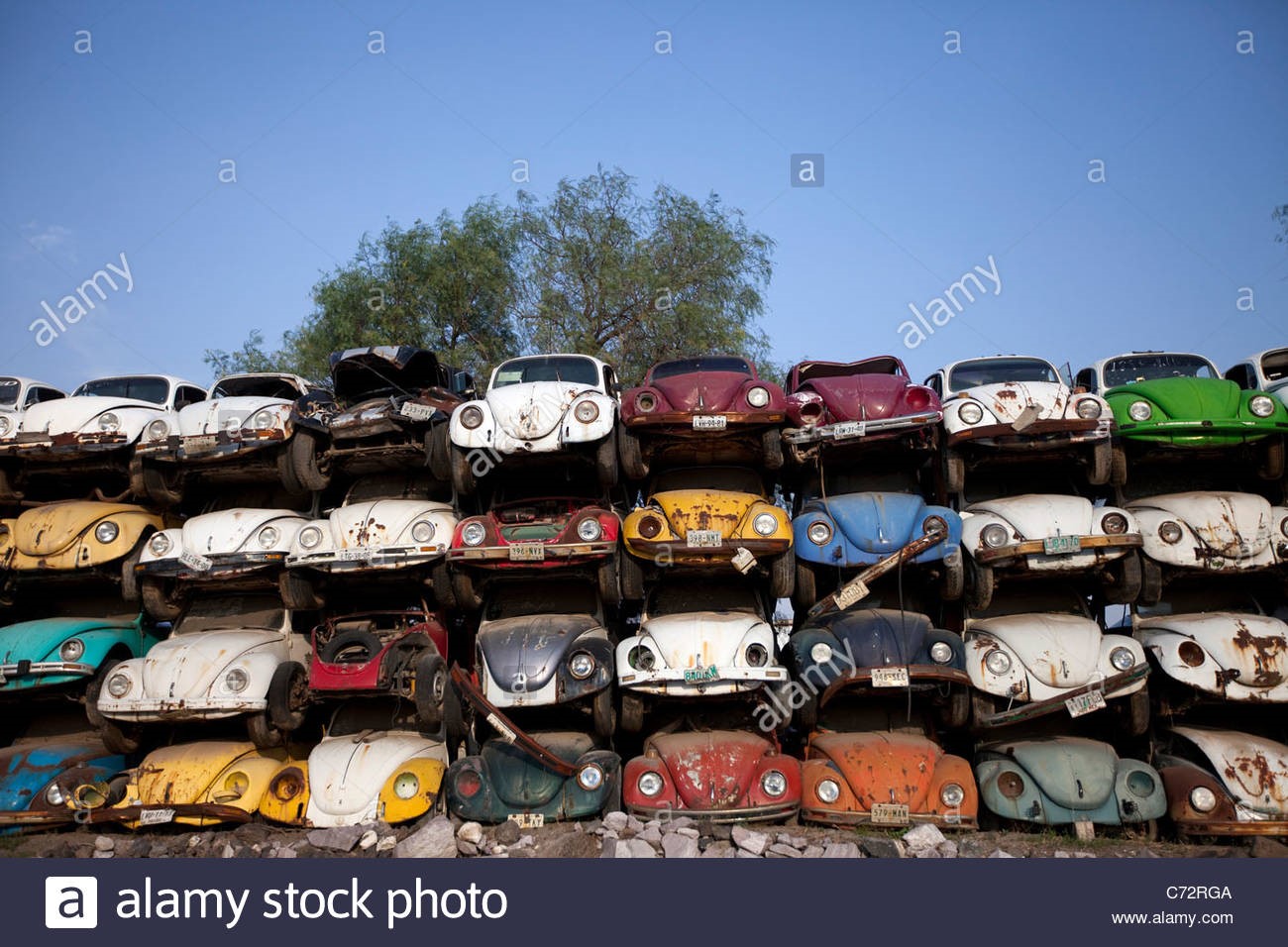
Old Volkswagen car VW Beetle seized by the government in a junkyard.
The story of the Beetle: the story of a success. The symbol of the birth of Volkswagen and the first prototype of a "car for all", the Beetle is still today, after more than eighty years, the undisputed style icon all over the world.
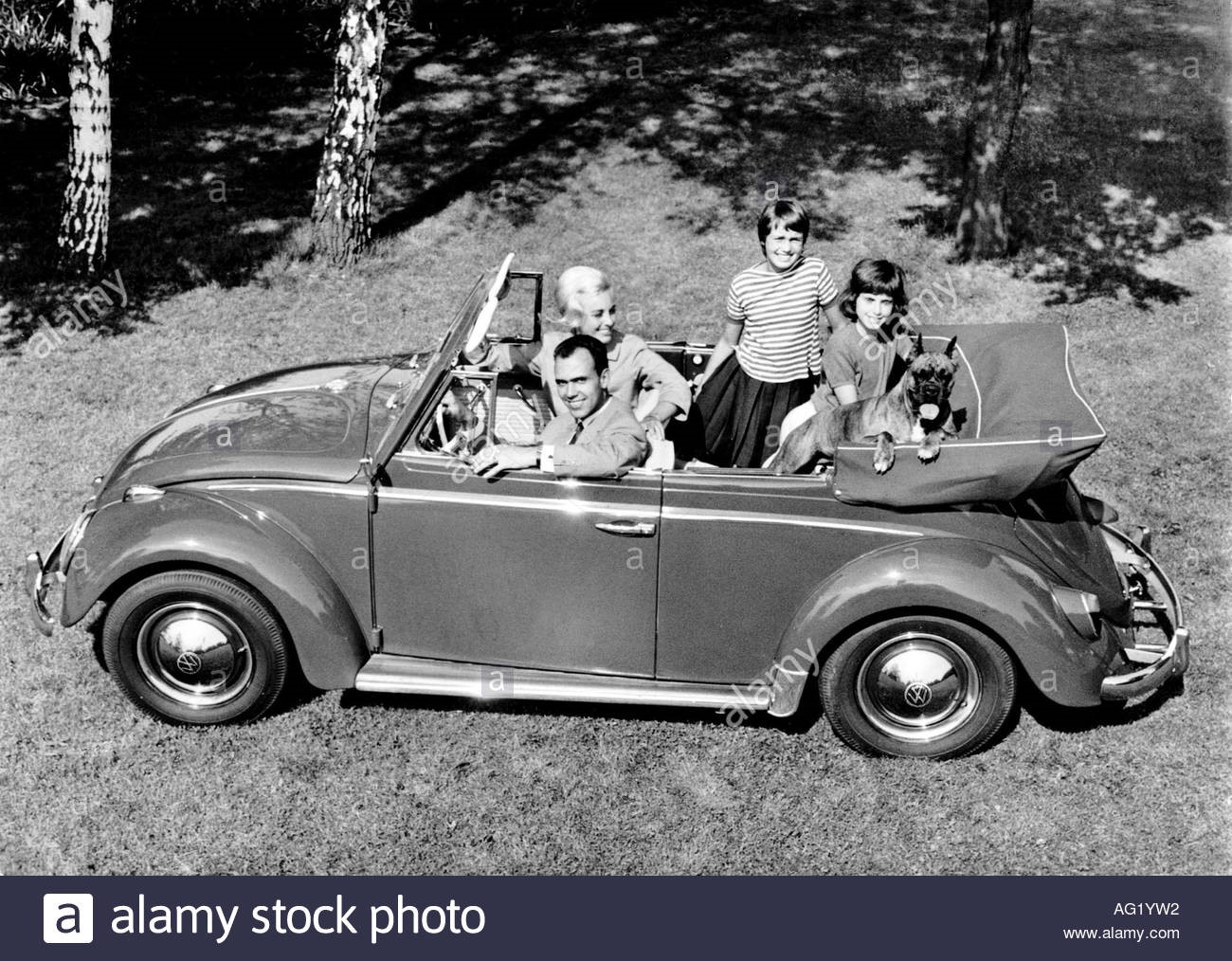
Volkswagen VW Beetle.
The car that would revolutionize the concept of mobility: the sedan and convertible called Type 1 mark the birth of a legend called the Beetle.
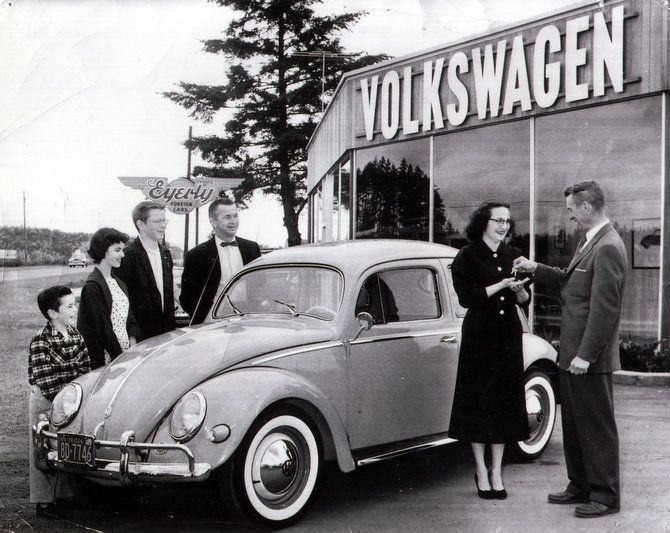
Innovations in design and mechanics were among the major ones in automotive production of the period, capable of making the Beetle the first real car within everyone's reach.
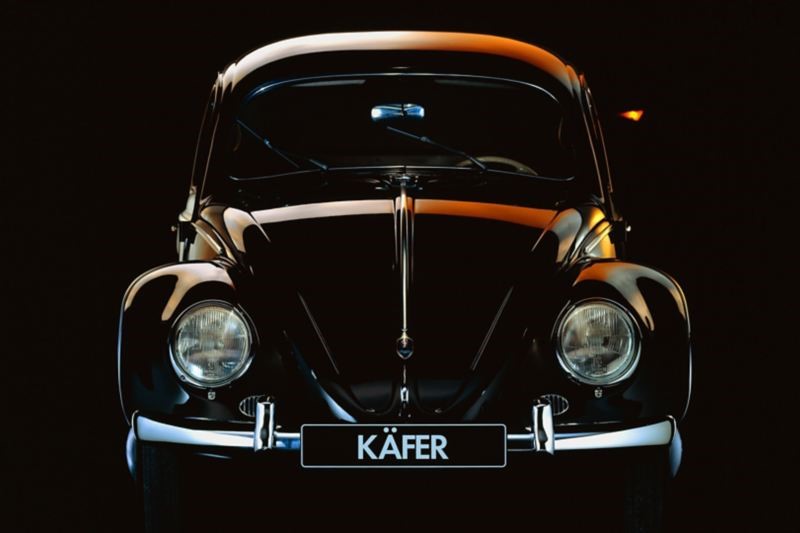
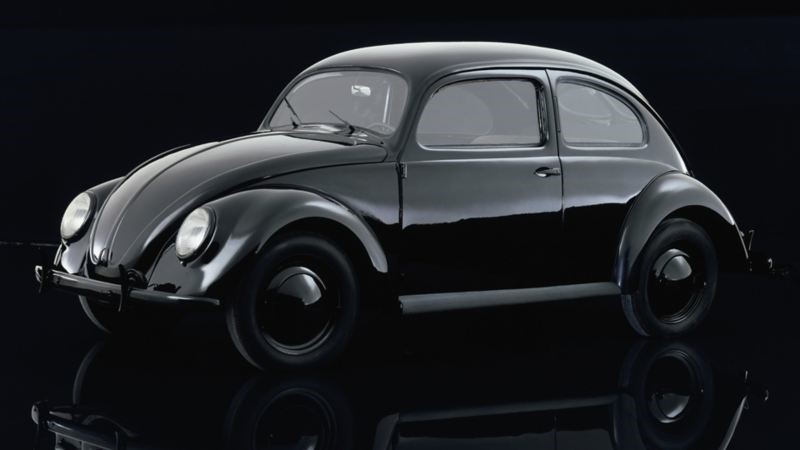
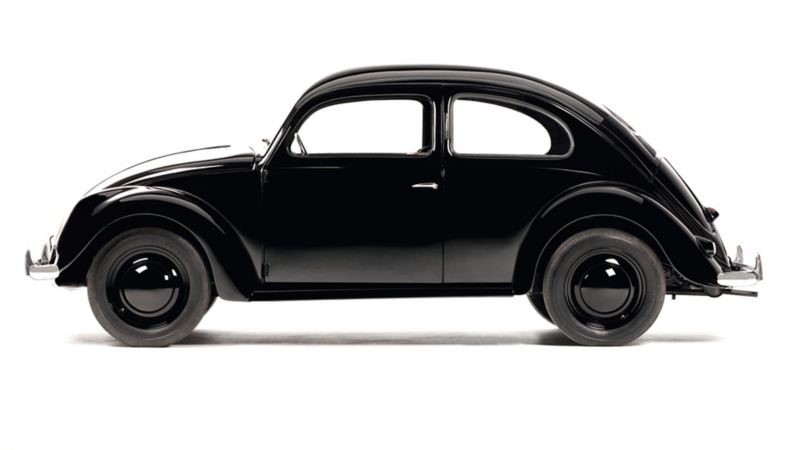
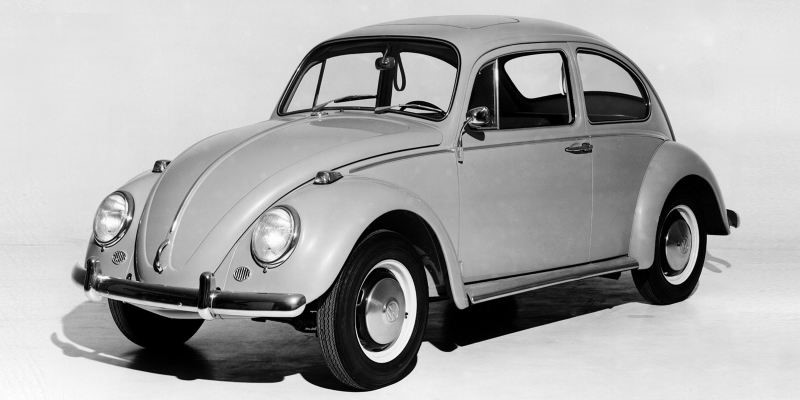
1938-1949. How a myth is born.
1938 - The first prototype.
Reliability, versatility, lightness and speed: these are the characteristics that the V3 prototype had to guarantee to the German population from all walks of life.
1948 - The people's car.
Although the post-war difficulties had greatly reduced the purchasing power of the German population, the first Beetle, which in military use had proved to be a vehicle suitable for all climatic conditions and any type of terrain, becomes the object of the everyone's desire. The first real "people's car".
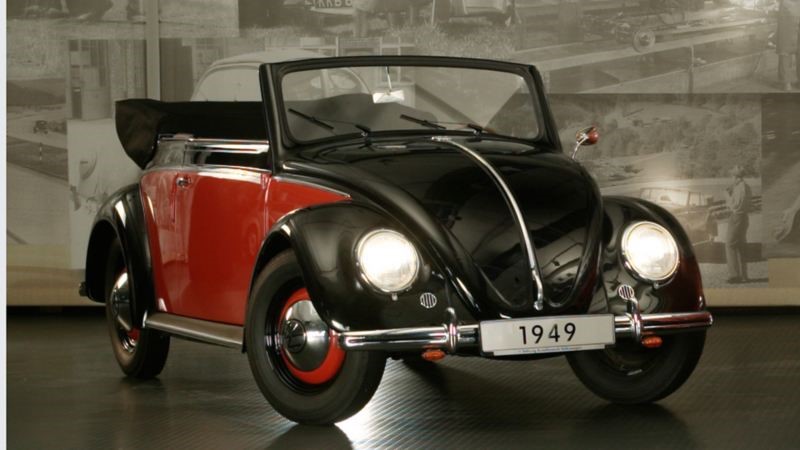
1949. The Cabriolet version arrives.
The summer of 1948 gave Volkswagen the idea of creating a version of the Type 1 with an open body, a fully openable and foldable top and a curved rear. Said and done, in the summer of the following year, Volkswagen convertible is ready for the market and sets out on the road to success.
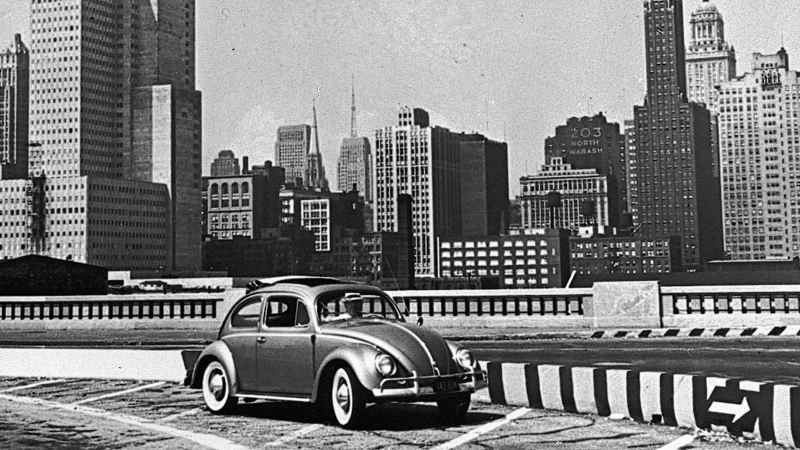
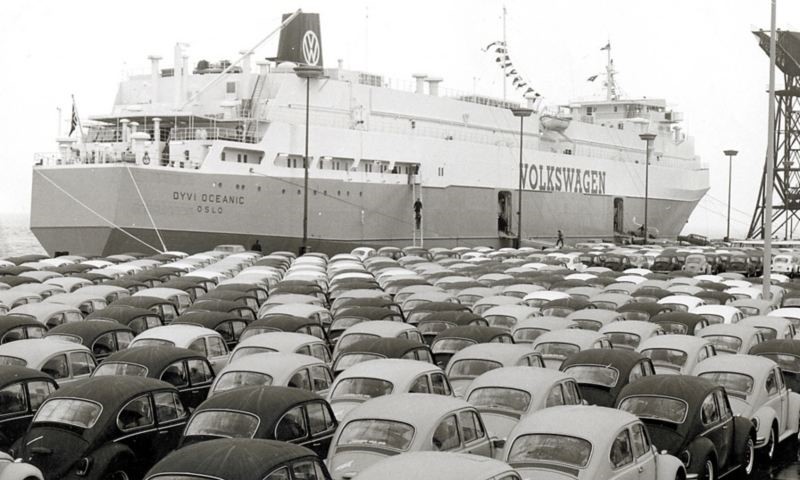
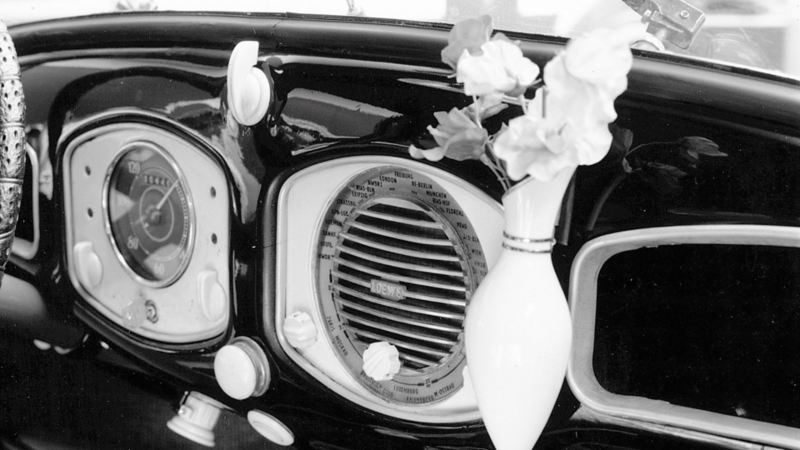
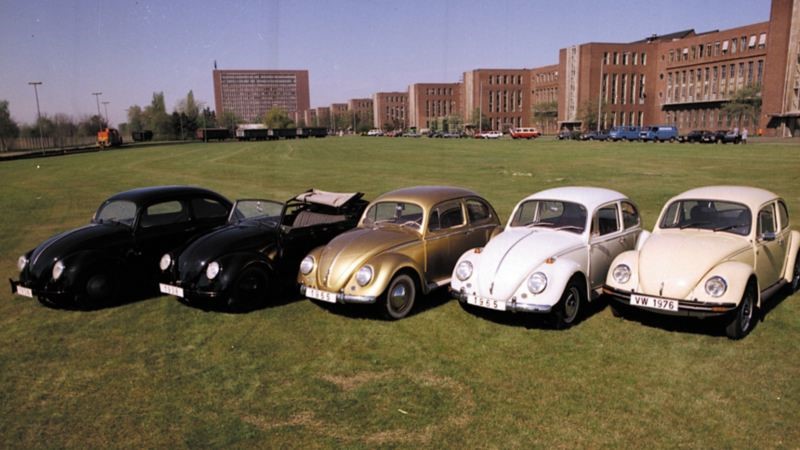
1949-1989. Growth beyond borders.
A worldwide success.
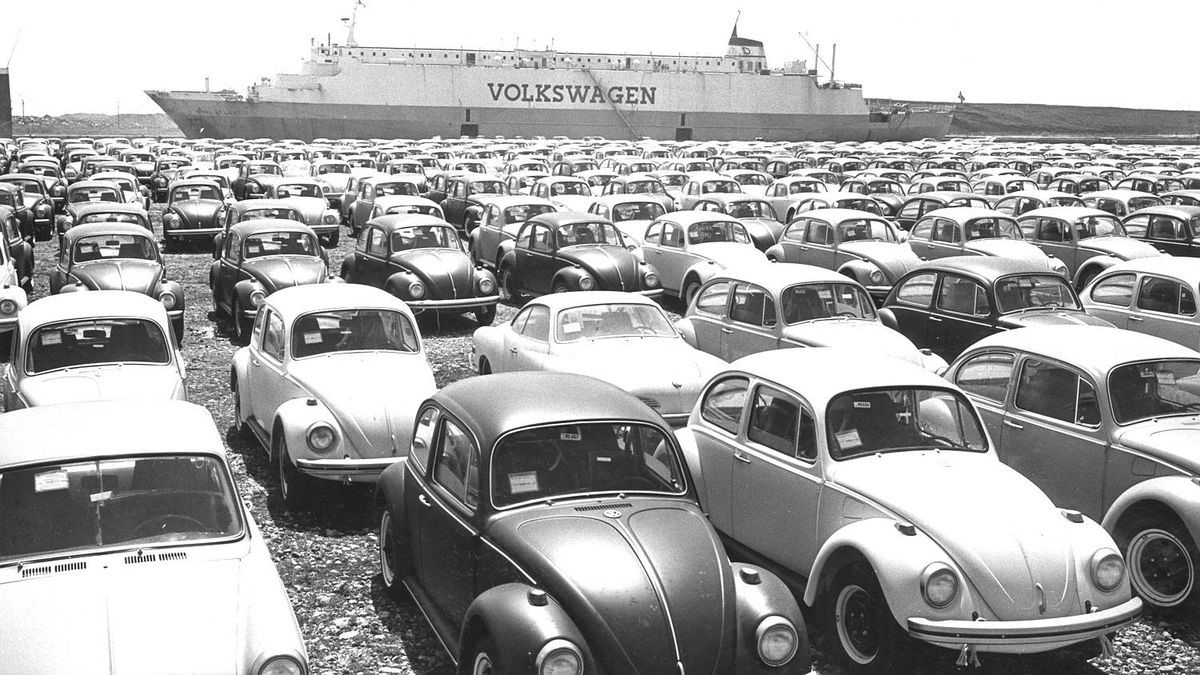
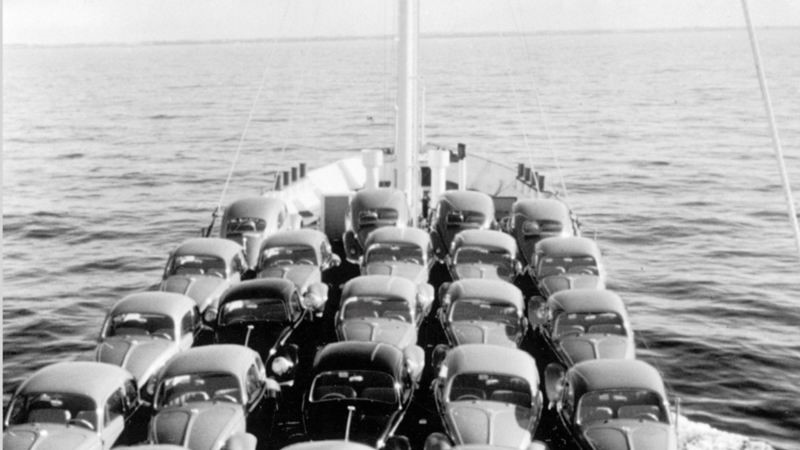
1949. Beetle in New York.
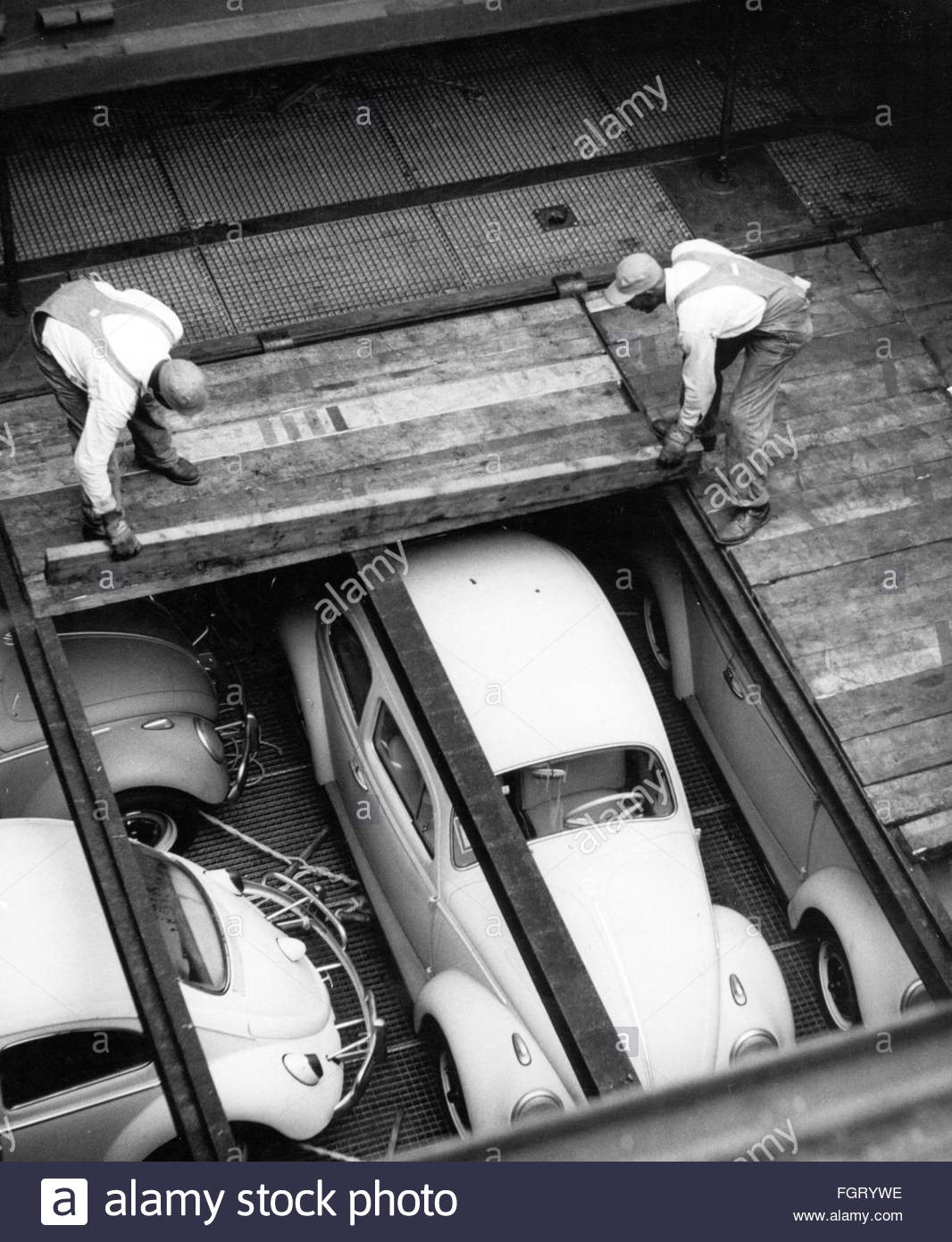
Ship cargo compartment.
For the first time, during the first days of January 1949, two Beetle models leave Europe to be presented at the German Industrial Exhibition in New York.

It is the definitive consecration of a car destined to become a cult object: the Beetle, so renamed by the New York Times, conquers the USA.
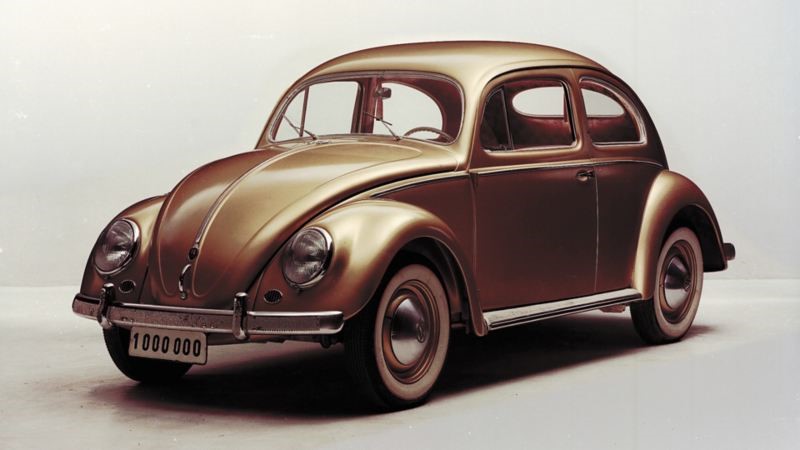
The jeweled one-millionth Type 1.
1955 - First million cars.
Volkswagen reached an important number on August 5: the millionth Beetle leaves the factory. To celebrate it properly, the model is presented in metallic gold colour, with white rubber framing the crystals, velvet and red brocade for the interiors. A true jewel of refinement and elegance.
1974 - End of an era.
After almost thirty years of success, Wolfsburg ceases to be the "city of the Beetle". The last car leaves the assembly line of the original plant to travel to Brussels and overseas.

1981. Volkswagen, an international partner.
After having completely ceased production in Germany, starting from 1981 the manufacture of the Beetle moved to Mexico where, in 1992, it reached the peak of twenty million units produced.
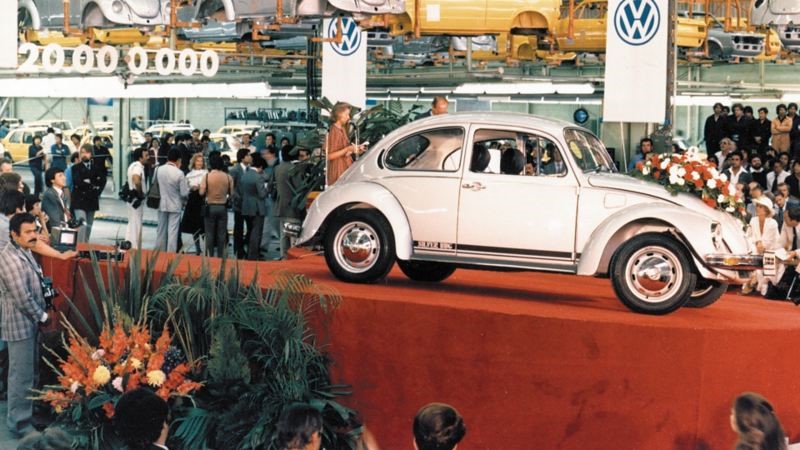
1989. The Mexican revival.
At the end of the 1980s the Beetle "reborn" in Mexico: after a slow start, sales quickly tripled thanks also to the support of the Mexican government which, reducing prices by 20%, made the Beetle the most loved car in the whole country.
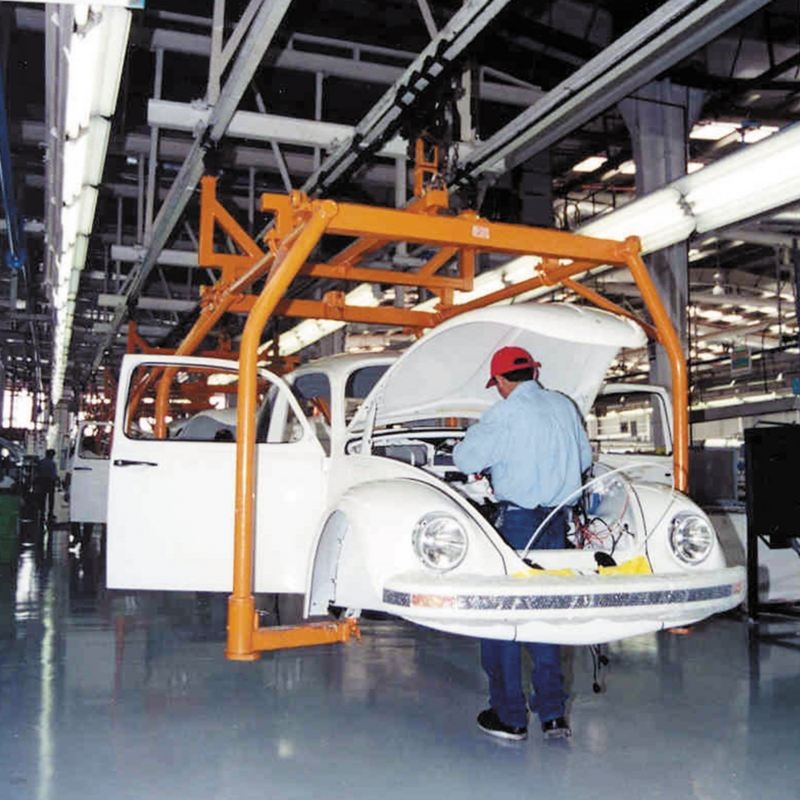
2003. The Beetle “Ultima Ediciòn”.
After more than twenty years, crowned by enormous successes for restyling and new technologies implemented on the Beetles that came out of the factory, Mexican production is about to end. The end of a century of automotive industry is greeted in the best possible way by a car that has dictated its style.
1963 - The Beetle takes to the track.
An American Volkswagen dealer, Hubert Brundage, has the idea of mounting the Beetle engine on his small racing car: from this moment the sports authorities approve the new type of sports competition car based on the Beetle. After a few visits to the USA, Ferry Porsche and his race director Huschke von Hanstein bring Formula V to Europe as well, sensing the evolution of what will prove to be an excellent idea.
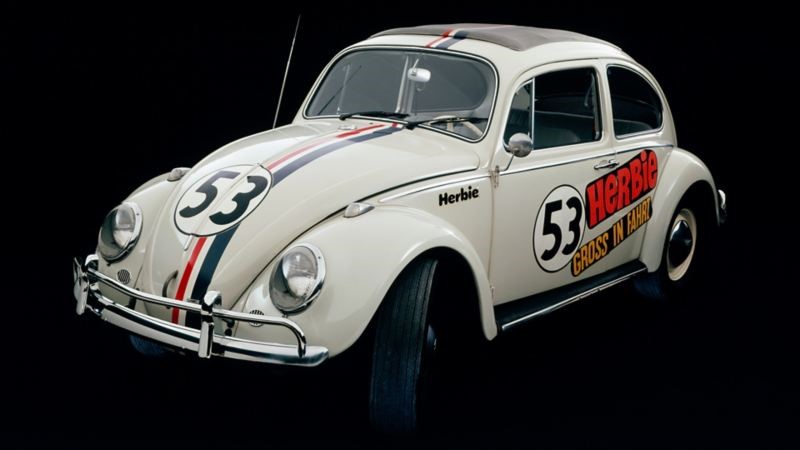
Volkswagen Herbie, the Love Bug.
In 1968, the American movie "Herbie, the Love Bug", arrives in cinemas all over the world and starts a series of films that continues until 2005. The story of a Volkswagen able to compete, organize meetings, get angry and rejoice together with its owner, goes around the world and crowns a new four-wheeled star.
1971 - Monster Bug.
The power of the Beetle is awakened in the form of a Porsche Salzburg silver-black rally car, with McPherson wishbone suspension on the front and rear axles. With professionals at the wheel the Monster Bugs, boosted to 126 HP, thrill the rally scene and, breaking all the records of its predecessors, in 1972 make the Beetle the new world champion.
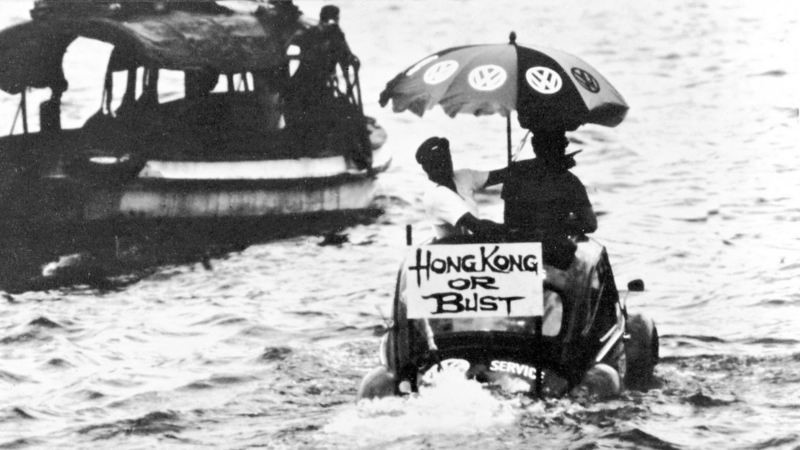
1973. A nautical Beetle.
A rampant nautical Beetle fever pushes you to venture along daring crossings. Malc Buchanan decides to challenge the rough Irish Sea, sailing in seven and a half hours from the Isle of Man to the English county of Cumberland. And it is immediately a record.
In the same year, several special Beetle models are presented: the Jeans, the Big, the "yellow-black racing car" and the City aim to relaunch the demand for the bestseller with millions of specimens to its credit, which has reached the end of its cycle of life.
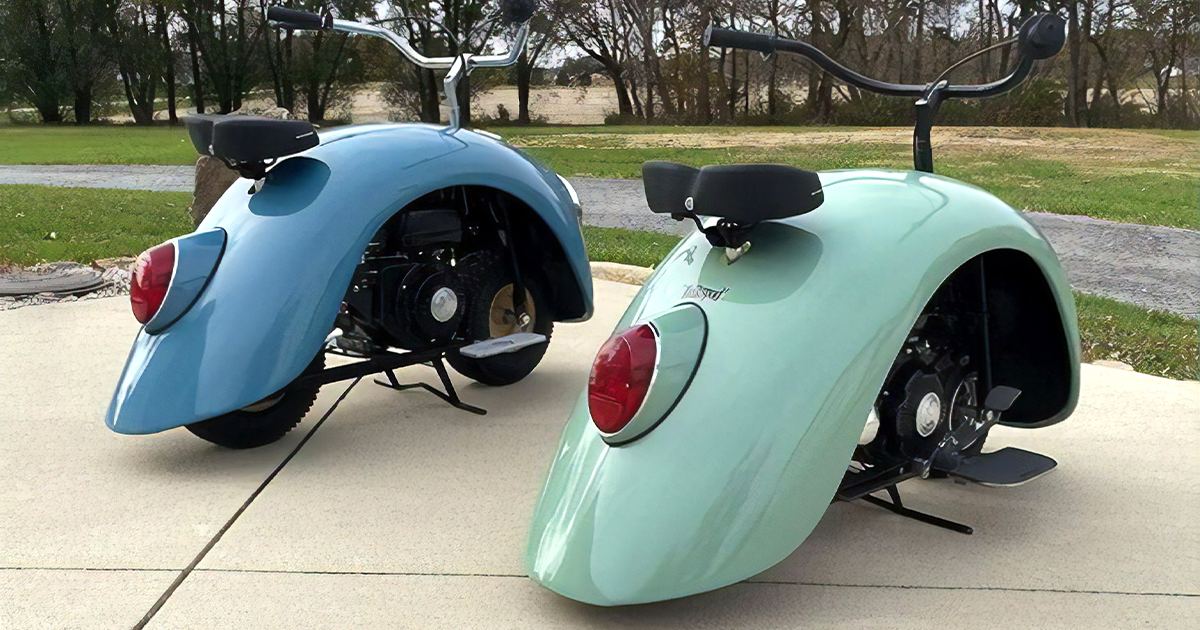
Vintage Volkswagen Beetles transformed into mini-bikes.
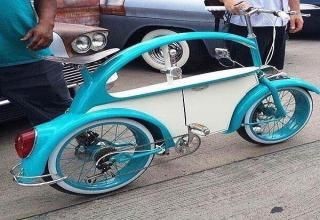
Runner, swimmer, aviator: in a word, Beetle.
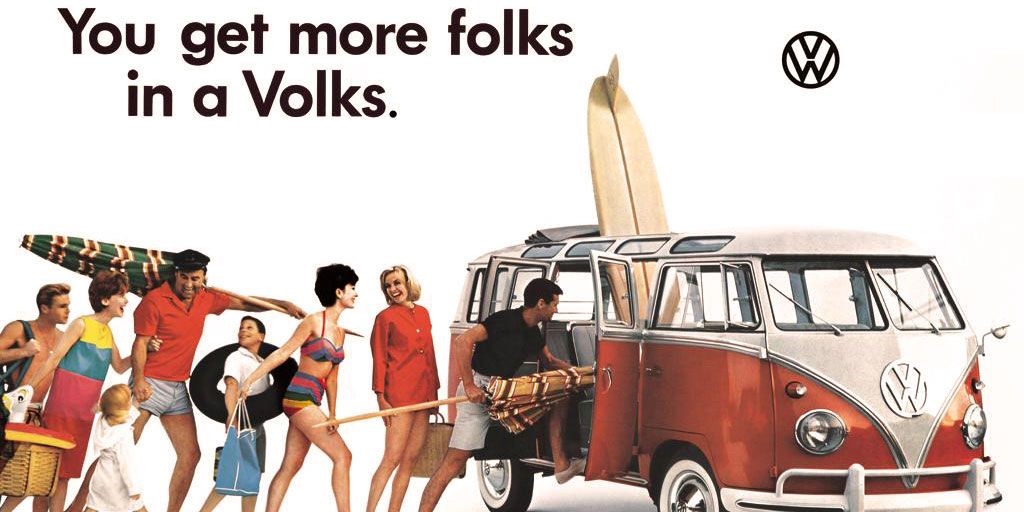
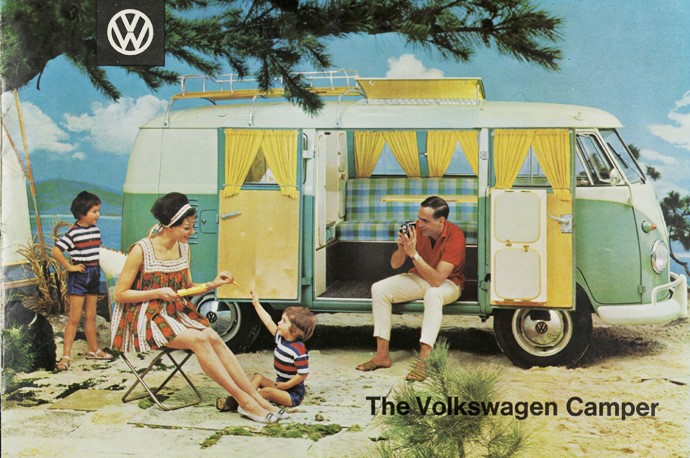
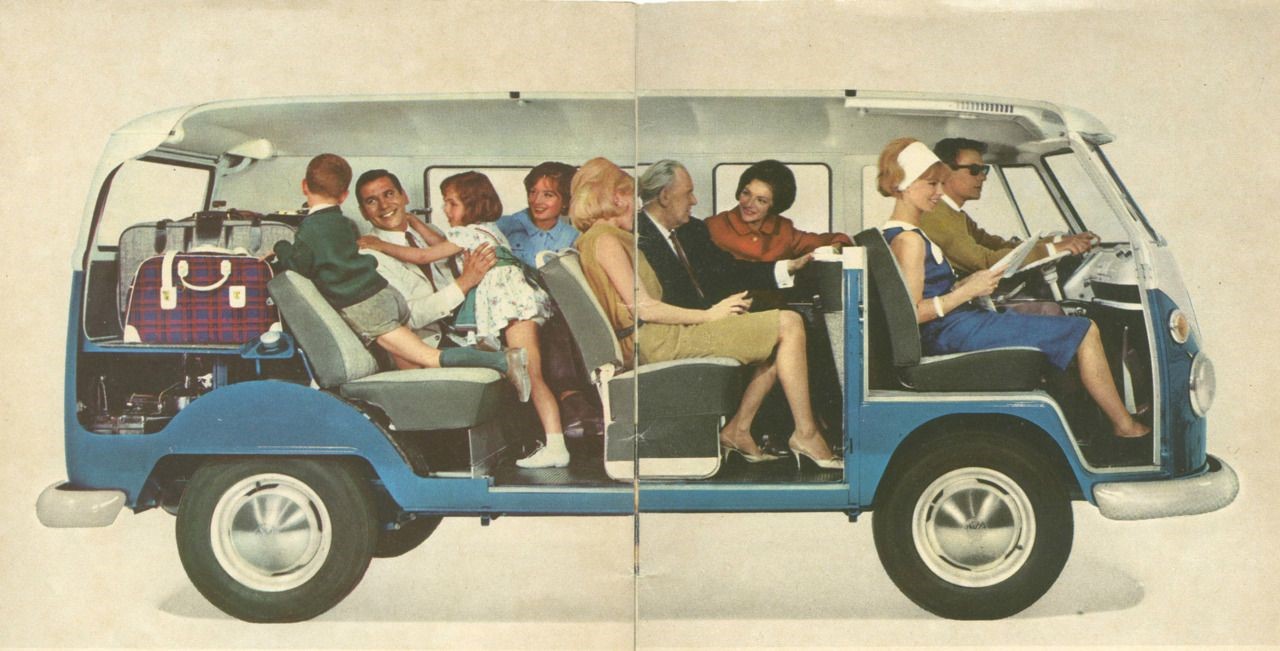
The Volkswagen Type 2, known officially (depending on body type) as the Transporter, Kombi or Microbus, or, informally, as the Bus (US) or Camper (UK), Pão de Forma (Loaf of Bread) (Portugal) is a forward control light commercial vehicle introduced in 1950 by the German automaker Volkswagen as its second car model.
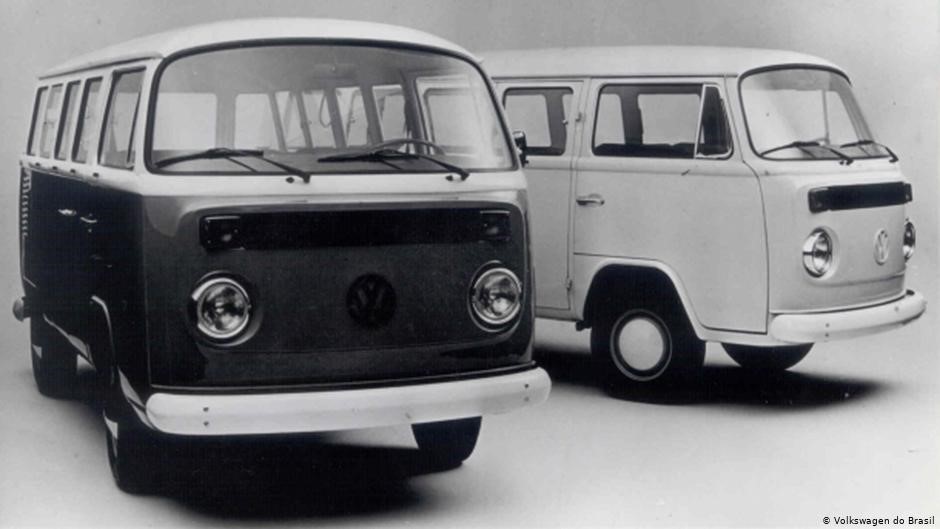
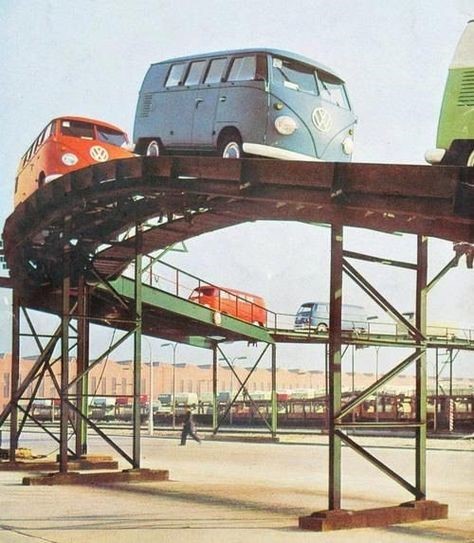
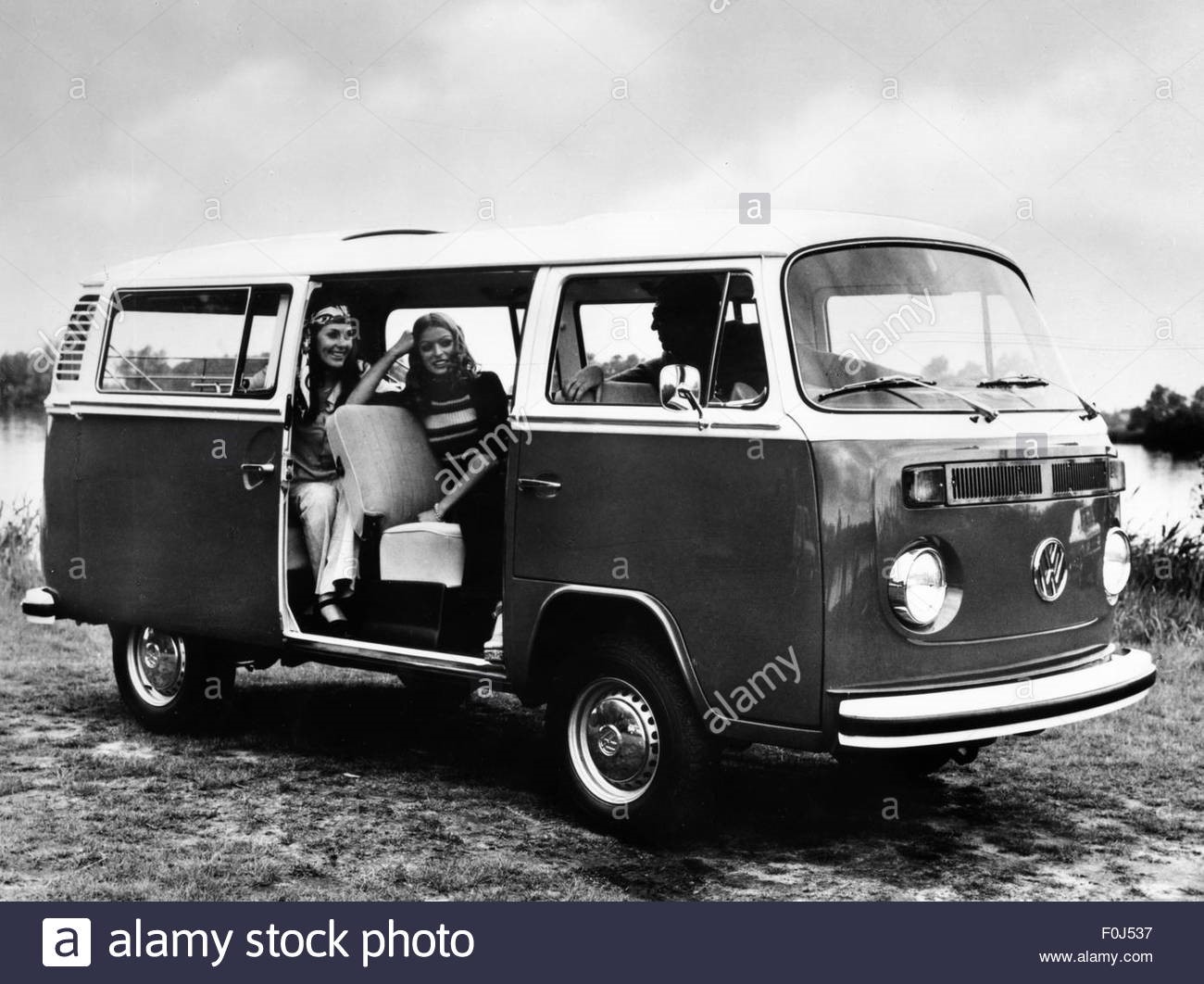
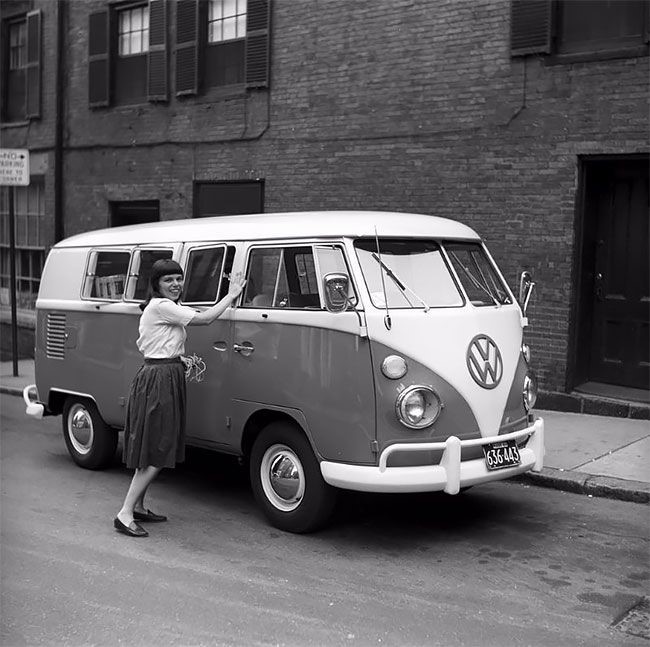
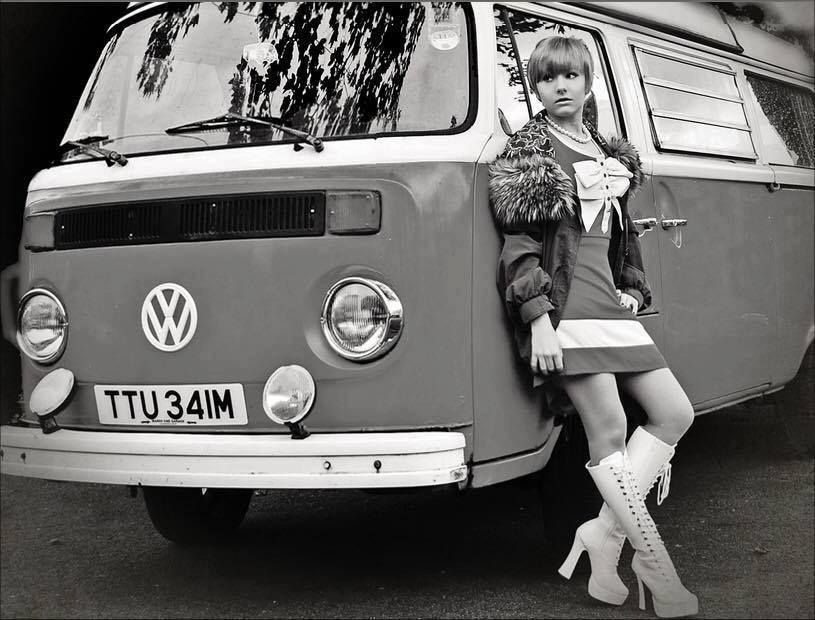
Following – and initially deriving from – Volkswagen's first model, the Type 1 (Beetle), it was given the factory designation Type 2.
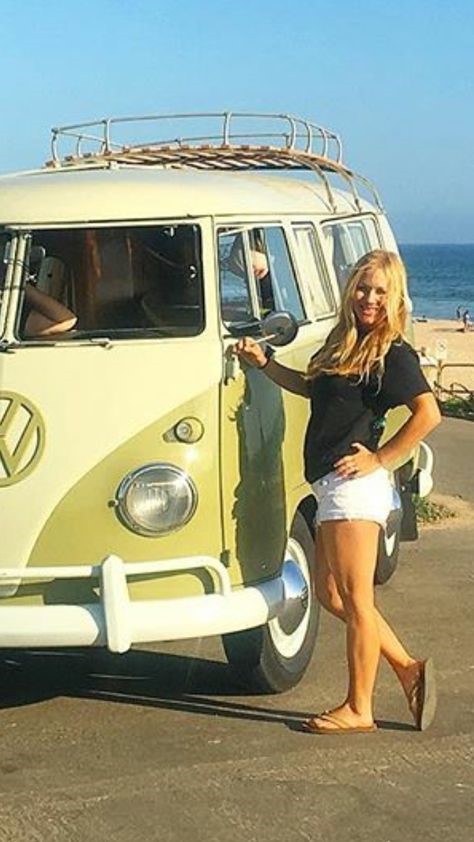
Like the Beetle, the VW Type 2 became popular with the counterculture of the 1960s, thanks to its ability to transport a large group of people while being cheap and easy to maintain. Its design was simple yet spacious, thanks largely to the rear-mounted engine.
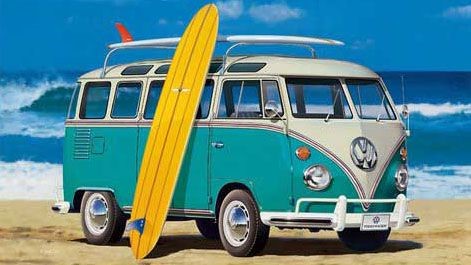
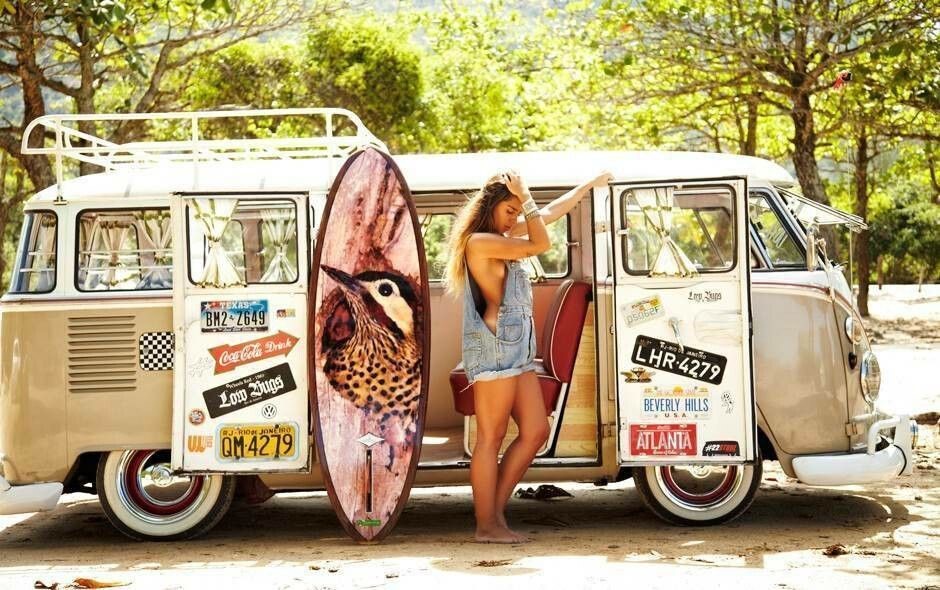
The van became popular with young people because it allowed a group to travel comfortably and was big enough to live in, so it could be used for long-distance journeys, such as to music festivals or surfing locations. It contrasted starkly with the large, low sedans that were normal at the time, giving the van an alternative and rebellious image.
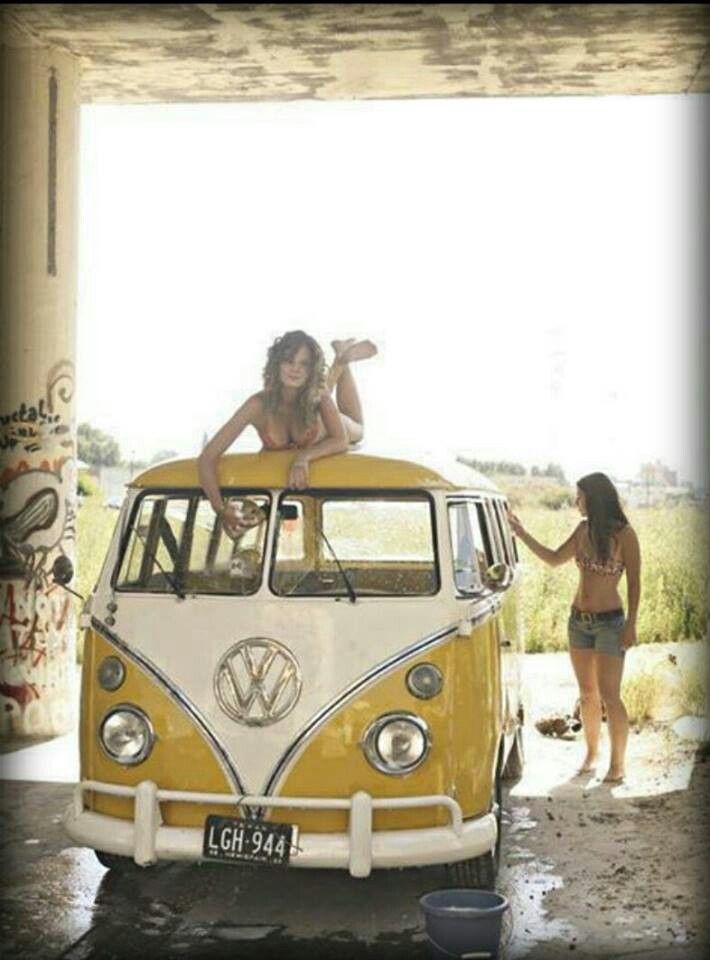
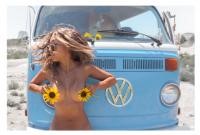


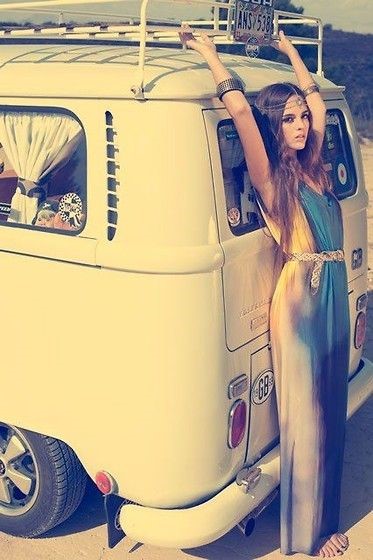
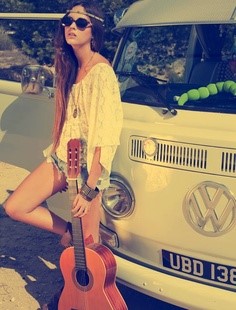


Vans were often painted with extravagant designs in bright colors, making them stand out on the road even more. The "hippie van" remains iconic today, thanks to being featured of the cover of albums by musicians such as Bob Dylan and the Beach Boys and being used by fans of the Grateful Dead while following the band on tour. But most iconic of all, the music festival Woodstock, which was held in the summer of 1969, saw plenty of brightly-painted vans transporting excited young crowds.
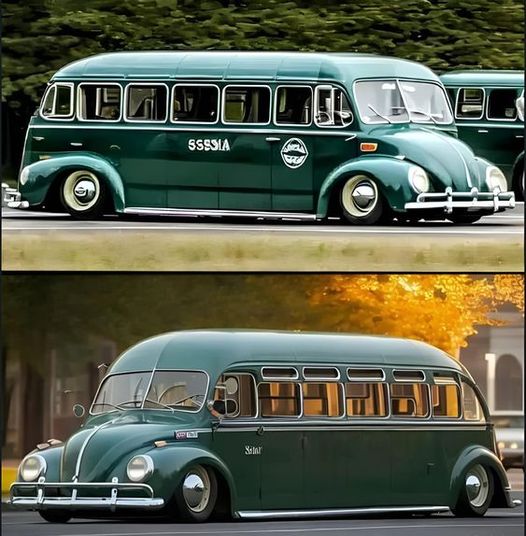
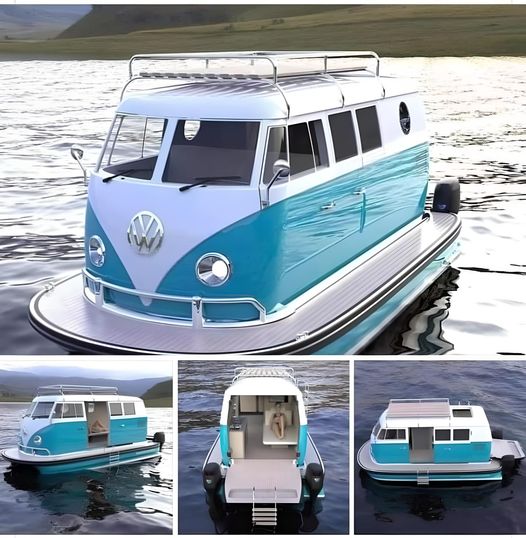
Videos
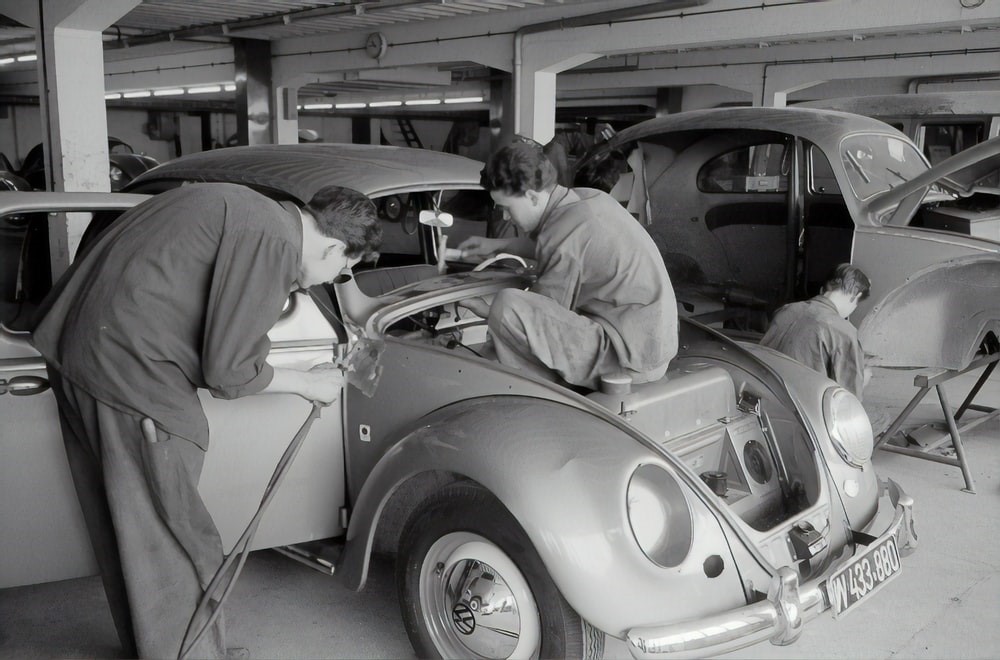
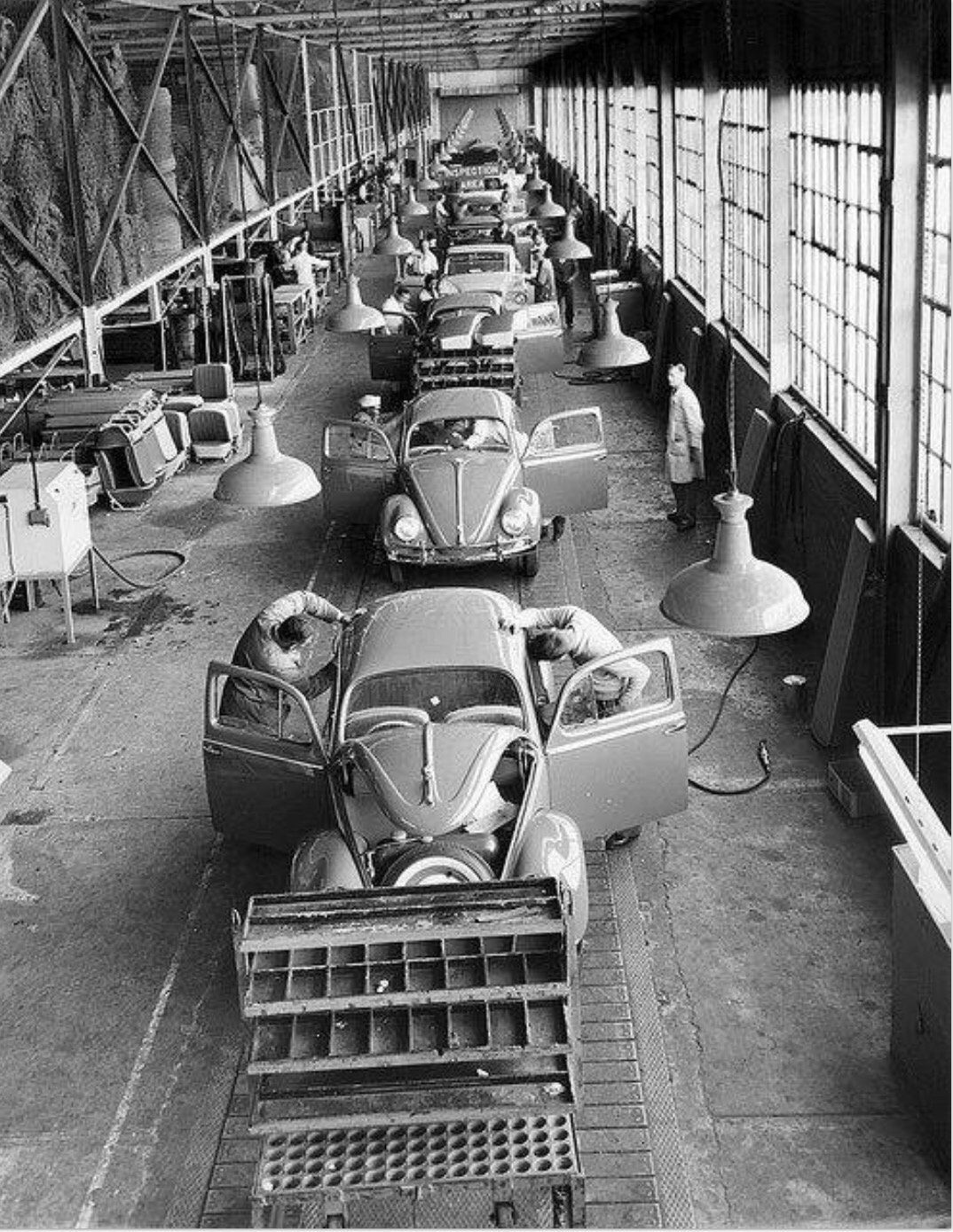
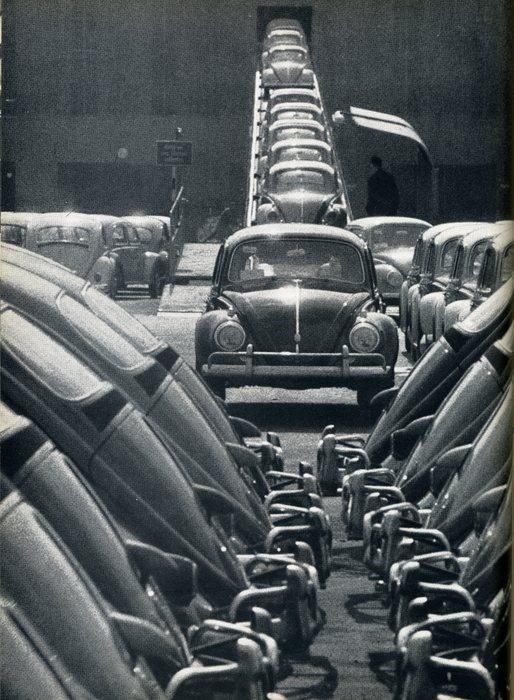
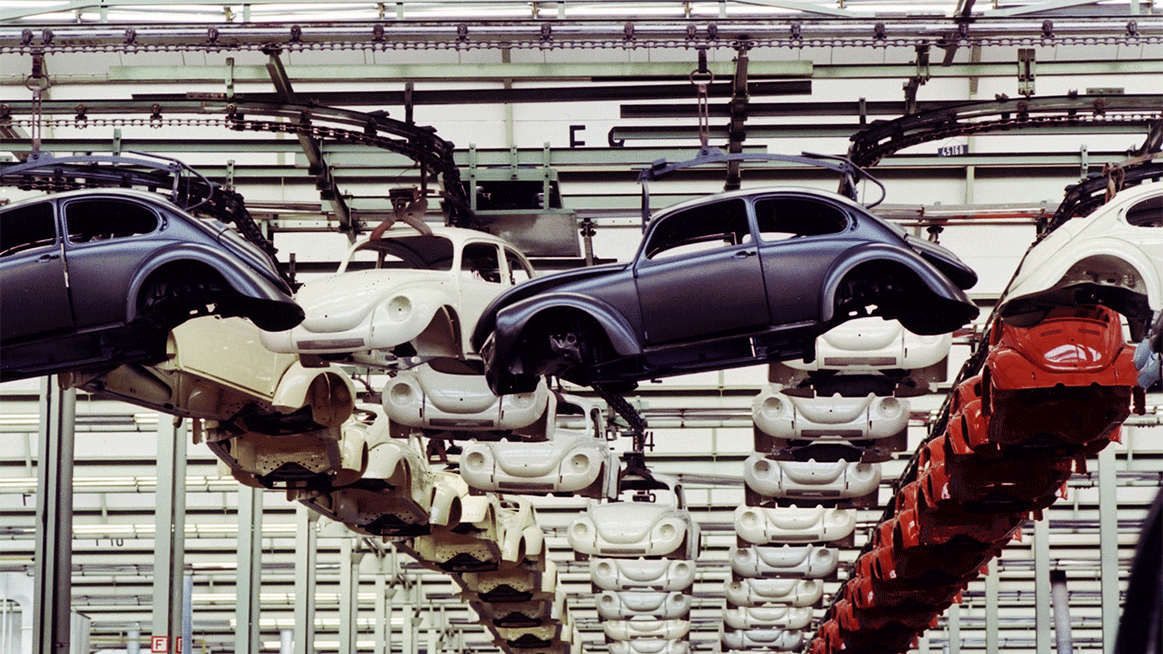



Comments
Authorize to comment